

The seminar is sponsored by CDLP, a project of TCDLA, funded by the Texas Court of Criminal Appeals Course Directors: Parole, Prison, & Related Issues October 13-14, 2022 Gene Anthes, Bill Habern, & David O'Neil
PAROLE, PRISON, AND RELATED ISSUES
SEMINAR INFORMATION
Date October 13 14, 2022
Location Austin Southpark Hotel |4140 Governors Row Austin, TX 78744
Course Director Gene Anthes, Bill Habern, and Dave O’Neil
Total CLE Hours 13 5 Ethics: 1.0
Thursday, October 13, 2022
Daily CLE Hours: 8.0 Ethics: 1.0
Time CLE Topic Speaker
7:45 am Registration and Continental Breakfast
8:10 am Opening Remarks
8:15 am .75 Interviewing a New Parole Client
9:00 am .75 Evaluating a New Parole Case
9:45 am Break
10:00 am 1.0 Presenting a Parole Case
11:00 am 1.0 Parole Revocation Case Law
12:00 pm Lunch Line
12:15 pm .50 Lunch Presentation| Texas Voices
12:45 pm Break
1:00 pm 1.0 Presenting a Parole Revocation Case
2:00 pm 1.0 Ethics and Prisoner Grievances
Bill Habern and Gene Anthes
David O’Neil
Bill Habern
Gary Cohen
Bill Habern
Mary Sue Molnar
Sean Levinson
Robert Hinton Ethics
3:00 pm Break
3:15 pm 1.0 Minimizing Post Conviction Consequences of Plea Bargains

4:15 pm 1.0 Sex Offender Litigation
5:15 pm Adjourn
David O’Neil
Richard Gladden
PAROLE, PRISON, AND RELATED ISSUES
SEMINAR INFORMATION
Date October 13 14, 2022
Location Austin Southpark Hotel |4140 Governors Row Austin, TX 78744
Course Director Gene Anthes, Bill Habern, and Dave O’Neil
Total CLE Hours 13 5 Ethics: 1.0
Friday, October 14, 2022
Daily CLE Hours: 5.50 Ethics: 0 Time CLE Topic Speaker
7:30 am Registration and Continental Breakfast
7:55 am Opening Remarks
Bill Habern & David O’Neil
8:00 am .75 Unique Issues Women Confront in Prison Nicole Moore
8:45 am 1.0 Civil Commitment of Sexually Violent Predators Gene Anthes
9:45 am Break
10:00 am .75 Sex Offender Deregistration
10:45 am Lunch Line
11:00 am 1.0 Lunch Presentation| From Free World to Prison and Back Again
12:00 pm Break
12:15 pm 2.0 Q&A: Things to Know about Dealing with TDCJ and the Texas Board of Pardons & Paroles

Scott Smith
John Flagg
Board Members with Tim McDonnell
TDCJ Personnel (TBA) with Gary Cohen and Allen Place as Moderators
2:15 pm Adjourn
Criminal Defense Lawyers Project

Parole, Prison, and Related Issues
Table of Contents
speakers topic
Thursday, October, 13, 2022
David O’Neil Interviewing a New Parole Client
Bill Habern
Evaluating a New Parole Case
Bill Habern Parole Revocation Case Law
Mary Sue Molnar Sex Offender Residency Restrictions
Sean Levinson
Presenting a Parole Revocation Case
Robert Hinton Ethics and Prisoner Grievances
David O’Neil Minimizing Post Conviction Consequences of Plea Bargains
Richard Gladden Sex Offender Litigation
Friday, October, 14, 2022
Scott Smith
The Basics of Sex Offender De Registration
John Flagg Innovating for a Change
Tim McDonnell Texas Board of Pardons and Paroles
6808 Hill Meadow Dr :: Austin, Texas :: 512.478.2514 p :: 512.469.9107 f :: www.tcdla.com
Criminal
Parole, Prison, and Related Issues
13-14,
Southpark Hotel
Topic: Interviewing a New Parole Client

Speaker: David O’Neil
The Law Office of David O’Neil, P.C.
North Main Street Houston, TX 77009
phone
October
2022 Austin
Austin, Texas 6808 Hill Meadow Dr :: Austin, Texas :: 512.478.2514 p :: 512.469.9107 f :: www.tcdla.com
Defense Lawyers Project
3700
713.863.9400
832.879.2185 fax david@paroletexaslawyer.com email www.paroletexaslawyer.com website
PAROLE INTERVIEW WITH ___________________, TDCJ#____________, AT ________________, ON __________ 1. CONFIRM TDCJ OFFENDER INFORMATION, DOB ( ) & CITIZENSHIP ( ). TIMESHEET EXPLAIN: EVAL, BRIEF, PAROLE/MS PROCESS (IPO INTERVIEW, POSSIBLE PAROLE VOTES INCLUDING DETAINER ISSUES), PAROLE SCORE, PROTESTS, ATTORNEY PHONE LIST, RELEASE FORMS, AND, AS APPLICABLE, SB45, HB1914, CCSVP 2. PAROLE PLAN(S), HOME, JOB, SCHOOL IC ? DETAINERS? DEPORTATION TIES TO HOME COUNTRY AND ALTERNATE PLAN? 3. CSZs ?, LRP? SPECIAL CONDITIONS: C, M, R, S, SISP, T, V, X, Z, O.33. 4. ATTORNEYS WITH TRIAL FILE CIVIL SUITS? 5. IF A PRIOR BOARD CONSIDERATION REPRESENTED BY ATTORNEY? COPY OF PRESENTATION? PERSONAL INTERVIEW DETAILS 6. SPECIFICS OF SOCIOLOGY AND IPO MEETING. 7. DETAILS OF OFFENSE(S) & TRIAL/APPEAL/WRIT: CLIENT VERSION V. OFFICIAL VERSION, WITNESSES/VICTIM IMPACT STATEMENT/VICTIM MEDIATION/MEDIA REPORTS/PLEA OFFERS/PSI, POLYGRAPHS, PSYCH EVALS 8. DRUG/ALCOHOL HISTORY & INSTANT OFFENSE SA, REHABS (CERTIFICATES, RELEASES). 9. CRIMINAL HISTORY. IF ANY PRIOR SO ALLEGATIONS DISCUSS O.33 AND COLEMAN HEARING. 10. FREEWORLD JOBS, SCHOOLING, MILITARY (& Achievements) 11. PERFORMANCE ON BOND: JOBS, REPORTING REQUIREMENTS, COMPLIANCE
12. TDCJ CHRONOLOGY (INCLUDE ALL PRIOR INCARCERTIONS): UNITS, JOBS, PROGRAMS/PROGRAM REQUESTS, LINE CLASS, CUSTODY LEVEL, GANGS/MONITORED CLIQUES, CERTS., DAILY SCHEDULE, BOOKS.
13. DISCIPLINES (INCLUDE PRIOR INCARCERATIONS)
14. MEDICAL/PSYCH HISTORY PRIOR PSYCH EVALS/SO EVALS.
15. FAMILY INFORMATION: PARENTS, SIBLINGS, SPOUSE, CHILDREN (DOB, LOCATION, JOBS, ETC).
16. FAMILY VISITS
17. GO OVER BIO & OTHER HISTORY NOT COVERED IN BIO TO INCLUDE ANY NEGATIVE FAMILY ISSUES THAT COULD PRESENT PROBLEMS/PROTESTS
18. DISCUSSED LETTER TO THE BOARD, APOLOGY LETTER(S), SUPPORT LETTERS FROM FAMILY, FRIENDS PROSPECTIVE EMPLOYERS & TDCJ EMPLOYEES (SEND TO ATTY, “GUIDANCE ON WRITING SUPPORT LETTERS”).
19 PHOTOS FAMILY, FRIENDS, HOME, ACHIEVEMENTS (IDENTIFY PERSONS/PLACES)
20 WHO WILL ATTEND BOARD INTERVIEW (IN PERSON, ZOOM, TELEPHONE)
21 SOs: LSOTPs, POLYGRAPHS, “X”, SISP, CCSVP, COLEMAN EVALUATION, SOCC, PSYCH EVAL.
22. ADVISE TO PROVIDE ALL DOCUMENTATION IF HIRED, AND UPDATE (BY PHONE & LETTER).
23. DISCUSS TENTATIVE OPINION: CONCERNS, COA, SECONDARY OBJECTIVE, TIMETABLE.
WORDS OF ENCOURAGEMENT, MESSAGES FOR FAMILY
24
Parole, Prison, and Related Issues
13-14,
Southpark Hotel
Topic: Evaluating a New Parole Case

Speaker: Bill Habern
The Habern Law Firm P.O. Box 130744 Houston, TX 77219 0744 713.942.2376 phone bill@paroletexas.com email www.paroletexas.com website
October
2022 Austin
Austin, Texas 6808 Hill Meadow Dr :: Austin, Texas :: 512.478.2514 p :: 512.469.9107 f :: www.tcdla.com Criminal Defense Lawyers Project
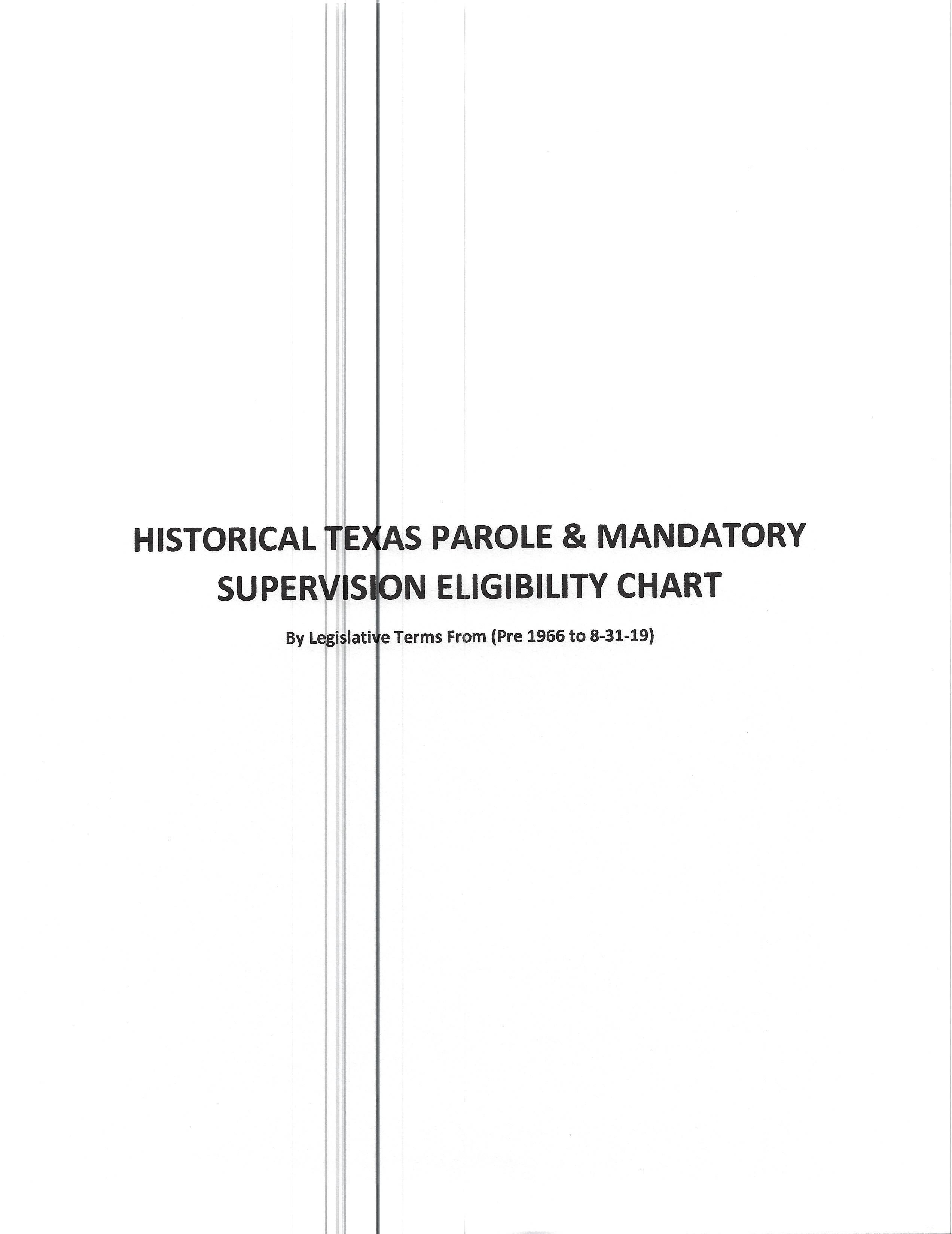

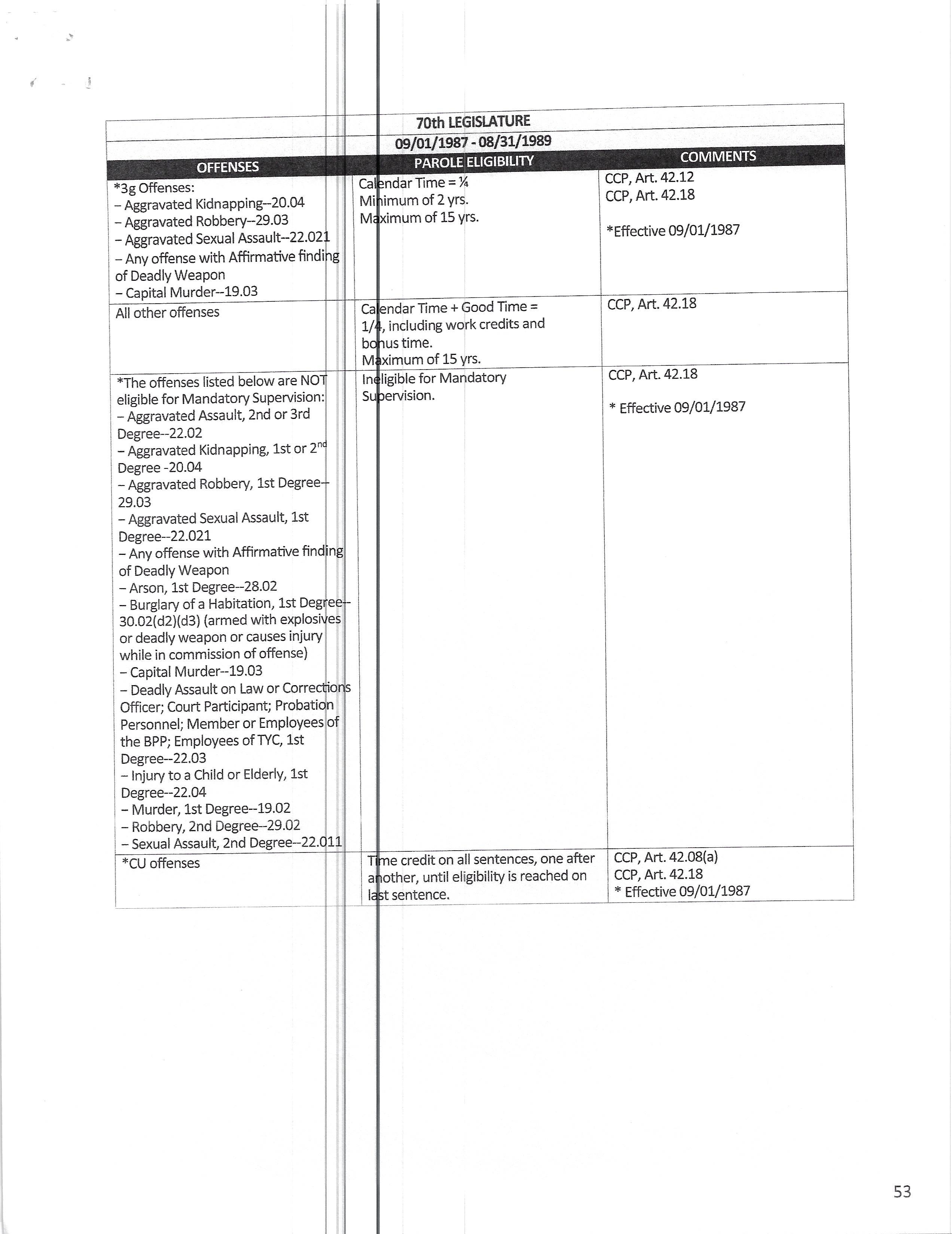
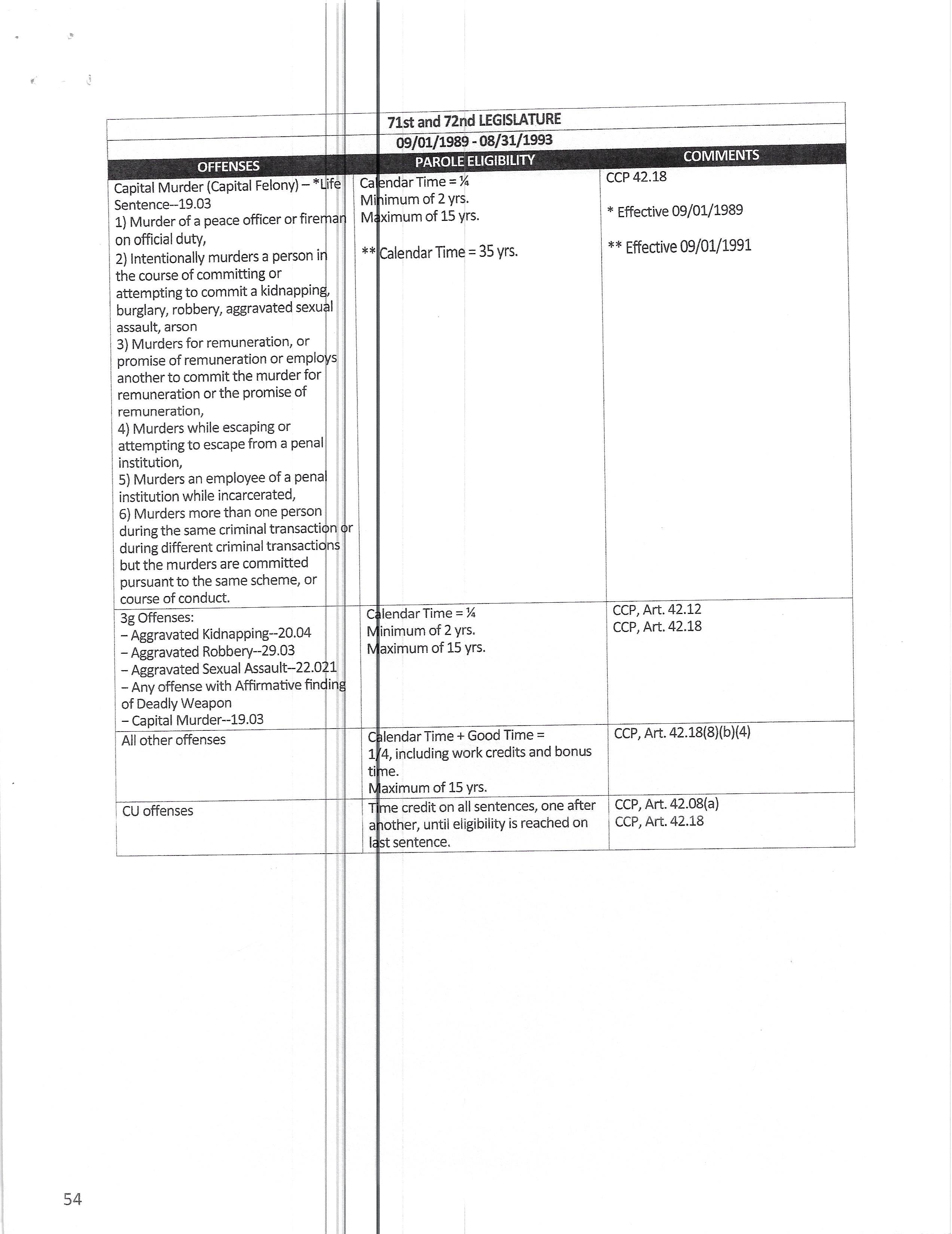

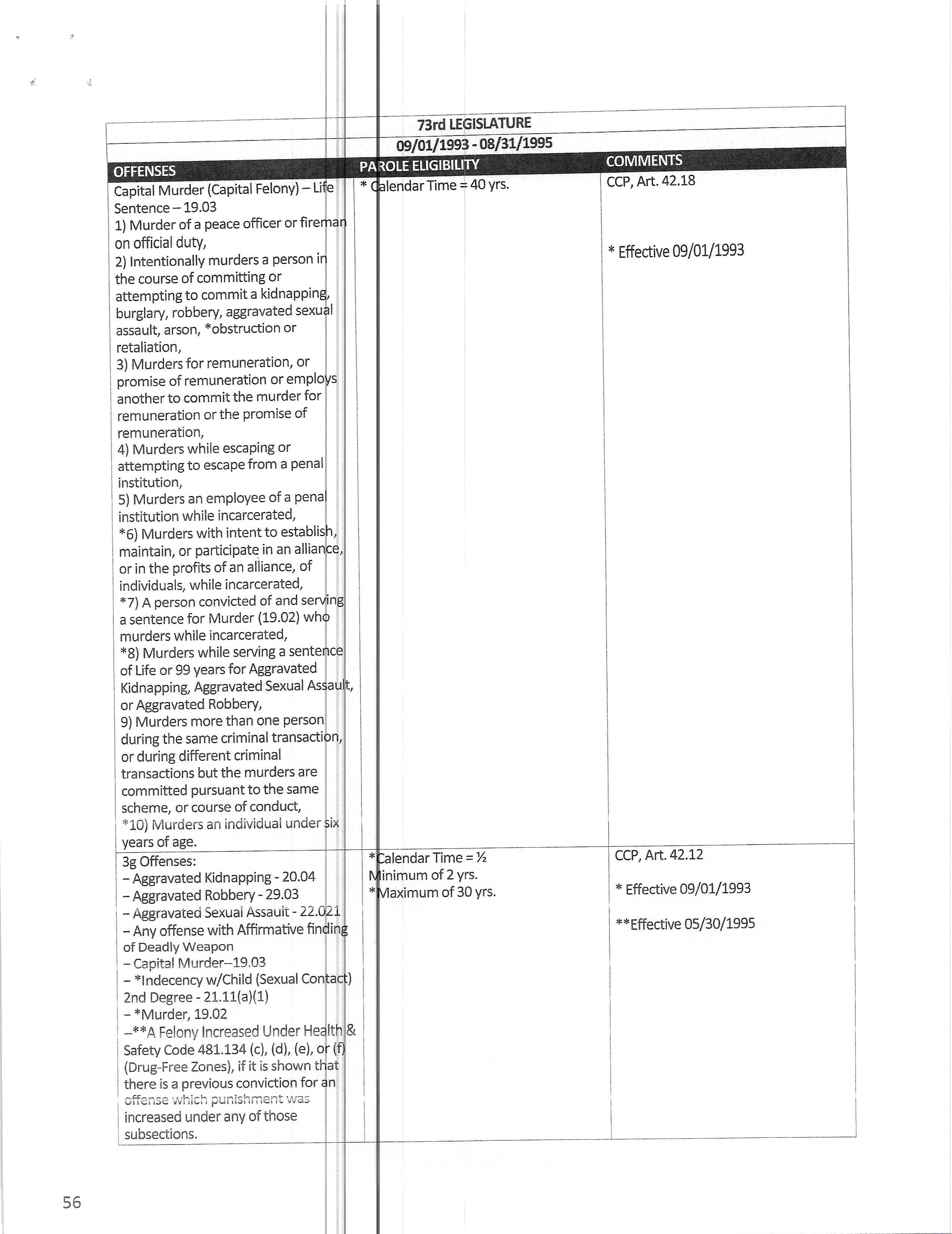

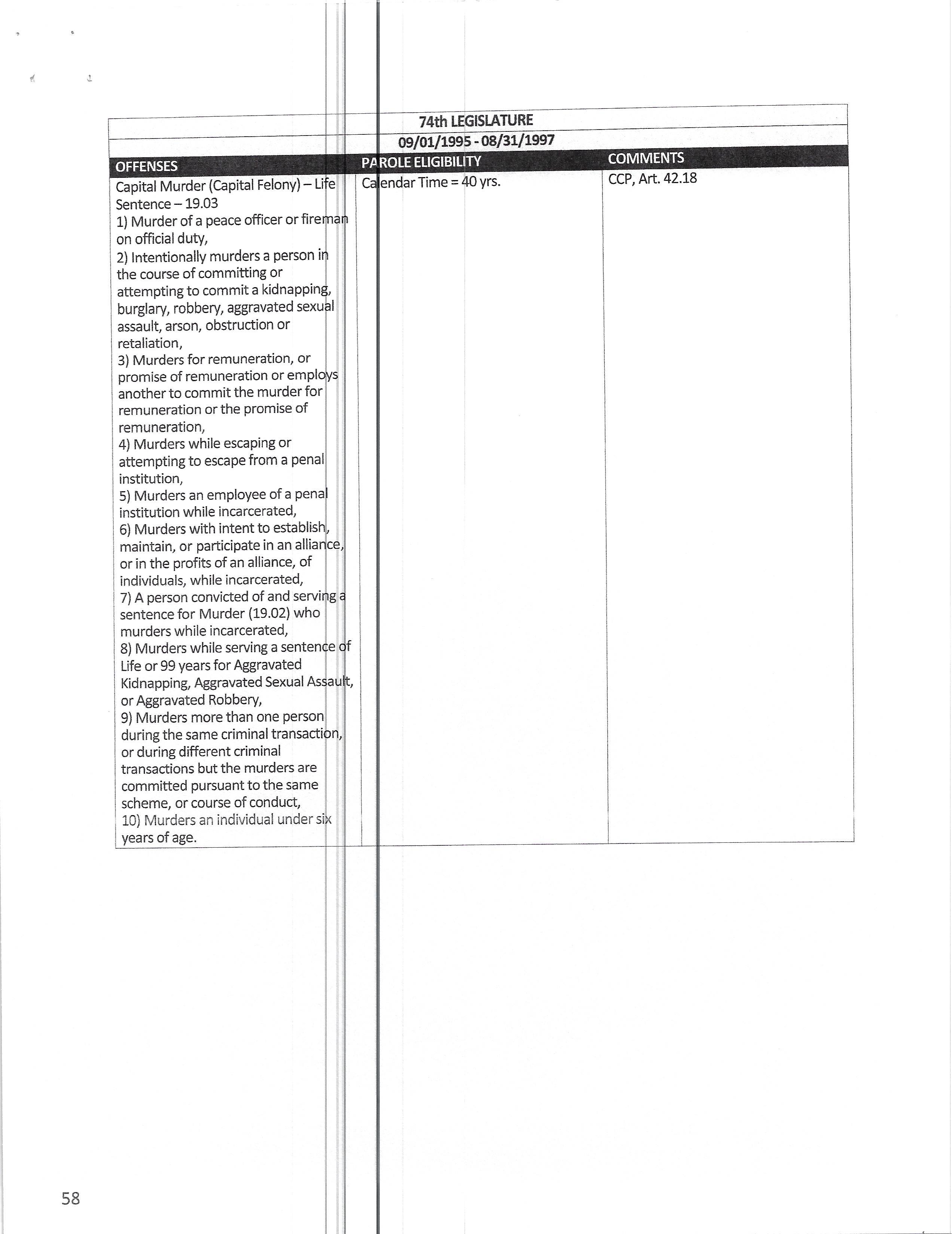
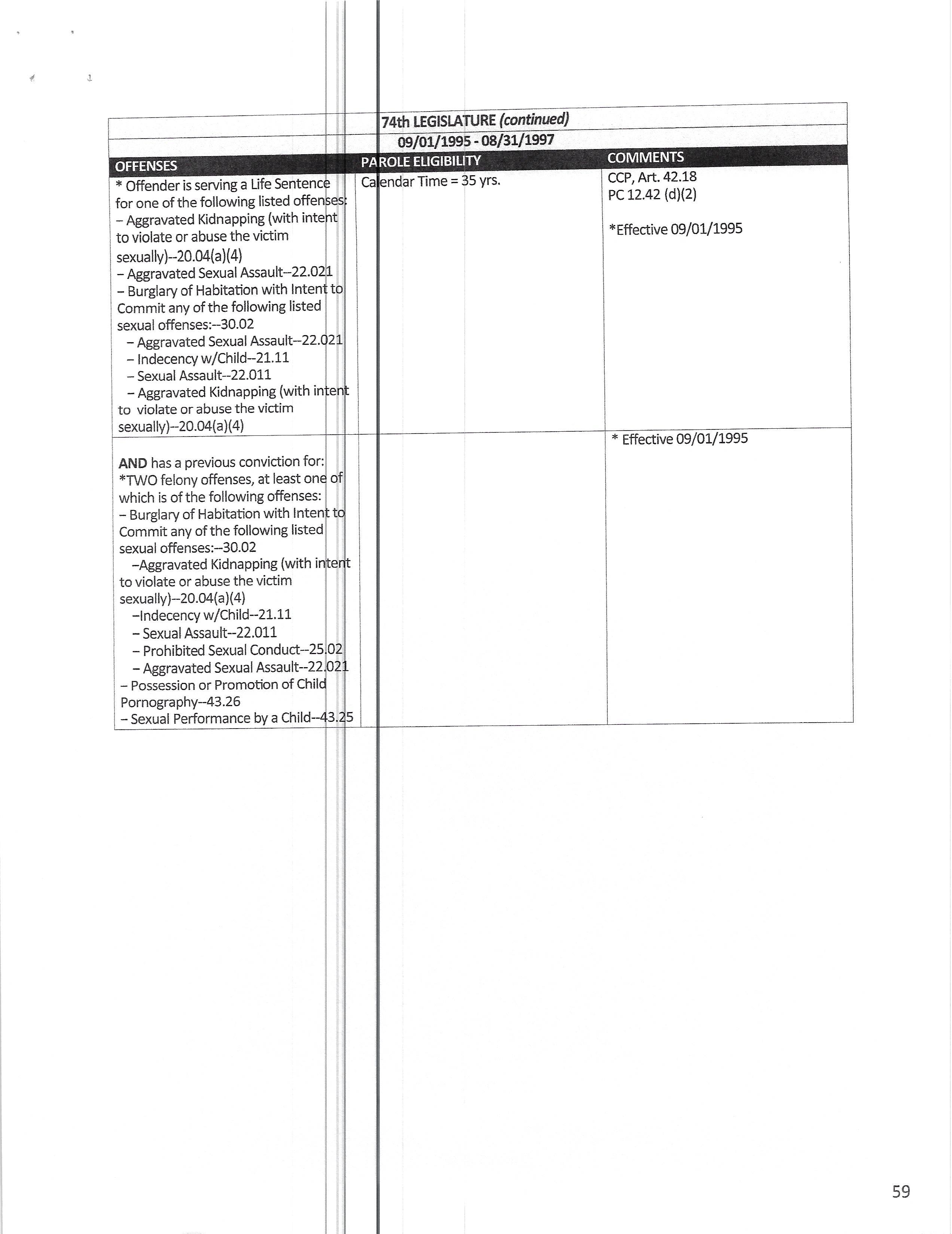

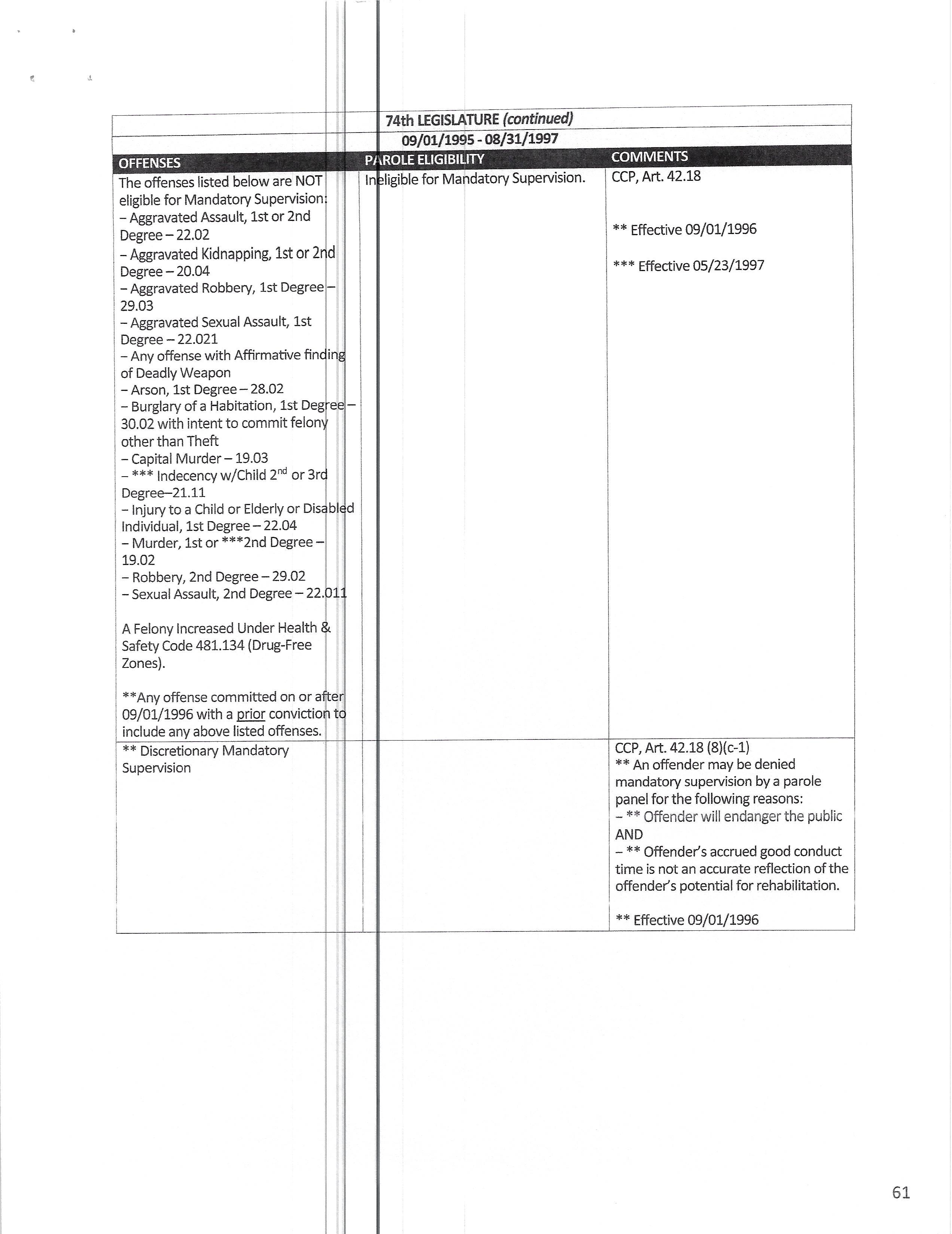

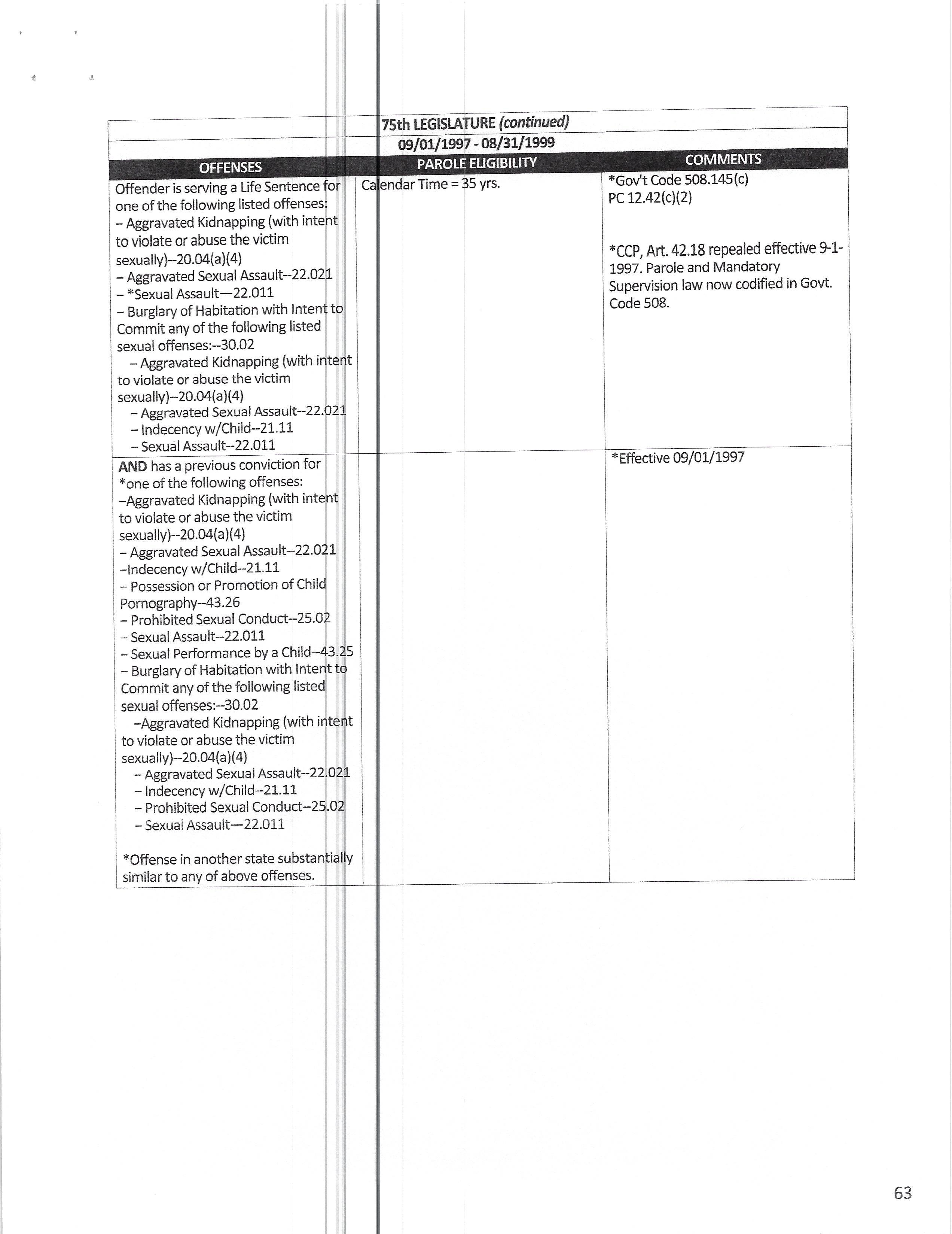


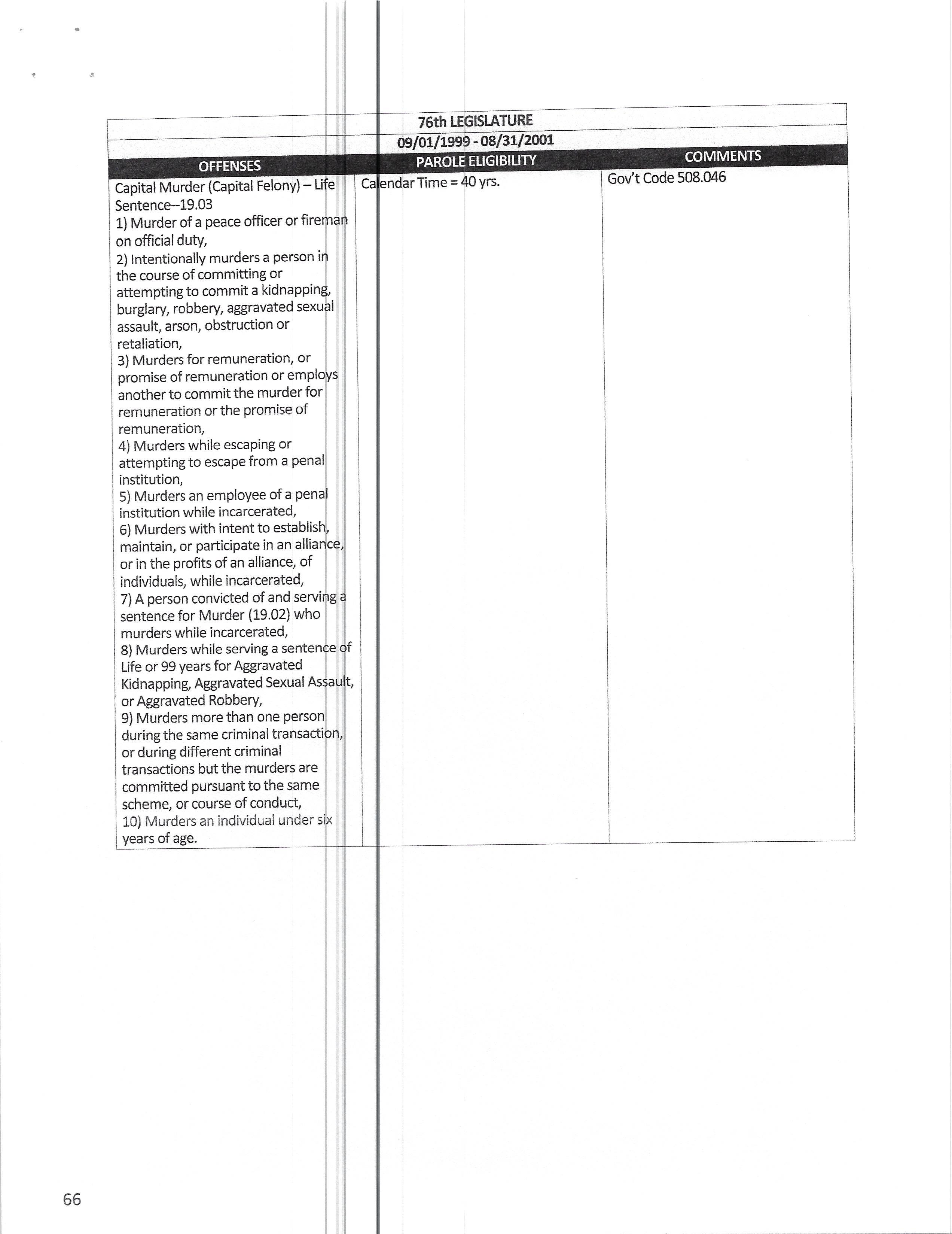

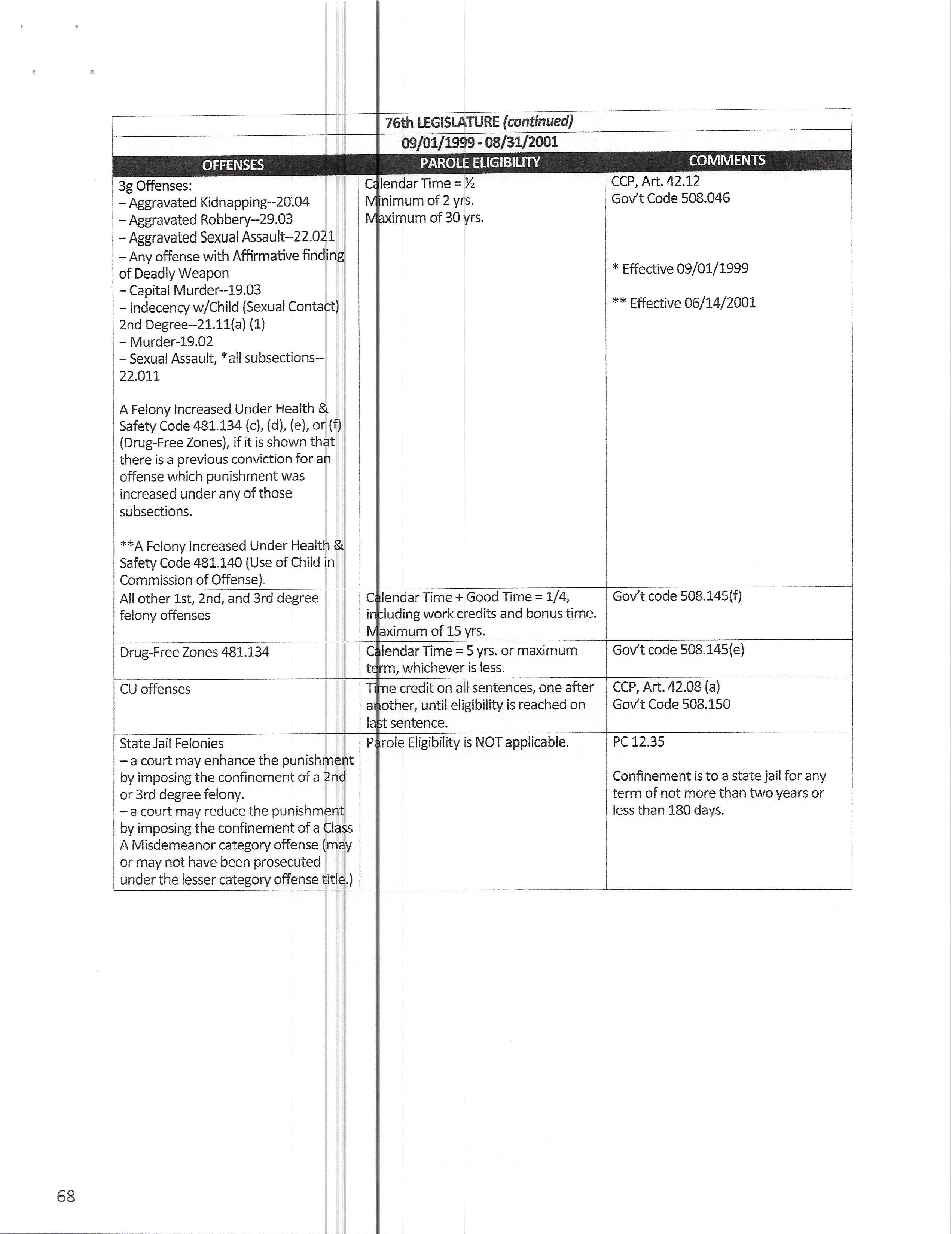
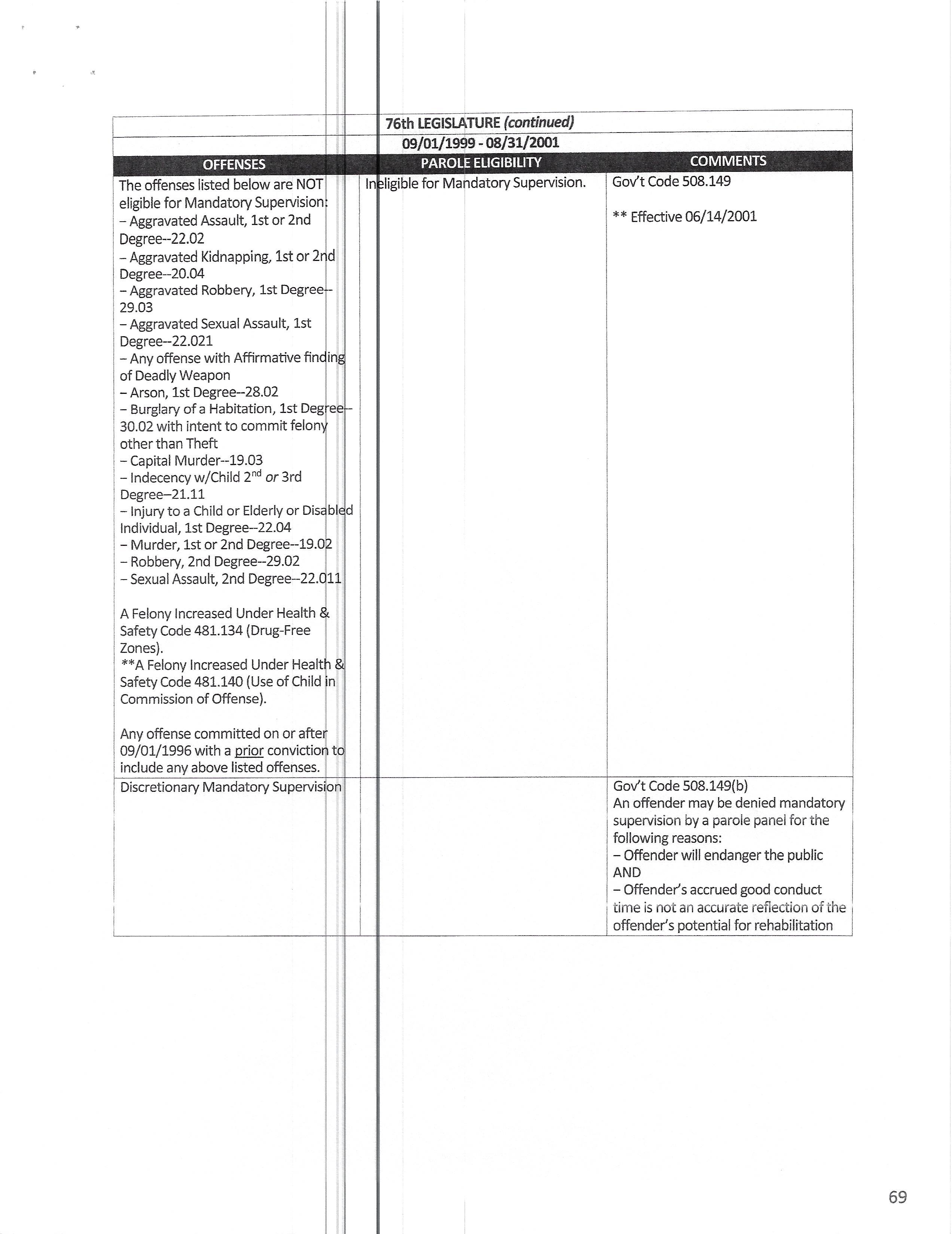

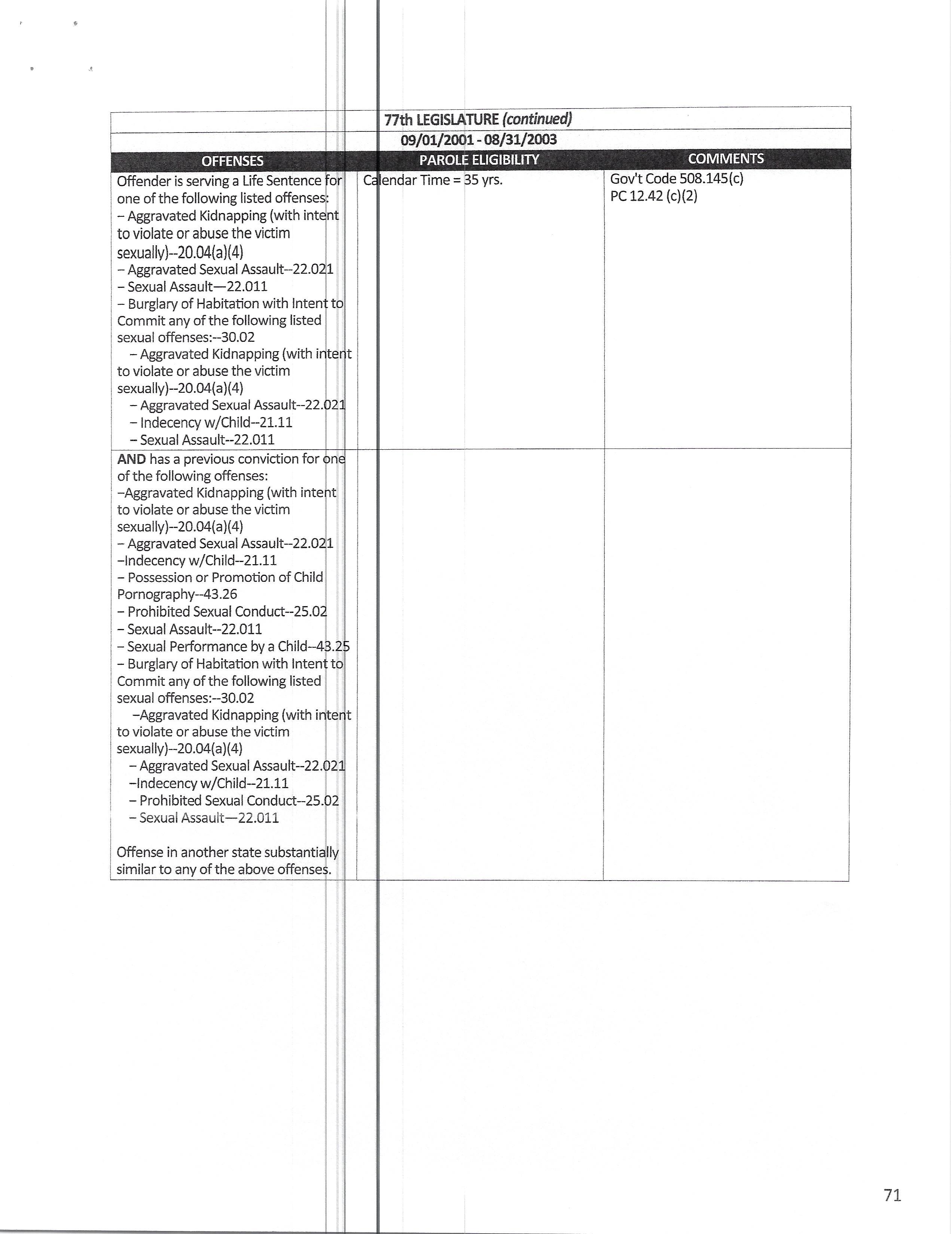

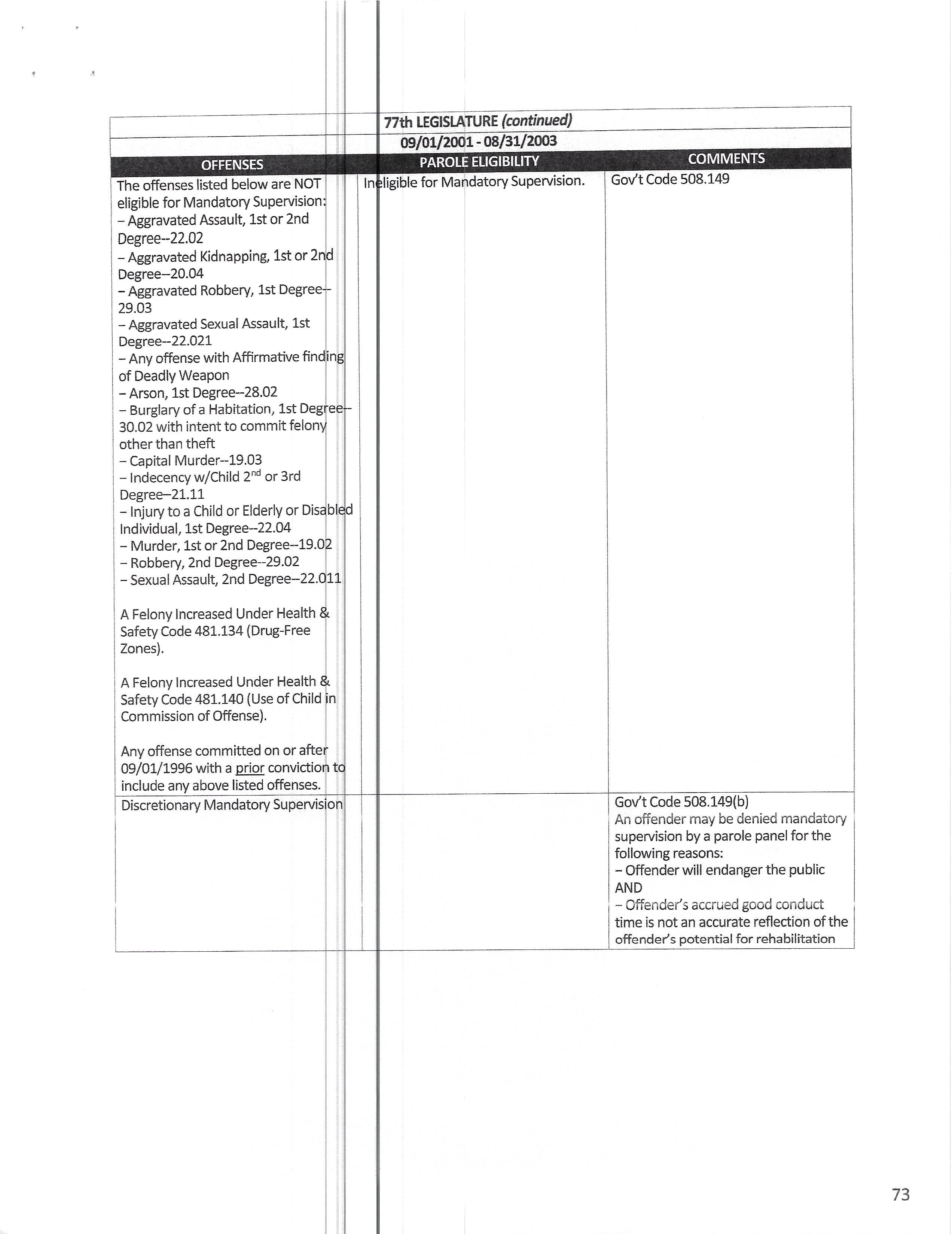
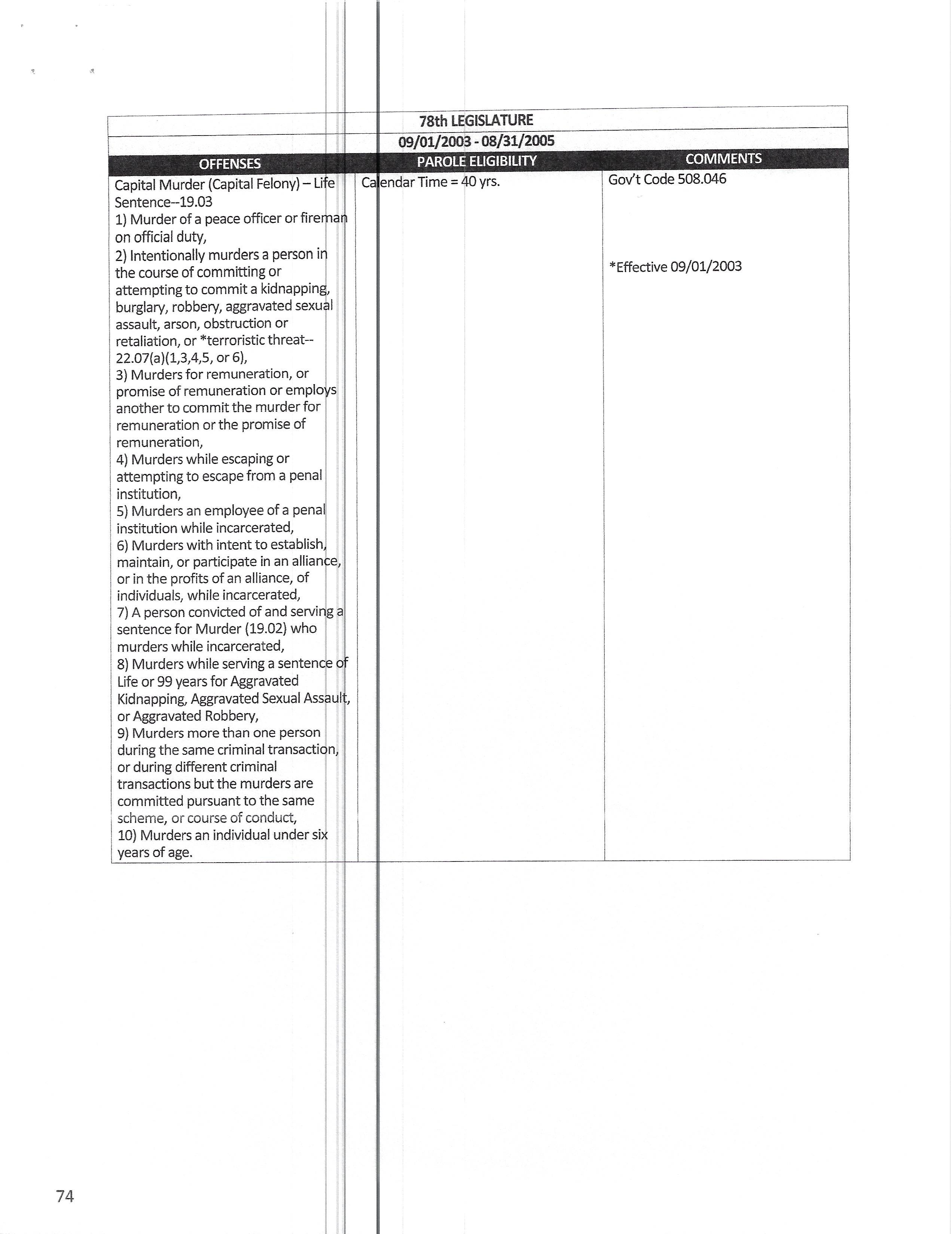

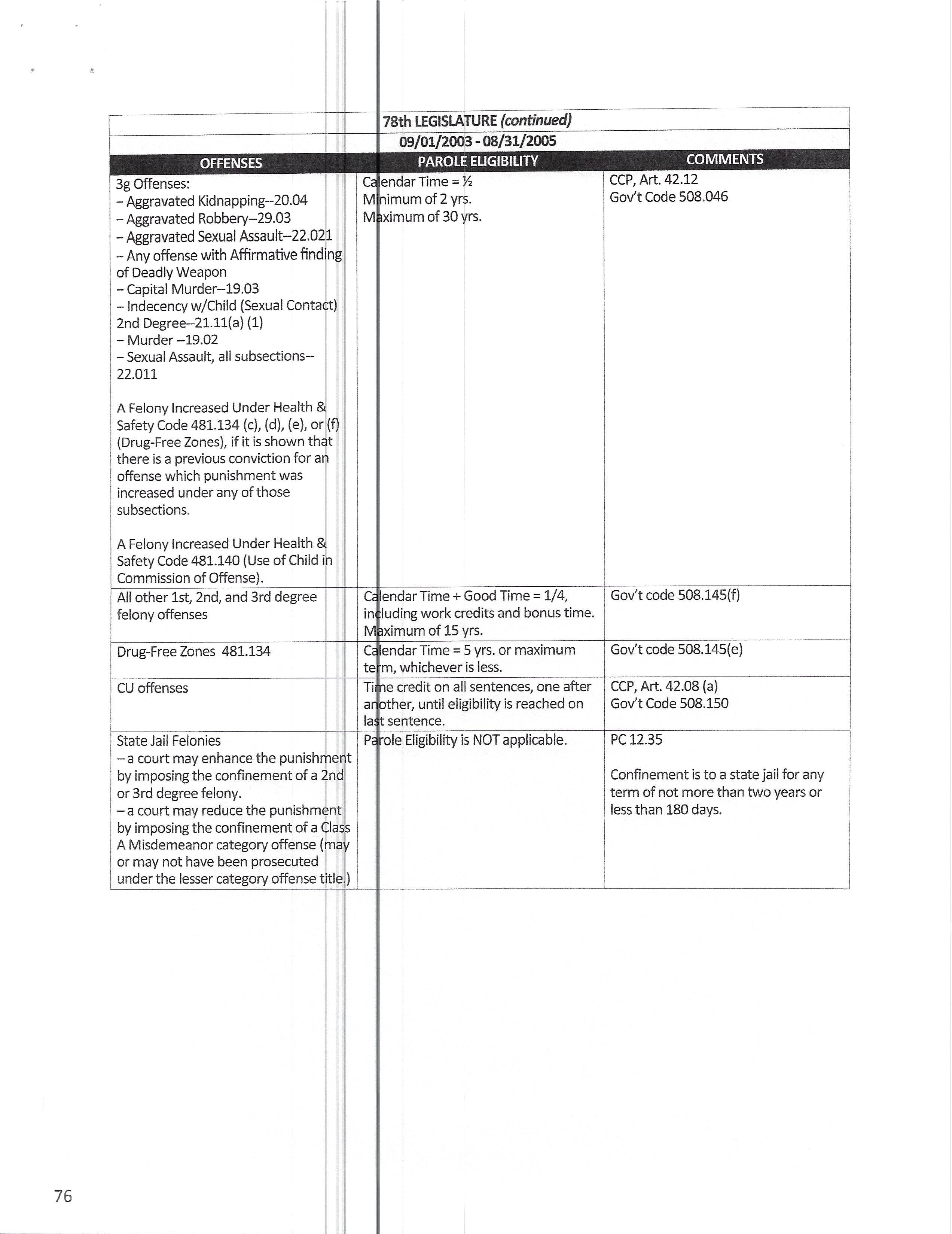
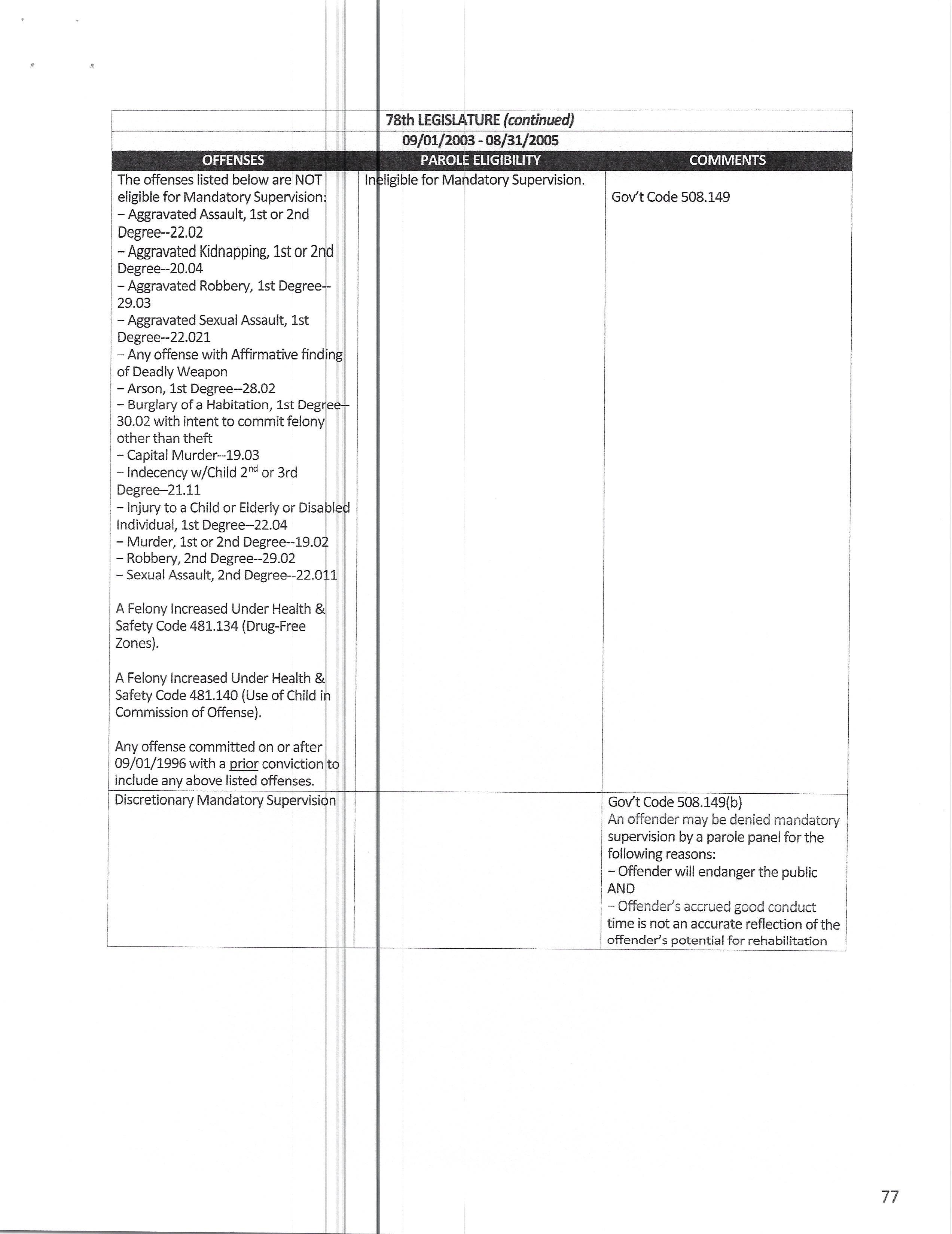
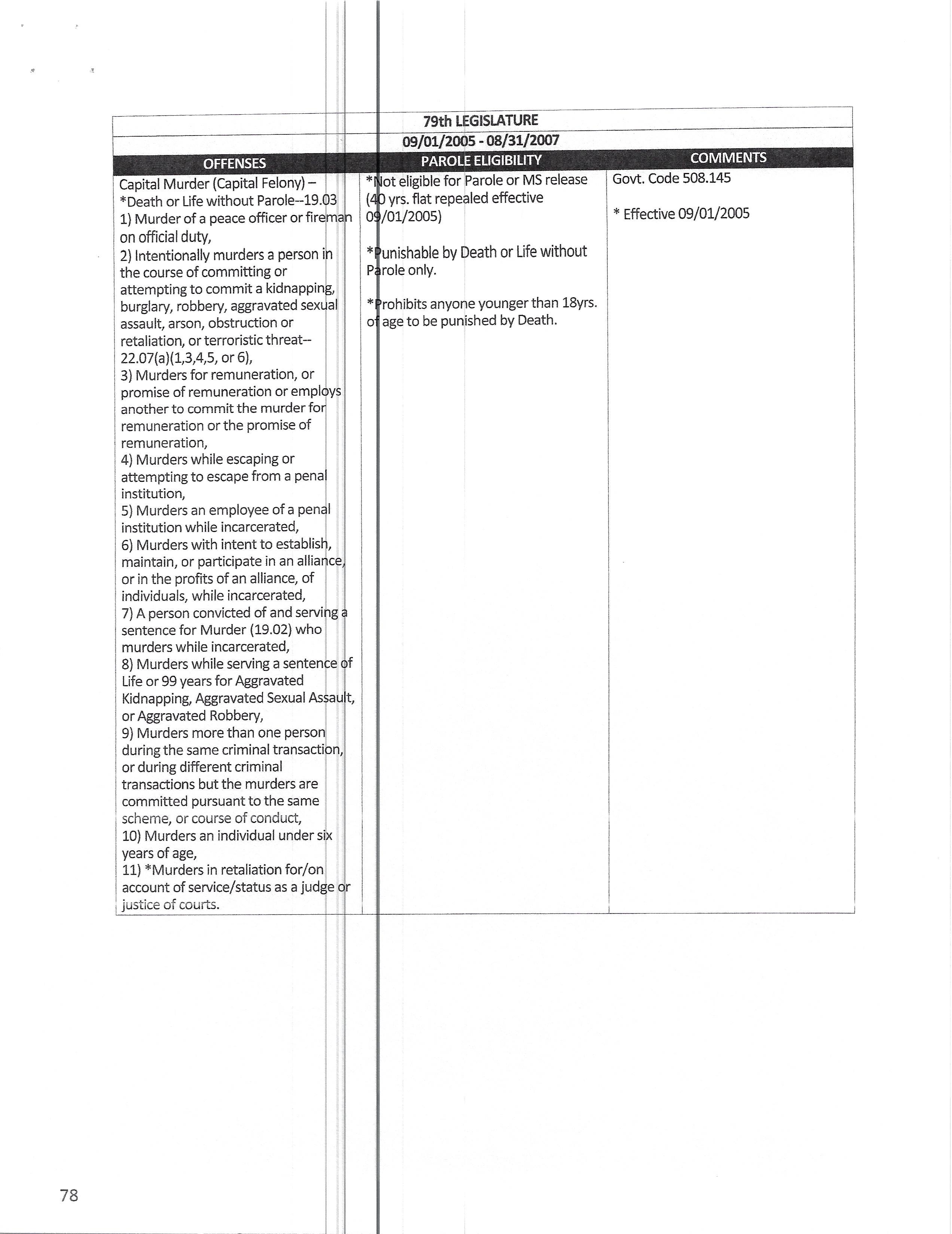









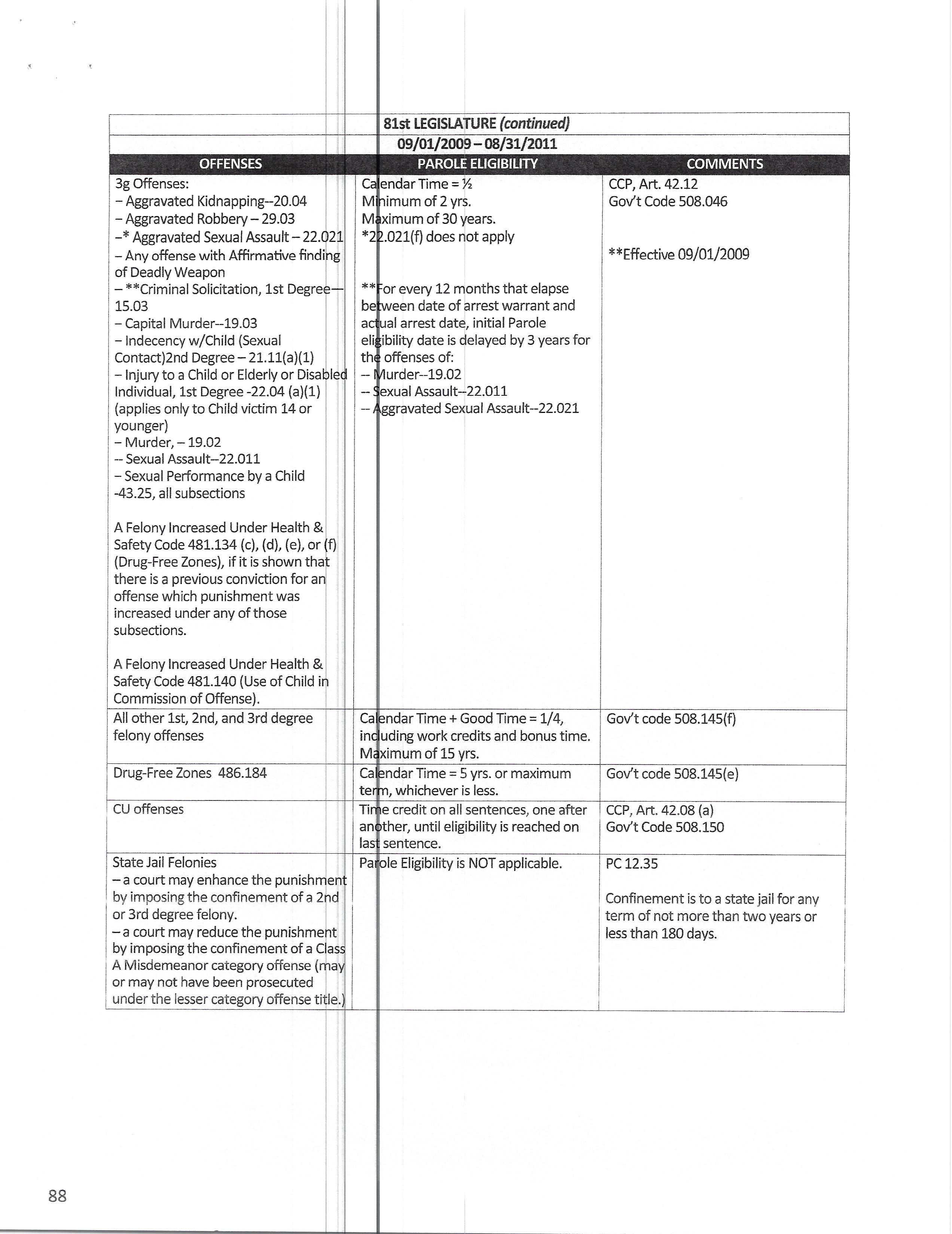
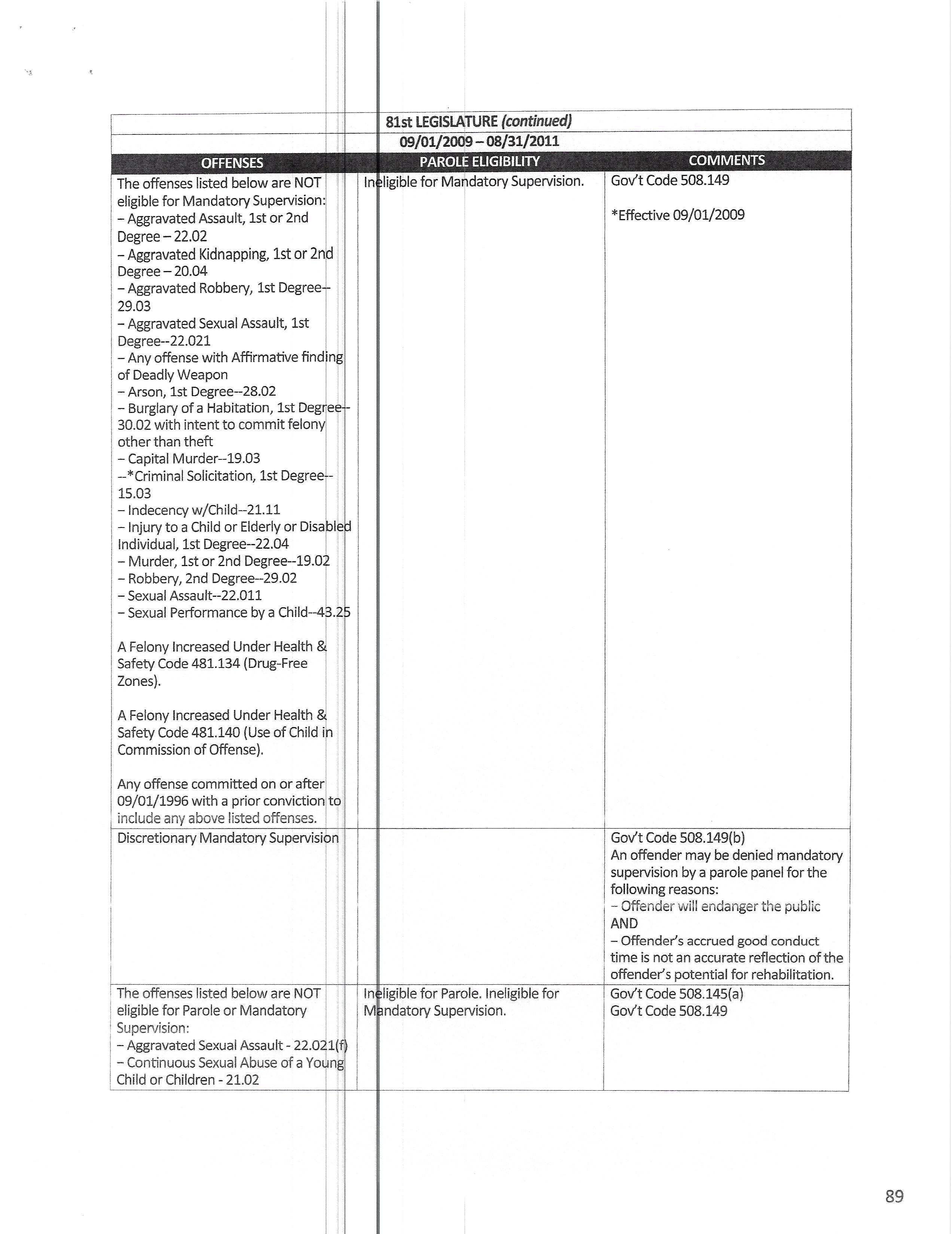

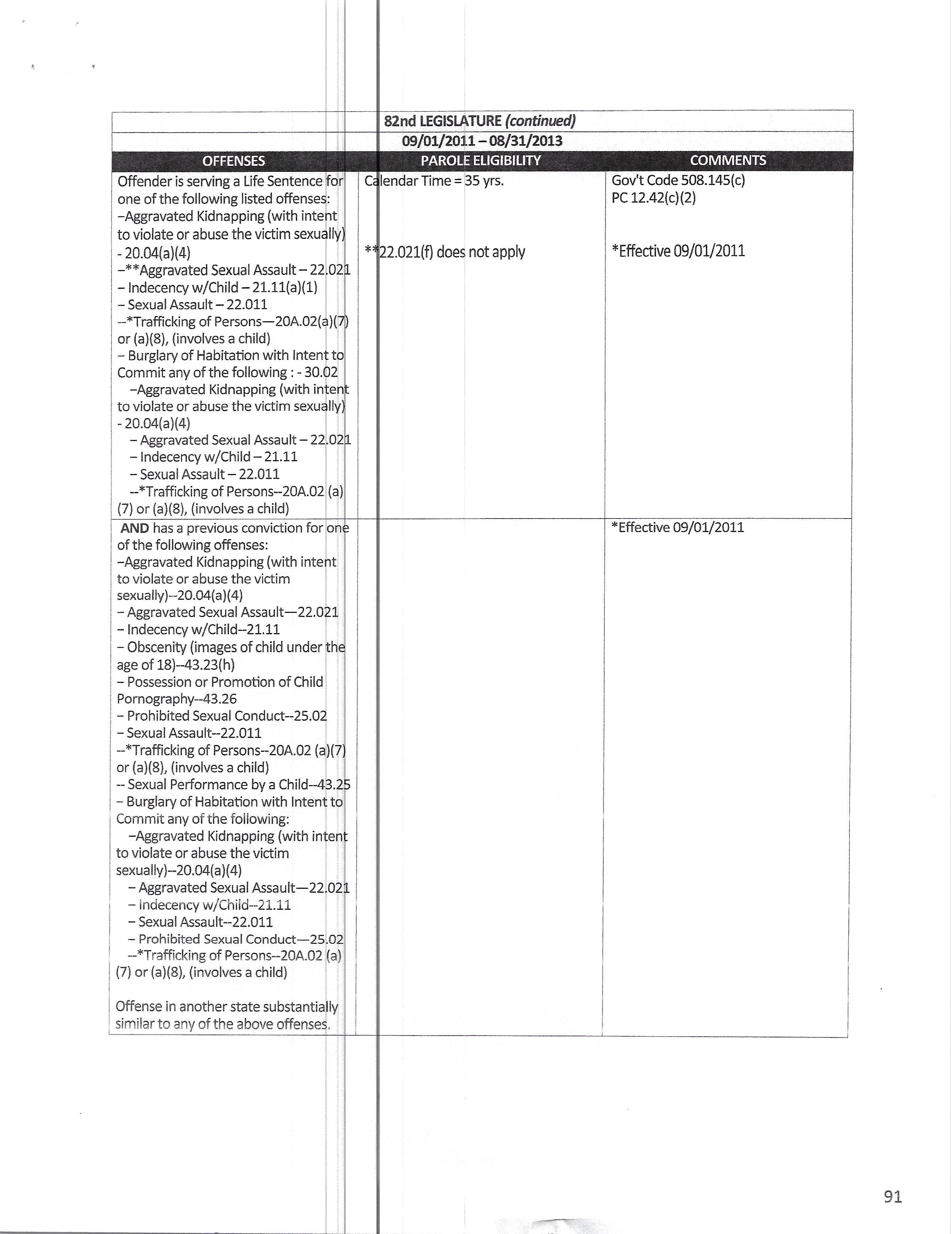

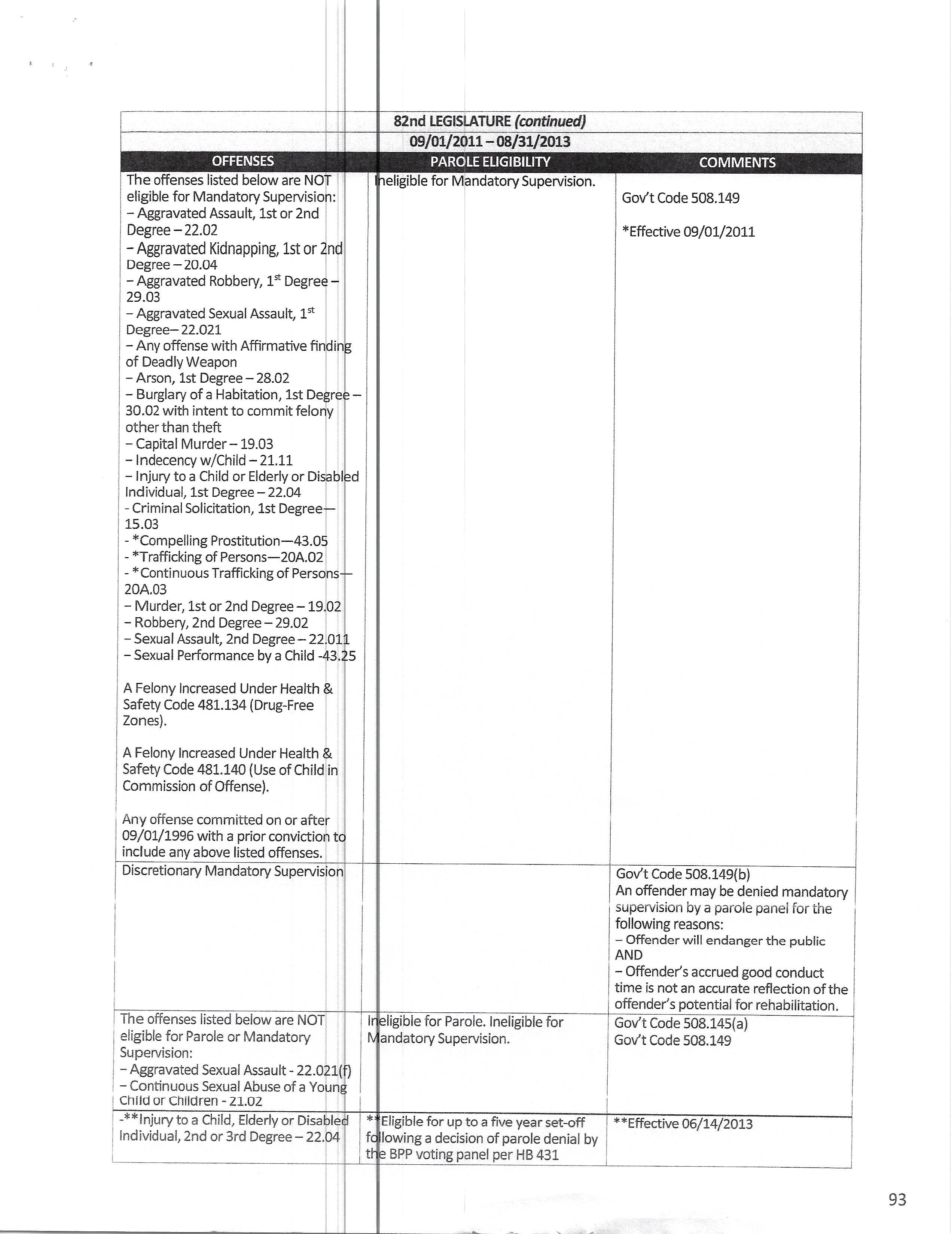
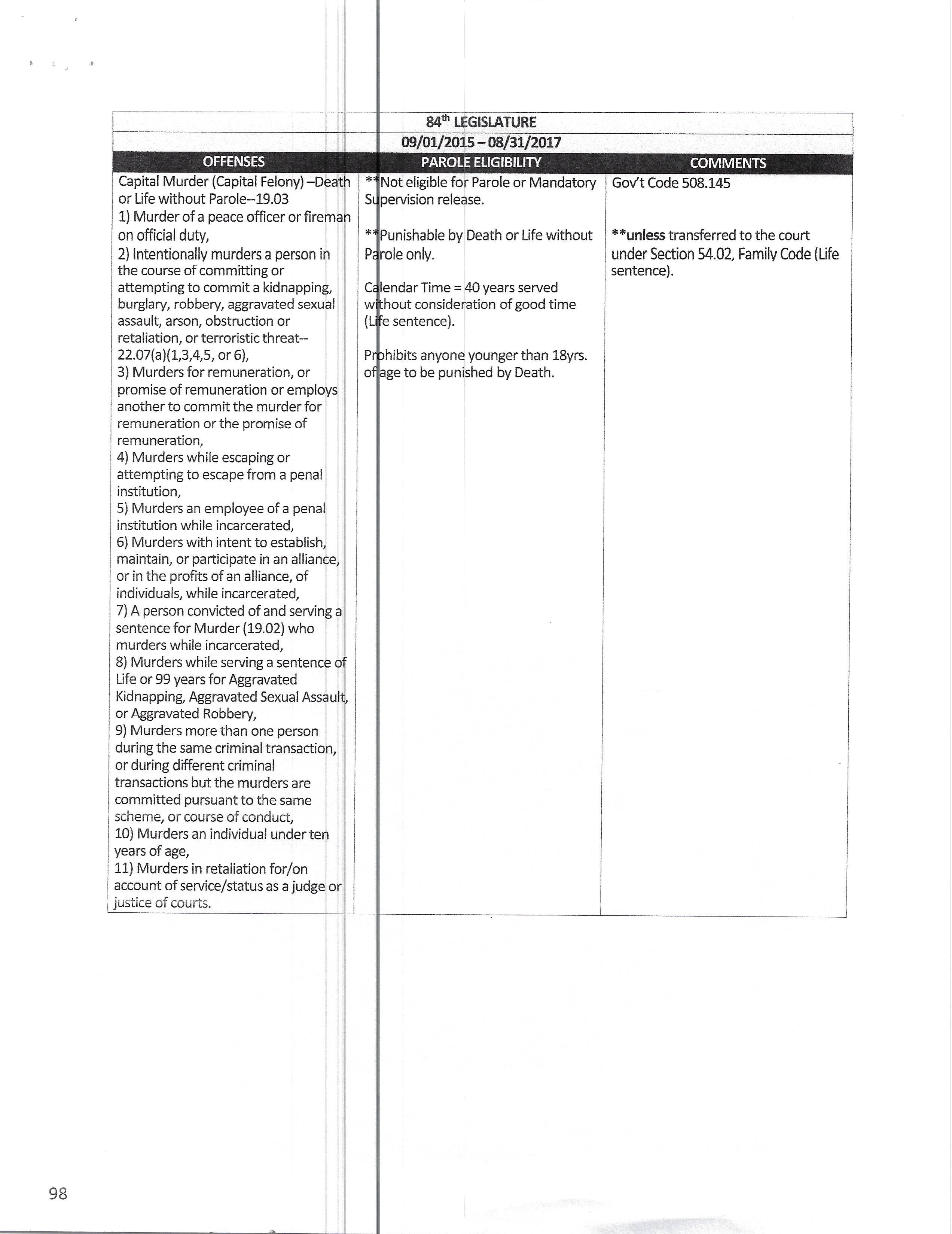

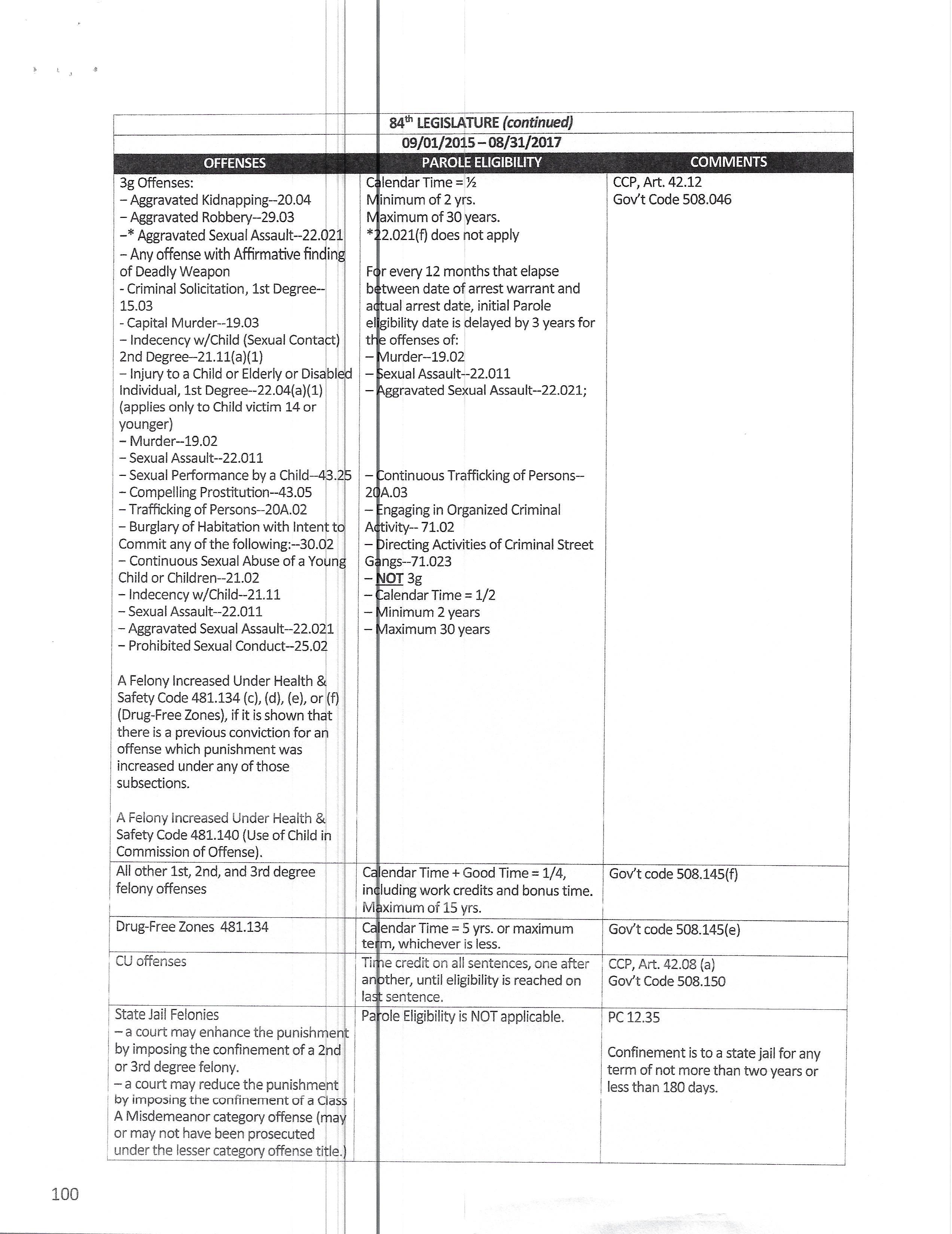
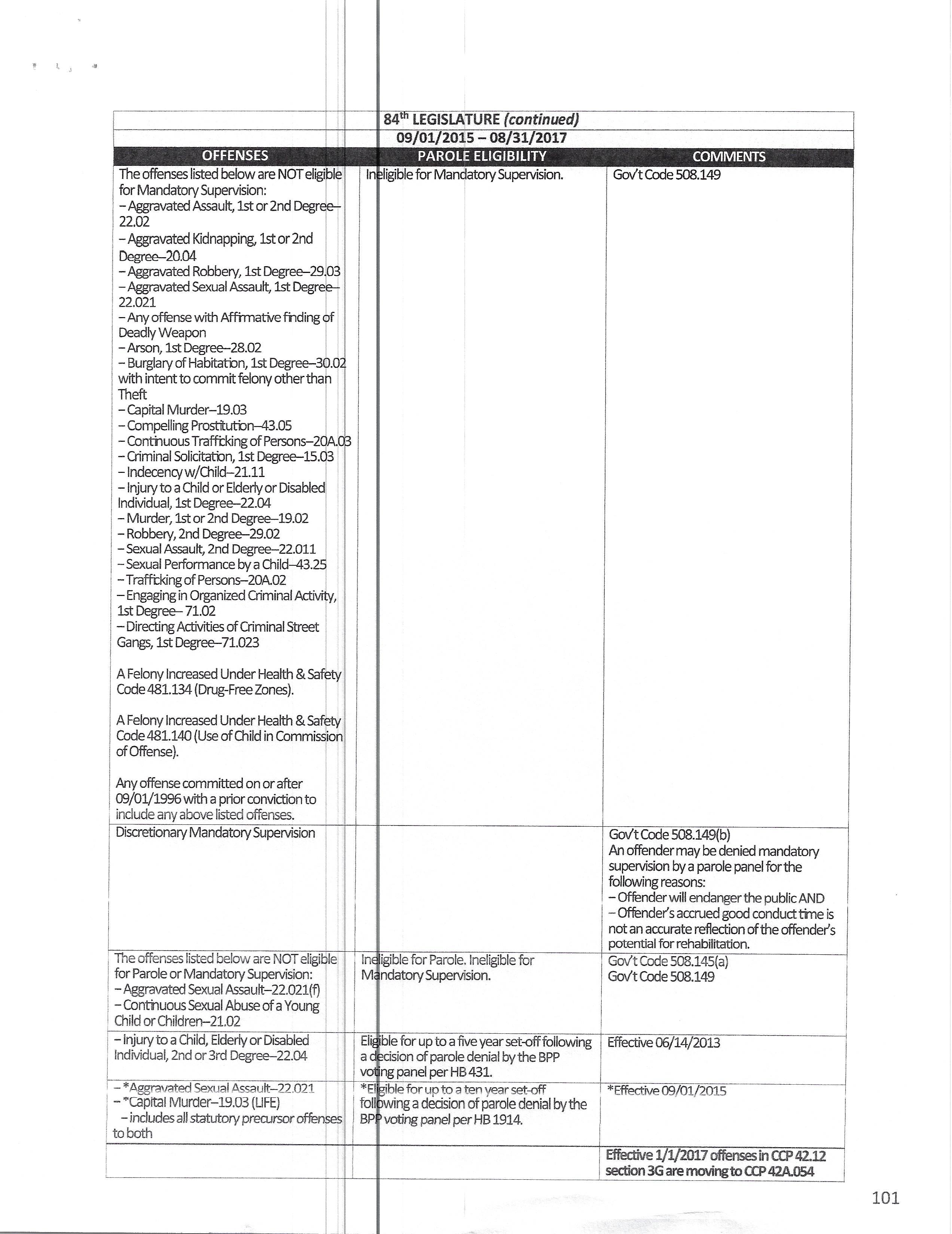

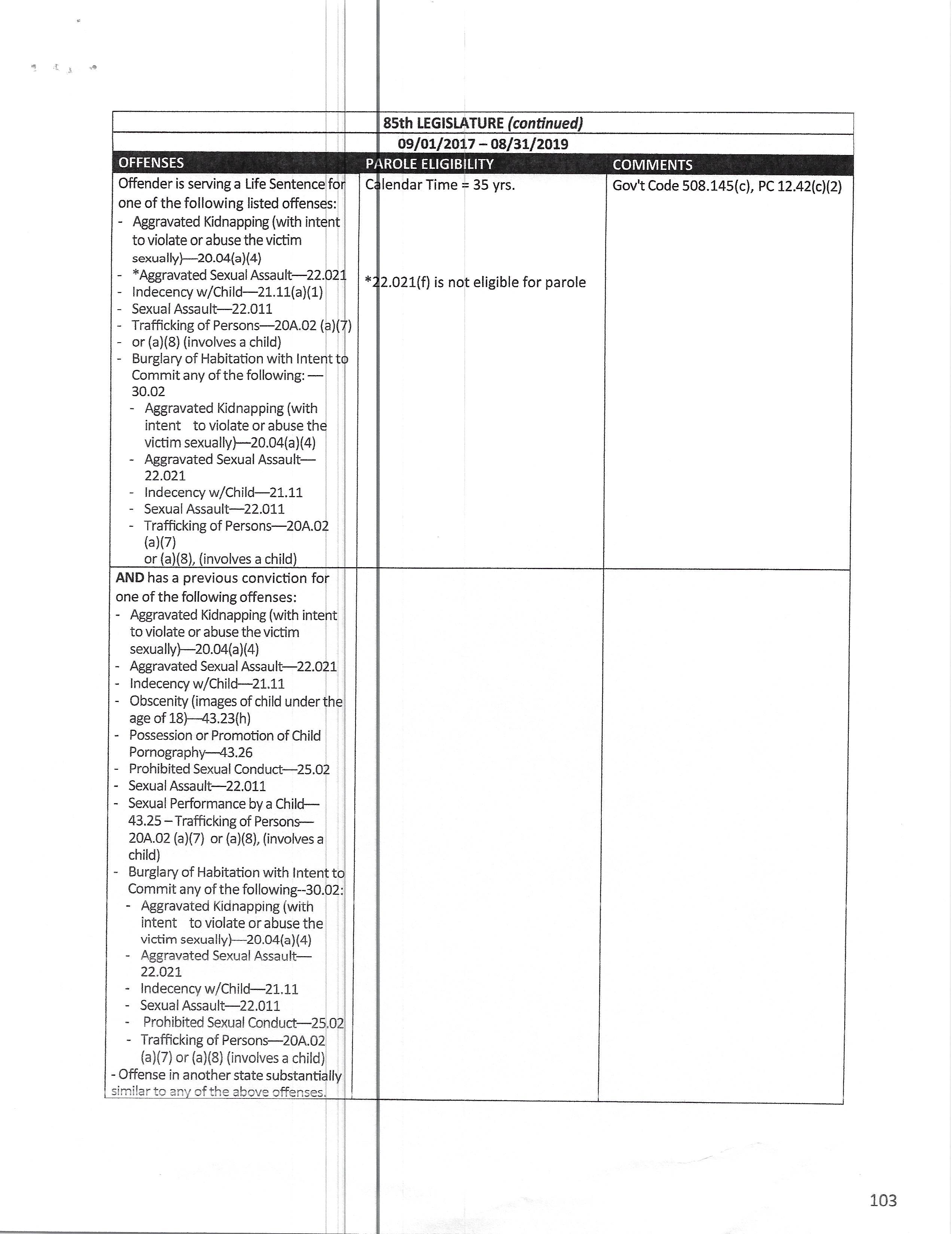

Criminal Defense Lawyers

Parole, Prison, and Related Issues
13-14,
Southpark Hotel
Topic: Parole Revocation Case Law
Speaker: Bill Habern
The Habern Law Firm P.O. Box 130744 Houston, TX 77219 0744 713.942.2376 phone bill@paroletexas.com
www.paroletexas.com
October
2022 Austin
Austin, Texas 6808 Hill Meadow Dr :: Austin, Texas :: 512.478.2514 p :: 512.469.9107 f :: www.tcdla.com
Project
email
website
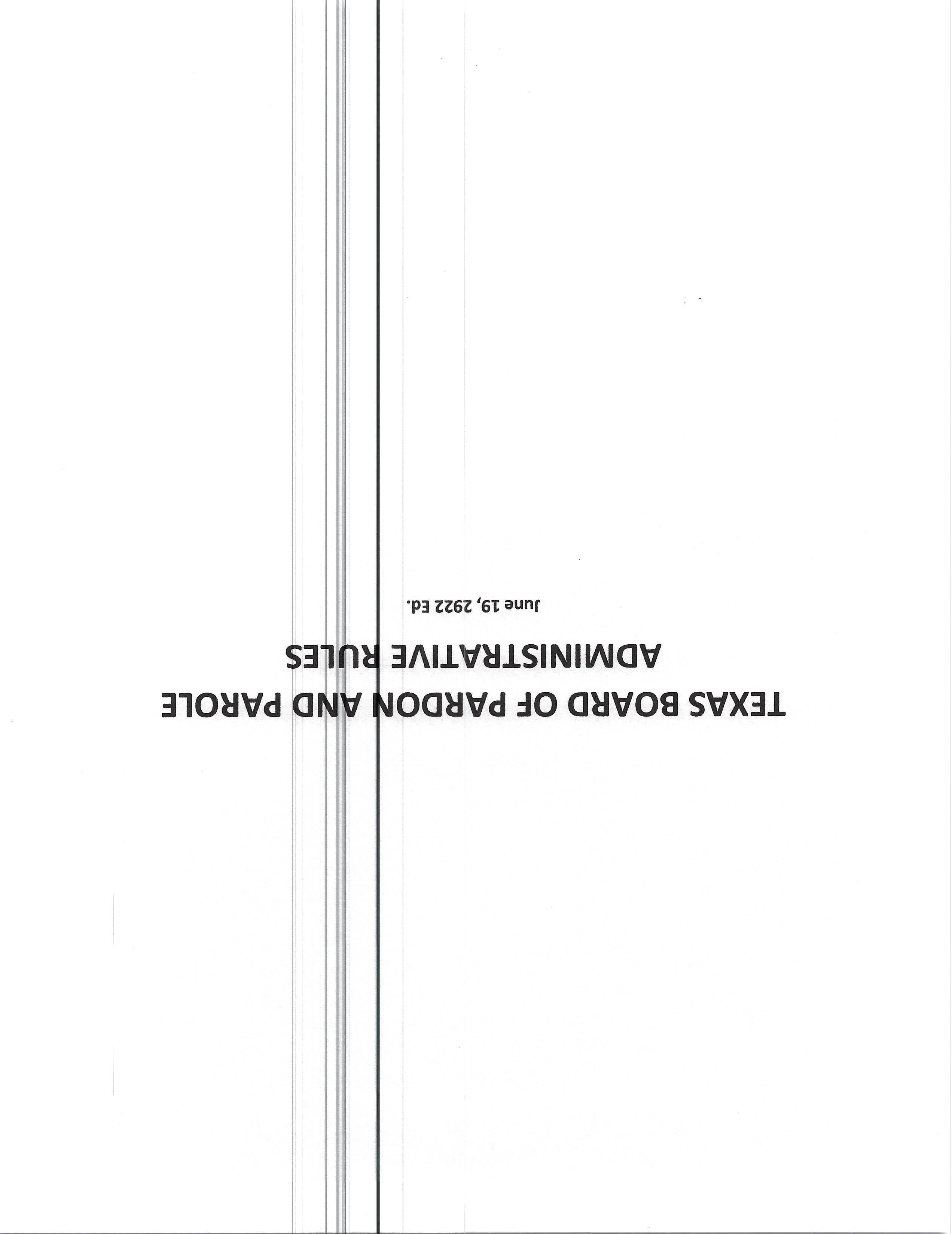
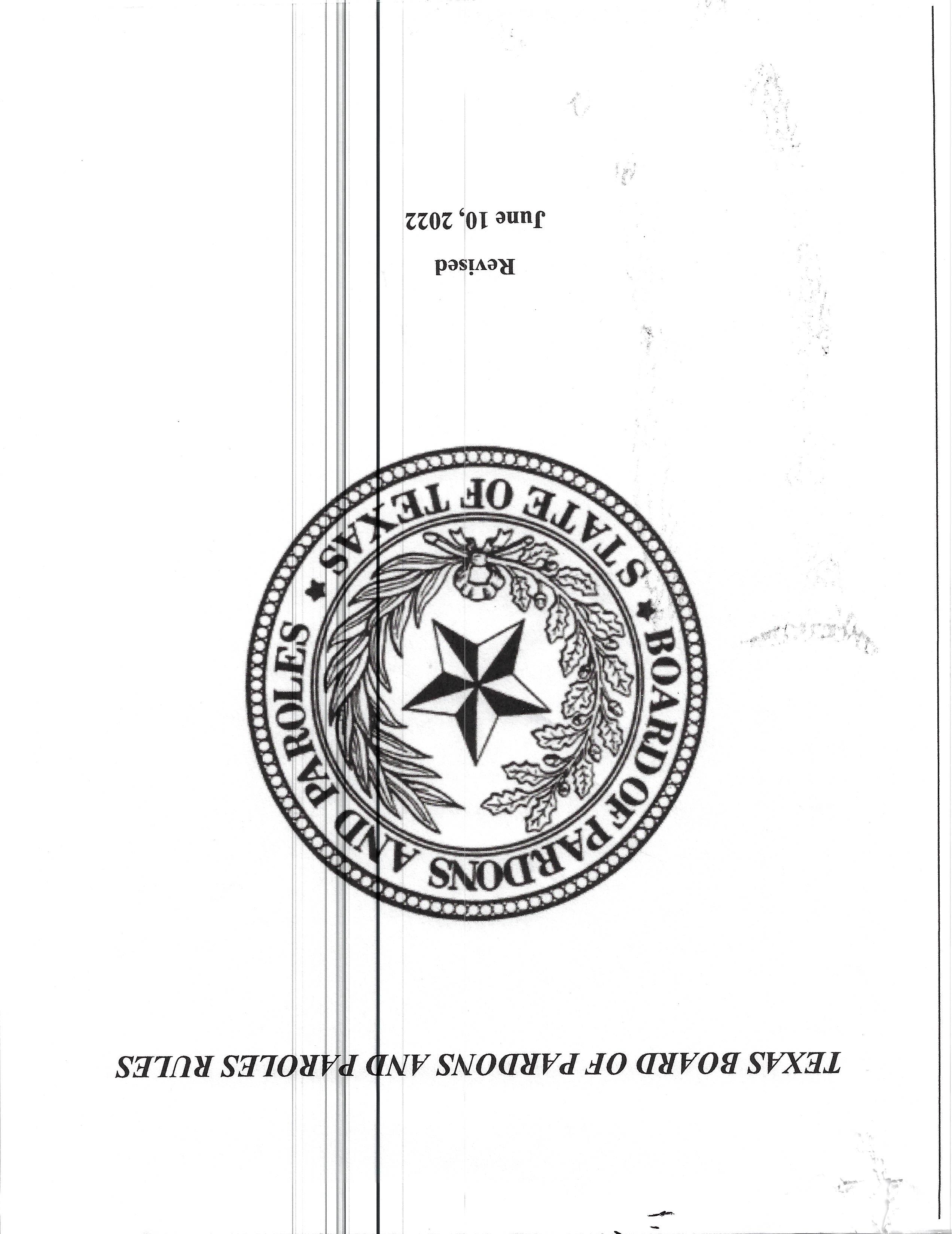




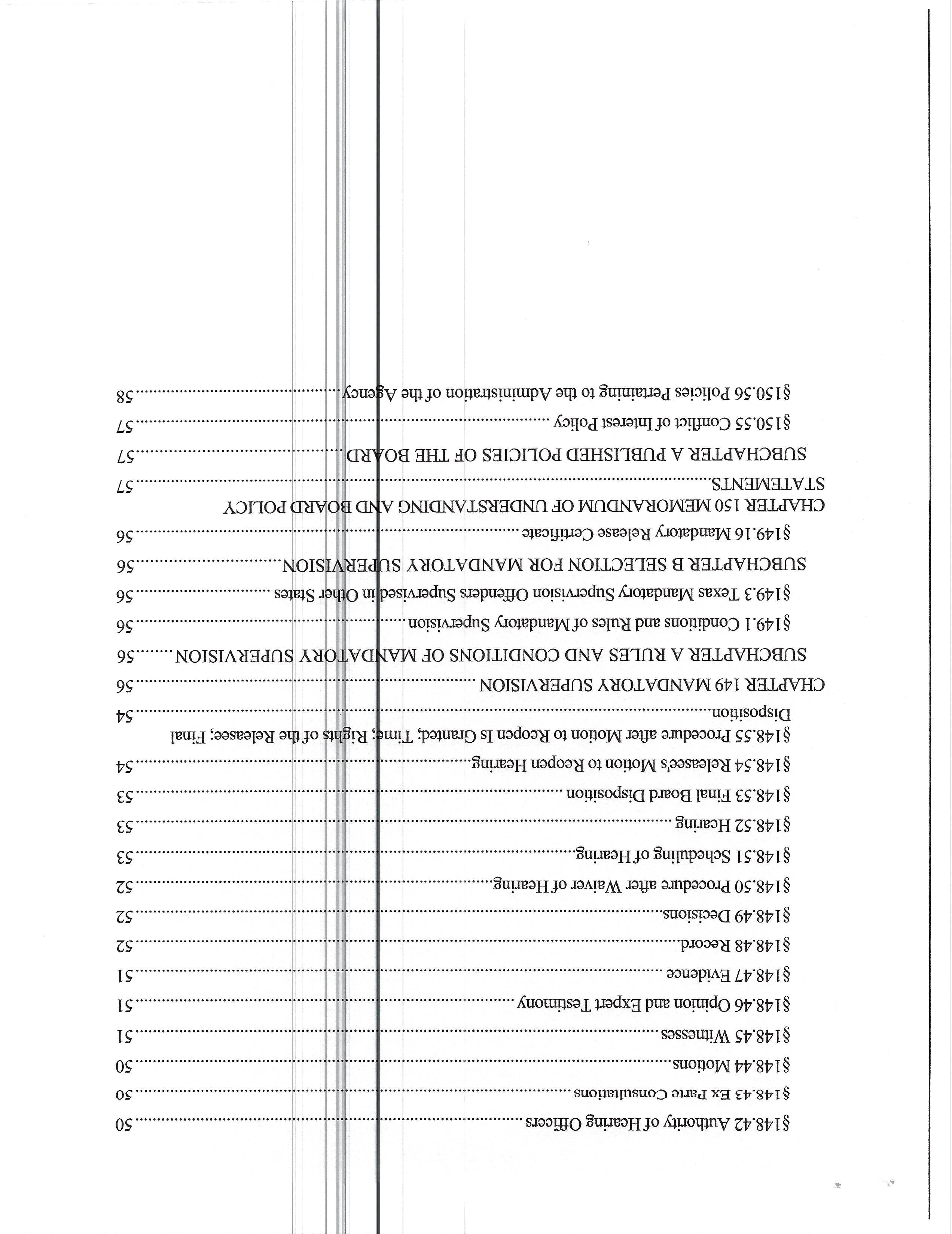

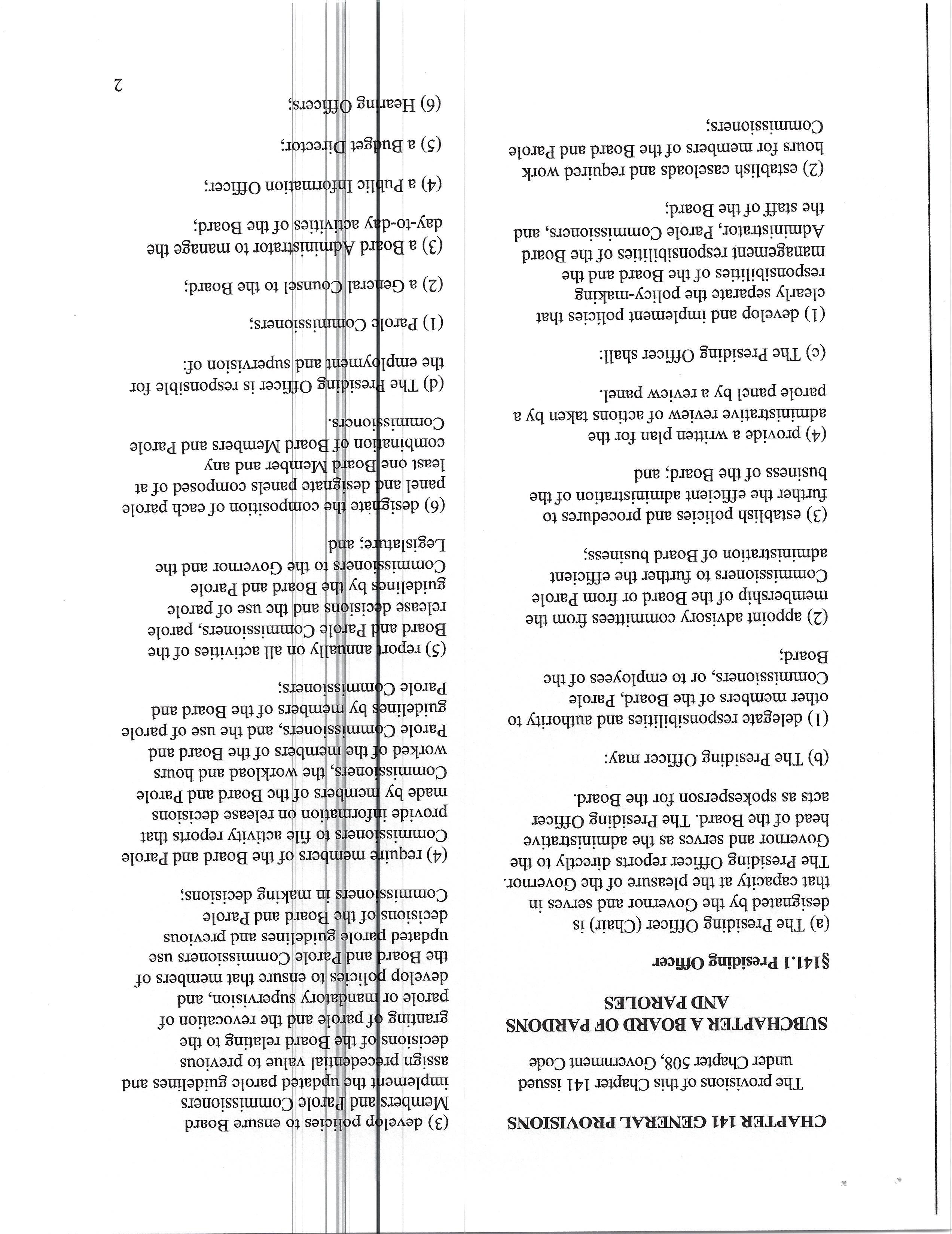
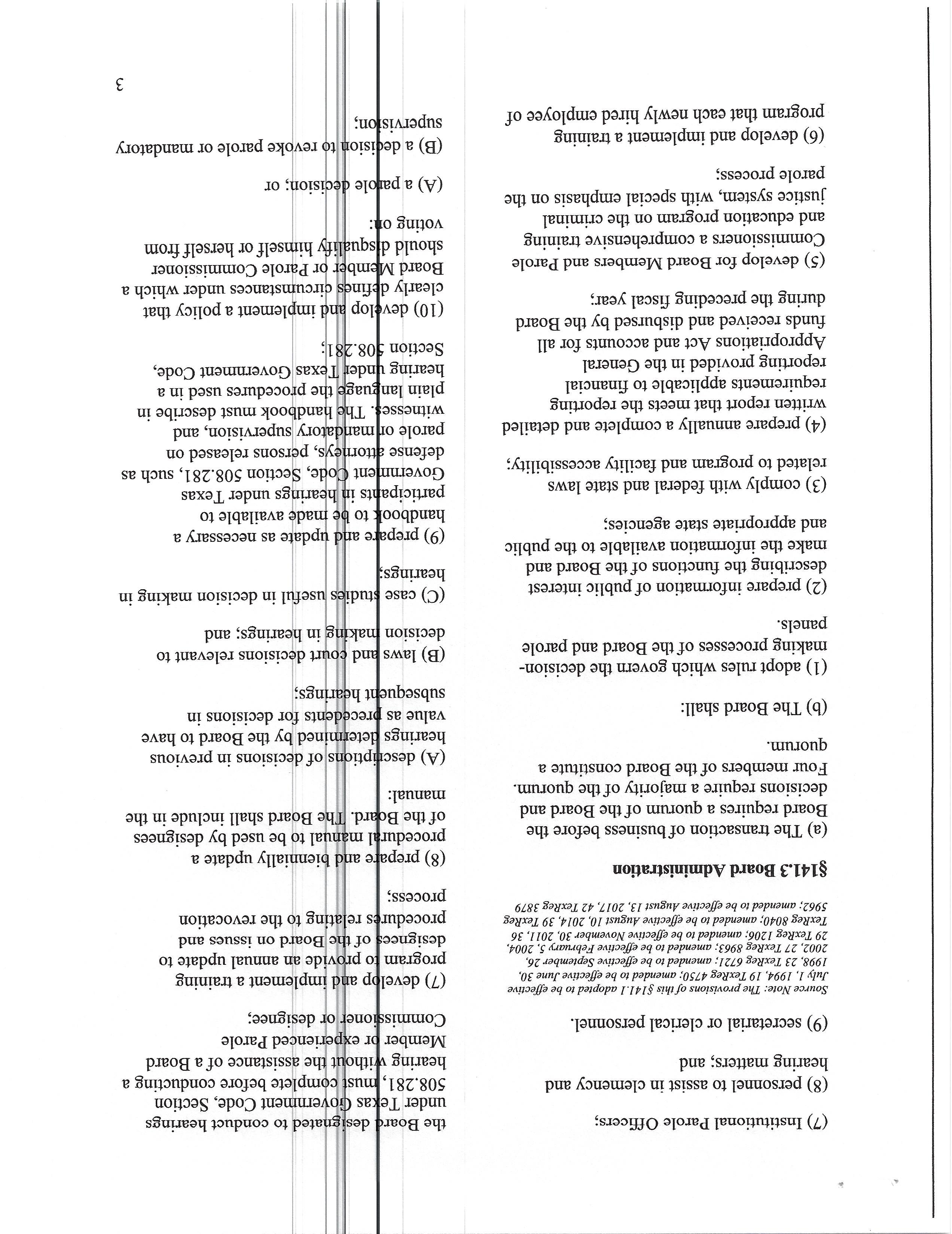


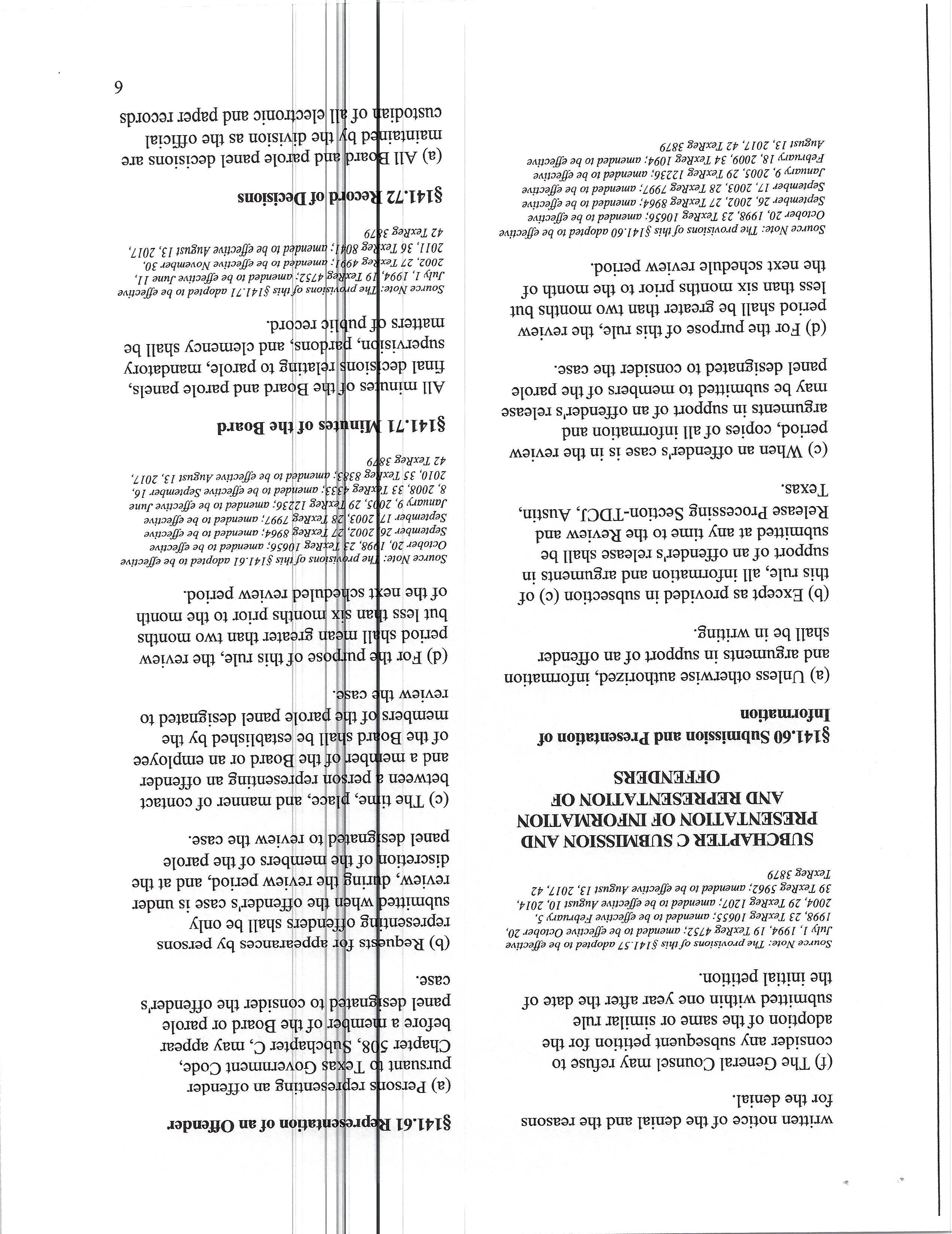




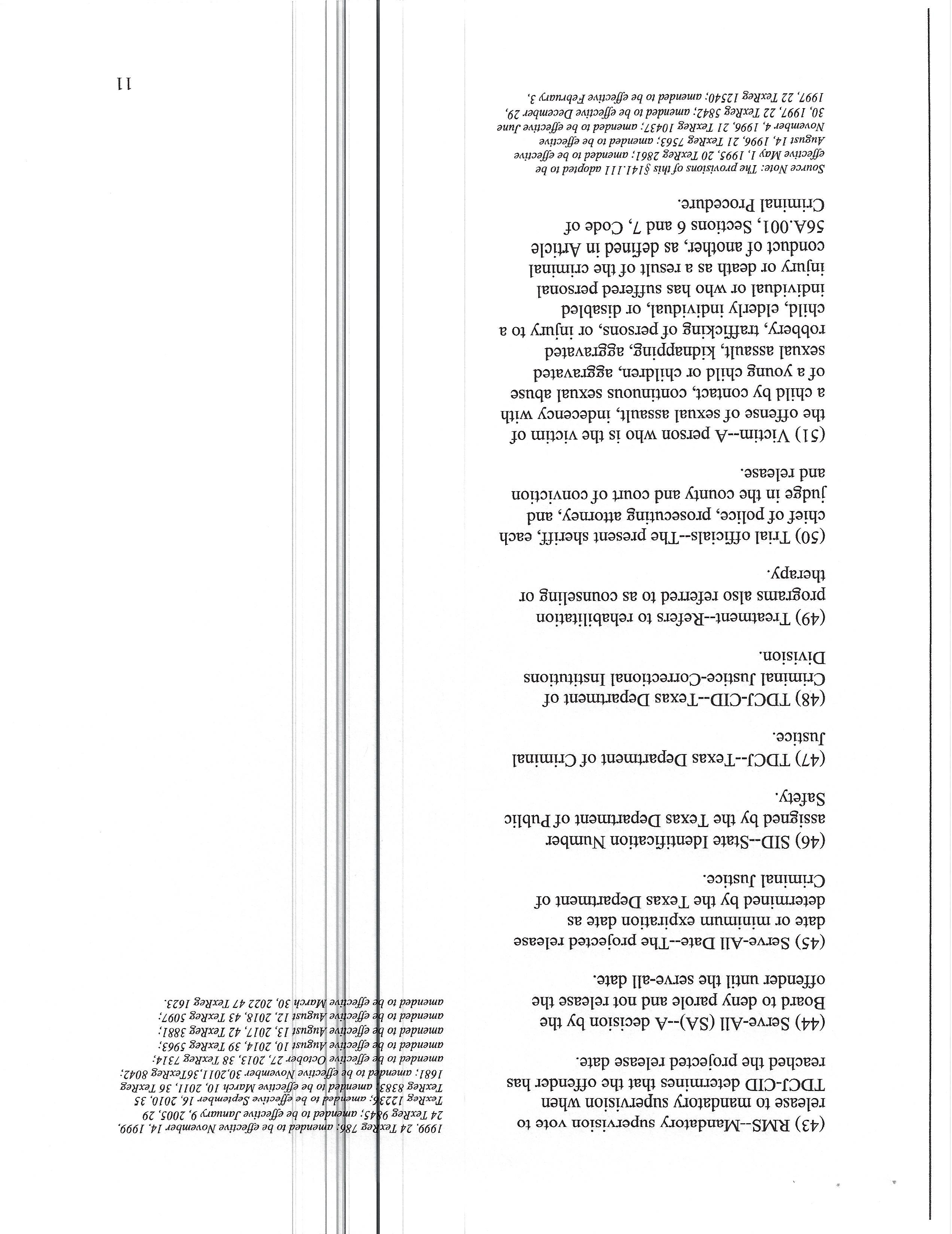

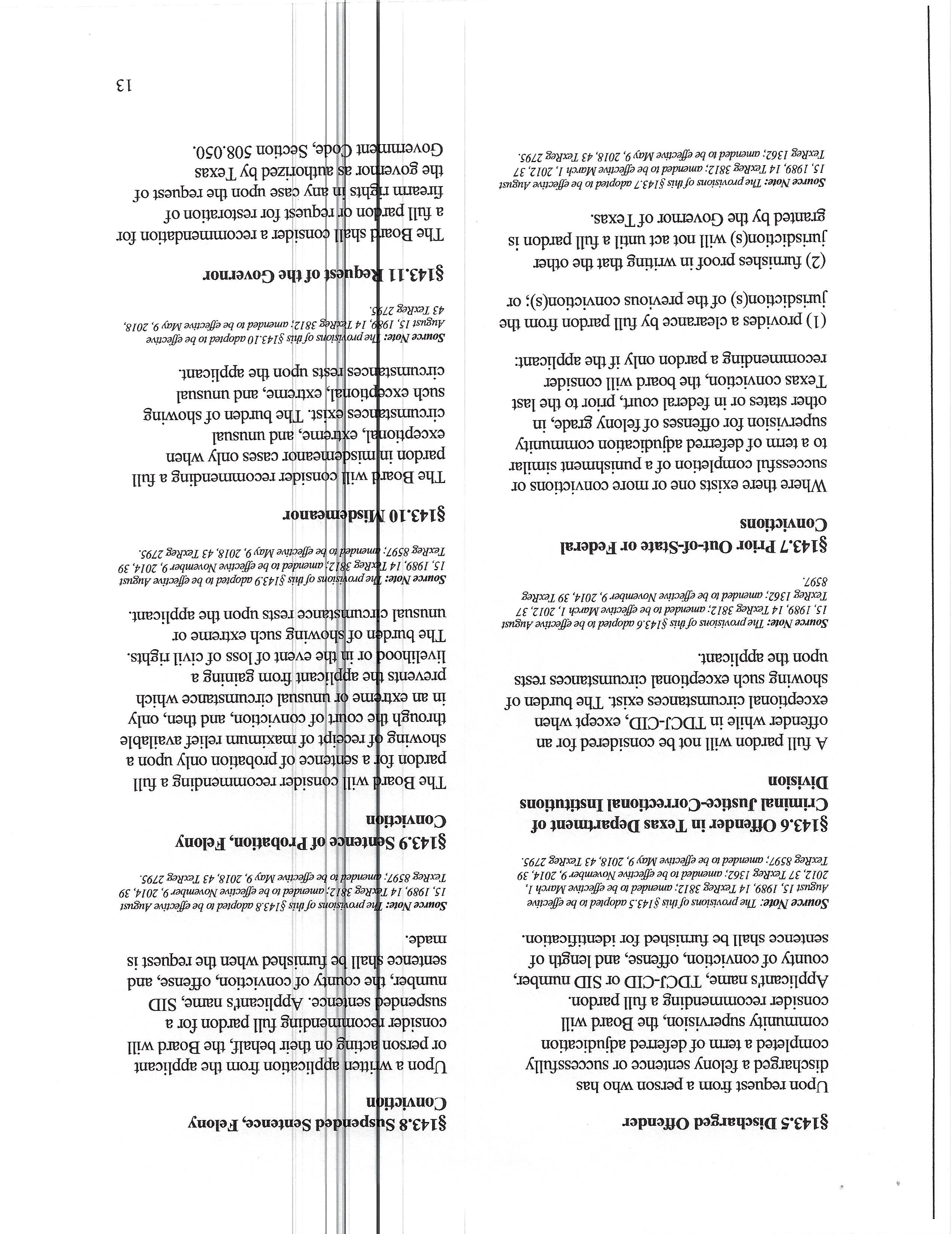
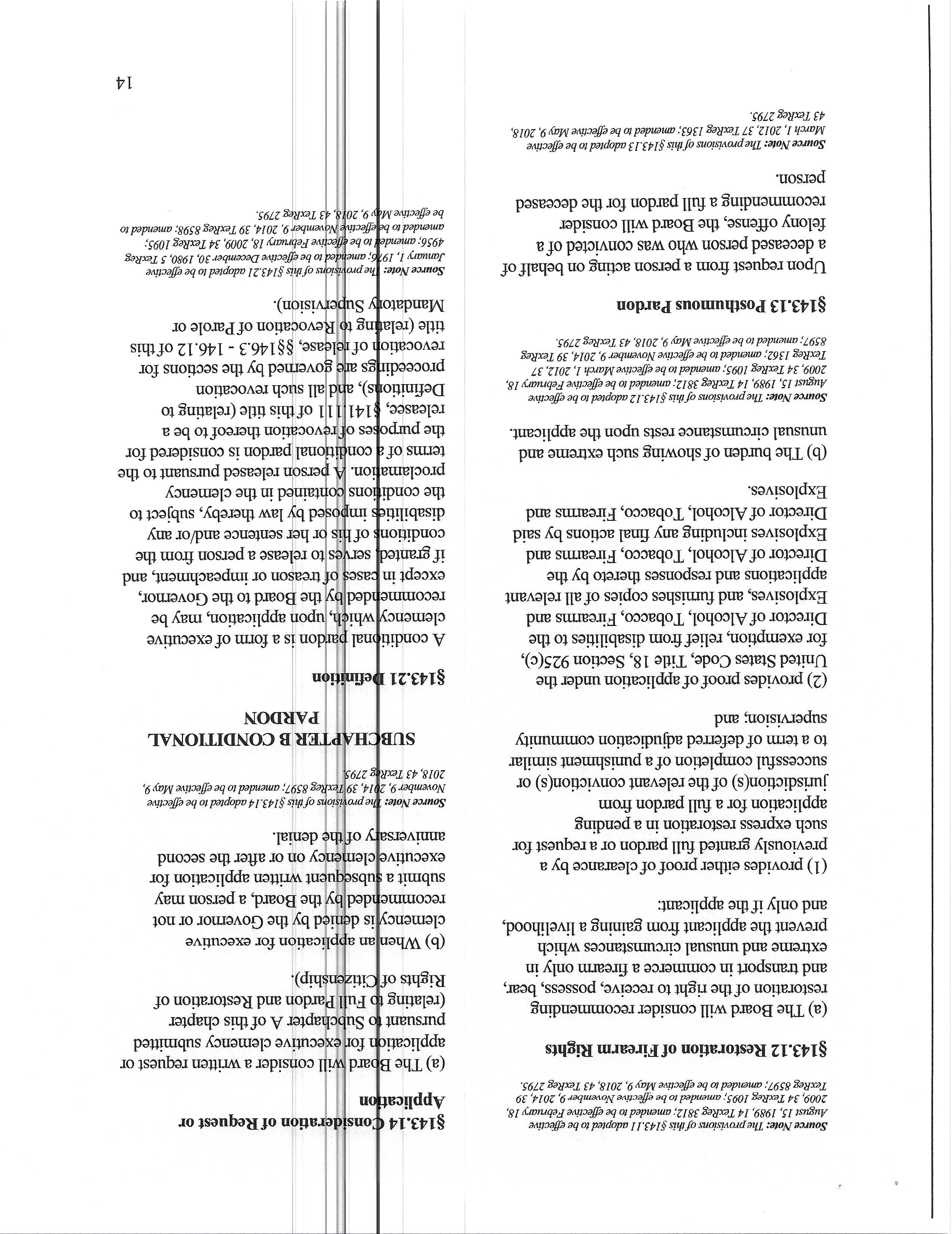

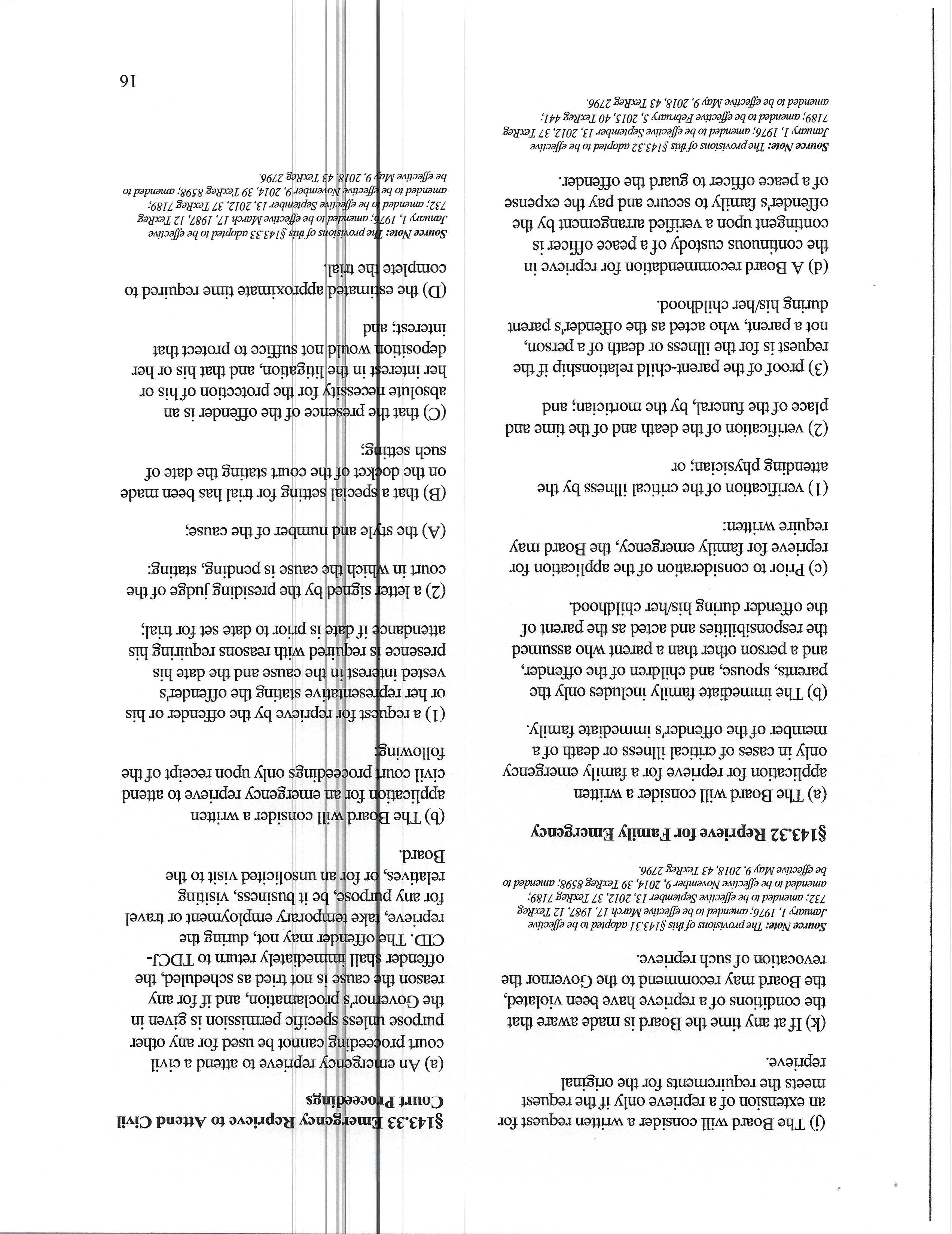
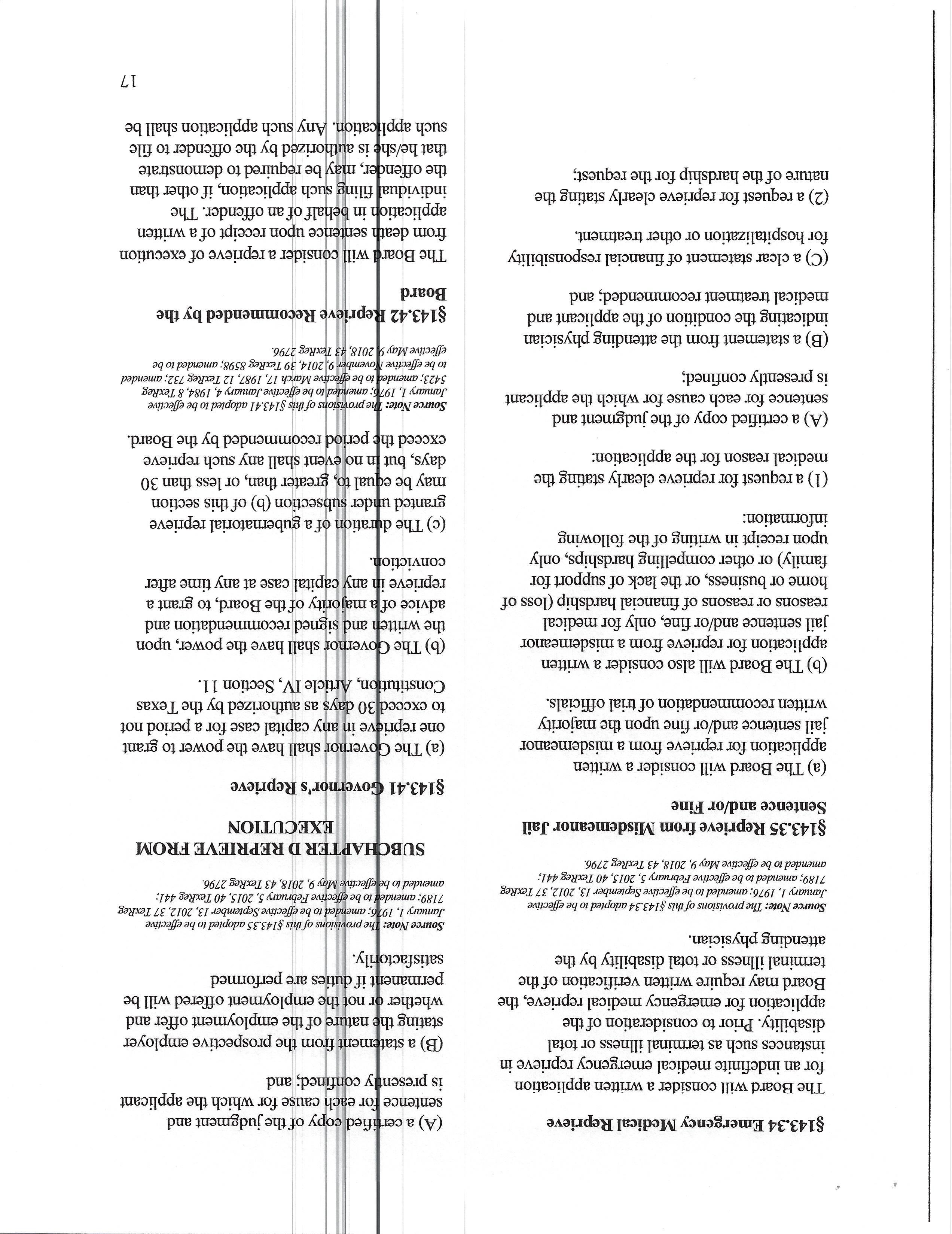

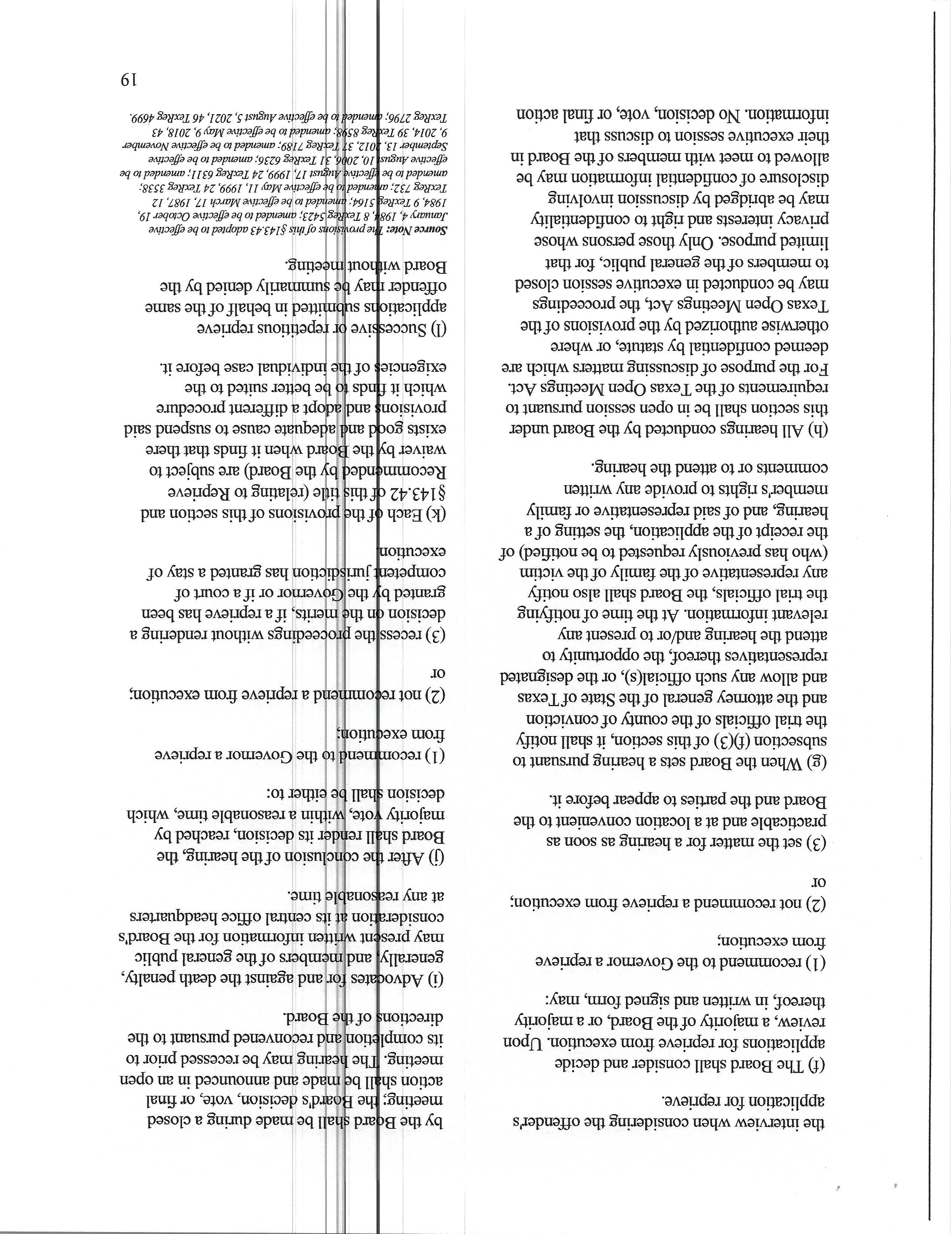


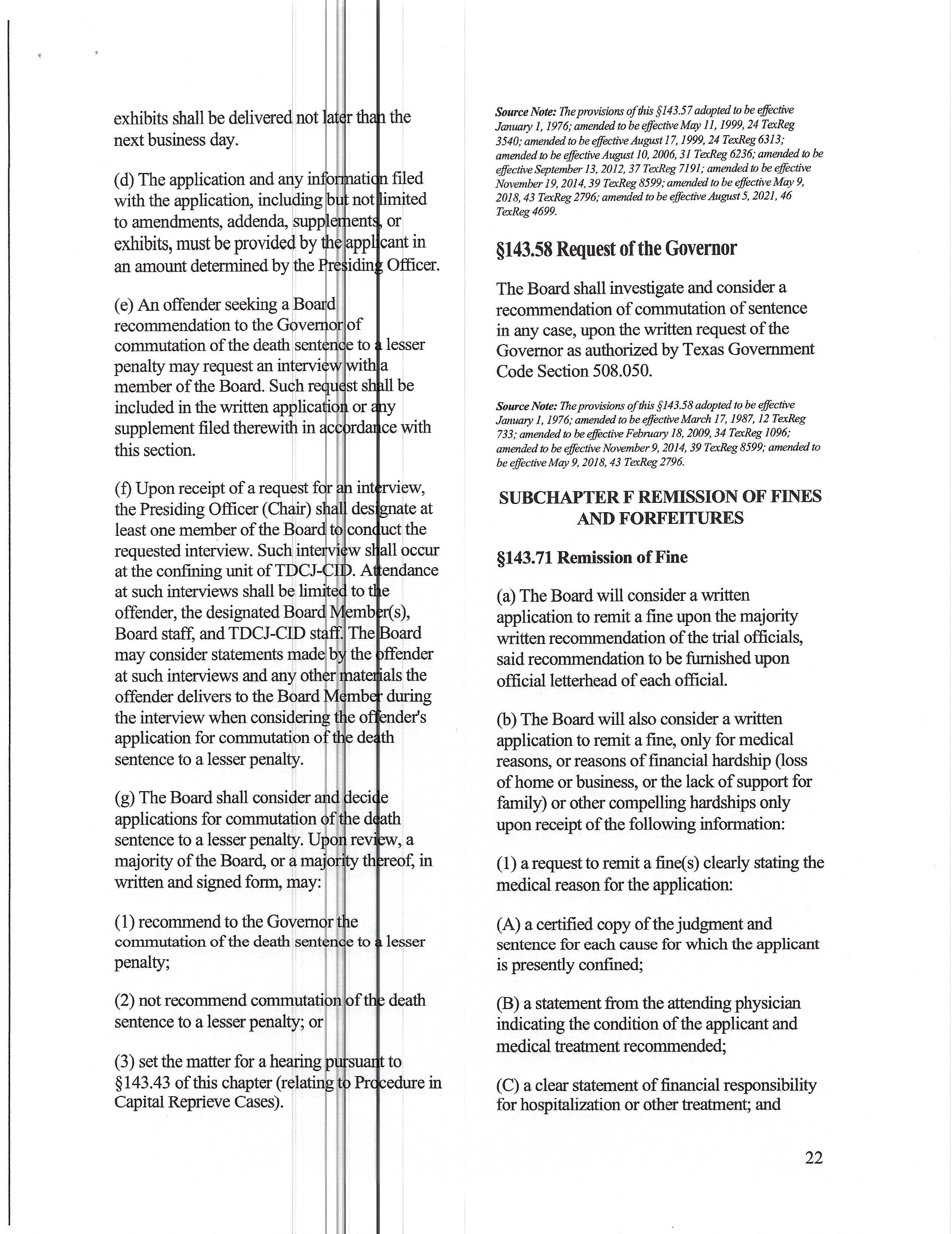
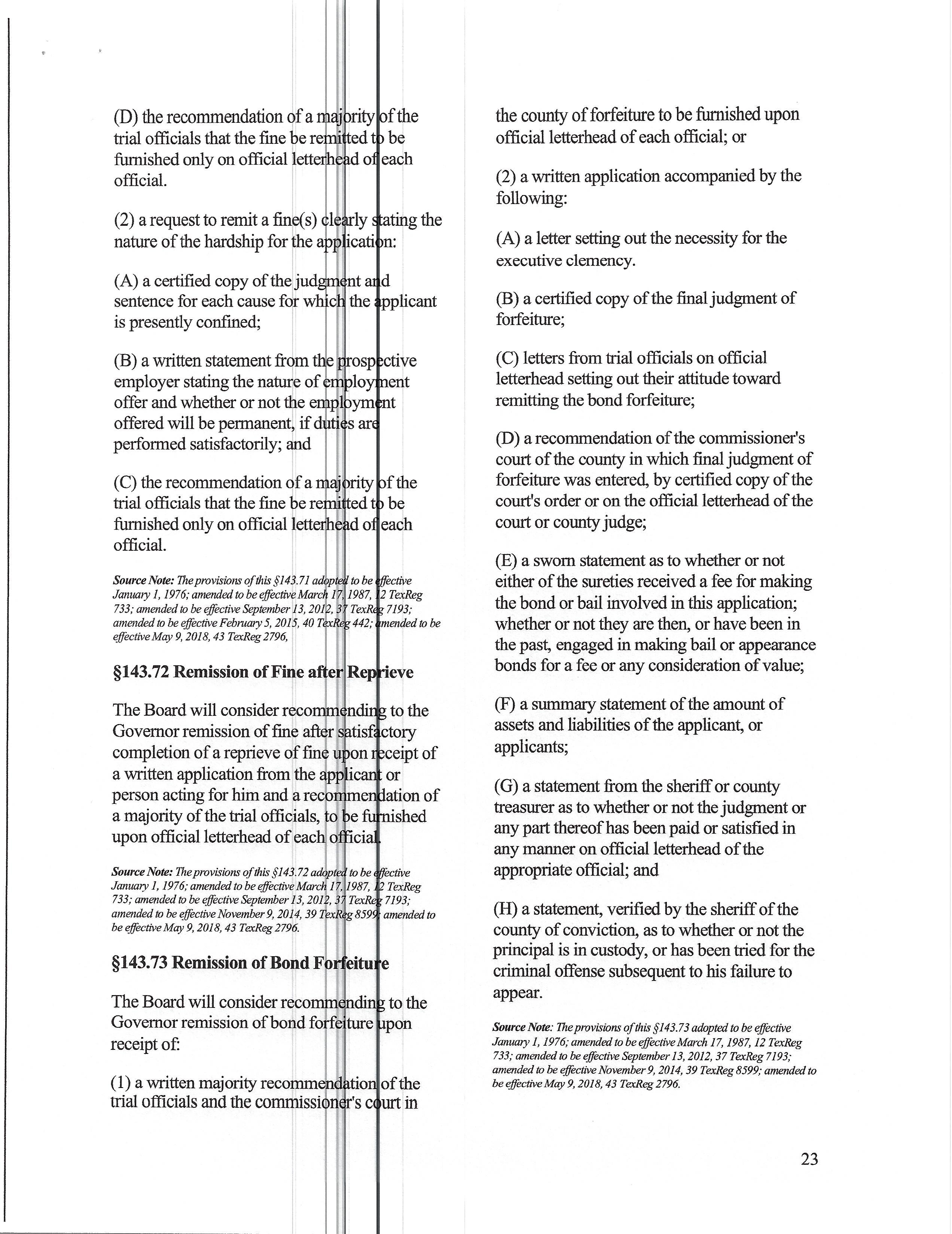
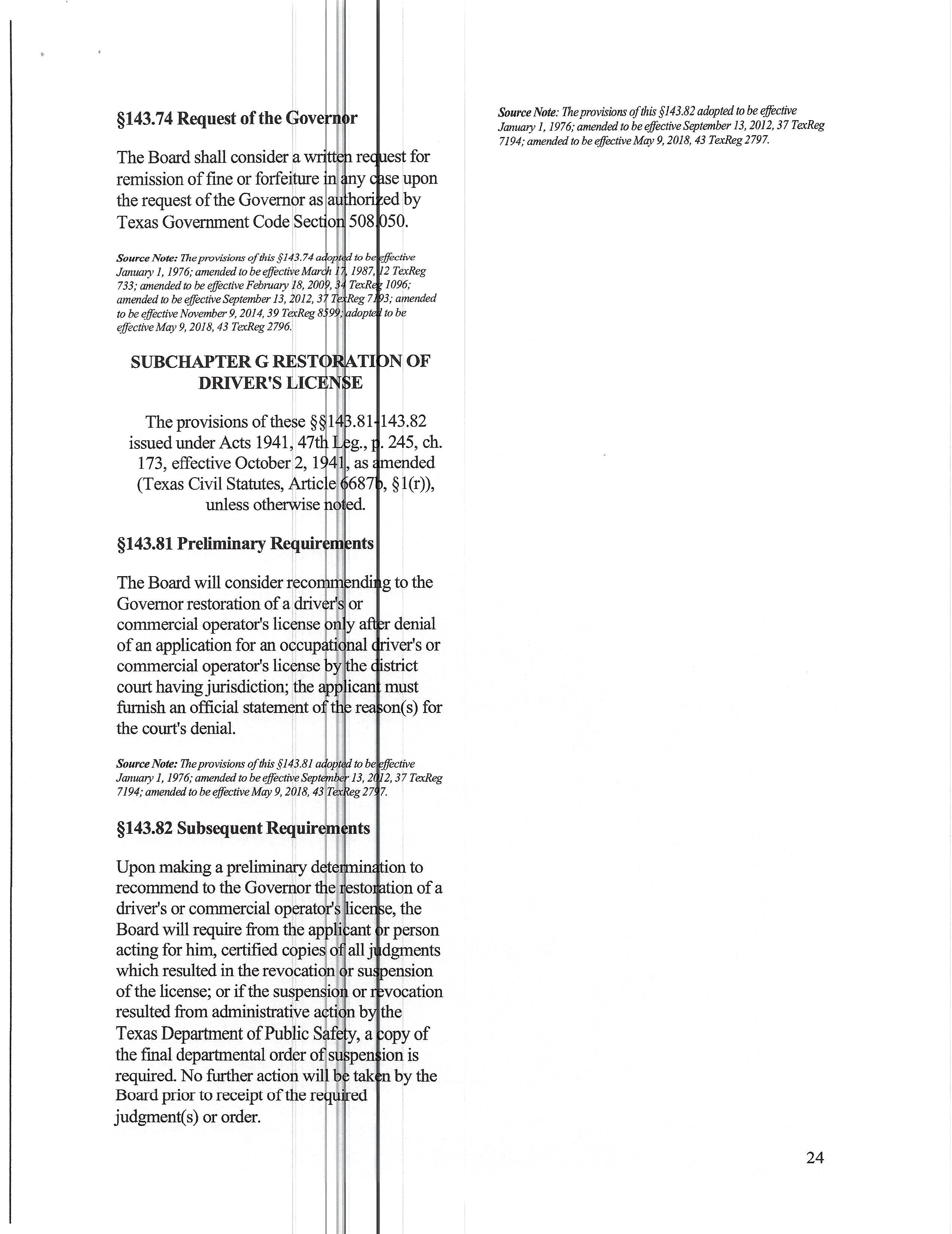
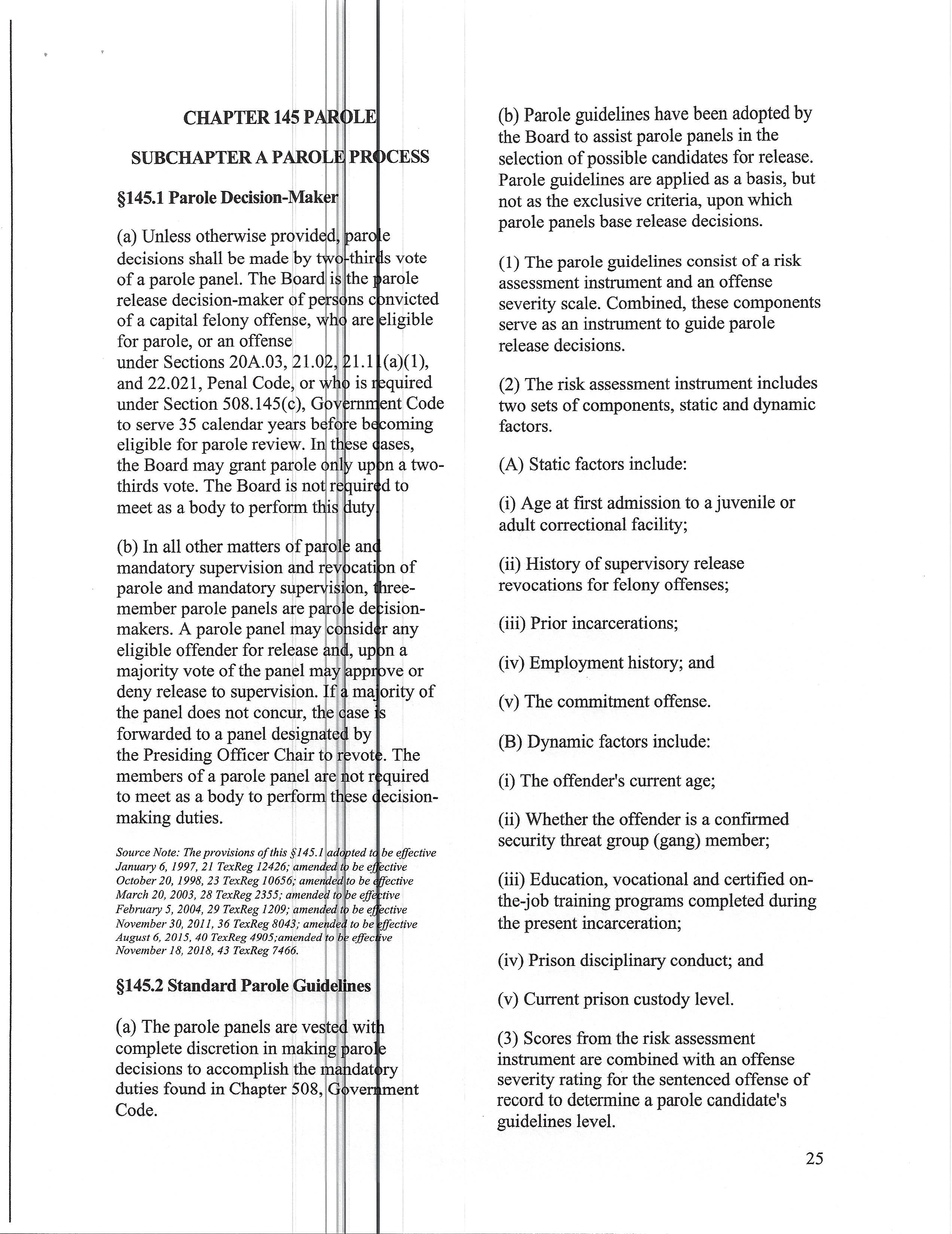


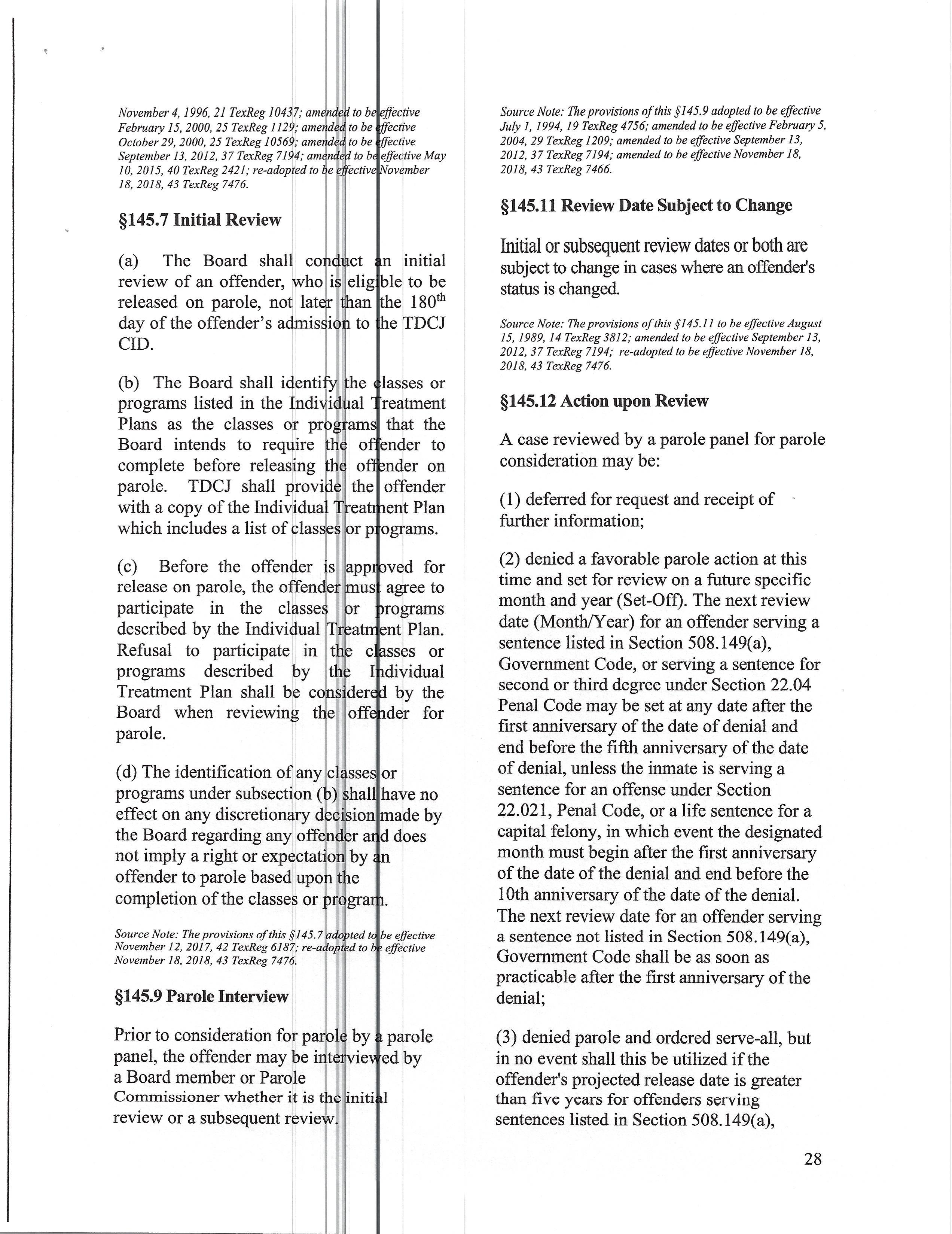
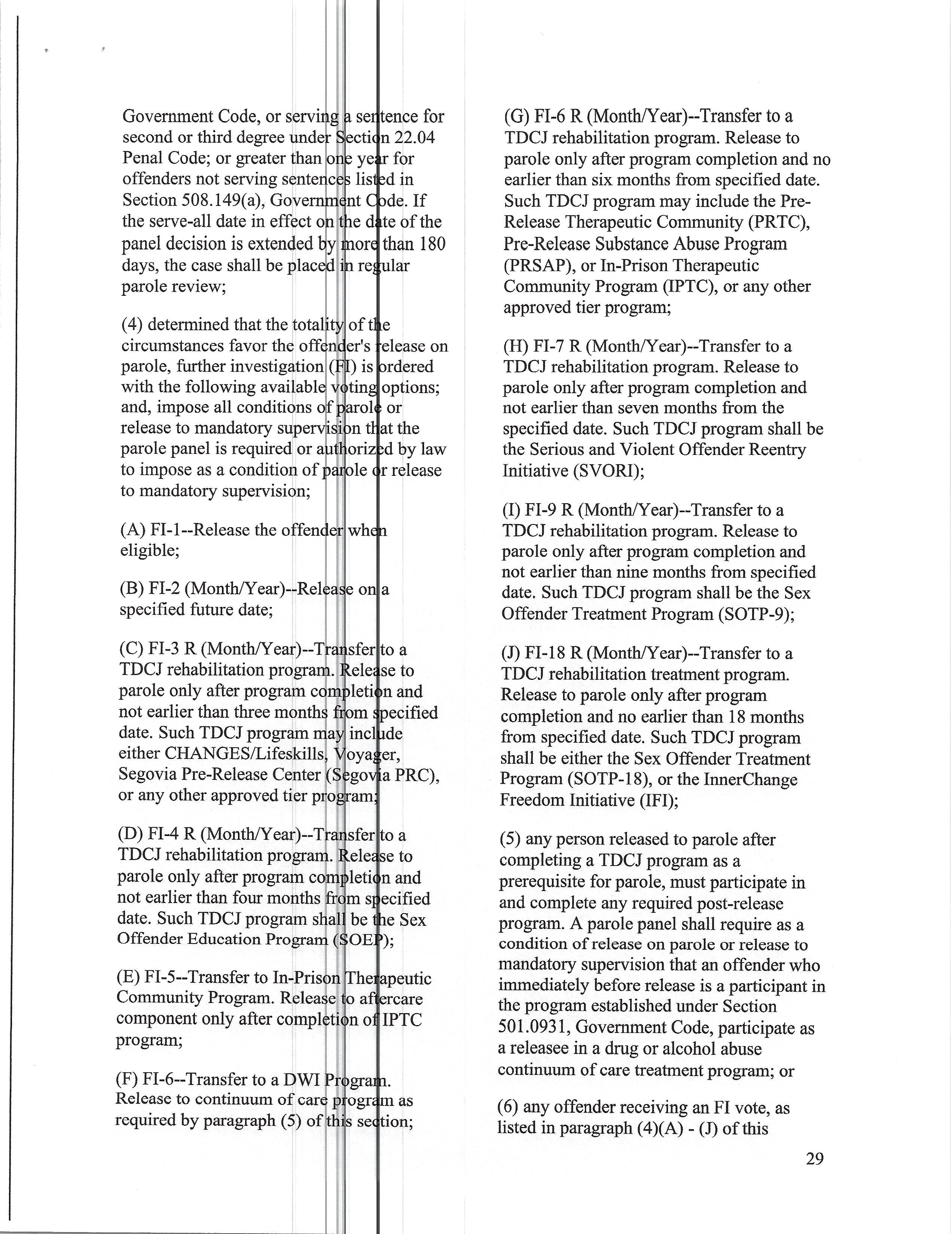
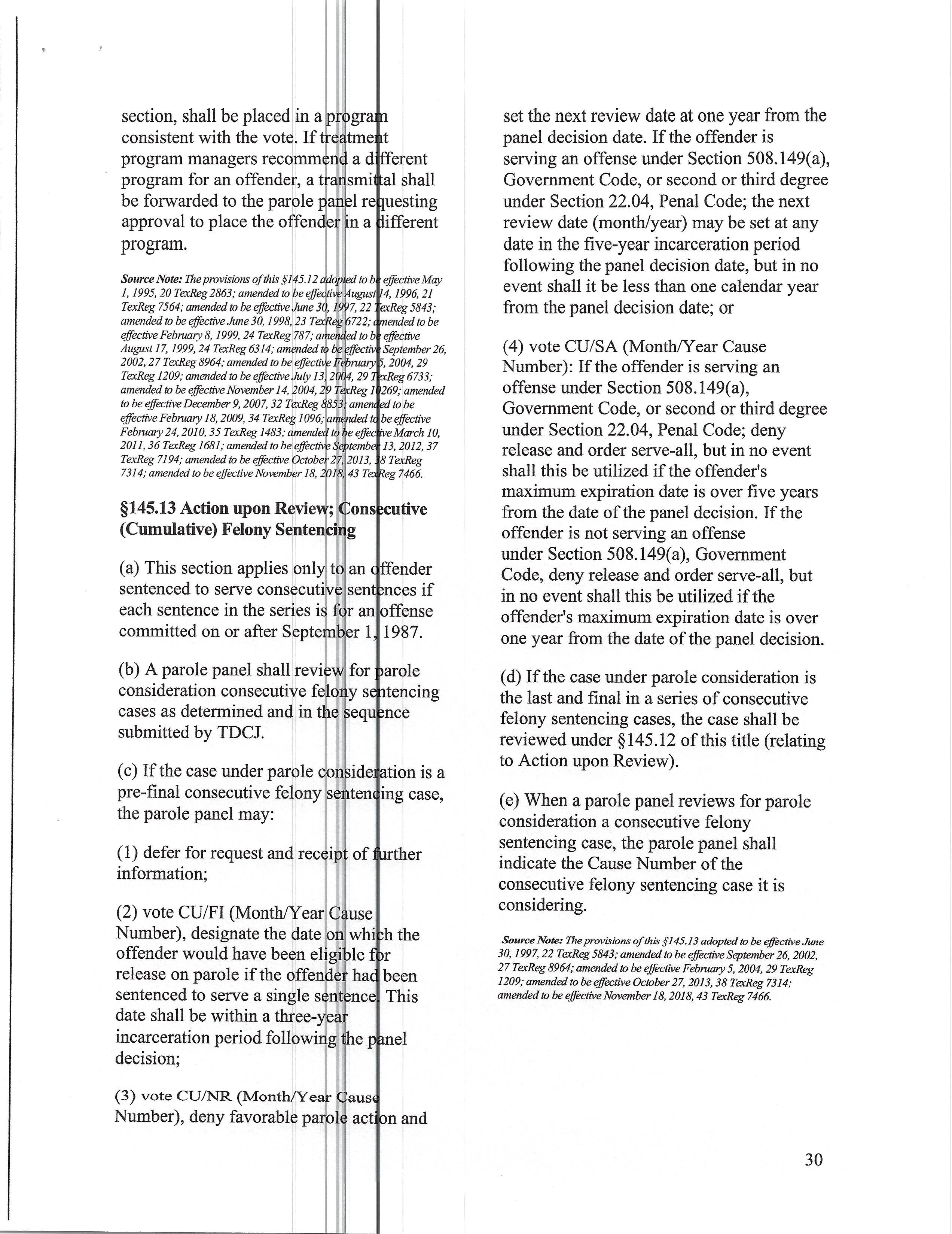
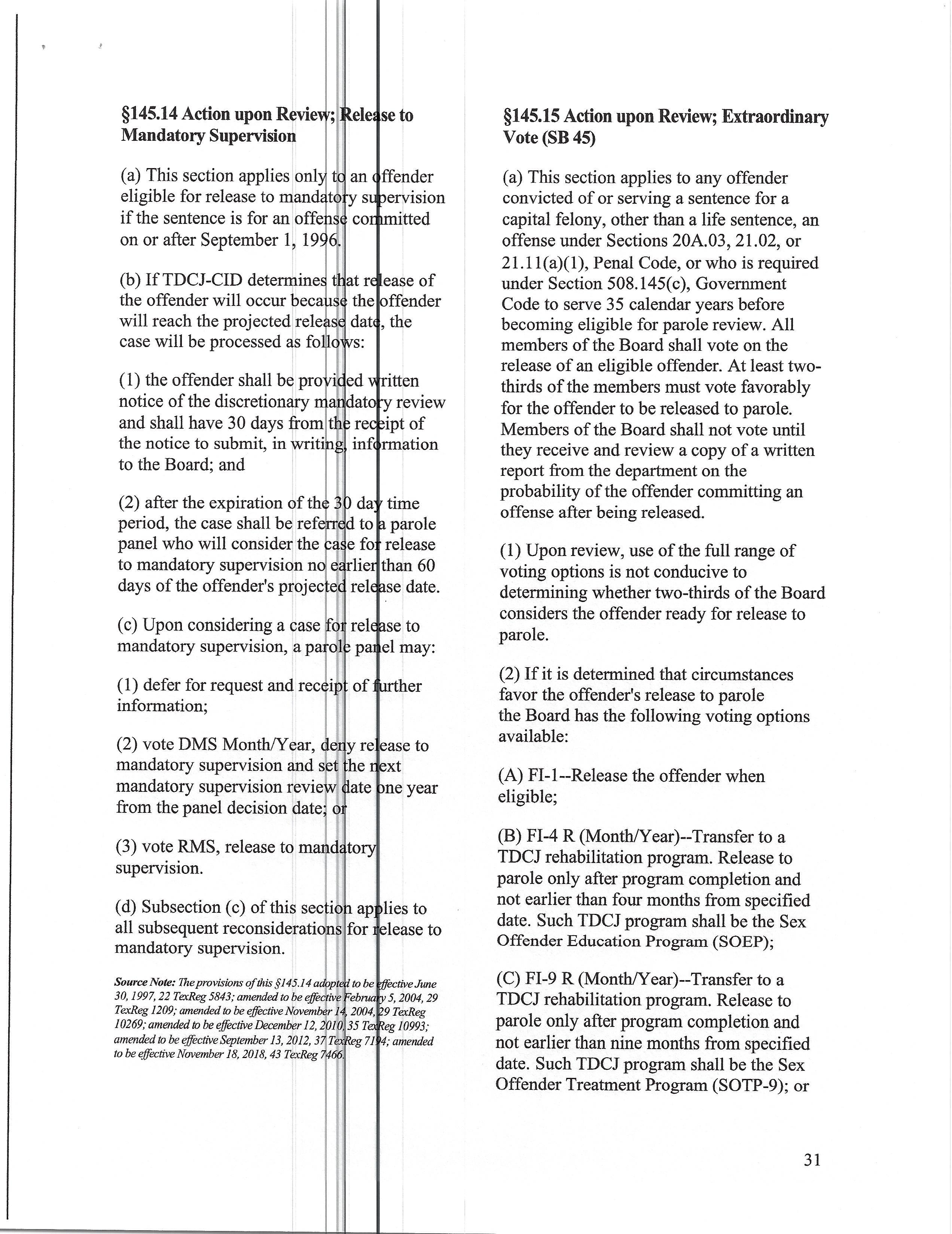



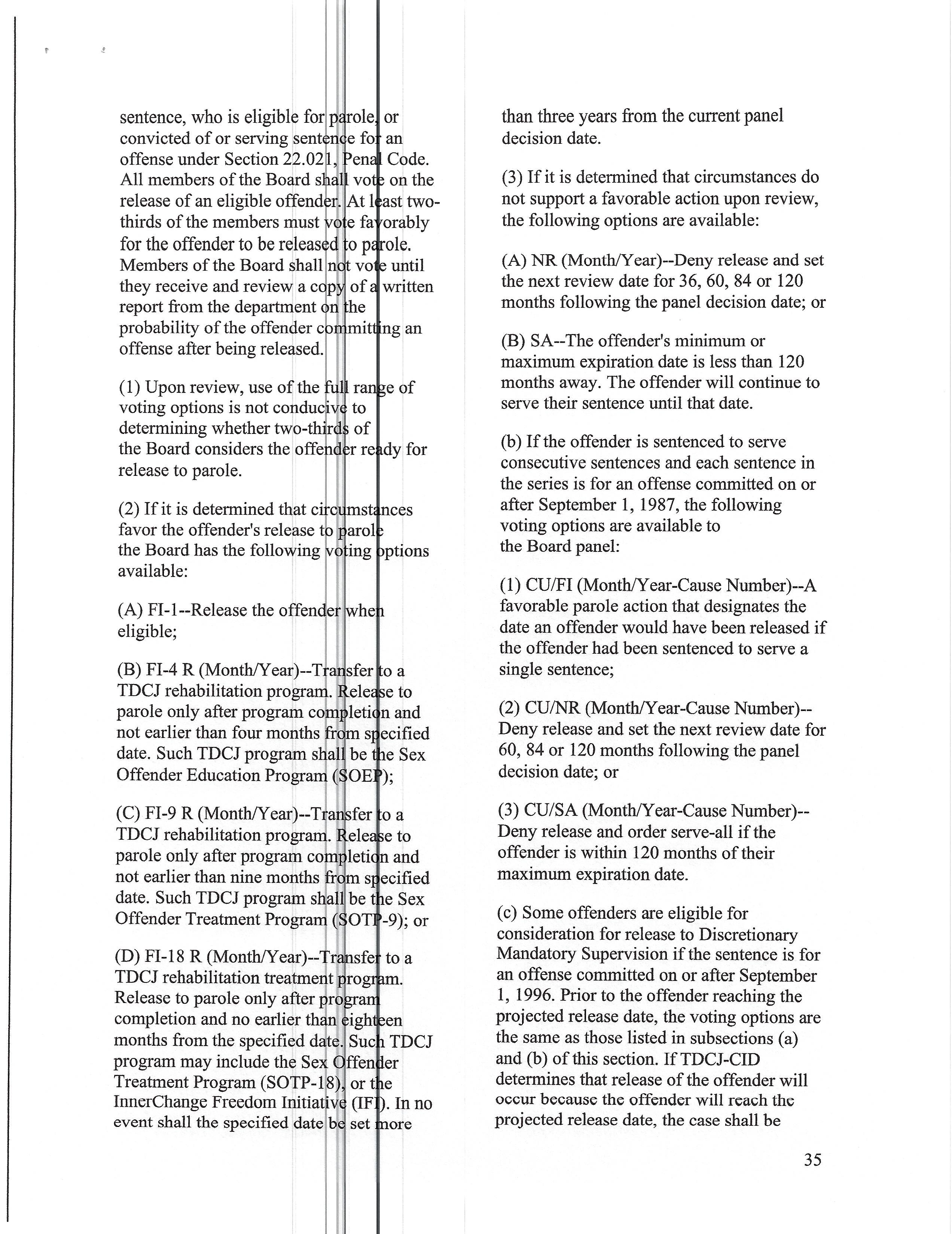

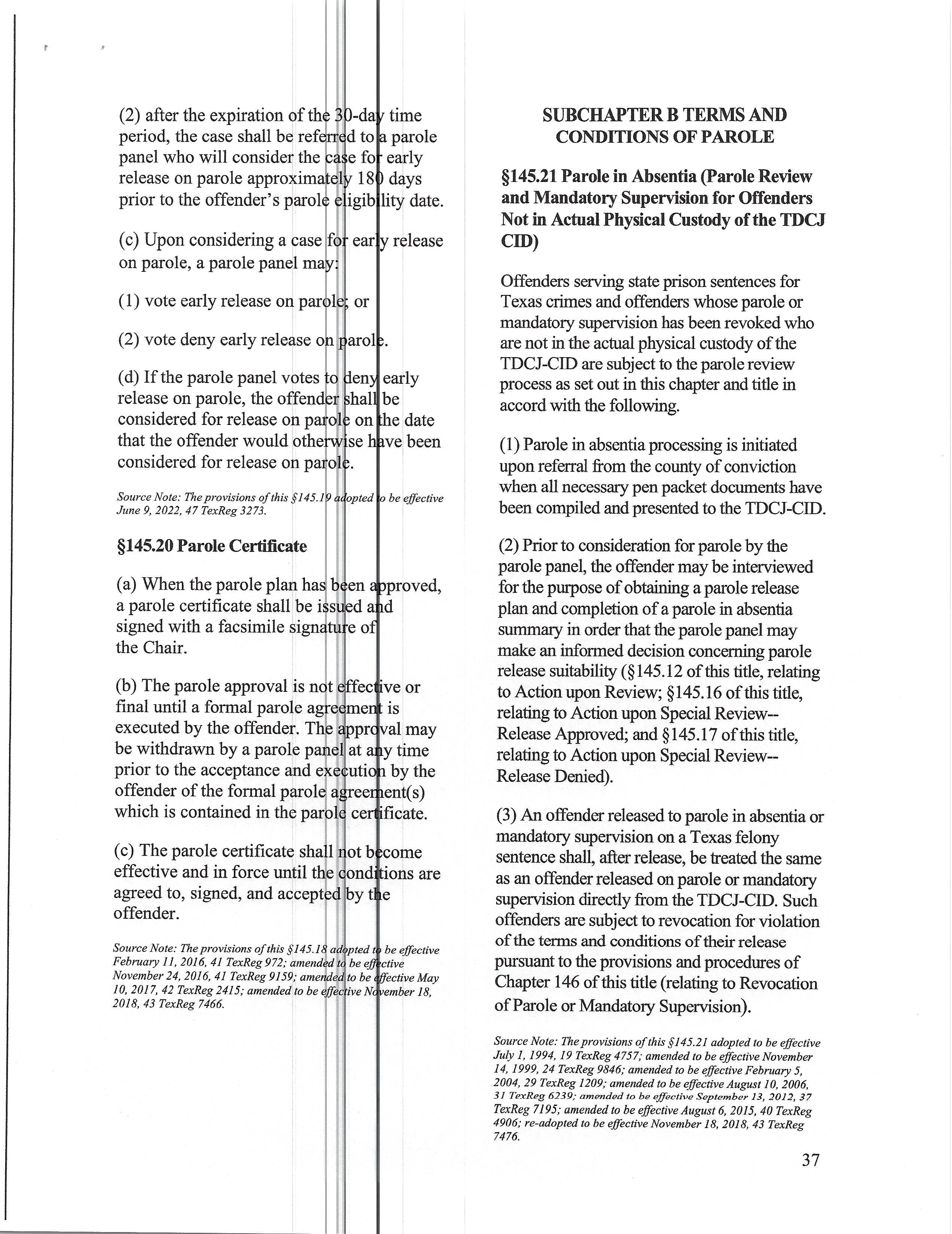


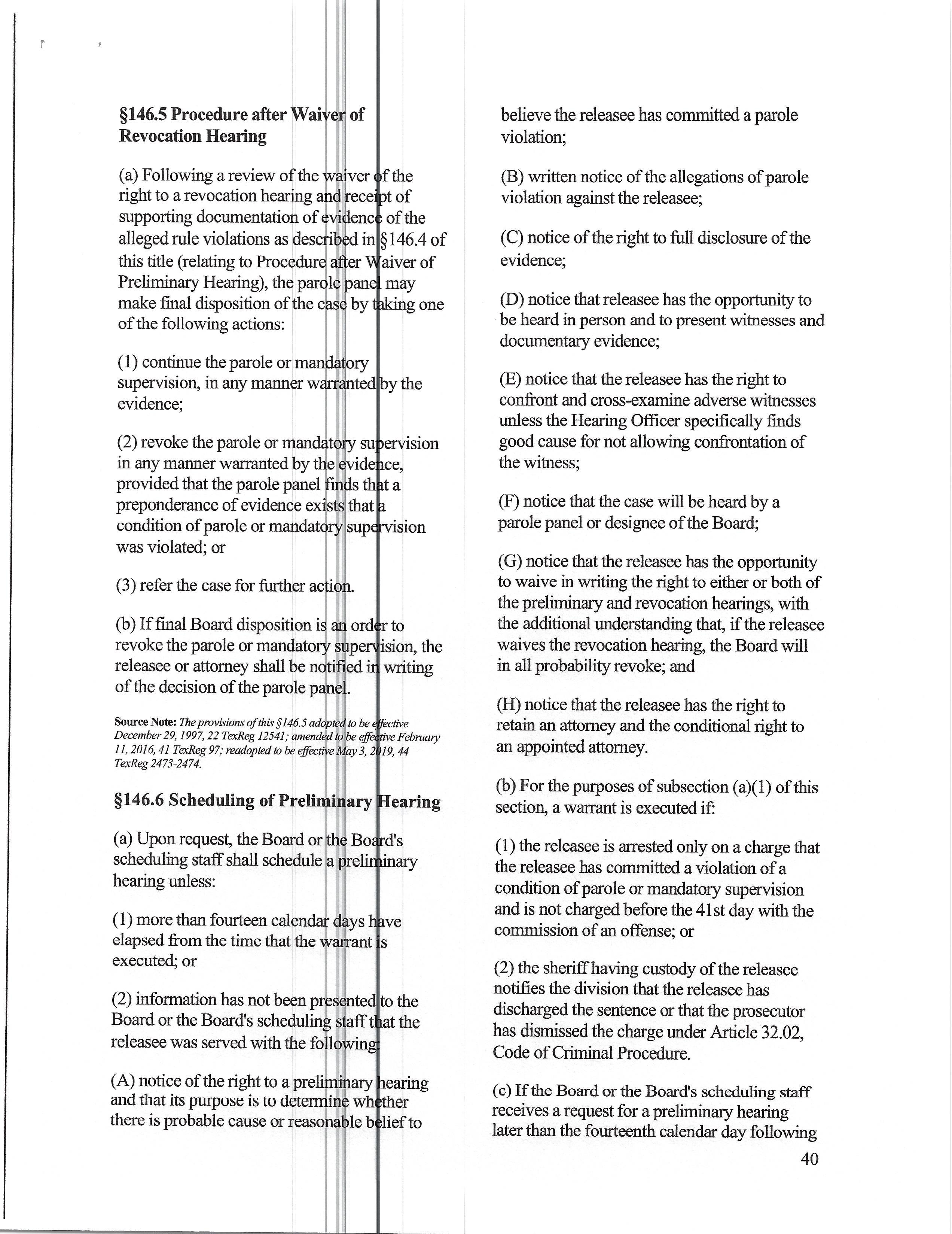

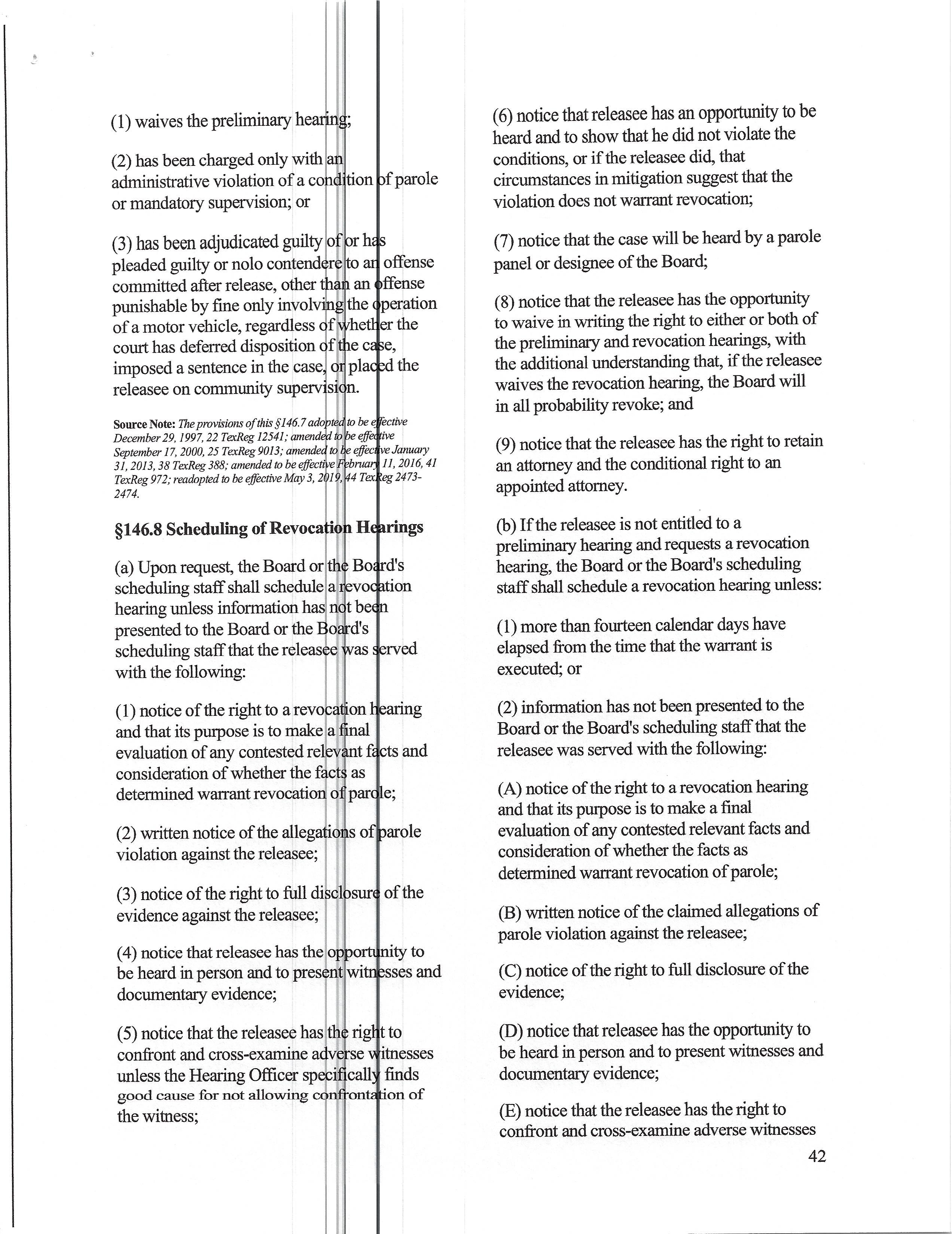

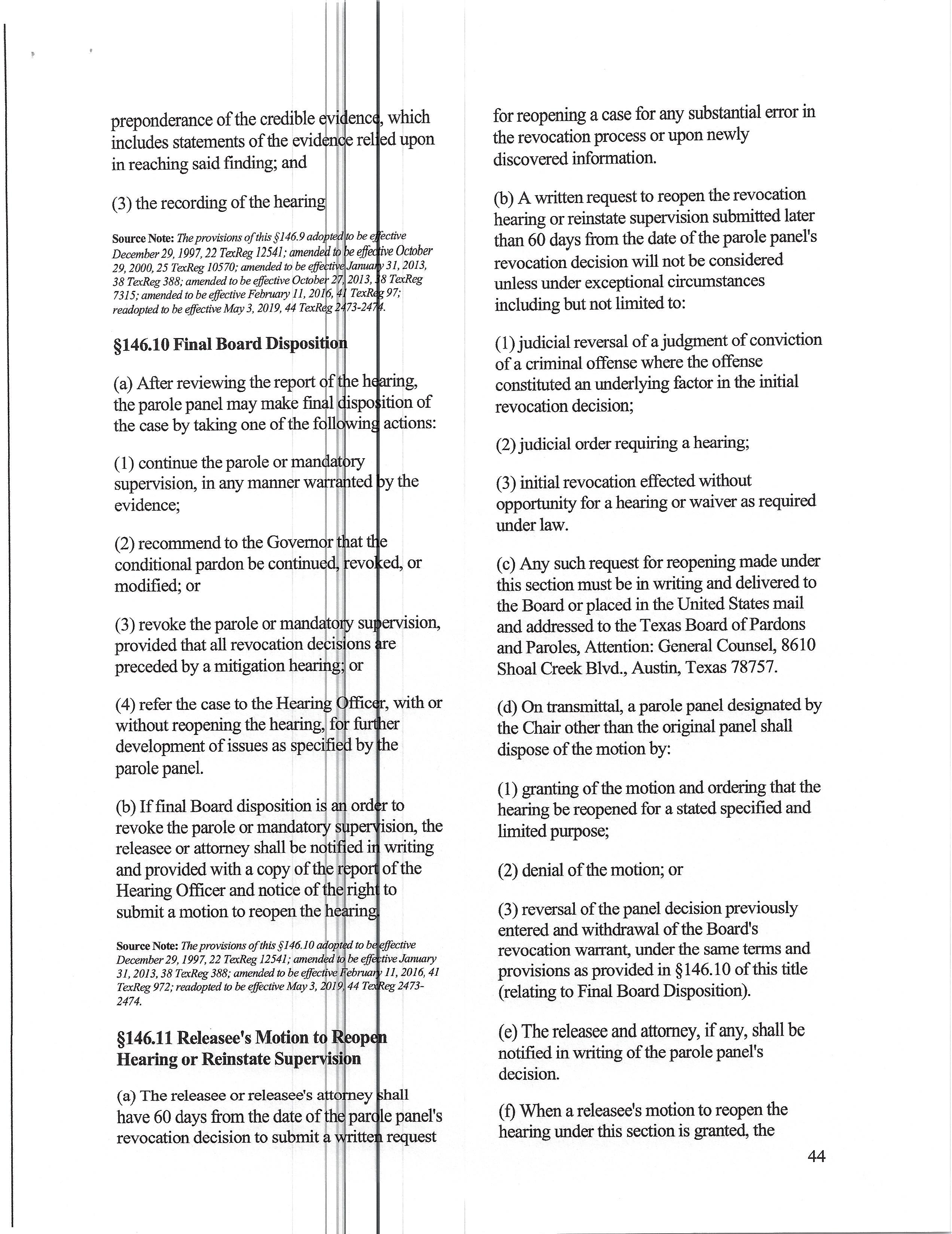




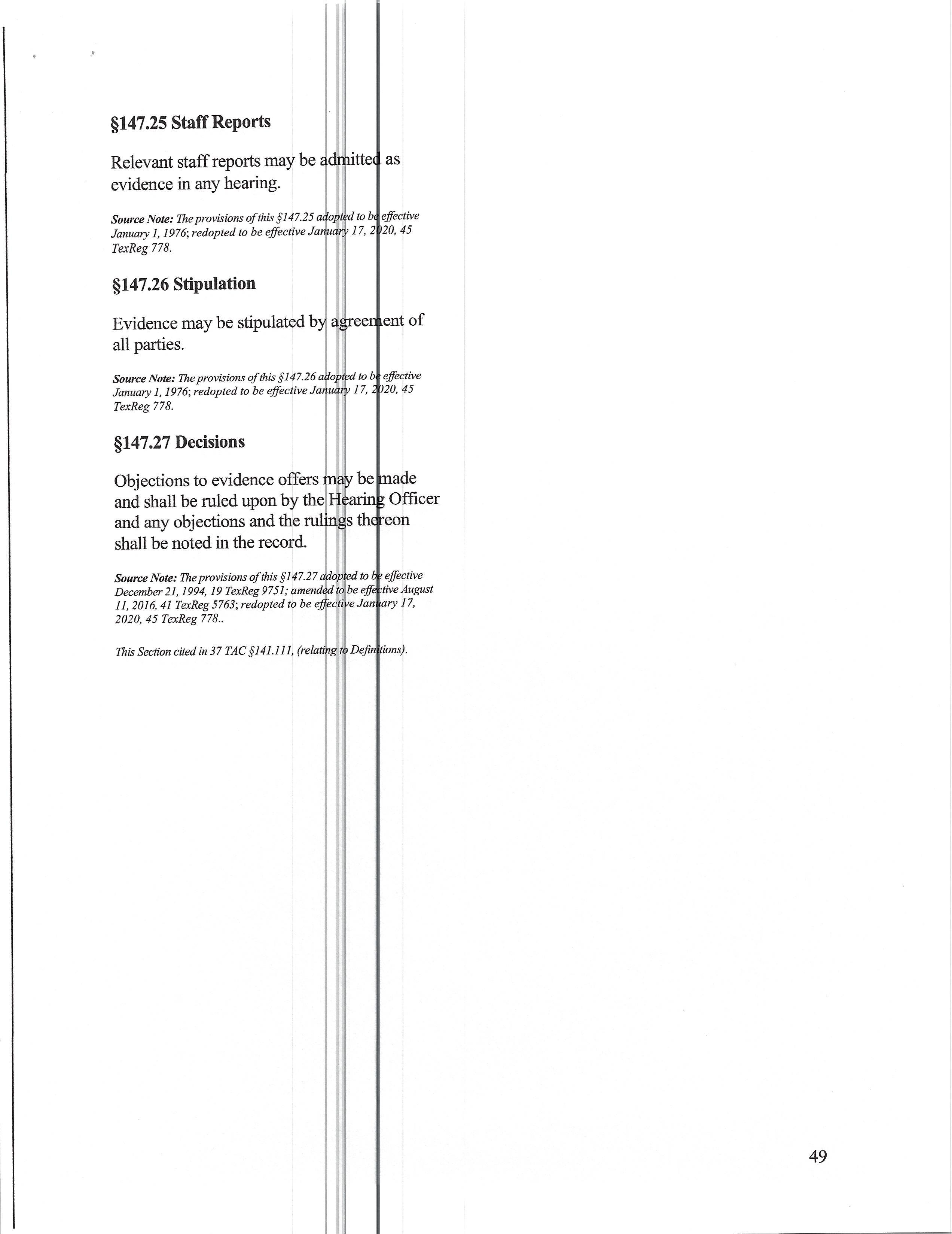
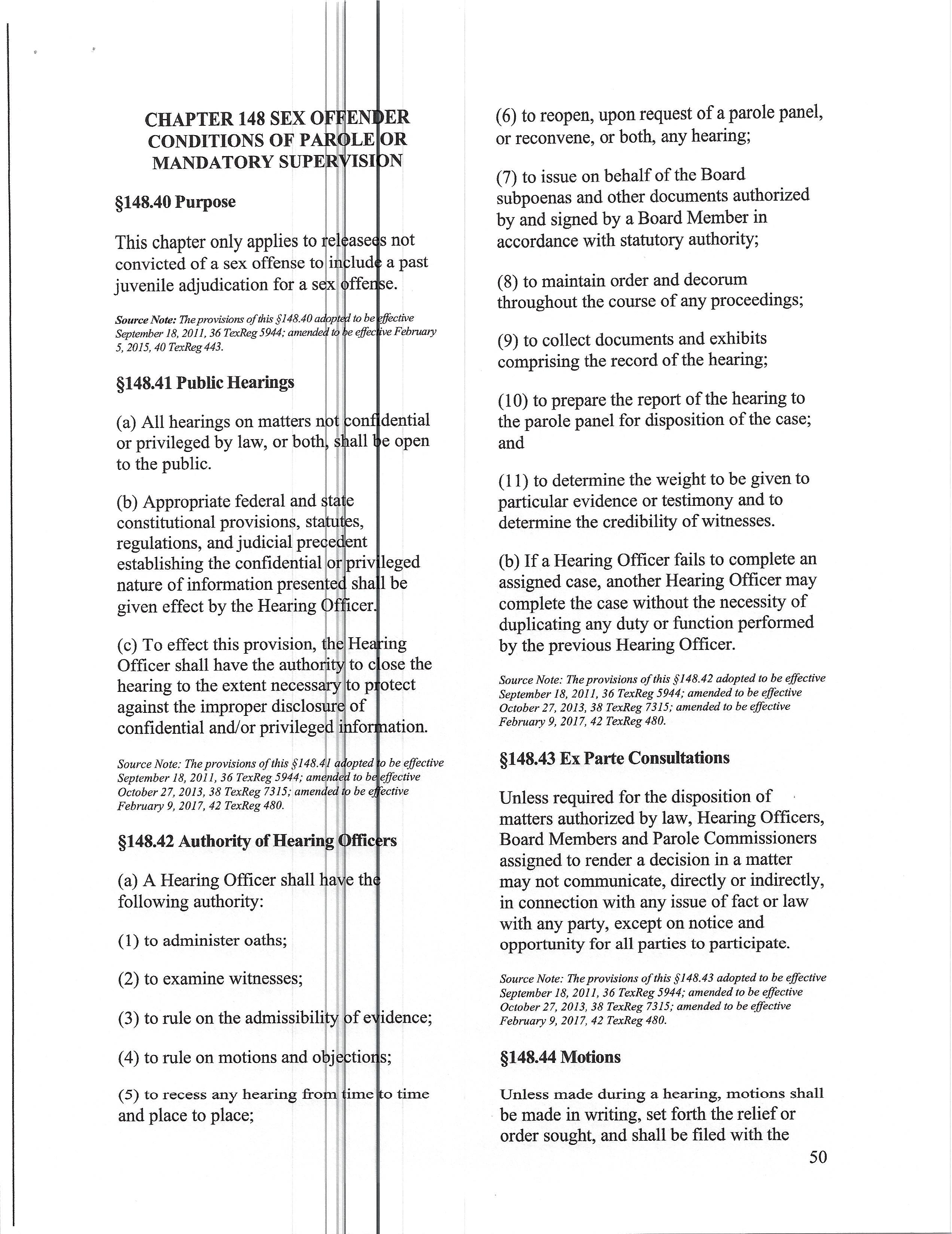




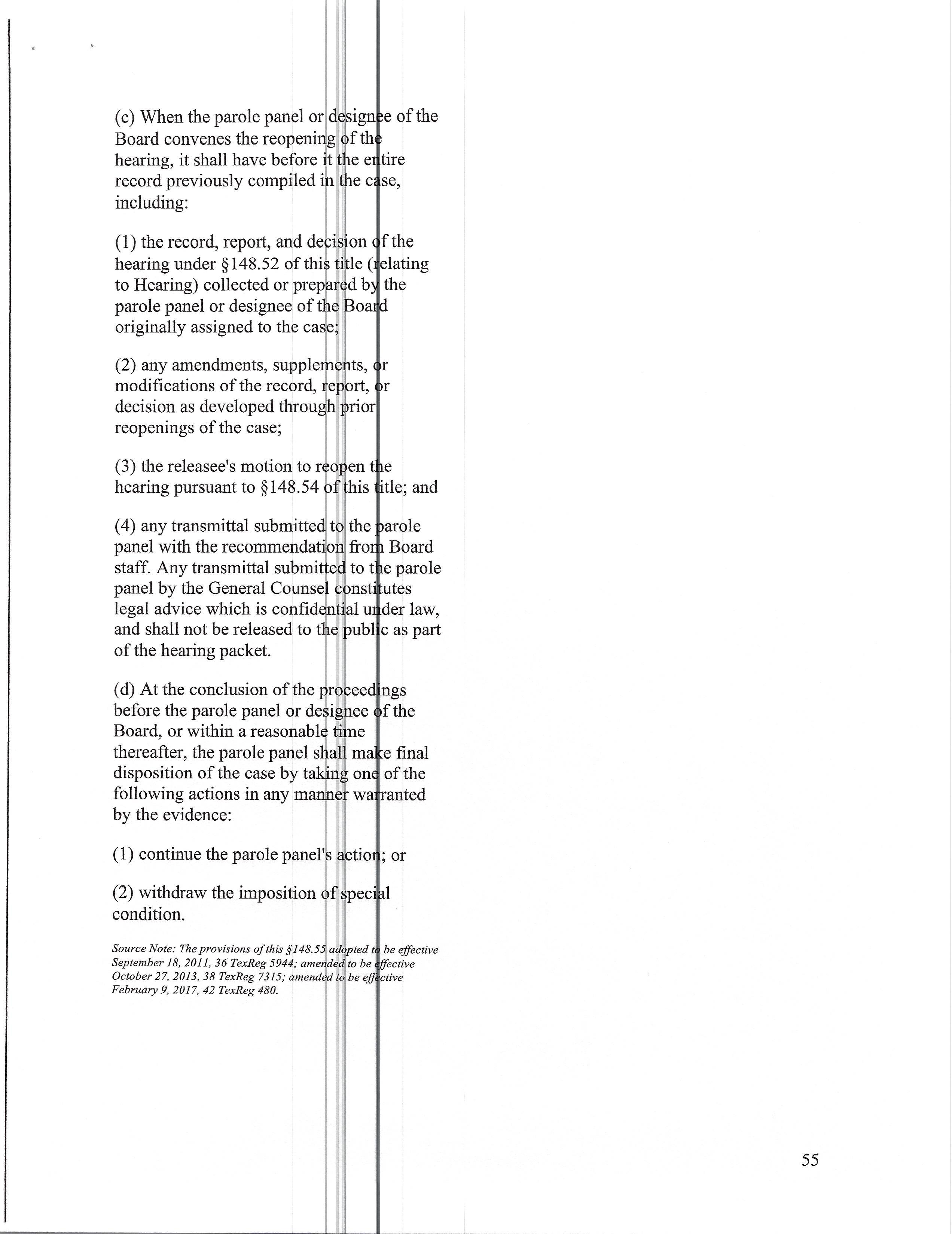


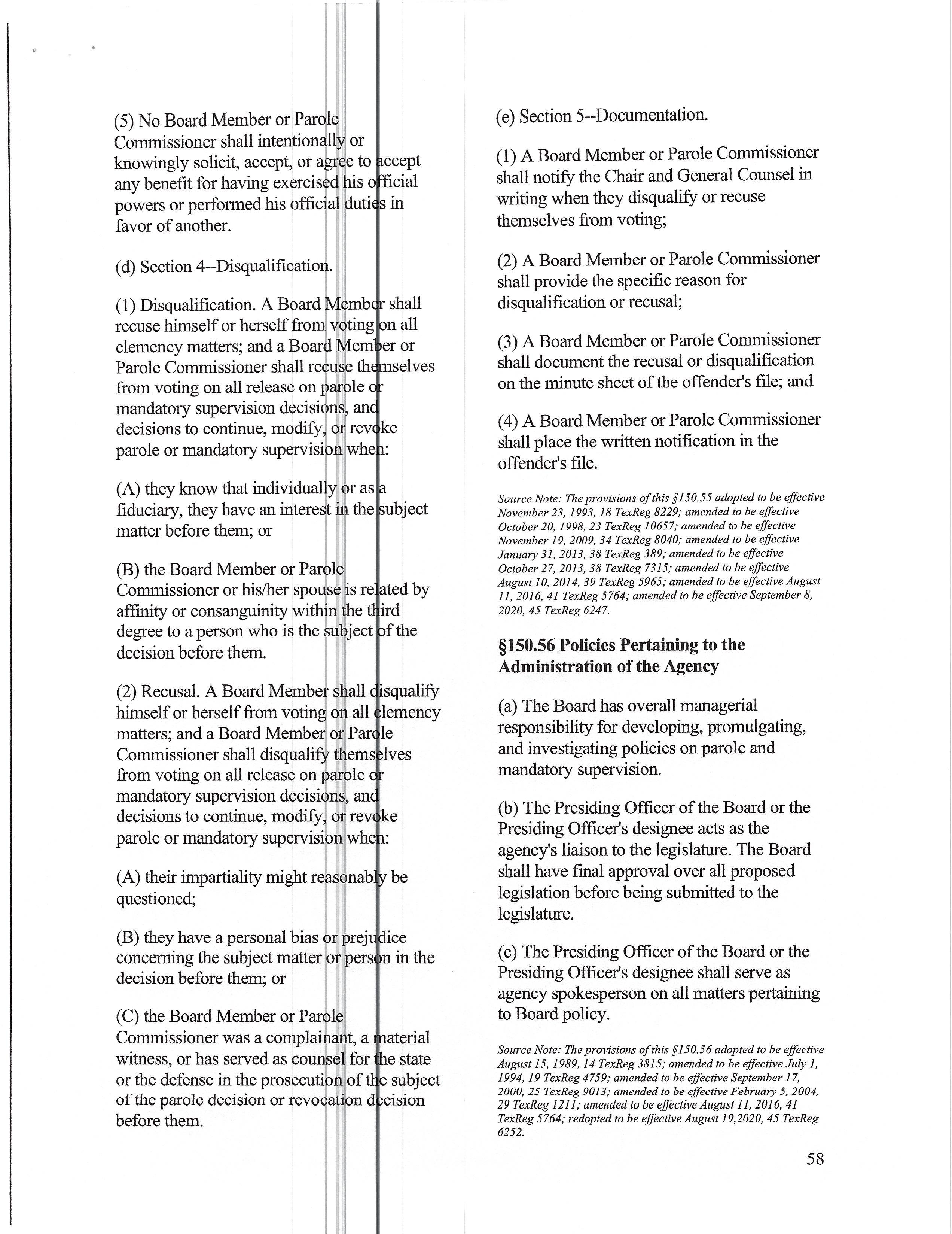
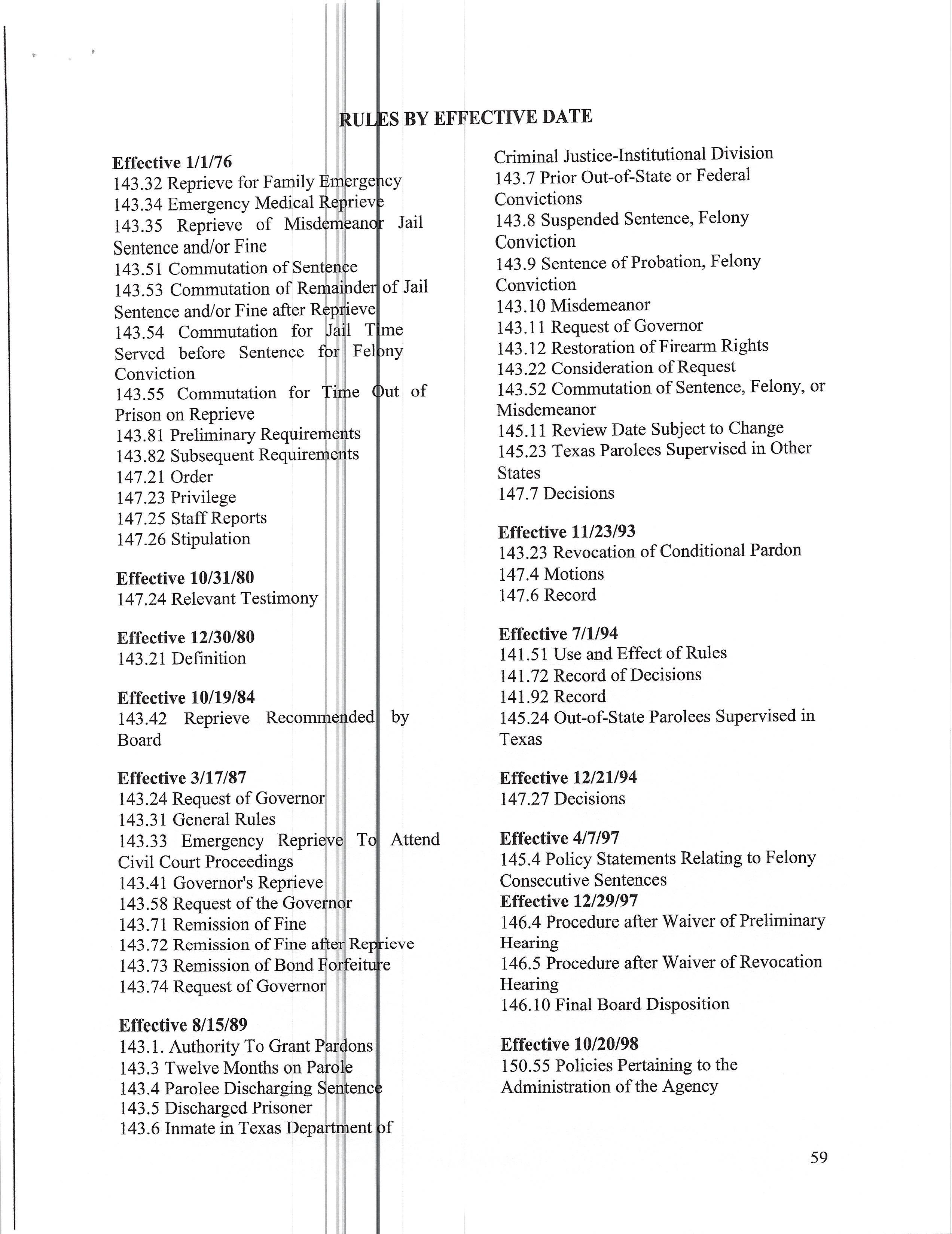


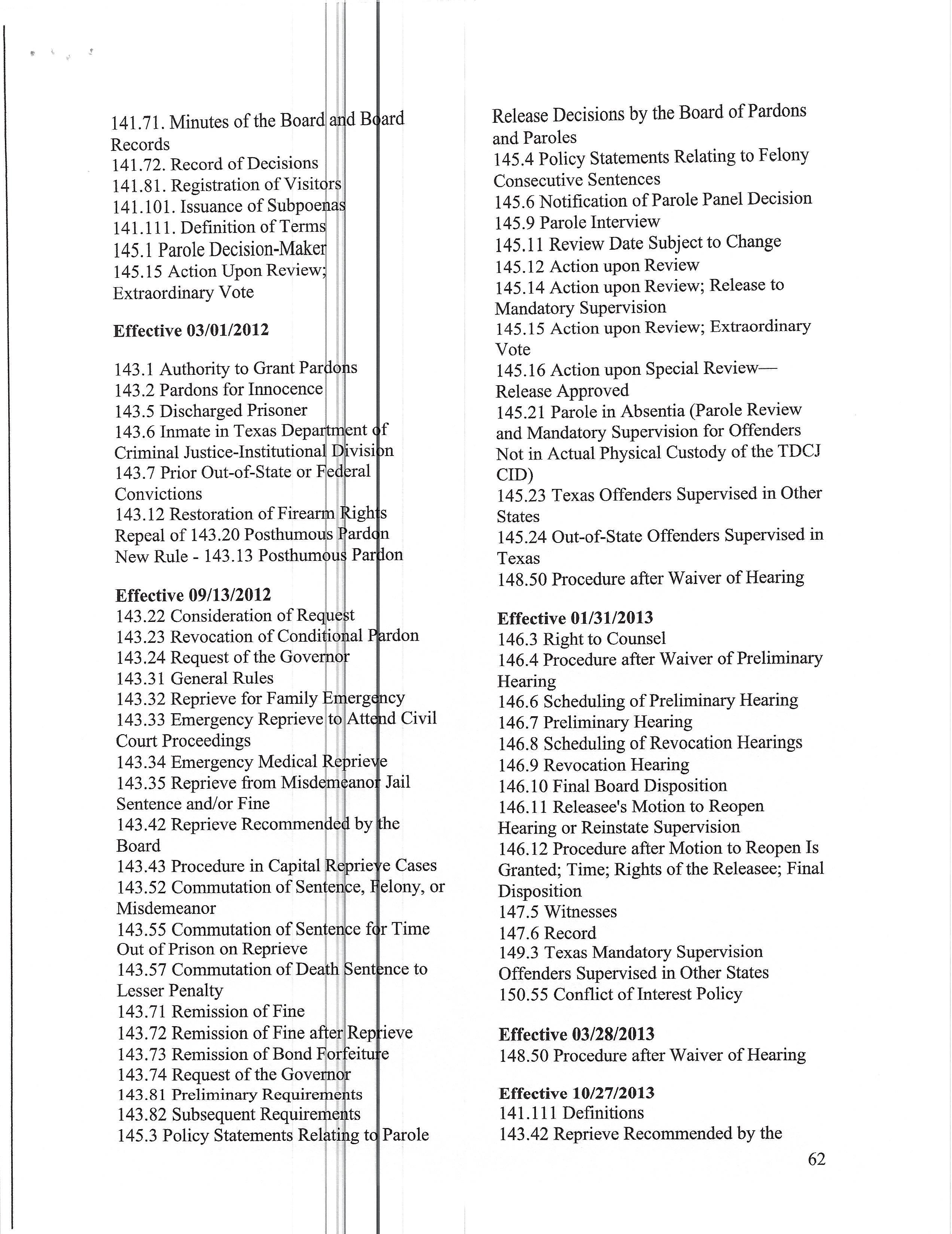



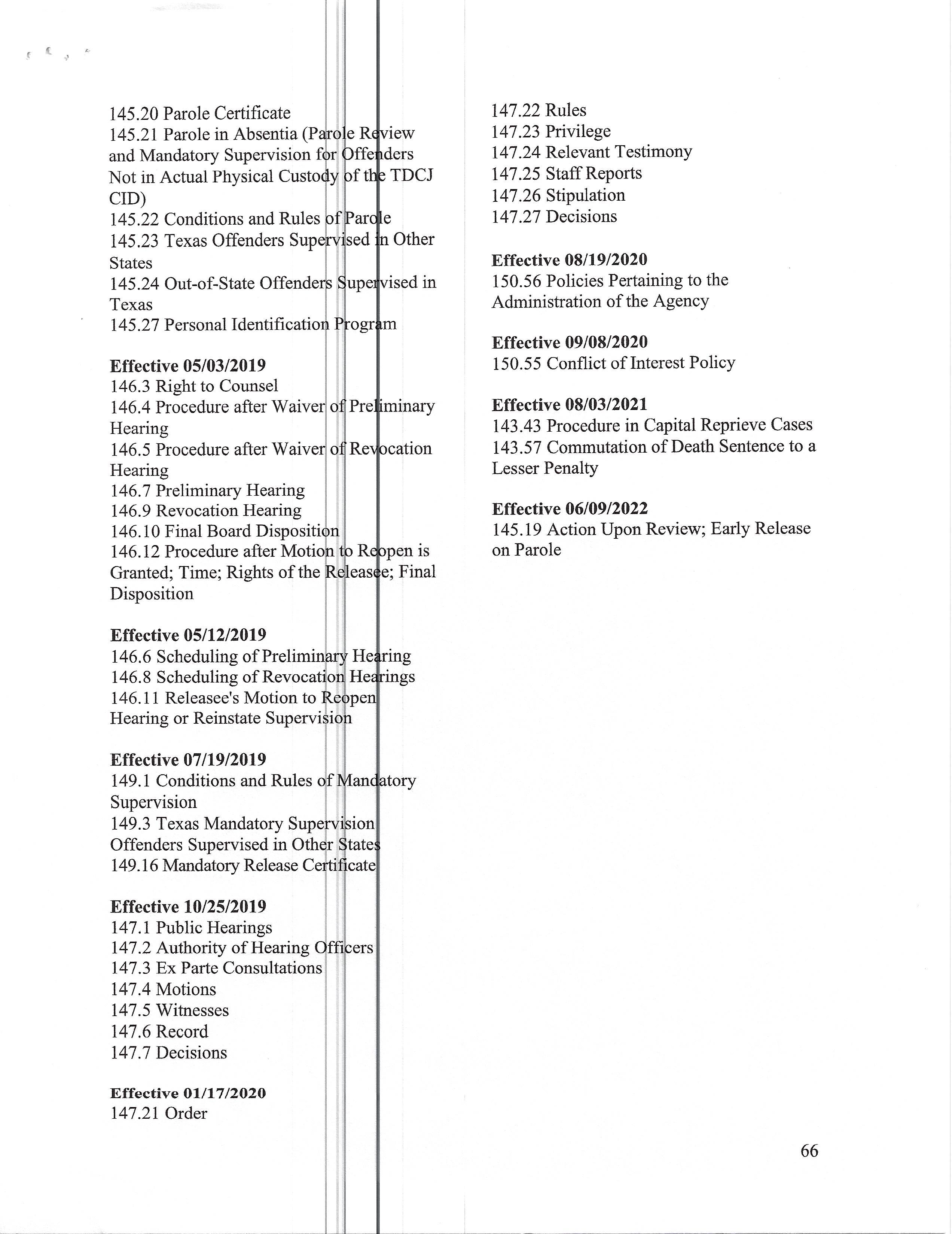
Parole, Prison, and Related Issues
13-14,
Southpark Hotel
Texas
Topic: Sex Offender Residency Restrictions:

Effective or Counter Productive?
Speaker: Mary Sue Molnar
Founder and Executive Director
Texas Voices for Reason and Justice 9424 Old Corpus Christi Hwy San Antonio, TX 78223 210.414.5701 phone marysueintx@yahoo.com email www.website.com website
Author: Texas Voices for Reason and Justice
P.O. Box 23539 San Antonio, TX 78223 210.414.5701 phone www.texasvoices.org website info@texasvoices.org email
October
2022 Austin
Austin,
6808 Hill Meadow Dr :: Austin, Texas :: 512.478.2514 p :: 512.469.9107 f :: www.tcdla.com Criminal Defense Lawyers Project
Laws and

Pursuing Rational
Policies Sex Offender Residency Restrictions: Effective Or Counter Productive? TVRJ, Inc. Texas Voices for Reason and Justice P.O. Box 23539 San Antonio, TX 78223 (210) 414 5701 http://TexasVoices.org
Texas Voices for Reason and Justice is a statewide, non profit, volunteer organization devoted to promoting a more balanced, effective, and rational criminal justice system. TVRJ advocates for common sense, research based laws and policies through education, legislation, litigation, and support for persons required to register for sex related offenses as well as for members of their families. We believe that sex offense laws and policies should be based on sound research and common sense, not panic or paranoia.
INTRODUCTION:
In recent years, restrictions against where registered sex offenders may live have become commonplace. These restrictions were created on the theory that proximity to areas where children congregate would tempt those convicted of sexual offenses into re offending. However, despite their popularity, residency and proximity restrictions have not shown to be effective. In fact, research has concluded that the imposition of these types of restrictions do not improve public safety and actually cause more harm than good
Current Texas Policy:
Texas does not have a state wide residency restriction law for registrants who have served their sentences, but many cities have enacted their own ordinances to limit where registrants may live.
Guidelines of Texas Parole and Probation Departments also restrict most registrants on supervision from living within specific distances of places such as schools, parks, day care centers, and other places designated as ‘child safe zones’ where an offense is already least likely to occur.
Texas Voices For Reason and Justice
1
http://Texasvoices.org
Because empirical evidence has shown that residency restrictions are ineffective, counterproductive, and costly, Texas Voices for Reason and Justice is opposed to laws and policies restricting where a person required to register may live.
The Facts:
Residency restriction laws and policies have no empirical support. They create instability, harm families, and waste resources. Research consistently shows that these type of restrictions do not reduce sexual re offense, do not reduce the rate of new sex offense cases, do not stop or reduce child sexual abuse, are not based on facts and evidence, and do not contribute to public safety.
Residency Restrictions:
Are not a feasible strategy for reducing sexual offenses. The vast majority of sex offenses occur in the home or by someone known to the victim.
not enhance public safety but they do create instability, harm families and waste resources

Can cause offenders to become homeless, to change residences without notifying authorities of their new locations, to register false addresses or to simply disappear.
Cover a broad range of offenses imposing the restriction on many offenders who present no known risk to children in the restricted locations.
Have been shown to increase both absconding and criminal recidivism.
Summary:
There are no statistics, there are no studies, there are no reports, and there is no evidence supporting the theory that residency restrictions protect children or the public at large.
In fact, countless studies show that these types of restrictions are nothing more than a comfort factor and may do more harm than good.
2 Texas Voices For Reason and Justice http://Texasvoices.org
Do
Example of 1000 foot Residency Restrictions in small towns
The exclusionary effect of the ordinance (before being repealed), in the town’s own map, is graphically shown above. Only a few tiny areas, if habitable at all, are available for Registrants. The intent to banish is clear.
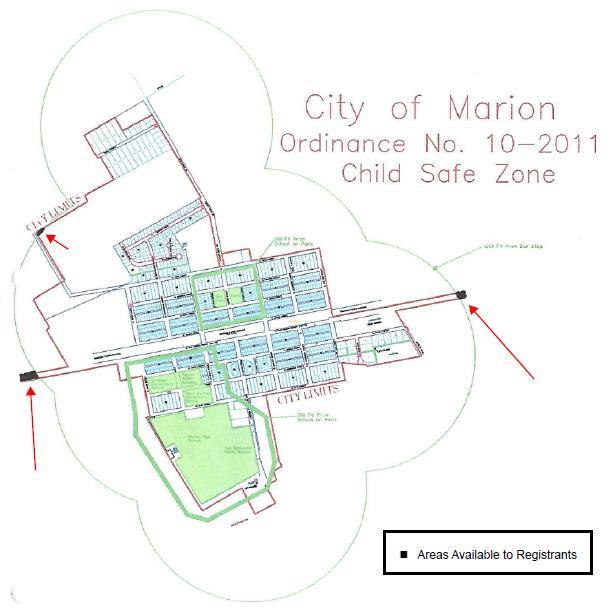
3 Texas Voices For Reason and Justice http://Texasvoices.org
Quotable Quotes:
“
One of the most concerning aspects of the implementation of residence restrictions is the passing of policy and law without consideration for research, best practice, and effective methodology. This often results in unintended counterproductive consequences which negatively impact community safety”. Colorado Sex Offender Management Board Residence Restrictions, 2009
“
ATSA supports evidence-based public policy and practice. Research consistently shows that residence restrictions do not reduce sexual reoffending or increase community safety. In fact, these laws often create more problems than they solve, including homelessness, transience, and clustering of disproportionate numbers of offenders in areas outside of restricted zones. Therefore, in the absence of evidence that these laws accomplish goals of child protection, ATSA does not support the use of residence restrictions as a feasible strategy for sex offender management.” ATSA (Association for the Treatment of Sexual Abusers) Excerpt from Public Policy brief, August 2014
“Because residency restrictions have been shown to be ineffective at preventing harm to children, and may indeed actually increase the risks to kids, the Jacob Wetterling Resource Center does not support residency restriction laws. Such laws can give a false sense of security while sapping resources that could produce better results used elsewhere.” Jacob Wetterling Resource Center Website
“We have 98 percent compliance,” said Lester, commander of Amarillo’s Detective Division and supervisor of the squad working offender registration. “Ninety-eight percent of the people, we know exactly where they live, where they’re working. And then, the other 2 percent we’ve either got warrants issued on them or haven’t found them. I don’t see that we have a problem that the ordinance addresses.”
Amarillo.com. December 2011 http://amarillo.com/news/local-news/2011-12-10/opponents-urge-caution-aboutpitfalls-proposed-restrictions
Texas Voices For Reason and Justice
http://Texasvoices.org
4
“
Research shows that there is no correlation between residency restrictions and reducing sex offenses against children or improving the safety of children. Research does not support the belief that children are more likely to be victimized by strangers at the covered locations than at other places.
Residency restrictions were intended to reduce sex crimes against children by strangers who seek access to children at the covered locations. Those crimes are tragic, but very rare. In fact, 80 to 90% of sex crimes against children are committed by a relative or acquaintance who has some prior relationship with the child and access to the child that is not impeded by residency restrictions. Only parents and caretakers can effectively impede that kind of access.
There is no demonstrated protective effect of the residency requirement that justifies the huge draining of scarce law enforcement resources in the effort to enforce the restriction.”
Iowa County Attorneys Association Statement on Sex Offender Residency Restrictions in Iowa, December 2006
“Housing restrictions appear to be based largely on three myths that are repeatedly propagated by the media: 1) all sex offenders re offend; 2) treatment does not work; and 3) the concept of “stranger danger.” Research does not support these myths, but there is research to suggest that such policies may ultimately be counterproductive. The resulting damage to the reliability of the sex offender registry does not serve the interests of public safety.”
Kansas Department of Corrections Website Statement
“California Coalition Against Sexual Assault (CALCASA) opposition to Jessica’s law is based on [the fact that] residency restrictions for sex offenders don’t make communities safer. Residency restrictions don’t reduce recidivism, don’t improve supervision of offenders, and ultimately do not protect children from sex offenders. Moreover, residency restrictions are having unintended consequences that decrease public safety. For example, Iowa Department of Public Safety statistics show that the number of sex offenders who are unaccounted for has doubled since a residency restriction law went into effect in June 2005.”
California Coalition Against Sexual Assault Statement Concerning Jessica’s Law
Texas Voices For Reason and Justice
5
http://Texasvoices.org
Across the States: KANSAS
Currently, the state of Kansas has no law that mandates where an offender can or cannot live, work, or go to school, nor does Kansas law allow for local jurisdictions to have such laws: however, this may be a condition of parole or probation. http://www.doc.ks.gov/publications/CFS/sex offender housing restrictions
MARYLAND
Maryland does not have any residency restrictions. Information put out by other states has shown that residency restrictions do not help to prevent sexual offenses from occurring because the victims and the offenders, in most situations, know each other. Some states, such as Iowa and Florida, have found that residency restrictions can make it very difficult to track sex offenders who have become homeless. Homeless sex offenders are also more difficult to register and without an address the registry is unable to tell the public where the offender lives.
PENNSYLVANIA
Pennsylvania’s Megan’s Law does not restrict where a sexual offender or Sexually Violent Predator/Sexual Violent Delinquent Child may reside. However, an offender may be restricted from residing near a school, park, daycare center, etc. if the registrant is on parole or probation. http://www.pameganslaw.state.pa.us/FAQ.aspx?dt=
FLORIDA
There is no bigger example of the negative impact of sex offender residency restrictions than the Julia Tuttle Causeway sex offender camp in Miami, where registrants were forced to live under a bridge in Miami, Florida. With few options, offenders still often sleep in cars, tents and in the open. http://www.npr.org/2014/10/23/358354377/aclu-challenges-miami-law-on-behalf-ofhomeless-sex-offenders
6 Texas Voices For Reason and Justice http://Texasvoices.org
In The Courts:
In addition to the vast amount of research, a growing number of courts, cities, counties and states that once favored these laws are looking to reform or abolish residency restrictions altogether.
August, 2015
Mass. Supreme Court strikes down residency laws; Compares them to Japanese internment camps
“
The justices also warned that laws segregating sex offenders pose "grave societal and constitutional implications."
“Except for the incarceration of persons under the criminal law and the civil commitment of mentally ill or dangerous persons, the days are long since past when whole communities of persons, such Native Americans and Japanese-Americans may be lawfully banished from our midst,” the decision reads.
Boston Globe
Read the court’s decision: http://www.mass.gov/courts/docs/sjc/reporter-of-decisions/new-opinions/11822.pdf
February, 2015
New York Court tosses local laws on sex offender residency
ALBANY, New York Local communities cannot enact laws restricting where sex offenders may live, New York State’s highest court ruled on Tuesday. The Court of Appeals ruled that the state’s regulatory framework set up in the 1996 Sex Offender Registration Act, the 2000 Sex Assault Reform Act, the 2007 Sex Offender Management and Treatment Act and other modifications of Executive and Social Services laws – must prevail. Municipalities cannot enact laws where the state already regulates, the court found.
Philly.Com http://www.recordonline.com/article/20150217/News/150219388
Texas Voices For Reason and Justice http://Texasvoices.org
7
March, 2015
CA court rules San Diego sex offender law unconstitutional
“The California Supreme Court ruled on Monday that San Diego County's "blanket" enforcement of the state's sex offender residency laws was unconstitutional, a decision that could open the door to wider challenges of the statute.”
"The residency restrictions place burdens on registered sex offender parolees that are disruptive in a way that hinder their treatment, jeopardizes their health and undercuts their ability to find and maintain employment, significantly undermining any effort at rehabilitation," Justice Baxter wrote.
"Blanket enforcement of residency restrictions against these parolees has ... infringed on their liberty and privacy interests, however limited, while bearing no rational relationship to advancing the state's legitimate goal of protecting children from sexual predators," Justice Marvin Baxter wrote in an opinion for the court.
Reuters
http://www.reuters.com/article/2015/03/02/us usa california sexoffenders idUSKBN0LY2BL20150302
May, 2011
PA high court strikes down a county's Megan's Law residency restrictions
“
In a ruling with statewide ramifications, the Pennsylvania Supreme Court on Thursday invalidated an Allegheny County law that restricted where convicted sex offenders could live, saying the ordinance would banish offenders to "localized penal colonies" with little access to jobs, support, or even their families.
The seven justices concluded that the Western Pennsylvania county law was at odds with the state's "Megan's Law," which requires convicted sex offenders across the state to report their residency so that nearby residents can be notified, but does not restrict where offenders can live.”
Philly.com http://articles.philly.com/2011 05 27/news/29590250_1_residency restrictions offenders megan s law
Texas Voices For Reason and Justice http://Texasvoices.org
8
Newspaper Investigative Reports:
Hundreds of convicted sex offenders missing in Tulsa area
BY MAUREEN WURTZ THURSDAY, FEBRUARY 11TH 2016
TULSA According to Tulsa Police, there are hundreds of convicted sex offenders missing in the Tulsa area. However, just because they're missing doesn't mean they're gone, said Sgt. John Adams with the Tulsa Police Department. “The only thing we want to know and the only thing the public wants to know is where these guys are?" said Adams.
According to Adams, the places where a registered sex offender can live in Tulsa have been greatly restricted since 2006.During that year, Oklahoma lawmakers passed a 2,000 law, stating sex offenders can't live within 2,000 feet of a school, park, or any place where children live or play.
"2006 just turned our world upside down, prior to that we had 15 to 20 (failure to register) violations a year," said Adams. “Since that we have hundreds of violations a year”. Adams said because of the way Tulsa is laid out, there are almost no options for sex offender to legally live. Many areas available for sex offenders to live are either industrial areas, wealthy neighborhoods, or undeveloped areas.

"Legislators felt that if we put all of this off limits, they'll just move out of state. That didn't happen, they just stopped registering," said Adams.
Before 2006 they had around 680 registered sex offenders and now, Adams says they're less than 400.
"We're an outcast, a huge outcast, so we kind of take into each other. We know- we understand what each other is going through," said one convicted sex offender. He wanted to hide his identity, so for the purposes of this article, his new name is 'Ben.' Ben has been living out of his car ever since getting out of prison. Each week, he goes to the sex offender registry office and registers as a 'homeless sex offender.' Homeless sex offenders are required by law to register each week and let police know where they'll be staying. “I’m grounded to this spot, if I'm not here, we're going to come and arrest you why I'm freezing? I have to choose between life and death to follow the law," said Ben.
9 Texas Voices For Reason and Justice http://Texasvoices.org
Adams said the weekly registering sets up sex offenders, like Ben, for failure.
"I agree, that if there is a danger, a person that is a danger, this can set them into their cycle to re offend," said Ben.
Homeless shelters in Tulsa aren't allowed to take sex offenders like Ben, because of how close they are to schools or parks. "We feel horrible when someone comes in and we find out that they are a sex offender and we just say we can't help you- you can't be here," said Sandra Lewis, with the Tulsa Day Center.
Adams said he's brought up his concern to lawmakers several times. He said, in private they'll agree, but in public no one wants to be the champion for the sex offender.
"Now, a third of the offenders- we have no idea where they're at. You're actually less safe because you can't tell your child stay away from the brown house with the green trim because that's a sex offender. You don't know because we've lost so many," said Adams.
Adams said they department receives grants from the state to help search for missing sex offenders, however without those grants, they don't have the man power.
He said he knows one way that Oklahoma can fix the problem.
"Get rid of everything and start all over. Get a legislative study, bring law enforcement in on the ground, and let's get something that works for everybody," said Adams.
As for now, Adams said, they'll continue to do the best they can to keep tabs on the offenders they do know.
http://ktul.com/news/investigations/hundreds-of-convicted-sex-offenders-missing-intulsa-area
10 Texas Voices For Reason and Justice http://Texasvoices.org
The Pointless Banishment of Sex Offenders
By THE EDITORIAL BOARD SEPT. 8, 2015

It’s a chilling image; the sex predator skulking in the shadows of a swing set, waiting to snatch a vulnerable child.
Over the past two decades, that scenario has led to a wave of laws around the country restricting where people convicted of sex offenses may live in many cases, no closer than 2,500 feet from schools, playgrounds, parks or other areas where children gather. In some places, these “predator free zones” put an entire town or county off limits, sometimes for life, even for those whose offenses had nothing to do with children.
Protecting children from sexual abuse is, of course, a paramount concern. But there is not a single piece of evidence that these laws actually do that. For one thing, the vast majority of child sexual abuse is committed not by strangersbut byacquaintances or relatives. And residency laws drive tens of thousands of people to the fringes of society, forcing them to live in motels, out of cars or under bridges. The laws apply to many and sometimes all sex offenders, regardless of whether they were convicted for molesting a child or for public urination.
Lately, judges have been pushing back. So far in 2015, state supreme courts in California, Massachusetts and New York have struck down residency laws.
The Massachusetts ruling, issued on Aug. 28, invalidated a residency restriction in the town of Lynn — and by extension, similar restrictions in about 40 other communities statewide in part because it swept up so many offenders, regardless of the actual risk they posed. Acting against a whole class presents “grave societal and constitutional implications,” the justices wrote. That unanimous ruling was based on the State Constitution.

11 Texas Voices For Reason and Justice http://Texasvoices.org
The California Supreme Court went further,holding that a San Diego residencyrestriction, which effectively barred paroled sex offenders from 97 percent of available housing, violated the United States Constitution.
Far from protecting children and communities, the California court found, blanket restrictions in fact create a greater safety risk by driving more sex offenders into homelessness, which makes them both harder to monitor and less likely to get essential rehabilitative services like medical treatment, psychotherapy and job assistance.
Residency laws often lead people to live apart from their families, obliterating what is for many the most stabilizing part of their lives.
If the state wants to block someone from living in certain areas, the California court said, it must make that decision on a case-by-case basis.
The United States Supreme Court has not yet weighed in on residency restrictions, although a 2003 ruling upholding mandatory registration for sex offenders suggested that such laws may violate the Constitution.
It is understandable to want to do everything possible to protect children from being abused. But not all people who have been convicted of sex offenses pose a risk to children, if they pose any risk at all. Blanket residency restriction laws disregard that reality and the merits of an individualized approach to risk assessment in favor of a comforting mirage of safety.
Story Link: The Pointless Banishment of Sex Offenders
12 Texas Voices For Reason and Justice http://Texasvoices.org
THE WALL STREET JOURNAL
By ASHBY JONES Nov. 30, 2014
Cities and Towns Scaling Back Limits on Sex Offenders
Officials Say Buffer Zones Don’t Prevent Repeat Offenses and Make Predators Harder to Track
When Palm Beach County, Fla., was sued earlier this year over its housing restrictions for registered sex offenders, its attorneys took an unusual approach: They suggested the county relax its law.
The county’s commissioners prompted largely by the lawsuit brought by a sex offender who claimed the limits rendered him homeless voted in July to let such offenders legally live closer to schools, day-care centers and other places with concentrations of children.
“We realized the law was costing the taxpayer’s money [for services for the homeless] and was causing more problems than it was solving,” said county attorney Denise Nieman.
In the mid 1990s, states and cities began barring sex offenders from living within certain distances of schools, playgrounds and parks. The rationale: to prevent the horrible crimes sometimes committed by offenders after their release. In October, for instance, officials charged sex offender Darren Deon Vann with murdering two women in Indiana. Mr. Vann, who is suspected of killing several others, pleaded not guilty.
Now, a growing number of communities are rejecting or scaling back such limits— out of concern that theydon’t prevent repeat offenses, and, in some instances, may make sex offenders harder to track.
Before Palm Beach County shrunk its buffer zones, only small pockets of the county were open to sex offenders, said Mark Jolly, the head of the unit at the county sheriff’s office charged with tracking sex offenders. “They’d either just become homeless or they’d tell us they were homeless, then would move into housing within a restricted zone,” he said. “It became a nightmare to track these guys.”
Mike Rodriguez, the executive director of the county’s criminal justice commission, estimates that the change in the law increased the area in which sex offenders could live by about 70%.
13 Texas Voices For Reason and Justice http://Texasvoices.org
In August, the Dallas City Council considered a proposal to adopt residency restrictions for Dallas’s nearly 4,000 sex offenders. Jerry Allen, a council member, said he “looked for research” to support the idea, but came up empty. So Mr. Allen persuaded the council to shelve the proposal.
A 2013 Justice Department study that examined Michigan’s and Missouri’s statewide restrictions showed they “had little effect on recidivism.” Other studies have found the vast majority of sex offense cases involving children are committed not by strangers but by family members or others with established connections to the victims, such as coaches or teachers.
About 30 states and thousands of cities and towns have laws restricting where sex offenders can live, while others are adding them. In March, a 1,000-foot buffer from parks took effect in San Antonio. In July, Milwaukee passed a law banning sex offenders from living within 2,000 feet of a variety of places where children gather.
In October, the City Council in Elkhorn, Wis., population 10,000, passed an ordinance requiring offenders who move into town to live at least 2,000 feet from places such as schools and parks. The move was prompted by an influx of sex offenders released from the nearby county jail, many of whom had begun to congregate in the town’s business district, said Mayor Brian Olson. After the vote, he said he got several calls and letters from residents thanking him. “I think people were afraid to speak up on the issue, and that there was a bit of a sigh of relief,” Mr. Olson said. We’re just trying to keep our kids safe, and just did what a lot of other communities around the state have done,” he said.
Critics, however, say such moves do little more than score lawmakers political points and give an area’s residents a false sense of security. Some argue they can make communities less safe, by making it hard for offenders to find stable housing.
David Prater, district attorney of the county that encompasses Oklahoma City, said he and other state prosecutors have tried to get the state to relax its 2,000 foot buffer, to no avail. “No politician wants to be labeled the guy who lessens restrictions on sex offenders,” he said.
The police chief in Greeley, Colo., Jerry Garner, said he started having doubts about the restrictions when, a few years ago, Greeley officers discovered a registered sex offender living in his car, partly, recalls Mr. Garner, because he was “boxed out” of so much of the city. “Because of the restrictions, he was basically living as close to children as he wanted to,” said Mr. Garner. At his urging, in February Greeley slashed the size of the restricted areas for its 265 registered sex offenders from 1,000 feet around places like schools to 300 feet.
In October, three residents of a Miami outdoor encampment sued Miami-Dade County in federal court, claiming that sex-offender residency restrictions in the county rendered
14 Texas Voices For Reason and Justice http://Texasvoices.org
them “unable to locate stable, affordable housing,” thereby forcing them and “hundreds” of others into homelessness.
A Miami Dade County spokeswoman declined to comment on the suit.
Miami-Dade County has come under fire for its residency restrictions before. In 2006, an encampment that ultimately grew to include more than 100 homeless sex offenders developed under a Miami freeway, largely as a result of the county’s residency restrictions. Four years later, to alleviate the problem the county eliminated some of its 2,500-foot buffer zones for sex offenders.
Some smaller towns are chucking restrictions, partly in the name of public safety. De Pere, Wis., a town of 23,000 south of Green Bay, tossed out its 500 foot buffer last year after reviewing data on its effectiveness, said several council members. The issue was reopened by some townspeople several months ago, when a convicted sex offender moved across the street from a school for children with special needs. But the council didn’t budge.
“You track where they live, you check in on them, but you let them live at home, where they’re comfortable and stable,” said Scott Crevier, a DePere city councilman. “I feel we’re actually safer than a lot of other towns in the state that have them.”
http://www.wsj.com/articles/cities-and-towns-begin-scaling-back-limits-on-sex-offenders1417389616
Texas Voices For Reason and Justice
http://Texasvoices.org
15
Lubbock Avalanche Journal
Sex offender residency restrictions: What does the research say?
Josie Musico
January 29, 2015
Earlier this week, I reported Muleshoe could set an ordinance restricting registered sex offenders from living near schools, playgrounds and daycare centers. Some of our online commenters suggested City Council consider more research on the subject before they take action. As always, thank you for your feedback. But what does the research say? Searching for studies that seemed as objective as possible, here is some of what I found:

About 93 percent of sex crimes are committed by an offender already acquainted with the victim, according to Bureau of Justice Statistics. Personal observation covering sexual-assault cases in the South Plains supports this statistic. I have not yet covered a case in which an offender attacked a stranger on a playground, but that does not mean it couldn’t happen.
A 2007 studybythe Minnesota Department of Corrections that reviewed 224 cases of sexual-offender recidivism determined those repeat offenders committed the attacks more than a mile away from their homes. The researchers summarized, “Not one of the 224 sex offenses would likely have been deterred by a residency restrictions law ... Even when offenders established direct contact with victims, they were unlikely to do so close to where they lived.”
Read more here: http://www.csom.org/pubs/MN%20Residence%20Restrictions_0407SexOffenderReport-Proximity%20MN.pdf
16 Texas Voices For Reason and Justice http://Texasvoices.org
A 2008 study from Lynn University, the University of New Mexico and the University of Nevada researched recidivism rates among Florida sex offenders. It did not find a correlation between the offenders’ homes in proximity to schools and playgrounds and their likelihood of reoffending.
The study concluded, “Sex offenders who lived within closer proximity to schools and daycare centers did not reoffend more frequently than those who lived farther away ... The time that police and probation officers spend addressing housing issues is likely to divert law enforcement resources away from behaviors that truly threaten our communities in order to attend to a problem that simply does not exist.”
The Association for the Treatment of Sexual Abusers supports alternatives to residency restrictions as mental health treatment and access to housing and employment.
http://www.atsa.com/pdfs/Policy/2014SOResidenceRestrictions.pdf
Sex offender notification laws and residency requirements began growing in popularity in the 1990s. Now, more than 30 states and hundreds of cities nationwide hold some form restrictions on where sex offenders are allowed to live.
‘I was actually a bit apprehensive with this blog because all the research studies I found seemed to point in the same direction, and I hope it doesn't make me look biased. If I can find any studies that indicate these ordinances are effective at preventing recidivism, I will definitely link them too. Have a great day.’ Josie Musico http://lubbockonline.com/interact/blog-post/josie-musico/2015-01-29/sexoffender-residency-restrictions-what-does-research
Texas Voices For Reason and Justice
http://Texasvoices.org
17
Low Recidivism for Sexual Crimes-The Facts
People convicted of a sexual crime seldom repeat the offense. Government reports and empirical studies consistently show the rate of repeated sex crime to be much lower than the general public believes. The most widely cited report was published by the U.S Department of Justice in 2003.1 It compared recidivism rates among prisoners released in 1994 over a three-year follow-up period. Sex offenders (SO’s) were rearrested for another sex crime at a rate of 5.3% 1.8% per year. Non-SO’s were rearrested for ordinary crimes (burglary, robbery, drug dealing, etc.) at a rate of 68% 22.6% per year. SO’s repeat their crime at a lower rate than any type of crime other than homicide. It is in that context that SO’s are understood to be at low risk to re offend.
Several other studies can be cited to illustrate the widespread understanding about the low recidivism rate among former sex offenders.
A) The pivotal meta-analysis by Hanson & Bussière (1998), from which the Static-99 actuarial scale was developed, found 13.4% of their 23, 393 sample re offended sexually within 5 years of release (approximately 3% per year). 2
B) The Texas Criminal Justice Policy Council (1997) tracked SO’s released from prison and found, after 3 years, 4% (1.3% per year) had returned to prison for another sex crime.3
C) The Washington State Institute for Public Policy found a 4-year recidivism rate of 2.7% (0.68% per year). 4
D) The California Prison System, (Marques, et al, 2005) found, among 649 released SO’s, a sexual recidivism rate of 23.1% over an average of 8.5 years (2.7% per year). 5
E) A U.S. Department of Justice Report (Zgoba, et al, 2012) surveyed 4 states (FL, SC, NJ, MN) and found an average 10 year sex offense recidivism rate of 9.9% (0.99% per year). 6
F) The California Department of Corrections and Rehabilitation (2012) reported that, during a 3-year period, 1.9% of sex offenders on the public registry (including both those who had been to prison and those who had not) were arrested for another sex crime 0.63% per year. 7
G) A Bureau of Justice report surveying 9 states (AK, AZ, DE, IL, IA, NM, SC, TN, & UT) found an average 3-year sex offense recidivism rate of 3.4% -- 1.1% per year. 8
These statistics describe a broad, general category sex offenders. There are important distinctions to be made between types of offenders that would show large segments at extremely low risk of recidivism. The reports cited here are representative of a large body of literature. These descriptive studies make it clear that the great majority of SO’s have a very low likelihood of repeating their crime. Legislation and policy making that assumes otherwise is misguided and counterproductive.
18 Texas Voices For Reason and Justice http://Texasvoices.org
REFERENCES:
1. DOJ, 2003. http://www.bjs.gov/content/pub/pdf/rsorp94.pdf
2. Hanson, R. K. & Bussière, M. T. 1998. “Predicting Relapse: A Meta Analysis of Sexual Offender Recidivism Studies,” Journal of Consulting and Clinical Psychology, 66 (2) 348 362
3. Eisenberg, M. 1997. “Recidivism of Sex Offenders: Factors to Consider in Release Decisions,” Criminal Justice Policy Council.
4. Washington State Institute for Public Policy, 2005. “Sex Offender Sentencing in Washington State: Recidivism Rates,” http://www.wsipp.wa.gov/ReportFile/908/Wsipp_Recidivism Rates_Recidivism Rates.pdf
5. Marques, J. Wiederanders, M., Day, D., Nelson, C. & van Ommeren, A. 2005. “Effects of a Relapse Prevention Program on Sexual Recidivism: Final Results From
California’s Sex Offender Treatment and Evaluation Project (SOTEP),” Sexual Abuse: A Journal of Research and Treatment, 17 (1).
6. Zgoba, K., Miner, M., Knight, R., Letourneau, E., Levenson, J. & Thornton, D. 2012. “A Multi State Recidivism Study Using Static 99R and Static 2002 Risk Scores and Tier Guidelines from the Adam Walsh Act,” National Institute of Justice, DOJ, Document # 240099.
7. “2012 Outcome Evaluation Report,” California Department of Corrections and Rehabilitation. http://www.cdcr.ca.gov/adult_research_branch/Research_Documents/ARB_FY_0708_R ecidivism_Report_10.23.12.pdf
8. Orchowsky, S. & Iwama, J. 2009. “Improving State Criminal History Records: Recidivism of Sex Offenders Released in 2001,” Bureau of Justice Statistics, Office of Justice Programs, U.S. Department of Justice.
Texas Voices For Reason and Justice http://Texasvoices.org
19
Criminal Defense

Parole, Prison, and Related Issues
13-14,
Southpark Hotel
Topic: Presenting a Parole Revocation Case
Speaker: Sean David Levinson
Levinson Law Firm
Spicewood Springs Rd., Ste. 200
TX 78759
October
2022 Austin
Austin, Texas 6808 Hill Meadow Dr :: Austin, Texas :: 512.478.2514 p :: 512.469.9107 f :: www.tcdla.com
Lawyers Project
4810
Austin,
512.467.1000 phone 512.485.2844 fax seandlevinson@gmail.com email www.bettercallsean.com website
PresentingaParoleRevocationCase
Parole,Prison,andRelatedIssuesSeminar
TexasCriminalDefenseLawyers
Association,October13, 142022,Austin,Texas
SeanDavidLevinson,J.D.,LL.M
BetterCallSean®
LevinsonLawFirm
4810SpicewoodSpringsRd.,Suite200
Austin,TX78759 (512)467 1000 www.BetterCallSean.com
SeanDLevinson@gmail.com
Duringthecourseofanycriminaldefenselawyer’scareer,therewillcomeatime whentheirclientisaccusedofanewoffensewhilealsoonparolesupervision. The purposeofthispaperistodiscussthetypicalissuesthatlawyersmayencounter whendealingwithparolerevocations.
Parole Revocation Caselaw
ParolerevocationcaselawstartswiththelandmarkSupremeCourtdecision Morrisseyv.Brewer,408U.S.471(1972). InMorrissey,theCourtheldthatparole revocationsarenotpartofacriminalprosecutionandthusthe“fullpanoplyof rightsdoesnotextendtoparolerevocations”. TheCourtdidholdthatparole revocationhearingsdocallfor“someorderlyprocess,howeverinformal”. The Morrisseyholdingestablishesthefollowingminimumrightsofdueprocessin parolerevocationhearings:
• Writtennoticeofclaimedparoleviolations,
• Disclosuretotheparoleeofevidenceagainsthim,
• Opportunitytobeheardinpersonandtopresentwitnessesand documentaryevidence,
• Therighttoconfrontandcross examineadversewitnesses(unlessthe hearingofficerspecificallyfindsgoodcausefornotallowingconfrontation),
• A“neutralanddetached”hearingbodysuchasatraditionalparoleboard, membersofwhichneednotbejudicialofficersorlawyers,and
• Awrittenstatementbythefactfindersastotheevidencereliedonand reasonsforrevokingparole.
ForthepurposeofthisarticleitisimportanttonotethatinTDCJlanguage,aclient onparoleisgenerallyreferredtoasanoffender. Therefore,wewillusethis terminologygoingforward. Thefirststepinrepresentinganoffenderforaparole revocationhearingistoregisterwithTDCJ-ParoleDivision(“ParoleDivision”).
Next,allattorneysrepresentingoffendersmustfileafeeaffidavitwiththeParole Division. Thisformshouldbeforwardedtotheparoleofficerresponsibleforthe caseandalsotenderedtotheHearingOfficeratthehearing.
Unliketherighttocounselinacriminalcase,thereisnoautomaticrighttocounsel inparolerevocationhearings. However,theParoleBoardcanappointanattorney incertainsituations. TheBoardmayappointanattorneybasedonthefollowing factors:whethertheoffenderisindigentandwhethertheoffenderlackstheability toarticulateorpresentadefenseormitigationevidenceinresponsetothe allegations;and,thecomplexityofthecaseandwhethertheoffenderadmitsthe allegedviolation.1 Thisrequestforanattorneycancomefromtheoffender,parole officer,orhearingofficer. Inmyexperience,theParoleBoarderrorsonthesideof cautionandwillnothesitatetoappointanattorneytoanoffendertheybelieve cannotadequatelyrepresentthemselves,usuallydotolowIQormentalillness. Offendersarealwaysfreetohireanattorneythemselves.
Blue Warrant Issuance
Firstandforemost,alloffendersaregivenparoleconditionsthattheymustabideby whenreleasedonparole/discretionarymandatorysupervision(“DMS”). Failureto abidebyofanyoftheseconditionscouldresultinaviolationbeingfiledandaparole warrant(akaBlueWarrant)beingissued. TheseBlueWarrantsareNOBAIL.
Offenderswhoareonparole/DMSmaybesubjecttoBlueWarrantsfortechnicalor newoffenseviolations.
Technicalviolationstypicallyinclude:
• Failuretoreport
• Delinquentparolefees
• Positivedrugtests
• Failuretoresideinanapprovedlocation
• Homemonitoring/curfewviolations
Newoffenses
• ClassCandupoffenses2 .
Traditionally,aBlueWarrantwillbeissuedanytimeanoffenderisaccusedofa technicalornewoffenseviolation. Recently,inOctober2021,thereweresome changestoBlueWarrantissuance.
ThenewchangesinBlueWarrantsgenerallyonlyaffectNewOffenseViolations.
1 TexasAdministrativeCode,Title37,Part5,Rule146.3.
2 NewOffensesdonotneedtobefiledincourt. Merelyanallegationmadetothe paroleofficerofacriminallawoffensemaybeenoughtotriggerabluewarrant.
TechnicalviolationswillstillcontinuetoresultinBlueWarrants. Thosehearings willbeconductedwithin41daysofthebluewarrantbeingexecuted.
NewOffenseviolationsarenowsubjecttonewruleswhichinmanyinstances actuallyhelpoffenderswhoareaccusedofanewoffensewhileonparole supervision. Historically,likewithtechnicalviolations,themerearrestofan offenderwouldtriggeranautomaticBlueWarrant. Underthenewrules,theParole Divisionwillnolonger“automatically”issueBlueWarrantsduetoanewoffense violation.
BlueWarrantsfornewoffenseswillbeissuedaccordingtowhatIrefertoasatier system.3
Offensesinthefirsttierthemostaggravatedoffensessuchasmurderandsexual assaultwillresultinBlueWarrantsautomatically.Thosecaseswillhaveboth preliminaryandrevocationhearingswithin41daysifthecaseisunindicted. Ifthe caseisindictedthengenerallyonlyapreliminaryhearingwilltakeplacewithin41 days. Ifprobablecauseisfoundatthepreliminaryhearingtheoffenderwillremain incustodyuntilthecriminalcaseisresolvedandthenarevocationhearingwilltake place.
Allotheroffenses(secondandthirdtier) will not resultinanautomaticwarrant issuance. Thesecondtiertypicallydealswithoffensessuchasrobberyand aggravatedassault. ThesecaseswillbestaffedtodetermineifaBlueWarrantshall issue. Thethirdtiergenerallyincludesmostlynon violentoffensessuchasdrug possession,theft,etc.
Ifawarrantisnotissued,thoseoffenderswillbefreetopostbondontheirnew offenseandresumeparolesupervision. Oncethosecasesareindicted,theParole Divisionmaystaffthosecasestodetermineifawarrantshallbeissued. IfnoBlue Warrantisissued,theoffenderwillcontinueonsupervisionuntilthecaseis adjudicated. Uponadjudication,theParoleDivisionmayissueawarrantand proceedtoahearing.4
PleasebecarefulwiththesesituationsinvolvingaBlueWarrantandanewcriminal charge. ManytimesaclientwillbondoutpriortotheBlueWarrantissuance. This usuallyhappenswhenanoffenderisarrestedonaweekendandtheBlueWarrant doesn'tissueuntilMondaymorning(forthoseoffensessubjecttoautomatic warrant). Iftheoffenderislatertakenintocustodyontheparolehold,theywillnot be“incustody”onthenewcriminalcase. Aconsiderationshouldbemadeinto raisingtheirbondonthecriminalcasesotheclientgetscreditforboththeparole caseandthenewlawviolation.
3 Theoffenseslistedunderthetiersystemarenotanexhaustivelist.
4 Asthisnewpolicyhasrecentlytakenplace,wedonotknowunderwhatconditions aBlueWarrantwillissueafteradjudication.
Hearing Logistics
OnceaBlueWarrantisexecuted,thepreliminary/revocationhearingwilltakeplace inthecountytheclientislocated,notnecessarilywheretheviolationsoccurred. Thatis,thecountythewarrantwasexecutedindetermineswherethehearingwill takeplace. SoaclientwhoisreportingtoparoleinDallasbutwasarrestedin Houston,willhavetheirhearinginHouston. (IfthebasisfortheBlueWarrantwas foranewcriminaloffense,theclientmaybe“benchwarranted”backtothecounty wherethecriminaloffenseispending).
Who is present at the hearing?
Hearingsarepresidedoverbyhearingofficers,whoareemployeesoftheTexas BoardofPardonsandParoles(“ParoleBoard”), not theTexasDepartmentof CriminalJustice(“TDCJ”). Thehearingofficersconducthearingstodetermine whetheraviolationoccurredandmakerecommendationstotheParoleBoard. In thesehearings,thehearingofficerpresidesoverthecasemuchlikeajudgeina courtroom.Hearingofficersexaminewitnesses,ruleonadmissionofevidence,and makerulingsregardingmotionsandobjections,amongotherduties.5 Theparole officer,employedbytheParoleDivision,actsmuchlikeaprosecutorinacourtroom. Theoffenderispresentatthehearingalongwiththeirattorney,ifonehasbeen appointedorretained. Asmentionedearlier,theHearingOfficermayexamine witnessesinadditiontotheparoleofficerandoffender/attorney.
Who gets a hearing and when do they get the allegations?
Everyoffenderaccusedofaviolationisentitledtoahearing. Theoffender(and attorneyifappointed/retained)mustreceivethehearingpacket(akadiscovery) within3daysofapreliminaryand5daysbeforearevocationhearing.
Priortoschedulingahearing,theoffenderwillbeaskediftheywanttohavea hearingorwaiveit. As a general rule, it is advisable to never waive a hearing.
What types of hearings are there?
Therearetwotypesofhearings:preliminaryandrevocation.
Apreliminaryhearingwilltakeplaceifanoffenderisaccusedofanewlawviolation. Theburdentosustainanallegationislow:probablecause. Ifprobablecauseis found,thecaseisusuallycontinuedtoalaterdatetoholdarevocationhearing after thecriminalcaseisadjudicated.6 Theclientwillremainincustodypendingthe outcomeofthecriminalcaseandthesubsequentrevocationhearing.
5 TexasAdministrativeCode,Title37,Part5,Rule147.2.
6 Inthecaseof“automatic”BlueWarrants,theRevocationHearingwillbelikely scheduledimmediatelyafterthePreliminaryHearingwithinthe41daytimeframe ifthecaseisunindicted
Revocationhearingsareheldfortechnical onlyviolationsandfornewoffense violationsthathavebeenadjudicatedincourt. Atthishearing,theburdenis preponderanceoftheevidence. Pleasenote,thatjustbecauseacriminalcasewas dismissed,DOESNOTmeantherewillnotbearevocationhearing. The burden is preponderance, not beyond a reasonable doubt!
What are the Preliminary and Revocation hearings procedure?
Bothpreliminaryandrevocationhearingshavetwoparts,afact findingandan adjustmentportion.
Thefirstpartisconsideredthefact findingportion,muchlikeatrial. Documentary evidenceistenderedtobeadmittedasevidence. Testimonyistakenfrom witnesseswhoaresubjecttocross examination. Likewise,objectionscanbemade tointroductionofdocumentsortestimony. Theoffendercantestifyiftheyso chose.
Inpreliminaryhearings,theparoleofficerusuallysubmitstheProbableCause affidavitasevidencetosupporttheirburden. Clientsshouldbewarnedthatany testimonytheygiveisunderoathandcanbeusedagainstthemasimpeachmentat trial. Therefore,mostofthetimeitisinadvisableforaclienttotestifyat preliminaryhearings.
Duetothelowburden,successatpreliminaryhearingsisgenerallylow. However, offenderscancallwitnessestothehearing. Thesewitnessescouldincludelaw enforcement,eyewitnesses,andeventheallegedvictim(s). Asalltestimonyisunder oathandrecorded,thiscouldbeusefulforimpeachmentatasubsequenttrial.7
Iftherequisiteburdenisnotmetateithertypeofhearing,thecasewillnotadvance anyfurther. ThiswouldbeakintoaDirectedFindingatatrial.
Iftherequisiteburdenismet,thehearingwillmoveontotheadjustmentportion, whichisakintoasentencinghearingatatrial. Duringthispart,theparoleofficer willtestifyastotheoffender’sadjustmentduringsupervision. Theywilladvisethe hearingofficerastotheoffender’soverallcompliancewithparoleconditionssuch aspriorwarrants,employmentstatus,drugtestresults,andhomeplanverification.
Offenderscanalsotestify,submitdocuments,andpresentlivewitnesstestimony duringthisstage. Mostcasesarewonorlostatthisstage.8 Icannotstressenough howimportantadjustmentevidenceisatarevocationhearing. Eventhoughthere maybeafindingastoanallegationatarevocationhearing,theevidencepresented
7 Theattorneycanrequestacopyofthedigitalrecordingofthehearing. 8 Adjustmenttestimonyistakenduringpreliminaryhearingseventhoughtherewill likelybearevocationhearingtakingplacelater. Inmostsituations,adjustment testimonyisthereforemoreimportantattherevocationhearing,asadecision whethertorevokeornotisbeingmadeatthattime.
atthisstagemaymakethedifferencebetweenarevocationandalesssevere punishment. Itisvitaltopresentmitigatingfactorsduringtheadjustmentportion. This is the only opportunity the hearing officer will have to gather information about the offender’s life, hardships, accomplishments, and lessons learned.
Mitigatingfactorsmightinclude:
Client’scharacter
Goodmoralstandinginthecommunity
Jobskills
Employmenthistory
Family
Education
Mentalhealthconcerns
Medicalissues,etc.
Futureeducational,professional,andpersonalgoals
Attheconclusionofthehearing,theparoleofficerwillmakearecommendation. Thehearingofficerwillthenconcludethehearingwithoutmakinga recommendation. Thehearingofficerwilllatertypeupareportandsendittothe localParoleBoardwiththeirrecommendation. AParoleBoardanalystreviewsthe fileandmakestheirrecommendationtothelocalParoleBoardwhothenissues theirdecision. AparoleofficerlatertenderstheBoard’sdecisiontotheoffenderin person.
What are the possible outcomes?
TheBoardhas30daystoissuearulingonthecase. Amajorityofthe3votersfrom thelocalBoardOfficeisrequiredforaruling. TheBoardcanthen:
• Acceptthefindingsfromthehearing(mostcommon)
• Overrulethefindings,or
• SendthecasebacktotheHearingOfficerforfurtherdevelopmentoffactual orlegalissues.
IftheBoardacceptsthefindings,theywillthendeterminewhatsanctiontoimpose. Generally,theParoleBoardtakesagraduatedsanctionsapproachtoviolations. Onceagain,theimportanceofmitigationevidenceduringtheadjustmentportionof thehearingiscrucial. Thepossibleoutcomesfromarevocationhearingare:
• ReturntoSupervision(possiblywithnewormodifiedconditions)
• IntermediateSanctionFacility(ISF)
• SubstanceAbusePunishmentFacility(SAFP)
• Revocation
Can you appeal the results?
YoucanonlyappealaBoard’sdecisionifthevotewastoREVOKE. Ifso,youhave 60daysfromtheBoard’sdecisiontofileaMotiontoReopen. Thismotionmustbe basedon:
•
•
•
•
•
•
•
•
•
• Newlydiscoveredevidence,
• Findingsoffactarenotsupportedbypreponderanceofcredibleevidenceor arecontrarytolaw,or
• ProceduresfollowedinthehearingareviolativeofthelaworParoleBoard Rules.9
What happens after the Parole Board’s decision?
Ifoffenderisreturnedtosupervision,theywillbereleasedfromcustodyand resumeparolesupervision. IforderedtogotoISForSAFP,theywillwaitinthe countyjailuntilabedopensupandthenbetransferred. UponcompletionofISFor SAFP,theoffenderwillresumeparolesupervision. Eventhoughoffendersordered toattendISFandSAFPwillbehousedinprisontocompletetheirprogram,thisis notconsideredarevocation. Foroffenderswhoarerevoked,theywillremaininthe countyjailuntiltheyaretransferredtoTDCJ.
What about street time credit for those who are revoked?
IftheoffenderissentencedtoISForSAFP,theywilleventuallybereturnedto supervisionuponsuccessfulcompletionoftheprogram. Ifclientisrevoked, however,thestakesaremuchhigher. Mostoffendersareworriedaboutlosingtheir streettimeifrevokedforparole.Certainly,offenderswhoarerevokedwillgetcredit forthetimetheyspentincustodypriortobeingparoledandanytimetheyspentin custodyafterthebluewarrantwasexecuted. However,theymaynotkeeptheir streettime.
Todetermineifanoffenderwillkeeptheirstreettime,wemustlookattwothings: theircriminalconvictionsandhowlongtheyhavebeenonparole. Offenderswill getcreditforstreettimeuponrevocationif:
• Theyhavenocurrentorpreviousconvictionsforoffensesin508.149ofthe GovernmentCode(DMSdisqualifyingoffenses), and
• Theymusthavebeenonparole/DMSforatleast½oftheirsupervisionterm atthetimetheBlueWarrantwasissued.
To be clear, if an offender is currently on parole for or has ever been convicted of a 508.149 offense, the will NEVER be eligible to “keep” their good time upon revocation now or in the future!
Therefore,itisvitaltoknowyourallofthefactssurroundingaclient’scriminal history,currentsentence,andhowlongtheyhavebeenonparolesupervision. Any attorneyrepresentinganoffenderforaparolerevocationhearingshouldadvise theirclienttheramificationsofarevocationandlossofstreettime.
9 TexasAdministrativeCodeTitle37,Part5,Rule146.11
Criminal Defense Lawyers

Parole, Prison, and Related Issues
13-14,
Southpark
Topic: Surviving the Texas Lawyer Disciplinary Process
Speaker: Robert C. “Bob” Hinton, Jr.
Robert Hinton & Associates, P.C. 3300 Oak Lawn Ave., Suite 700 Dallas, TX 75129 214.219.9300 phone 214.219.9309 fax Hinton.law@airmail.net email http://www.hinton law.net/ website
October
2022 Austin
Hotel Austin, Texas 6808 Hill Meadow Dr :: Austin, Texas :: 512.478.2514 p :: 512.469.9107 f :: www.tcdla.com
Project
TEXASCRIMINALDEFENSELAWYERSASSOCIATION PAROLE,PRISON&RELATEDISSUES SEMINAR 13-14October,2022 Austin,Texas SURVIVINGTHETEXASLAWYER DISCIPLINARYPROCESS Robert C. "Bob" Hinton, Jr. 3300OakLawn Ave.,Suite700 Dallas,Texas75219 (214) 219-9300-Office (214) 244-5375- Cell Hinton.law@airmail.net
EducationandEmployment
PROFESSIONAL BIOGRAPHY Of RobertC.Hinton,Jr.
.
J.D.,UniversityofHouston;April1973
•AssistantCriminalDistrictAttorney,DallasCounty,TX;April1973-1977
•Partner:Burleson,Pate,&Gibson;August1977-June1992
•RobertHinton&Associates,P.C.;June1992-Present
Member
•TexasCriminalDefenseLawyersAssociate(Director:1988-1995,Officer:1995-1999, President:2000-2001)
•NationalAssociationofCriminalDefenseLawyers;1979-Present
•DallasCriminalDefenseLawyersAssociation(formerDirectorandOfficer)l977-Present
AppointmentsandHonors
•Member:StateBarGrievanceCommittee,1979-1987(ViceChair)
•SpecialAssistantDisciplinaryCounsel,TexasCommissionforLawyerDiscipline,19922004
•Martindale-Hubble"A-V"rating,fromeligibilityin1978-Present
•2019InducteetoHallofFame,TexasCriminalDefenseLawyersAssociation
LicensedtoPracticebyandBefore
•StateBarofTexas
•UnitedStatesDistrictCourts,Northern,Western,Southern,andEasternDistrictsof Texas,WesternDistrictofLouisiana
•UnitedStatesCourtofAppeals,5thDistrict
•UnitedStatesTaxCourt
•UnitedStatesSupremeCourt
AreasofProfessionalActivitv
•FederalandStateCriminalDefense
•RepresentationofLawyersandotherLicensedProfessionalsinDisciplinary&Licensing matters
•FrequentContinuingLegalEducationAuthorandSpeaker
TABLEOFCONTENTS
I. TOGRIEVEORNOTTO GRIEVE
A. NoStandingorPrivityRequirement
B. Lawyer'sMandatory DutytoReportMisconduct orFitnessof Another Lawyeror Judge
II. ONE SIDE OFTHE STORY-THE CLASSIFICATION PROCESS
A. Classification
B. Dismissalas anInquiry
C. UpgradetoaComplaint
III. DEVELOPING THESTORY- THEINVESTIGATION PROCESS
A. Confidentiality
B. Investigation
C. SummaryDisposition Panel- ASecond ChanceforDismissal
D. Just Cause
IV. TELLING THE STORY-ADJUDICATION
A. Procedural Rules
B. InvestigatoryPanel
C. Evidentiary Panel andaProperQuestion
D. Timeframes and Venue
E. Published CaseLaw
F. AppealofanEvidentiaryJudgment
V. SANCTIONS
A. Sanctions
B. GrievanceReferral Program
C. Reinstatement
VI.ANOTHERGENRE-COMPULSORYDISCIPLINE
A. Intentional Crime
B. PleasThatTrigger Compulsory Discipline
l
I.TOGRIEVEORNOTTOGRIEVE
A.NoStandingorPrivityRequirement
Agrievanceisdefinedas"awrittenstatement,fromwhateversource,apparently intendedtoallegeProfessionalMisconductbyalawyer,orlawyerDisability,orboth receivedbytheOfficeoftheChiefDisciplinaryCounsel."Consequently,anypersonor entitymayfileagrievanceagainstalawyer,whoislicensedinTexas,regardlessof standingorPrivity.TheStateBarofTexas'OfficeofChiefDisciplinaryCounsel(CDC) receivesapproximately7,000grievanceseachyear, becauseanyonecanfile-agrievance andallegeanything,whetherornottheallegationinvolvesaviolationoftheTexas DisciplinaryRulesofProfessionalConduct(TDRPC),roughlytwo-thirdsofthe grievancesaredismissed;although,thesefiguresvaryannually.Agrievancethatis dismissedisreferredtoasaninquiry.Agrievancethatisupgradedforinvestigationis calledacomplaint.
B. Lawyer'sMandatoryDutytoReportMisconductorFitnessof AnotherLawyerorJudge
Rule8.03oftheTDRPCaddressesalawyer'sdutytoreportmisconductorfitness ofanotherlawyerorjudge.AsCommentltotherulenotes:"Self-regulationofthe legalprofessionrequiresthatmembersoftheprofessiontakeeffectivemeasuresto protectthepublicwhentheyhaveknowledgenotprotectedasaconfidencethata violationoftheseruleshasoccurred.Lawyershaveasimilarobligationwithrespectto judicialmisconduct."
However,noteveryviolationbyanotherlawyerorjudgefallsunderthereporting requirementsof8.03(a)&(b).Comment4emphasizesthattherule"...limitsthe reportingobligationtothoseoffensesthataself-regulatingprofessionmustvigorously endeavortoprevent.Similarconsiderationsapplytothereportingofjudicialmisconduct. Ameasureofjudgmentis,thereforerequiredincomplyingwiththeprovisionsofthis
THEGRIEVANCEPROCESS
Rule.”
Consequently,underthemandatorydutytoreportanotherlawyerorjudge,the reportinglawyerneedstohave:(1)actualknowledgeoftheprohibitedbehavior,which(2) raisesasubstantialquestionofeither(a)thelawyer'shonesty,trustworthinessorfitnessas lawyer;or(b)thejudge'sfitnessforoffice.
Theterm"substantial"referstotheseriousnessoftheallegedmisconductand "notthequantumofevidenceofwhichthelawyerisaware."Forexample,alawyer whomisuseshisorherclient'strustaccountfundswouldmeetthedefinitionof substantial,becauseoftheresultingfinancialharmtotheclientand/orthirdperson, andtheprofession.
Theterm"fitness"isdefinedinterminologyprecedingoftheTDRPC."'Fitness" denotesthosequalitiesofphysical,mentalandpsychologicalhealththatenableaperson todischargealawyer'sresponsibilitiestoclientsinconformitywiththe[TDRPC]. Normallyalackoffitnessisindicatedmostclearlybyapersistentinabilitytodischarge, orunreliabilityincarryingout,significantobligations.”
Rule8.03(c)allowsalawyertosatisfythemandatorydutytoreportafitness issue,resultingfromsubstanceabuseormentalillness,byanonymouslyreportingthe lawyerorjudgetoapeerassistanceprogram,suchastheTexasLawyersAssistance Program(TLAP.)Thenameofthepersonwhoreportsanotherlawyerorjudgeiskept confidential.
II.ONESIDEOFTHESTORY-THECLASSIFICATIONPROCESS A.Classification
Thestorybeginswithawrittengrievance.Thegrievanceisonlyonesideofthe storyaboutanindividuallawyer,butitisthecruxofhowlongthestorycontinues.The screeningofagrievancetodeterminewhetherornotitallegesaviolationofthe disciplinaryrulesiscalled,classification.LawyersattheCDCinAustinclassifyallof thegrievancesforthestatewithin30daysofreceipt.
B.DismissalasanInquiry
Agrievanceclassifiedasaninquirymaybeappealedbythecomplainanttothe BoardofDisciplinaryAppeals(BODA)within30daysfromreceiptofnoticeofthe CDC'sdetermination.TherespondentlawyerwillalsoreceiveanoticefromtheCDC, explainingthatagrievancewasfiledandwasclassifiedasaninquiry,andthe complainanthasarighttoappeal.Respondentisalsoprovidedacopyofthedismissed grievance.IfthecomplainantappealsandBODAaffirmstheinquiry,thedecisionis final.TheCDCrefersinquirestotheStateBarofTexas'Client-AttorneyAssistance Program(CAAP)forvoluntarydisputeresolution.
Inthe2017-2018baryear,BODAaffirmedapproximately90percentofthe appealsofCDCclassificationdecisionsitreceivedasinquiries.Subsequentgrievances bythesamecomplainantallegingthesamemisconductareclassifiedasresjudicata.
InquiriesaretreatedasconfidentialbytheCDC,whichcannotdisclosethemtopersons requestingsuchinformation.However,theCDCmaydiscloseinquiriestoauthorized agenciesorcommitteesandlawenforcementasdescribedinRule6.08oftheTexas RulesofDisciplinaryProcedure(TRDP).Thelawyer,whowasthesubjectofan inquiry,doesnothavetodisclosethedismissedgrievance.Complainants,ontheother hand,maydiscloseit.
C.UpgradetoaComplaint
IfBODAreversestheCDC'sdismissal,thegrievancebecomesacomplaint.A complaintisanygrievancethatisupgradedforinvestigationduringtheclassification processoranyinquirythatisreversedonappeal.Boththecomplainantandrespondent arenotifiedthatthegrievancehasbeenclassifiedasacomplaint.Therespondent receivesacopyofthecomplaintwithademandtorespondinwritingtotheCDC within30daysofreceiptofthenotice.
Theimportanceofarespondentpreparingawell-writtenresponse(essentiallya rebuttal)withsupportingevidencecannotbeunderstated.Infact,thefailuretoprovide anykindofwrittenresponsetotheCDCviolatesTDRPC8.04(a)(8).Lawyershave beendisciplinedforafailuretorespondevenwhentheunderlyingdisciplinarycase
mayhavebeenproperfordismissalbyasummarydispositionpanel.Thelessonhereis forthelawyernottobetooproud,toobusy,ortoolazytorespond;evenifthe complainantwastheworstclientintheuniverse.Arespondentshouldneverignorea demandbytheCDCforawrittenresponsetoacomplaint.
TheCDChastoconcludeitsinvestigationin60daysorlessfromthedeadlineforthe respondent'swrittenresponse.Inaddition,thecomplainantbecomesafactwitness, becausethepartyprosecutingthecomplaintistheCommissionforLawyerDiscipline (Commission).TheCommissionistheCDC'sclientandgivestheCDCtheauthorityto pursueappealsandagreetosettlements.
III.DEVELOPINGTHESTORY-THEINVESTIGATIONPROCESS
A.Confidentiality
Thetreatmentofacomplaintisconfidentialduringtheclassificationand investigationphases.Confidentialitycontinuesifjustcauseisfound,andthedisciplinary caseisadjudicatedbyanevidentiarypanel.Eventhoughtheevidentiaryhearingprocess isconfidential,recordstotheproceedingbecomepubliclyaccessibleoncearespondent receivesapublicsanction.Publicsanctionsincludeapublic reprimand,suspension,disbarment,andresignationinlieuofdiscipline.Ifarespondent receivesaprivatereprimand,therecordswillremainconfidential.Ofcourse,ifa respondentchoosestohavehisorhercaseheardindistrictcourtbyavisitingjudge,itis notconfidential.
B.Investigation
ACDCinvestigatorandadministrativeattorney,whoareassignedtoa particularcomplaint,begintheinformation-gatheringprocess.Theinvestigation typicallyincludestalkingwithwitnesses,complainant(s)andrespondent;reviewingthe respondent'swrittenresponse;researchingcourtfiles;andobtainingotherinformation. TheCDCcanrequestaninformalhearingbeforeanInvestigatoryPanelof
theGrievanceCommittee.Attheconclusionoftheinvestigation,afindingmustbemade
ofwhetherjustcauseexiststoprosecuterespondentforprofessionalmisconduct.
C.SummaryDispositionPanel-ASecondChanceforDismissal
Ifthereisnofindingofjustcause,theCDCmustrequestasummarydisposition panel(SDP)toreviewthecomplaint.Venueforasummarydispositionisinthecounty wheretheallegedmisconductoccurred,ifitoccurredinTexas.Otherwise,venueisin thecountywheretherespondentresidesor,inthealternative,inTravisCounty.The SDPmeetswithoutthepresenceofcomplainant,respondent,orwitnesses.IftheSDP agreeswiththeCDC'sfinding,itwilldismissthecomplaintasaninquiry.Acomplaint dismissedbytheSDPisfinalandcannotbeappealedbythecomplainant.Duringthe 2009-10baryear,97percentofthecasespresentedforsummarydispositionwere dismissed.However,theSDPmayvotetoproceedtojustcasebasedonitsownanalysis oftheevidence.
D.JustCause
TheTRDPdefinejustcausetomean:"...suchcauseasisfoundtoexistupon reasonableinquirythatwouldinduceareasonablyintelligentandprudentpersontobelieve thatanattorneyeitherhascommittedanactoractsofProfessionalMisconductwhich requiresthataSanctionbeimposed,orsuffersfromaDisabilitythatrequireseither suspensionasanattorneylicensedtopracticelawintheStateofTexasorprobation."
Whenadeterminationofjustcauseismade,therespondentisnotifiedinwriting of:(1)thejustcausefinding,(2)theallegedruleviolations,(3)theallegedactsor omissionsleadingtothoseviolations,and(4)givenachoice(orelection)betweenthe complaintproceedingtoanevidentiaryhearingordistrictcourt.Respondent'selection mustbeinwritingandservedupontheCDCnolaterthan20daysfromthedatethe respondentreceivedthejustcausenotification.Ifrespondentdoesnotmakeanelection, thecomplaintproceedstoanevidentiaryhearing.
Inrecentyears,lessthan10percentofrespondentselecteddistrictcourt. Respondentstypicallychooseanevidentiarypanelhearingbecauseitoffersthe possibilityofreceivingthelowestsanction,calledaprivatereprimand,whichisnot availableindistrictcourtproceedings.Respondents,whodonotmakeanelection,
defaulttoanevidentiarypanelhearing.Additionally,atrialindistrictcourtispublic, whileanevidentiaryhearingisconfidential.
Arespondentwhoelectsdistrictcourtmay,ofcourse,chooseajuryorbench trial.Ineithercase,theTexasSupremeCourtappointsanactivedistrictjudgewhodoes notresideintherespondent'sadministrativejudicialdistricttopresideoverthecase.
IV.TELLINGTHESTORY-ADJUDICATION
A.ProceduralRules
Sinceapproximately90percentofcomplaintsareheardbyanevidentiarypanel ofgrievancecommitteemembers,thispaperwillfocusprimarilyonevidentiary hearings.Trialindistrictcourtproceedsasanyothercivilcaseandtherighttoappealis throughthestateappellatecourtsystem.
Regardlessoftheadjudicatorysetting,therearetwosetsofproceduralrulesthata lawyer,whoisrepresentingrespondentsorisarespondent,shouldbeknowledgeableof: (1)TheTexasRulesofDisciplinaryProcedure(TRDP)and(2)theTexasRulesofCivil ProcedureexceptasvariedbytheTRDP.
B.InvestigatoryPanel
TheCDCcanrequestaninformalhearingbeforeanInvestigatoryPanelofthe GrievanceCommittee.
C.EvidentiaryPanelandaProperQuorum
Foranevidentiarypaneltoconvene,itmusthaveaproperlyconstitutedquorum ofgrievancecommitteemembers.Anevidentiarypanelistypicallymadeupofsix grievancecommitteemembers,fourofwhomareTexas-licensedlawyersandtwoof whomarepublicmembersornonlawyers.Allgrievancecommitteemembersare volunteers.Insomerespects,therelianceofthedisciplinarysystemonvolunteersis astounding.Eachyear,atleast400dedicatedlawyersandnonlawyersdonatetheirtime toserveasgrievancecommitteemembers.Inaddition,therearesixlawyersandsix publicmemberswhoserveasvolunteersontheCommissionforLawyerDiscipline. Eventheappellatebody,BODA,whichhasoriginalandappellatejurisdictionoversix
typesofdisciplinarycases,ismadeupoftwelvelawyerswhovolunteertheirtime. AproperlyconstitutedquorumisthesubjectofTRDPandcaselaw.Generally, foreverygroupoftwolawyermembers,theremustbeonepublicmemberonthe evidentiarypanel.Forexample,iftherearetwolawyerspresent(whichequalone groupingoftwo),therehastobeonepublicmember.Butiftherearefourlawyers present(whichequaltwogroupings),theremustbetwopublicmemberspresentforthe hearingtoproceed.
Thepanelpresidingoveranevidentiaryhearingmustalsohaveamajorityofthe membersappointedtothepanelbepresentinordertohaveaquorum.Additionally,the quorumhastoremainproperlyconstitutedduringtheentireevidentiaryhearing.Asa result,aproperlyconstitutedquorumwill(1)representamajorityofmembersappointed totheevidentiarypanel(2)withtheproperratiooflawyermemberstopublicmembers (3)duringtheentireproceeding.
D.TimeframesandVenue
Fifteen daysafter theCDC receives the respondent's election (or the day following theexpiration of the respondent's right to elect) the grievance committee chair must appoint committeemembers to an evidentiary panel.Evidentiary panels usually are insix-member ofthree-member panels,depending on the sizeof the committee.Venue isin thecounty where respondent's principal place ofpractice is maintained; or in the alternative, the county where respondent resides. Other venue choicesmay include the county wherethe professional misconduct allegedly occurred if respondent doesnot maintainaplaceofpracticeorresidence;or,insomecasesTravisCounty.
TheCDChas60daysfromreceiptoftherespondent'selection(orthedeadlinefor electionifnoelectionismade)tofileitsevidentiarypetitionwiththeevidentiarypanel. Respondent'sdeadlineto fileanansweris5:00p.m.onthefirstMondayfollowingthe expirationof20daysafterreceivingserviceoftheCDC'spetition.IfRespondentdoesnot timelyfileananswer,thenadefaultisentered,andtheevidentiarypanelconductsahearing onsanctions.
Anevidentiaryhearingmustbeheldnolaterthan180daysafterthedatethe answerisfiled,butnosoonerthan45daysaftereachpartyreceivesnoticeofthe
hearingdate(unlesswaivedbyallparties).
Eitherpartymayservearequestfordisclosureupontheotherwithin30days beforethefirstsettingoftheevidentiaryhearing.Apartyhastoprovideawritten responsetotherequestwithin30daysafterreceivingservice.Afailuretorespondtothe requestfordisclosuremaypreventthepartyfromintroducingwitnessesorevidencethat wasnotdisclosedintheenumeratedlistprovidedlnTRDP2.17(D).Inaddition,the partiesmaynotraiseanobjectionorassertionofworkproductinordertoavoida requestfordisclosure.TRDP2.17(E)outlinesalimiteddiscoveryplanandstatesthatthe discoveryperiodbeginswhentheevidentiarypetitionisfiledandcontinuesuntil30 daysbeforethedayoftheevidentiaryhearing.Althoughtheevidentiaryhearingisless formalthanadistrictcourttrial,itissimilarinmanywaystoothercivilcases.
Theevidentiarypanelmustissueajudgmentwithin30daysofthehearing.The judgmentmustincludefindingsoffact,conclusionsoflawandthesanctiontobe imposed.Attheconclusionoftheevidentiaryhearing,theevidentiarypanelmay:(1)find thatprofessionalmisconductoccurredandimposesanctions;or(2)dismissthecase;or(3) findthattherespondentsuffersfromadisabilityandforwardthatfindingtoBODA. Foracompletesetofproceduraldeadlines,thelawyershouldconsulttheTDRP.
E.PublishedCaseLaw
CaselawregardingTexasdisciplinarycasesmayhefoundintheSouthwest Reporter,FederalReporter,andattheBoardofDisciplinaryAppeals'websiteat http;//www.boda.org/.
F.AppealofanEvidentiaryJudgment
AllappealsfromanevidentiaryhearinggotoBODA.Thenoticeofappealmust befiledwithin30daysafterthedateoftheevidentiaryjudgment.However,whena motionforanewtrialoramotiontomodifythejudgmentisfiled,thedeadlinetofilethe noticeincreasesto90days.Appealsarereviewedunderthesubstantialevidence standard.Inaddition,BODApromulgatesitsownproceduralrulesforthepartiesto follow.AnappealfromBODAistotheTexasSupremeCourt.
V.SANCTIONS
A.Sanctions
Boththeevidentiarypanelandthedistrictcourtjudgemay,attheirdiscretion,hold bifurcatedhearingsonsanctionswhenprofessionalmisconductisfound.
Someofthefactorsthatthetrieroffactmustconsiderwhenimposingsanctions(in noorder)are:
•natureanddegreeoftheprofessionalmisconductcommittedbyrespondent, forwhichheorsheisbeingsanctioned;
•seriousnessofandcircumstancessurroundingtheprofessionalmisconduct;
•lossordamagetotheclient;
•damagetotheprofession;
•assurancethatthosewhouselegalservicesinthefuturewillbeinsulated fromthetypeofprofessionalmisconductfound;
•profitstotheattorney;
•avoidanceofrepetition;
•deterrenteffectonothers;
•maintenanceofrespectforthelegalprofession;
•conductofRespondentduringtheProceeding;and
•Respondent'sdisciplinaryrecord,includinganyprivatereprimands.
Sanctionsmayrangefromaprivatereprimandtodisbarment.Arespondentwho facesasanctionasseriousasdisbarmentmaychoosetoresigninlieuofdiscipline.In addition,therespondentmaybeorderedtopayrestitutiontothecomplainantand attorney'sfeestotheCDC.
Aprivatereprimandisthelowestsanction,followedbyapublicreprimand.Next aresuspensions,followedbydisbarment.Anysanction,otherthanaprivatereprimand, isconsideredapublicsanction.
Thereareseveral types ofsuspensions that may be imposed assanctions.A suspension can be active,probated, or partially probated.Whena lawyer hasanactivesuspension (formally called, suspension for a term certain), heor shecannot practice law. A probated suspension allowsthe lawyer to practice lawand istheequivalentofthelawyerbeingonprobation.A partiallyprobatedsuspensionisahybridbetweenanactivesuspensionandaprobated suspension,becausethefirstpartofthesuspensionisactive,andthelawyercannot
practicelawifthelawyerviolatesadisciplinaryrulewhileonaprobatedsuspensionor partiallyprobatedsuspension,heorsheissubjecttorevocation.Anordergrantinga motiontorevoketurnstheentiresuspensionintoanactivesuspensionwithoutanycredit fortimetherespondenthasalreadyservedduringtheprobatedperiod,essentially restartingthesuspensionperiod.Revocationsofevidentiaryjudgmentsareheardby BODA.However,amotiontorevokeprobationofadistrictcourtjudgmentisfiledwith thedistrictcourt,whichhascontinuingjurisdictionuntilthesuspensionends.
OthersuspensionsincludeanimmediateinterimsuspensionwhentheCDCcan showthatirreparableharmwilloccurtoclientsorprospectiveclientsifrespondentis allowedtocontinuepracticinglawwhilethedisciplinarycaseisbeingadjudicated.A petitionforaninterimsuspensionisfiledinadistrictcourtofpropervenue.
Anothertypeofsuspensionisanindefinitedisabilitysuspension,whichonly BODAcangrant.TheTRDPdefinedisabilityas“...anyphysical,mentalor emotionalconditionthat,withorwithoutasubstantiveruleviolation,resultsinthe attorney'sinabilitytopracticelaw,provideclientservices,completecontractsof employment,orotherwisecarryouthisorherprofessionalresponsibilitiestoclients, courts,theprofession,orthepublic."
BODAhastheauthoritytohearmotionsforindefinitedisabilitysuspensions.It willappointaDistrictDisabilityCommittee(DDC)toreceiveevidenceanddetermine whetherrespondenthasadisability.TheDDCiscomprisedofoneattorney,onemedical doctor(ormentalhealthcareprofessionalwithadoctoratedegree)andonepublic member.TheDDCmustcertifyafindingofdisabilitytoBODA,whichentersan immediateorderofsuspension.
B.GrievanceReferralProgram
Anotherpossibilityisthatarespondentmayqualifyforadiversionprogram calledtheGrievanceReferralProgram(GRP)iftherespondent'sprofessional misconductisminor.TheGRPonlyacceptscasesafterafindingofjustcause. Respondentsmustmeetcertaincriteriatoparticipate.Someoftheconditionsfor participationrequirethattheallegedmisconductdidnotinvolveamisappropriationof funds,breachoffiduciaryduty,dishonesty,fraud,ormisrepresentation.Other
requirementsdependontherespondent'sdisciplinaryhistory,ifany.Iftherespondent qualifiesforGRP,hisorherunderlyingdisciplinarycasewillbesuspendedwhilethe respondentcompletestheagreedGRPterms.Assumingtherespondentcompletesthe program,thenthecomplaintisdismissed.Ifnot,thenthecaseproceeds.
C.Reinstatement
Afterfiveyearsfromtheorderofdisbarmentorentryofresignationinlieuof discipline,alawyermayapplyforreinstatementofhisorherlawlicense.However,a lawyerwhowasdisbarredorresignedinlieuofdiscipline(e.g.,duetocompulsory disciplinediscussedinsectionIVbelow)mustwaitfiveyearsaftercompletionofhisor hercriminalsentence,includinganyperiodofprobationorparole,beforeapplyingfor reinstatement.Fewlawyersapplyforreinstatement,becauseamongotherrequirements, theymustretakeandpasstheTexasbarexamination. Therequirements,procedureand considerationsfor reinstatementarelistedinPartXIoftheTRDP.
VI.ANOTHERGENRE-COMPULSORYDISCIPLINE
A.IntentionalCrime
Lawyersdonotalwayslinkthepenalcodewiththedisciplinaryrules.Butin fact,oneofthequickestroutestodisbarment,andinsomecasessuspension,isto commitanintentionalcrime."Intentionalcrime"isdefinedinTRDPl.06(T).To understandthedefinition,onealsohastoreadthedefinitionfor"seriouscrime"in TRDP(Z).Itsoundsconfusing,butanintentionalcrimeiseither:(1)any"seriouscrime" thatrequiresproofofknowledgeorintentasanessentialelement,or(2)anycrime involvingmisapplicationofmoneyorotherpropertyheldasfiduciary.
A"seriouscrime"[in(1)above]means:"barratry;anyfelonyinvolvingmoral turpitude;anymisdemeanorinvolvingtheft,embezzlement,orfraudulentorreckless misappropriationofmoneyorotherproperty;oranyattempt,conspiracy,or solicitationofanothertocommitanyoftheforegoingcrimes."Consequently,a lawyermayfacecompulsorydisciplineforafelonyormisdemeanor,dependingonthe natureofthecrime.
AllcompulsorydisciplinepetitionsareheardbyBODAandtherecordof
convictionororderofdeferredadjudicationisconclusiveevidenceofthelawyer'sguilt.
B.PleasThatTriggerCompulsoryDiscipline
Whenalawyerisconvictedofanintentionalcrimeoracceptsprobationwithor withoutanadjudicationofguilt,heorsheissubjecttocompulsorydiscipline.Thekey isknowingwhetherthelawyerisbeingchargedwithanintentionalcrimeasdefinedin theTDRP.Ifso,thenaguiltypleaoranorderofdeferredadjudicationtriggers compulsorydiscipline.BODAhasdiscretiontodisbarorsuspendthelawyerunderthe compulsorydisciplinerules;andmaydisbaralawyer,whoreceivesafullyprobated sentence.
Parole, Prison, and Related Issues
Southpark
Topic: Minimizing Post-Conviction Consequences of Plea Bargains

Speaker: David O’Neil
The Law Office of David O’Neil, P.C.
North Main Street
TX 77009
October 13-14, 2022 Austin
Hotel Austin, Texas 6808 Hill Meadow Dr :: Austin, Texas :: 512.478.2514 p :: 512.469.9107 f :: www.tcdla.com Criminal Defense Lawyers Project
3700
Houston,
713.863.9400 phone 832.879.2185 fax david@paroletexaslawyer.com email www.paroletexaslawyer.com website
POST-CONVICTION CONSEQUENCES OF PLEA BARGAINS
By: David P. O’Neil
October 2022
David P. O’Neil, PC 3700 N. Main
Houston, TX 77009
Ph: 713 863-9400 (office) 936 661-5648 (cell)
Email: david@paroletexaslawyer.com
Website: www.paroletexaslawyer.com
1 MINIMIZING
MINIMIZING POST-CONVICTION
CONSEQUENCES OF PLEA BARGAINS
INTRODUCTION
Defense attorneys are well aware that the great majority of criminal defendants they represent will ultimately resolve their case through a plea agreement clients not so much. Notwithstanding the initial protestations of innocence and declarations to never enter a guilty plea, most eventually decide that a plea agreement is their least bad option.
In fact, studies show that over 90% of criminal cases are resolved with a guilty plea. A 2019 Pew Research Study found that only 2% of federal criminal defendants went to trial in 2017. State courts did little better, with “jury trials accounting for fewer than 3% of criminal dispositions in 22 jurisdictions with available data.” Gramlich, John, “Only 2% of Federal Criminal Defendants Go to Trial, and Most Who Do Are Found Guilty” Pew Research Center, June 11, 2019, https://pewrsr.ch/2F1Qxn7.
The National Association of Criminal Defense Lawyers reports that more than 97% of criminal cases are being resolved by plea. “The Trial Penalty: The Sixth Amendment Right to Trial on the Verge of Extinction and How to Save It”, July 10, 2018, https://www.NACDL.org/Document/TrialPenaltySixthAmendmentRighttoTrialNearExtinct
In those cases where a decision has been reached to plead guilty, it is almost always the result of a plea agreement. Generally, in plea agreement negotiations the concerns are, in descending order of importance: (1) preventing incarceration; (2) limiting incarceration; (3) limiting the duration of any probation, and the amount of any fees, fines, or restitution; and, (4) minimizing the number and seriousness of the offense(s) to which the client will plead. Professional licenses, employment, and firearms may also be major concerns. In cases involving sex offenses, the possibility of civil commitment as a sexually violent predator and sex offender registration sometimes trump all the above concerns.
It is the defense attorney’s duty to advise the client as to the meaning and consequences of the plea agreement. The Preamble to The Texas Disciplinary Rules of Professional Conduct clearly states: “As a representative of clients, a lawyer performs various functions. As advisor, a lawyer provides a client with an informed understanding of the client's legal rights and obligations and explains their practical implications.”
2
It isn’t very difficult to get the client to focus on the incarceration aspect of a plea agreement. Most clients will also want to discuss when they will be eligible for parole. Beyond those considerations, many clients are unaware of other collateral consequences that may attach to their entering a plea of guilty. Even factors that can affect the length of confinement are sometimes misunderstood, or simply overlooked, by client and attorney alike.
There are few things as frustrating for an attorney as having to retrieve a closed file to answer a client’s questions about why the client was not advised of some unexpected consequence of the conviction. Not only is there no new fee related to these inquiries, but there is also little likelihood that nothing you say to the client will leave them satisfied. There is also that gnawing fear of a bar grievance.
The attorney’s failure to properly advise the client of the meaning and effect of their guilty plea may also constitute ineffective assistance of counsel. When a client is confronted with collateral consequences about which they have not advised, often their first inclination is to blame the defense attorney for not warning them in advance. They may even assert that refrain often heard by writ attorneys: “if my attorney had told me that, I never would have pled guilty.”
This paper is designed to help limit those refrains. It covers the basics that all defense attorneys must know about parole law as they advise their clients on accepting a plea bargain that is under consideration. It discusses recent case law that has expanded the defense attorney’s responsibility to inform the client of the consequences of a guilty plea, as well as legislation that that has made that more and more difficult. I have also addressed other issues related to mandatory supervision and time credit matters that have created problems that were, for the most part, avoidable, and which reasonably should be discussed by the attorney as they provide the client “with an informed understanding of the client's legal rights and obligations and explains their practical implications.” Hopefully, the matters addressed will help prevent complaints from clients, claims of ineffective assistance, and the need to retrieve old files to answer questions that could have easily been explained to the client or resolved before they entered their plea.
I. Parole eligibility requirements in Texas.
A. The Importance of Understanding Parole Law
One of the reasons trial attorneys need to be familiar with parole law is Ex Parte Moussazadeh, 361 S.W.3d 684 (Tex. Crim. App. 2012), where the CCA stated: “We now disavow our prior decisions in Ex Parte Evans and Moussazadeh II to the extent that they (1) require parole eligibility misinformation to form an essential part of the plea agreement in order to make a showing of an involuntary plea that resulted from ineffective assistance of counsel, based upon such misinformation and (2) fail to appropriately recognize the distinction between parole eligibility and parole attainment.” The court then found that trial counsel’s erroneous
3
advice to his client regarding his parole eligibility constituted ineffective assistance of counsel and rendered his plea involuntary.
Trial attorneys must have a clear understanding of the parole law effecting their clients when they advise them on the effect of a plea agreement. In Ex Parte Patterson, No. AP-76,901CR (Tex. Crim. App. October 31, 2012, per curiam, not designated for publication), the CCA also found defense counsel ineffective and granted relief where the applicant claimed his plea was involuntary “because trial counsel failed to advise him of the effects of the drug free zone allegation on his sentence.” (Drug free zone convictions have their own special parole eligibility issues that will be discussed below.) See also, Ex Parte Fisher, No. WR 85,297 01 Tex. Crim. App. July 27, 2016, per curiam, not designated for publication (plea was involuntary where client was advised parole eligibility for Engaging in Criminal Activity was ¼ flat and good time, when actually it was ½ flat); Ex Parte Howard, No. WR 93,975 01 (Tex. Crim. App. August 24, 2022, per curiam, not designated for publication).
Not all cases involving ineffective assistance of counsel due to erroneous parole eligibility information will result in a determination that the plea was involuntary. In Ex parte Colquitt, No. WR 25237 04 (Tex. Crim. App. March 21, 2012, per curiam, not designated for publication), the CCA found counsel ineffective in a case involving possession of a controlled substance in a drug free zone case for incorrectly advising Colquitt that he would be eligible for parole in four years on his eight year sentence, as opposed to five years, but ruled that Colquitt was not entitled to relief, since he had not established that he was prejudiced by the erroneous advice. Critical to the courts determination was the fact that as part of the plea agreement the State had waived five enhancement paragraphs and did not demonstrate “that he would not have pleaded guilty but for counsel’s erroneous advice as to parole eligibility.” (Drug free zone convictions have their own special parole eligibility issues that will be discussed below.)
In deciding Ex Parte Ward, No. WR 92,193 01 (Tex. Crim. App. February 24, 2021, per curiam, not designated for publication), the CCA declined to extend its holding in Ex Parte Moussazadeh to cases where counsel simply did not advise a defendant about parole eligibility. That despite having previously stated: “When a serious consequence is truly clear, counsel has a duty to give correct advice. Both failure to provide correct information and providing incorrect information violate that duty.” Ex Parte Moussazadeh, at 691. The issue was again before the court just a few months later in Ex Parte Allen, No. WR 62564 01 (Tex. Crim. App. May 12, 2021, per curiam, not designated for publication) when the court cited to the same exact language from Ex Parte Moussazadeh before sending the case back to the trial court for further development of the record. convictions have their own special parole eligibility issues that will be discussed below.)
Parole eligibility in Texas is governed by the law in effect at the time of the commission of the offense. Texas Government Code §508.145 establishes the eligibility for release on parole in Texas. The complexity of parole eligibility computations has increased dramatically over the
4
years. The law governing parole for offenses occurring between January 1, 1966, through August 31, 1967 (59th Legislature), could be summed up in two sentences:
All offenses are eligible for parole when calendar time plus good time credits equal 1/4, including any bonus and blood donation credits. The maximum time for parole eligibility is 15 years.
Each time the Legislature meets they cannot resist changing and complicating the parole eligibility laws. The 65th Legislature (1977) gave rise to a new creature called mandatory supervision (MS). Initially, all offenses were eligible for mandatory supervision. Over the years, the legislature has steadily added to the list of offenses not eligible for mandatory supervision. Effective September 1, 1996 mandatory supervision became discretionary, giving rise to the anomaly of “discretionary mandatory supervision.” Today it takes four pages to summarize parole and mandatory supervision eligibility, and the Parole Board’s current publication does not include any changes made after the 82nd Legislature. When the Legislature next meets, some of the information in this paper will likely be outdated.
Since one’s parole and MS eligibility is determined by the law in effect at the time of the commission of the offense, the Texas Board of Pardons and Paroles and TDCJ Parole Division, have included a 42 page Parole and Mandatory Supervision Eligibility Chart for “easy” reference at: www.tdcj.state.tx.us/documents/parole/PIT_English.pdf
The Board’s general web site is at: www.tdcj.state.tx.us/bpp. It contains a wealth of information on all matters related to pardons and paroles, including Parole Board policies and directives governing. It is a must read for anyone seriously interested in pursuing parole representation.
Statutes governing parole matters include Texas Government Code, Chapter 508, and Texas Administrative Code Title 37, Part 5.
B. Offenses ineligible for parole.
Certain offenses are ineligible for parole pursuant to Tx.Govt.Code §508.145(a), & (c 1):
1. An inmate under sentence of death,
2. serving a sentence of life imprisonment without parole,
3. serving a sentence for an offense under Section 21.02, TPC, (Continuous Sexual Abuse of Young Child or Children),
4. serving a sentence for an offense under Section 22.021, TPC, (Aggravated Sexual Assault) that is punishable under Subsection (f), i.e., where the minimum punishment is 25 years because the victim is under 6 or, where victim is under 14: SBI or attempt to cause death of the victim or another; by acts or words places victim in fear that any person will become victim for an
5
offense under TPC §20A.02 (Trafficking of Persons), subsections(a)(3), (4), (7), or (8) or that death, SBI, or kidnapping of any person will be inflicted; deadly weapon used or exhibited; acting in concert with another who engages in intentional or knowing sexual contact; or administers or provides to the victim any substance capable of impairing victim’s ability to appraise or resist the nature of the act See also TPC §71.02(b),
5. serving a sentence for an offense under Section 20A.03, TPC, Continuous Trafficking of Persons), if the offense is based partly or wholly on conduct constituting an offense under 20A.02 (Trafficking of Persons), Subsections (a)(5), (6), (7), or (8),
6. serving a sentence for an offense under Section 20A.02, TPC, (Trafficking of Persons), Subsections (a)(5), (6), (7), or (8), unless there is a guilty plea and the judge makes an affirmative finding under Art. 42.01991, CCP, that the prosecutor, defense attorney, and the defendant agree in writing the defendant will be eligible for parole after serving, without consideration of good time, one half of the sentence or 30 calendar years, whichever is less, but not less than two years.
*Although not covered in 508.145, Sec. 12.42 (c)(4), TPC, describes certain repeat sex offenders >18 who shall be punished w LWOP (conviction under 20A.03 or any "sexually violent offense" (See 62.001(6) for definition) and previous final conviction under 20A.03 or SVO in Texas, or another state with substantially similar elements). Also, LWOP for Engaging in Organized Criminal Activity, if the offense alleged to have been committed is Aggravated Sexual Assault punishable under Subsection (f).
C. Offenses eligible for parole after 40 calendar years.
An inmate serving a life sentence for a capital felony under Section 12.31(a)(1), Penal Code (capital felony committed while the inmate was younger than 18 years of age), is not eligible for release on parole until the actual calendar time the inmate has served, without consideration of good conduct time, equals 40 calendar years. Tx.Gov’t.Code §508.145(b).
D. Offenses eligible for parole after 35 years.
“
An inmate serving a sentence under Section 12.42(c)(2), Penal Code (certain repeat sex offenders), is not eligible for release on parole until the actual calendar time the inmate has served, without consideration of good conduct time, equals 35 calendar years.” Tx. Govt. Code §508.145(c).
This involves cases where a defendant is sentenced to a mandatory life sentence under the habitual offender statute for: Child Trafficking under TPC §20A.02(a)(7) or (8) (causing the victim to engage in or be a victim of sexual offenses, or benefiting from such
6
conduct of another); Indecency with a Child by Contact (TPC §21.11(a)(1)); Aggravated Sexual Assault (TPC §22.021); Sexual Assault (TPC §22.011): Aggravated Kidnapping under TPC §20.04(a)(4), if there was intent to violate the victim sexually; Burglary under TPC §30.02(d), if the burglary involved a habitation and the intent to commit a sexual offense under TPC §20A.02(a)(7) or (8), TPC §21.11, TPC §22.021, TPC §22.011, or TPC §20.04(a)(4).
AND,
the defendant was previously convicted of: Sexual Performance by a Child (TPC §43.25); Possession or Promotion of Child Pornography (TPC §43.26); or Obscenity (TPC §43.23) punished under §43.23 (h), i.e., involving a child <18, an image of a child “virtually indistinguishable” from the image of a child <18, or “an image created, adapted, or modified to be an image of an identified child”; Trafficking of Persons (TPC §20A.02(a)(7) or (8) causing the victim to engage in or be a victim of sexual offenses, or benefiting from such conduct of another; Continuous Sexual Abuse of Young Child or Children (TPC §21.02); Indecency with a Child (TPC §21.11); Sexual Assault (TPC §22.011); Aggravated Sexual Assault (TPC §22.021); Prohibited Sexual Conduct (TPC §25.02); Aggravated Kidnapping under TPC §20.04(a)(4), if there was intent to violate the victim sexually; Burglary under TPC §30.02(d), i.e., if the burglary involved a habitation and the intent to commit a sexual offense under TPC §20A.02(a)(7) or (8), TPC §21.02, TPC §21.11 TPC §22.011; TPC §22.021, TPC § 25.02, or TPC §20.04(a)(4)if there was to violate or abuse the victim sexually; or, an offense under the laws of another state containing elements substantially similar to the elements of an of these offenses.
[But as noted above in “Offenses Ineligible for Parole” if serving a sentence for an offense under Section 20A.02, TPC, (Trafficking of Persons), Subsections (a)(5), (6), (7), or (8), there is no parole eligibility unless there is a guilty plea and the judge makes an affirmative finding under Art. 42.01991, CCP, that the prosecutor, defense attorney, and the defendant agree in writing the defendant will be eligible for parole after serving, without consideration of good time, one half of the sentence or 30 calendar years, whichever is less, but not less than two years. Also, for Aggravated Sexual Assault punished under 22.021(f), there is no parole.]
E. Offenses Eligible after ½ Calendar Time Served.
An inmate serving a sentence for an offense described by Article 42A.054 (a), Code of Criminal Procedure (other than an offense under Section 19.03, Penal Code Capital Murder, or Chapter 20A, Penal Code (Trafficking of Persons) if under subsections (a)(5), (6), (7), or (8), or if punished under 12.42(c)(2)); an offense for which the judgment contains an affirmative finding under Article 42.A054 (c) or (d) (the use or exhibition of a deadly weapon in the commission of a felony) or (d); or an offense under section 71.02 or 71.023, Penal Code, is not eligible for release on parole until the inmate's actual calendar time served, without consideration of good conduct time, equals one half of the sentence or 30 calendar years, whichever is less, but in no
7
event is the inmate eligible for release on parole in less than two calendar years.” Tx.Govt.Code §508.145.
This is a provision with which most attorneys are intimately familiar. Offenses under this section that require completion of “one-half of the sentence or 30 calendar years, whichever is less, but in no event …less than two calendar years” include:
1. Criminal Solicitation, TPC § 15.03, if punishable as a first degree felony, i.e., the offense solicited is a capital offense
2. Murder, TPC §19.02;
3. Indecency with a Child, TPC §21.11;
4. Aggravated Kidnapping, TPC §20.04;
5. Aggravated Sexual Assault, TPC §22.021 (unless enhanced under TPC §12.42(c)(4), i.e., LWOP.
6. Aggravated Robbery, TPC §29.03;
7. Offenses under Chapter 481, H&SC for which punishment is increased under §481.140 (use of a child in commission of certain H&SC offenses no prior conviction required), or “Section 481.134 [Drug Free Zones] (c), (d), (e), or (f)…if it is shown the defendant has been previously convicted of an offense for which punishment was increased under any of those subsections”;
8. Sexual Assault, §22.011;
9. Injury to a Child, Elderly Individual, or Disabled Individual, TPC §22.04(a)(1) (i.e., involving serious bodily injury), if the victim is a child and the offense is punishable as a first degree felony, i.e., committed intentionally or knowingly;
10. Sexual Performance by a Child, TPC §43.25;
11. Trafficking of Persons, TPC §20.A02 (except if under subsections (a)(5), (6), (7), or (8), where there is no parole, unless a Guilty plea and Affirmative Finding under 42.01991, CCP, in which case parole eligibility is the lesser of 30 flat years or ½, but not <2 years) ;
12. Continuous Trafficking of Persons §20.A03 (except no parole eligibility If conviction based partly or wholly on conduct constituting an offense under 20A.02(a)(5), (6), (7), or (8), and LWOP under 12.42 (c)(4), TPC, (certain repeat sex offenders >18):
13. Aggravated Promotion of Prostitution, TPC §43.04
14. Compelling Prostitution, TPC §43.05;
15. Burglary, TPC § 30.02, if the premises are a habitation and there was an intent to commit a felony under TPC § 21.02 (Continuous Sexual Abuse of Young Child or Children), TPC § 21.11 (Indecency with a Child), TPC § 22.011 (Sexual Assault), TPC § 22.021 (Aggravated Sexual Assault), or TPC § 25.02 (Prohibited Sexual Conduct);
8
16. An offense for which the judgment contains an affirmative finding of a deadly weapon;
17. Engaging in Organized Criminal Activity, TPC §71.02 but LWOP if the offense alleged to have been committed is Aggravated Sexual Assault punishable under Subsection (f); and,
18. Directing Activities of Criminal Street Gangs, §TPC 71.023.
It used to be that generally all aggravated offenses were subject to the ½ rule; however, §508.145(d) made no mention of the offenses listed in TCCP Art. 42.12(3)(g)(1)(L) and (M), (Compelling Prostitution and Trafficking of Persons) until the 83rd Legislature. Also, the 83rd Legislature added TPC §71.02 and §71.023, and the 82nd Legislature added §20.A03, to the list of offense coming under the ½ rule, even though they are not aggravated offenses described in CCP, Section 3g(a)(1). These kind of statutory disconnects are not uncommon which again is why defense attorneys have to understand what law applied at the time of the commission of the offense for which parole or MS is being considered. These disconnects likely explain cases where the court has found ineffective assistance of counsel for erroneous parole advice in convictions for Engaging in Organized Criminal Activity under TPC §71.02. Ex Parte Colquitt, supra. See also, Ex Parte Fisher, No. WR 85,297 01 (Tex. Crim. App. July 27, 2016, per curiam, not designated for publication) (plea was involuntary where client was advised parole eligibility for Engaging in Criminal Activity was ¼ flat and good time, when actually it was ½ flat); Ex Parte Phillips, No. WR 93,876 01 (Tex. Crim. App. July 27, 2022, per curiam, not designated for publication); Ex Parte Ross, No. WR 92,519 01 (Tex. Crim. App. July 27, 2022, per curiam, not designated for publication).
F. It doesn’t pay to run.
“[F]or every 12 months that elapse between the date an arrest warrant is issued for the inmate following an indictment for the offense and the date the inmate is arrested for the offense, the earliest date on which an inmate is eligible for parole is delayed by three years from the date otherwise provided by Subsection (d), if the inmate is serving a sentence for an offense under Section 19.02 (Murder), 22.011 (Sexual Assault), or 22.021 Aggravated Sexual Assault), Penal Code.” Tx.Govt.Code §508.145(d 1).
G. Drug Free Zone Cases.
“An inmate serving a sentence for which the punishment is increased under Section 481.134, Health and Safety Code, is not eligible for release on parole until the inmate's actual calendar time served, without consideration of good conduct time, equals five years or the term to which the inmate was sentenced, whichever is less.” Tx.Gov’t Code §508.145(e).
As noted above, in Ex Parte Patterson, the CCA found defense counsel ineffective and granted relief where the applicant claimed his plea was involuntary “because trial counsel failed
9
to advise him of the effects of the drug free zone allegation on his sentence.” Therefore, it is important that trial counsel understand the complex sentencing scheme for drug free zone case.
This is no small challenge when one examines the complexity of the drug free zone statutes, particularly as they relate to parole. For example, §508.145(d)(1) establishes parole eligibility at one-half of the sentence or 30 calendar years, whichever is less, but in no event less than two calendar years for someone serving a sentence for an offense listed in TCCP 42.12 (3)(g)(a)(1)(G) (an offense under Chapter 481 H&SC for which punishment is increased under H&SC § 481.140, or §481.134 (c), (d), (e), or (f) if it is shown that the defendant was previously convicted of an offense for which punishment was increased under any of those subsections; while Tx.Gov’t.Code §508.145(e), establishes parole eligibility at a minimum of five years for someone serving a sentence “for which the punishment is increased under Section 481.134, Health and Safety Code.”
When determining parole eligibility under §508.145(e), one must determine whether “punishment is increased under Section 481.134”. The only provision of §481.134 that speaks of punishment being “increased” is 481.134(c). However, other sections permit certain offenses to be punished at a higher punishment range. For instance, 481.134(b) states that “an offense otherwise punishable as a felony of the second degree under [481.112, 481.113, 481.114] is punishable as a felony of the first degree” if it is shown at the punishment stage that the offense occurred in a drug free zone. An argument can be made that only in those cases where punishment was “increased” under 481.134 (c) is parole eligibility 5 years. However, reading the statutes in context, it appears the Legislature likely intended that by “increased” they also meant where the punishment range was increased. Nonetheless, there does appear to be some room here to at least challenge the five year parole eligibility requirement in those cases.
The CCA has shown a willingness to split hairs over the wording of the Drug Free Zones statute. In Moore v. State, No. PD 0965 11 (Tx. Crim. App. June 20, 2012), the CCA analyzed the mandatory stacking provision in §481.134(h) which stated that punishment increased for a conviction under §481.134 “may not run concurrently with punishment for a conviction under any other statute. The court modified the judgment to delete the cumulation order finding that a conviction “under any other statute” does not include a conviction under §481.134.
H. All other cases.
“Except as provided by Section 508.146 (Medically Recommended Intensive Supervision), any other inmate is eligible for release on parole when the inmate's actual calendar time served plus good conduct time equals one fourth of the sentence imposed or 15 years, whichever is less.” Tx.Govt.Code §508.145(f). State jail felonies are not eligible for parole.
It is well established law that good time credits only serve to get one to their parole eligibility date sooner. They do not diminish the sentence length.
10
[Under a pilot vocational program, inmates serving a sentence under Chapter 481 H&SC, punishable as a 3rd degree felony, eligible for parole under §508.145(f), and not previously convicted of a felony under Title 5 (Offenses Against the Person), Penal Code, or under Chapters 43 (Public Indecency) or 71 (Organized Crime), may be released “approximately 180 days before the date the inmate would have been eligible for release under §508.145(f). TX.Gov’t.Code §508.1455.
I. Medically Recommended Intensive Supervision
Medically Recommended Intensive Supervision (MRIS) is addressed in §508.146. An individual may qualify for MRIS regardless of whether they have reached their initial parole eligibility date, except that offenders serving a sentence of death or life without parole are not eligible.
Inmates serving a sentence for an offense described in 42A.054, CCP, are eligible for MRIS only if they are identified by the Texas Correctional Office for Offenders with Medical or Mental Impairments (TCOOMMI) and Correctional Managed Health Care as being “elderly, physically disabled, mentally ill, terminally ill, mentally retarded, or having a condition requiring long term care.”
Inmates with a reportable conviction or adjudication under Chapter 62, CCP, are eligible for MRIS only if they are identified by the Texas Correctional Office for Offenders with Medical or Mental Impairments (TCOOMMI) and Correctional Managed Health Care as being in a “persistent vegetative state or being a person with an organic brain syndrome with significant to total mobility impairment.”
Once a determination is made that an individual meets the medical requirements for MRIS, there is a specially designated parole panel that votes whether to approve MRIS. The panel may only grant MRIS if they make a determination that the offender “does not constitute a threat to the public safety.” TCOOMMI must then approve the supervision plan.
Inmates who are not legal citizens of the United States may be released to MRIS, if otherwise eligible and their instant offense is not described in 42A.054, CCP; they do not have a reportable conviction or adjudication under Chapter 62, CCP; and the parole panel determines the inmate would be deported and does not constitute a threat to public safety.
J.Consecutive Sentences
Consecutive or stacked sentences pose unique problems in determining parole eligibility. To properly advise a client on the benefit of their bargain when it comes to parole eligibility, it is essential to understand how parole eligibility is computed for stacked sentences. Whereas TDCJ, prior to September 1, 1987, routinely added stacked sentences together and computed parole
11
eligibility based upon the total sentence length, the law changed in 1987. It took TDCJ a few years to comply with the new statute, but parole eligibility on consecutive sentences is now computed in accord with Tex. Gov’t. Code §508.150. Parole eligibility is determined for the first case in the stacked series. When parole is granted on the first case (or the sentence is discharged whichever occurs first), that sentence will be considered to have ceased to operate for purposes of beginning the running of the next sentence in the stacked series. A separate parole eligibility date will then be calculated for that offense, and the same process follows for the remaining stacked sentences. The offender is not released until parole is granted in the last of the stacked cases, or the offender reached their discharge date whichever occurs. MS only applies to the last case in a stacked series, if that offense is otherwise eligible for MS.
State courts cannot usurp federal prerogatives with regard to consecutive sentences, In Ex Parte Benavides, No. WR 92,323 01 and WR 92,323 02 (Tex. Crim. App. July 27, 2022, per curiam, not designated for publication), the CCA found the plea involuntary and the state judgments were set aside where Benavides claimed, and the judgment reflected, he was advised his federal sentence would run concurrent with his state sentence in unrelated cases. In fact, he was not receiving credit on his federal sentence while serving time on his state conviction. See also, Ex Parte Villarreal, No. WR 93,645 01 (Tex. Crim. App. May 25, 2022) (relief denied where court determined applicant would have still pled guilty and not gone to trial had he been correctly advised the federal sentence could run consecutively).
II. Mandatory Supervision
A. Background
In some cases, it is necessary to understand the laws involving Mandatory Supervision to properly advise a client. MS was first implemented for offenses occurring on or after August 31, 1977. At that time MS was just that mandatory. (There is no MS date for life sentences.) For offenders whose offenses occurred between August 31, 1977, and August 31, 1996, the Parole Board was required to order the release of an inmate to MS when the actual calendar time the inmate had served plus any accrued good conduct time equaled the term to which the inmate was sentenced. For eligible offenses committed on or after September 1, 1996, MS is actually discretionary. In those cases, the Board is still required to release an inmate to MS when the actual calendar time the inmate had served plus any accrued good conduct time equaled the term to which the inmate was sentenced; however, an offender may not be released to MS if a parole panel determines that the offender’s accrued good conduct time is not an accurate reflection of rehabilitative potential, AND the offender’s release would endanger the public. Tx.Gov’t Code §508.149.
For cases governed by the discretionary statute the Board is required to provide an offender with prior notice of the upcoming MS consideration. Failure to do so, or failure to
12
timely make the findings required to deny MS means the offender must be released to MS. See Ex Parte Retzlaff, 135 S.W.3d 45 (Tx. Crim. App. 2004). Current policy is to notify an offender in writing about 90 days prior to the MS date, and to allow 30 days for the offender to submit materials to the Board for their consideration. Unlike Texas parole statutes, because of the way the MS statute is written it creates a liberty interest, and thus the notice and opportunity to respond.
B. Negotiating a Plea Agreement that Frees Your Client
When entering into a plea agreement for a client who will receive jail time credits, the attorney’s understanding of Ex Parte Retzlaff can sometimes result in a windfall for the client. Because of the Ex Parte Retzlaff decision, the Texas Department of Criminal Justice policy is to immediately release any offender who enters TDCJ past their MS date where the Parole Board has not made the necessary findings required by §508.149 and Ex Parte Retzlaff. Where an attorney can negotiate enough time credits such that their client will be at or past their MS date when they enter TDCJ, under current policy it will result in immediate release to MS. For example, where a defendant has been confined for a year awaiting trial and accepts a plea agreement for two years confinement in TDCJ on a felony (other than a state jail felony), if they are MS eligible they will be past their MS eligibility date after about 11 months and 9 days. (This assumes they have not been a serious disciplinary problem in the county jail.) Since they are MS eligible when sentenced, and since there could not have been the timely made necessary findings under §508.149 and Ex Parte Retzlaff Parole, the person is immediately entitled to release on MS. (Generally, TDCJ is required to credit an inmate with whatever jail time credits are awarded by the court, and which appear on the judgment; however, even where jail time credits are reflected on the judgment TDCJ will not compute jail time credits that predate the offense. They also almost certainly would not permit jail time credits if the judgment states that the time credit is for “home confinement” or “while on a monitor”. Any language in the judgment indicating that the credit is for anything other than actual jail time should not be included in the judgment.
C. MS Eligible Offe ses
Unfortunately, the list of offenses that are ineligible for MS seems to grow each time the legislature meets. This was especially true between 1987 and 1995. Currently, the law states that an inmate may not be released to MS if they are serving a sentence for or have previously been convicted of:
(1) an offense for which the judgment contains an affirmative finding under Article 42A.05 (c) or (d), Code of Criminal Procedure;
(2) a first degree felony or a second degree felony under Section 19.02, Penal Code (Murder);
13
(3) a capital felony under Section 19.03, Penal Code (Capital Murder);
(4) a first degree felony or a second degree felony under Section 20.04, Penal Code (aggravated kidnapping);
(5) an offense under Section 21.11, Penal Code (Indecency with a Child);
(6) a felony under Section 22.011, Penal Code (Sexual Assault);
(7) a first degree felony or a second degree felony under Section 22.02, Penal Code (Aggravated Assault);
(8) a first degree felony under Section 22.021, Penal Code (Aggravated Sexual Assault);
(9) a first degree felony under Section 22.04, Penal Code (Injury to a Child, Elderly Individual, or Disabled Individual) where the conduct was committed intentionally or knowingly by a person, and resulted in SBI or serious mental deficiency, impairment, or injury, OR if an owner, operator, or employee of a group home, nursing facility, assisted living facility, boarding home, intermediate care facility for persons with intellectual or developmental disability, or other institutional care facility intentionally, knowingly, recklessly, or with criminal negligence by omission causes a resident of the facility to suffer SBI or serious mental deficiency impairment, or injury;
(10) a first degree felony under Section 28.02, Penal Code (Arson)(BI or death, or property intended to be damaged or destroyed was a habitation or place of assembly or worship);
(11) a second degree felony under Section 29.02, Penal Code (Robbery);
(12) a first degree felony under Section 29.03, Penal Code (Agg Robbery);
(13) a first degree felony under Section 30.02, Penal Code (Burglary)(the premises are a habitation, and any party to the offense enters with intent to commit a felony other than felony theft, or attempted or committed a felony other than felony theft;
(14) a felony for which the punishment is increased under Section 481.134 (DFZ) or Section 481.140, Health and Safety Code (use of child in commission of certain H&S Code offenses;
(15) an offense under Section 43.25, Penal Code (Sexual Performance of a Child);
(16) an offense under Section 21.02, Penal Code (Continuous Sexual Abuse of Young Child or Children);
(17) a first degree felony under Section 15.03, Penal Code (Criminal Solicitation of a Capital Offense);
14
(18) an offense under Section 43.05, Penal Code (Compelling Prostitution); (19) an offense under Section 20A.02, Penal Code (Trafficking of Persons); (20) an offense under 20A.03 (Continuous Trafficking of Persons);
(21) a first degree felony under Section 71.02 (Engaging in Organized Criminal Activity) (degree of offense depends on the offense committed [one level higher] or conspired [same level]. Offenses punishable as a second or third degree are eligible for MS even though not eligible for parole until the lesser 50% flat or 30 flat years, and in no event less than two years; or
71.023 (Directing Activities of Criminal Street Gangs).
When an offender is released to MS, they are required to serve the remainder of their sentence on supervision, without credit for any good time served. MS only applies to the last case in a stacked series, and only when the individual is otherwise eligible for MS.
D. MS Eligibility and Street Time Credit
Knowledge of MS is also important because MS eligibility is one of two requirements that determine whether an individual is eligible for street time credit if their parole is revoked. Oftentimes, defense attorneys are representing clients who are also facing a parole revocation. Where a client has served years on parole supervision, they will want to know how much, if any, of that time they will be credited for. The street time credits can sometimes be a much larger concern for a client facing new charges than the problem posed by the new charges. An understanding of the laws involving MS is critical when advising such a client
Section 508.283, Tx.Gov’t.Code, also known as the “street time credit law” entitles offenders who are revoked on or after September 1, 2001 to credit for time served while on parole or MS if they meet two conditions: (1) the offender is not a person described in §508.149(a) as being ineligible for MS, and (2) on the date of the warrant or summons initiating the revocation process the remaining portion of the offenders sentence is less than the time the offender spent on parole, i.e., the offender has successfully completed more than half of his time required on supervision. For revocations occurring prior to September 1, 2001, there was no credit awarded for time served on parole or MS if an offender was revoked.
In Ex Parte Noyola, 215 S.W.3d 862 (Tx. Crim. App. 2007), the CCA ruled that eligibility for street time credit under 508.283 is controlled by the particular language of Tx.Gov’t Code §508.149(a) in effect at the time of the parole revocation not whether the offense was eligible for MS based on the MS law in effect when the offense was committed. This causes no end of confusion for offenders who are revoked after being on parole or MS for a MS eligible offense. Those offenders invariably believe that they should be entitled to street
15
time credit if they met the ½ requirement. That is simply not the case. That application of 508.283 does not invoke an Ex Post Facto issue, as the MS statute and the street time statute are separate and distinct. The street time statute does not seek to deny the offender their MS eligibility. What it does is define the class of offenders who are eligible for street time credits.
The wording of 508.283 creates special concerns for defense counsel who are representing clients on new criminal charges where their client is also on parole or MS for a MS eligible offense and who have successfully completed more than half of that parole or MS. Those individuals are potentially eligible for street time credit for the sentence for which they are on parole if revoked; however, that may depend on what occurs in their pending criminal case, and whether the offense for which they are on parole or MS is currently eligible for MS.
If a person has their parole revoked, and at the time of the revocation they are “serving a sentence for or has been previously convicted of” an offense listed in 508.149(a), then that person will not be eligible to receive street time credit. In those cases, the defense attorney should certainly consider this factor in any plea negotiations on any new pending charge. Not only will a guilty plea that results in the client serving a new sentence for an offense ineligible for MS; but, the client will also be ineligible for street time credit if the offense for which they are on parole or MS, is currently listed in listed in 508.149(a) as ineligible for MS. Where the client has been on parole or MS for a lengthy period, what may have seemed like a great plea bargain can instead result in a considerably longer sentence than the client had bargained for.
This was exactly the case in Ex Parte Brooks, No. WR 83,550 02 (Tex. Crim. App. October 25, 2017, not designated for publication). Brooks pleaded guilty to aggravated assault while on parole from a twenty eight year sentence for possession of a controlled substance. He was sentenced to seven years in TDCJ and did not appeal his conviction. Brooks thought that was a good deal until he found out that his defense attorney was wrong when he advised Brooks that the new seven year sentence would be Brooks’ controlling offense and would “override” the remaining six years on his twenty eight year sentence. However, when Brooks’ parole was revoked, he forfeited 3,352 days he had spent on parole, substantially changing his discharge date. Brooks then filed a writ of habeas corpus seeking to have his plea declared involuntary alleging ineffective assistance of counsel. In its order, the court cited Strickland v. Washington in writing that Brooks “has alleged facts that, if true, might entitle him to relief.”
Their use of the term “might” is consistent with the court’s rulings in In Ex parte Colquitt, that Applicant must show “he would not have pleaded guilty but for counsel’s erroneous advice”.
III. Avoiding Sex Offender Convictions on Those Not Convicted of a Sex Offense
No parolee wants to be subject to sex offender conditions of parole. Child safety zones, sexual history and monitoring polygraphs, job restrictions, and sex offender treatment are just some of the onerous conditions included in Special Condition “X” (Sex Offender Condition),
16
BPP POL. 145.263. While these conditions are certainly frustrating for a convicted sex offender, they are frustrating beyond the telling for one who has not even been convicted of a sex offense; yet that is exactly what many Texas parolees face since the Fifth Circuit held that under certain circumstances sex offender conditions of parole may be imposed on parolees that have not been convicted of a sex offense. Coleman v. Dretke, 395 F3d. 216 (5th Cir. 2005) reh’g en banc denied, 409 F.3d 665 (5th Cir. 2005)
The 5th Circuit required that, due process must be afforded prior to the imposition of sex offender conditions in such cases. In that case, the court declined to specify the due process required. After Coleman, the Texas Board of Pardons and Paroles implemented a procedure whereby they simply notified an offender in writing that they were considering imposition of sex offender conditions and giving the offender 30 days to reply and tell the Board why such conditions should not be imposed. There was no notice of the evidence being considered, no right to a hearing, and no right to call or cross examine witnesses.
In Meza v. Livingston, 09 50367 (5th Cir. 5 20 10), rehearing denied en banc, (5th Cir. 10 19 10), the court concluded that it was a denial of due process to, among other things: deny discovery; not afford Meza and his counsel a hearing before a disinterested hearing officer; not allow sufficient time to review the evidence and to prepare to examine or cross examine witnesses; not allow Meza or his attorney to subpoena witnesses; not afford a written report stating the panel’s decision.
Meza had been released to mandatory supervision; however, Ex Parte Evans, 338 S.W.3d 545 (Tex. Crim. App. 2011), held that those released to parole who had never been convicted of a sex offense were also entitled to a hearing before imposition of sex offender parole conditions.
Coleman, Meza, and Evans have considerable implications for individuals who have ever been the subject of a sex offense allegation but have never been convicted of a sex offense. If such an individual is ever convicted of some other felony and then released to parole or MS, they will almost certainly be notified that the Parole Board is requiring them to undergo an evaluation and possibly a polygraph to determine if the Board will try to impose sex offender conditions of parole based upon the prior alleged sexual misconduct. Depending upon the results of the evaluation and polygraph, the Board may decide to notify the individual that they intend to pursue sex offender conditions. In those cases, they will notify the person that they are entitled to what has come to be called a Coleman hearing.
Board Policy BPP POL. 148.200, Sex Offender Conditions Releasee Not Convicted of a Sex Offense, states:
“It is the policy of the Texas Board of Pardons and Paroles (Board) to review and consider sex offender conditions as a special condition for releases who have not been convicted for a sex offense and are currently on parole or mandatory
17
supervision (1) for an offense which contains a sexual element, or (2) has a past juvenile adjudication for a sex offense.”
“It is the policy of the Board to afford releases who have not been convicted of a sex offense or who have a past juvenile adjudication for a sex offense due process prior to the imposition of sex offender conditions.”
For those offenders who do not have a conviction for a sex offense but who have been erroneously placed on sex offender conditions of parole without the opportunity for a Coleman Hearing, the Board will provide for a Coleman hearing when advised of that oversight
Coleman hearings can, and have, taken place decades after an alleged sexual act. Exculpatory evidence can be extremely difficult, if not impossible, to locate that long after an allegation. Attorneys who represent individuals who have were alleged to have committed a sex offense but were not convicted of a sex offense, including individuals placed on deferred adjudication and those who have a past juvenile adjudication for a sex offense, should warn their client of the importance of preserving any evidence in those cases, including, but not limited to polygraphs, police reports and DA files (if provided during discovery), and other mitigating evidence. (To the extent that the Morton Act limits the release of discovery to a defendant, it is important for attorneys to preserve exculpatory evidence provided in discovery and relating to a sex offense allegation.)
Additionally, where there is a dismissal, getting the court or the prosecutor to state on the record or in the dismissal order that there was no sexual component to an offense (where there is a conviction for a non sex offense as part of a plea bargain), or that the sex offense was dismissed for lack of evidence, can be helpful if the client ever faces imposition of sex offender prole conditions. Where the court or prosecutor makes such a statement on the record and there is no written documentation of the same, be sure to advise the client of the importance of ordering a copy of that portion of the record. Save a copy to the file and provide a copy to the client advising them of the importance of preserving the document.
Most importantly, clients who have not been convicted of a sex offense should be reminded that it is in their best interest to demand a Coleman hearing when the Parole Board attempts to impose sex offender conditions of parole. Imposition of sex offender conditions in those cases will be preceded by imposition of Special Condition “O.33” calling for an evaluation to determine whether there is a need for sex offender counseling. If the evaluation determines there is such a need, the offender will be served with Parole Division “Notice of Sex Offender Conditions” that will advise the individual in writing of the right to either request or waive a Coleman hearing. Waiving the hearing greatly increases the likelihood that sex offender conditions of parole will be imposed. In fact, the client should be advised to consult with an attorney as soon as the client is given notice that they will be evaluated for possible imposition of sex offender conditions of parole. If an attorney is timely retained, they can properly advise the client and may be able to arrange for an evaluation and polygraph using experts of their choosing. This can oftentimes prevent the case from even moving forward to a Coleman hearing.
18
The Coleman Notice will also advise the individual that all documents to be introduced at the hearing must be submitted to the parole officer “not later than seven calendar days prior to the date of the scheduled hearing.”
IV. Sex Offender Registration
A. Avoiding the Registration Requirement
Among the most onerous post conviction consequence of a conviction for a sex offense is the stigma of having to register as a sex offender. If a plea bargain is negotiated to avoid a registration offense or to limit the duration of registration and there is no agreement as to punishment, or the agreement is for deferred adjudication, special attention should be given to whether the non registration offense carries a more serious period of incarceration than the registration offense. The plea bargain may not be as desirable in such a case. Also, Article 62.001, TCCP, includes as registration offenses “an attempt, conspiracy, or solicitation, as described by chapter 15 Penal Code, “to commit an offense or engage in conduct” involving any of the offenses requiring registration, but not if the second violation results in a deferred adjudication
B. Registration Offenses and Possible Alternatives
What follows is a list of sex offenses in bold face print for which registration is required, and below each registration offense in italics is a list of non-registration offenses that the defense attorney may try to negotiate in return for a plea of guilty. In many cases, the non-registration alternative is not a lesser included offense. In those cases, the indictment will have to be amended, a new indictment will be necessary, or the defendant will have to agree to plea to information. The list is not intended to be exhaustive, and the creative defense attorney can probably come up with other possibilities.
Continuous Sexual Abuse of Young Child or Children, TPC § 21.02
Enticing a Child, TPC § 25.04 (Class B Misdemeanor, or third degree felony if intent to commit a felony against the child).
Indecent Exposure, TPC § 21.08 (Class B misdemeanor).
Aggravated Assault, TPC § 22.02
Unlawful Restraint TPC § 20.02) or Kidnapping TPC § 20.03) where the judgment, or the order in the hearings or the papers in the case do not contain an affirmative finding that the victim was younger than 17
Aggravated Kidnapping (TPC § 20,04) where no intent to sexually violate or abuse the victim under (a)(4) and the judgment, or the order in the hearings or
19
the papers in the case do not contain an affirmative finding that the victim was younger than 17.
Injury to a Child, TPC § 22.04
Indecent Exposure, TPC 21.08 (first offense or deferred adjudication if second offense
Aggravated Kidnapping, TPC 20.04
Aggravated Kidnapping (TPC § 20,04) where no intent to sexually violate or abuse the victim under (a)(4), and the judgment, or the order in the hearings or the papers in the case do not contain an affirmative finding that the victim was younger than 17
Unlawful Restraint; Kidnapping; or Aggravated Kidnapping where the judgment, or the order in the hearings or the papers in the case do not contain an affirmative finding that the victim was younger than 17.
Unlawful Restraint, TPC 20.02 & Kidnapping, TPC 20.03
Unlawful Restraint, Kidnapping, or Aggravated Kidnapping with same caveats noted above
Indecency With a Child, TPC 21.11, Sexual Assault, TPC 22.011, and Aggravated Sexual Assault, TPC 22.021.
Aggravated Assault, TPC 22.02.
Injury to a Child, TPC § 22.04
Indecent Exposure, TPC 21.08 (first offense or deferred adjudication if second offense
Enticing a child, 25.04, (Class B Misdemeanor, or third degree felony if intent to commit a felony against the child).
Improper Relationship Between Educator and Student, TPC 21.12 (in a proper set of facts).
Indecent Exposure, TPC 21.08, second violation no deferred adjudication.
20
Indecent Exposure, TPC 21.08, second violation where the second violation results in deferred adjudication.
Prohibited Sexual Conduct, TPC 25.02
Indecent Exposure, TPC 21.08 (first offense or deferred adjudication if second offense
Injury to a Child, TPC § 22.04 (if the victim was a child).
Possession or Promotion of Child Pornography, TPC 43.26.
Improper Photography or Visual Recording, TPC 21.15 (SJF).
Sale Distribution or Display of Harmful Material to a Minor, TPC 43.24. (Class A Misdemeanor or 3rd degree felony)
Burglary of a Habitation, TPC 30.02, when punishable under Subsection (d), and with intent to commit a sexual offense listed in CCP 62.001(5)(A) or (C).
Burglary of a Habitation under 30.02 without intent to commit a sexual offense listed in CCP 62.001(5)(A) or (C).
The underlying sexual offense, as long as it is not a registration offense
Online Solicitation of a Minor, TPC 33.021.
Enticing a Child, TPC 25.04 (Class B Misdemeanor, or third degree felony if intent to commit a felony against the child).
Prostitution, TPC § 43.02, if punishable under (c-1)(2), (V <18, represented being <18, or D believed V <18)
Prostitution, TPC § 43.02, but not under Subsection (c 1)(2)
Promotion of Prostitution, TPC § 43.03.
Injury to a Child, TPC § 22.04
Aggravated Promotion of Prostitution, TPC § 43.04, & Compelling Prostitution, TPC § 43.05.
Prostitution, TPC § 43.02, but not under Subsection (c 1)(2), (V <18, represented being <18,or D believed V <18 registration required)
21
Promotion of Prostitution, TPC § 43.03.
Trafficking of Persons, TPC § 20A.02, but not under (a)(3), (4), (7) or (8) (But convictions under (5), (6), (7), and (8) are not eligible for parole unless G plea and affirmative finding that parties agree PE is lesser of ½ flat or 30 years, but not less than 2 years.) .
Employment Harmful to Children, TPC § 43.251.
Injury to a Child, TPC § 22.04
Sexual Performance by a Child, TPC § 43.25.
Enticing a Child, TPC 25.04 (Class B Misdemeanor, or third degree felony if intent to commit a felony against the child).
Injury to a Child, TPC § 22.04.
Trafficking of Persons, TPC 20A.02(a)(3), (4), (7), or (8).
Trafficking of Persons, TPC 20A.02(a)(1), (2), (5), or (6). (But convictions under (5), (6), , and (8) are not eligible for parole unless G plea and affirmative finding that parties agree PE is lesser of ½ flat or 30 years, but not less than 2 years.)
Above offenses noted by *
Continuous Trafficking of Persons, TPC § 20A.03(a)(3), (4), (7), or (8), if based partly or wholly on conduct that constitutes an offense under 20A.02(a)(3), (4), (7), or (8).
Continuous Trafficking of Persons, TPC § 20A.03(a)(1), (2), (5), or (6), OR not based on 20A.02(a)(3), (4), (7), or (8) conduct.
Trafficking of Persons, TPC § 20A.02(a)(1), (2), (5), or (6). (But convictions under (5), (6), (7), and (8) are not eligible for parole unless G plea and affirmative finding that parties agree PE is lesser of ½ flat or 30 years, but not less than 2 years.)
Above offenses noted by *
Prosecutors are not typically inclined to negotiate deals in sex offense cases that will permit a sex offender to avoid registration; however, that is not always the case. Weaknesses in the State’s case, reluctant witnesses and other concerns often lead the State to make deals they
22
otherwise would never consider. In a proper set of facts, it may prove to be in everyone’s best interest to consider a plea that will not include the requirement of sex offender registration. Attorneys should also advise their clients that over the years the legislature has added to the list of offenses requiring sex offender registration. (Eg., TPC § 33.021, Online Solicitation of a Minor, and TPC § 21.02, Continuous Sexual Abuse of Young Child or Children, added by the 80th Legislature; TPC § 20A.02, Trafficking of Persons (under (a)(3), (4), (7), or (8), added by the 82nd legislature; TPC § 43.02, Prostitution (if punishable under (c)(3), where the person solicited is under 18), added by the 84th Legislature. Texas has included many sexual offenses under the registration statute; however, there are still some exceptions, as noted above. The next expansion of the registration statute could be directed at the pleadings or evidence, as with the Kidnapping and Burglary statutes. Some states already look at pleadings and evidence much more extensively than does Texas. Amendments to the Texas Statute for the Civil Commitment of Sexually Violent Predators already permit evidence of sexual motivation to be used as a basis for commitment in murder and capital murder cases, even where it was not alleged in the indictment. (See TEX. HEALTH & SAFETY CODE ANN., ch. 841).
TPC § 12.45, Admission of Unadjudicated Offense, provides another possible means of avoiding sex offender registration under current law. Where the State insists on some admission of guilt on one or more sex offenses; a plea to a non registration offense with an agreement to take into consideration at sentencing other sex offenses that would, upon conviction, require registration, may satisfy the State, and does not require registration under current law
C. Limiting the Duration of Sex Offender Registration
Another consideration in sex offense cases concerns the duration of the registration. Where a client must accept a plea to a sex offense that carries a registration requirement, Article 62.101, CCP, should be consulted to determine whether a plea can be arranged to an offense carrying a 10 year registration requirement, rather than a lifelong registration requirement. Federal sex offender registration requirements differ from state law the requirements for certain offenses. When considering the possibility of future early termination of sex offender registration requirements pursuant to TCCP Art. 62.404, federal registration requirements should also be consulted.
When dealing with offenses that require sex offender registration, beware Ex Parte Covey, 2010 No. PD-0145-09 (Tex. Crim. App. March 31, 2010). The CCA found defense counsel ineffective for erroneously advising his client that he qualified for early release from sex offender registration. Also finding that Covey would not have pled nolo contender to a SOR offense, the court vacated the judgment. The court specifically stated that Trial counsel also “had a duty to correct the trial court when the trial court misadvised Covey regarding early release.”
23
D. Exemption from Registration
Article 62.301(b), CCP, authorizes young adult sex offenders required to register as a result of a conviction under TPC §§ 21.11 (Indecency with a Child) or 22.011 (Sexual Assault), to petition for an exemption from the sex offender registration requirements, at any time after they are sentenced, or placed on deferred adjudication, under the following circumstances:
1. The person is required to register only as a result of a single reportable conviction or adjudication, other than an adjudication of delinquent conduct; and
2. The court has entered in the appropriate judgment or has filed with the appropriate papers a statement of an affirmative finding described by Article 42.017 or 42A.105(c)
The required affirmative finding must state that at the time of the offense the victim was at least 15; the defendant was not more than 4 years older than the victim at the time of the offense; and the conviction is based solely on the ages of the defendant and the victim. In the trial of any case under TPC §§ 21.11 (Indecency with a Child) or 22.011 (Sexual Assault) where the judge imposes community supervision, Article 42.017 requires the judge to make and enter such an affirmative finding, if applicable. (Arts. 62.301 and 62.351, TCCP, set forth what the judge may consider and the burden of proof.)
Once the exemption order is entered, it does not expire. The court is required to withdraw the order if, after it is issued, the person receives a conviction or deferred adjudication for an offense requiring sex offender registration.
Art. 62.351, TCCP, provides that “During or after the disposition of a case under Section 54.04, Family Code the court shall conduct a hearing to determine whether the interests of the public require registration.” Art. 62.355 states that the state may waive the hearing and agree that registration is not required.
V. Avoiding Civil Commitment as a Sexually Violent Predator
An even more onerous consequence than registration is the prospect of civil commitment as a sexually violent predator. Any attorney negotiating a plea for a sex offense should understand that even the most favorable plea they may negotiate for their client in the case of certain sex offenses has the potential to become a life sentence. Even more disconcerting for defense attorneys is the fact that their client could face the prospect of lifelong civil commitment for a conviction of a non sex offense.
The CCSVP law was initially passed in 1999. Act of June 1, 1999, 76th Leg., R.S., S.B. 365. § 4.01 (codified at TEX. HEALTH & SAFETY CODE ANN., ch. 841). It has been amended several times over the past decade. The shock of sex offenders who had the registration requirement levied on them long after the fact of their conviction pales in
24
comparison to that of one who discovers that they have become eligible for lifelong civil commitment upon completion of their sentence.
Wherever possible, attorneys should attempt to structure plea agreement to avoid civil commitment eligibility. To do so, one must first understand what qualifies a person for civil commitment. Qualifying offenses are listed in § 841.002 TEX. HEALTH & SAFETY CODE ANN. They include:
1. §21.02: Continuous Sexual Abuse of Young Child or Children;
2. §21.11(a)(1): Indecency With a Child (sexual contact);
3. §22.011: Sexual Assault;
4. §22.021: Aggravated Sexual Assault;
5. §20.04(a)(4): Aggravated Kidnapping (intent to sexually abuse or violate);
6. §30.02: Burglary (if punishable under § 30.02(d), i.e. premises was a habitation and was entered with intent to commit (or did commit or attempt to commit) the offense listed in 1 5, above;
7. §§19.02 and 19.03: Murder and Capital Murder where, during the guilt or innocence phase or the punishment phase for the offense, during the adjudication or disposition of delinquent conduct constituting the offense, or subsequently during a civil commitment proceeding under Subchapter D, it is determined BRD to have been based on sexually motivated conduct;
8. Attempt, conspiracy, or solicitation to commit any offense in 1 7, above;
9. Offenses under prior state law with elements substantially like 1 8, above; and
10. Offenses under other state law, federal law, or the Uniform Code of Military Justice with elements substantially like 1 8, above. § 841.002(8).
Once a defense attorney determines if the current charges would qualify a client for CCSVP, they can try to structure the plea to take them out of the CC eligibility queue. One way is to consider a plea to offenses that are not on the list of qualifying “sexually violent offenses.” Reference to the above section on avoiding sex offender registration could be helpful to this end. Only “repeat” sexually violent offenders qualify under the CCSVP law, so a first conviction may not be problematic. However, multiple count indictments, and multiple indictments for related conduct, qualify one as a “repeat sexually violent offender” as long as a sentence was imposed for at least one of the offenses. Also, deferred adjudications and straight probations (even after successful completion of and discharge from the period of community supervision), and juvenile adjudications for delinquent conduct constituting a sexually violent offense where commitment to TYC is ordered, can result in CC if, thereafter, “the person commits a sexually violent offense for which the person is convicted, but only if the sentence for the offense is imposed.” Section 841.003(b), Health & Safety Code, as amended by S.B. 746, 84th Legislature.
In a case of multiple counts or indictments for offenses that could qualify for civil commitment; defense attorneys should always try to negotiate a plea for a single count. Because
25
of the prospect of civil commitment, in some cases it might even be tactically sound to negotiate more time for the client in return for a plea to a single count. Of course, that is a decision the client must make, but if the possibility of civil commitment is presented, the client may well prefer the longer sentence to avoid the prospect of lifelong civil commitment. (One can never discount the possibility that future amendments to the Civil Commitment statute will allow for commitment for a single offense, although that appears unlikely.)
Where the client is charged with more than one offense that qualify for civil commitment, defense attorneys should consider using TPC § 12.45, Admission of Unadjudicated Offense, to avoid pleading to multiple counts that would qualify their client for civil commitment.
Finally, in cases involving § 19.02, Murder, and § 19.03, Capital Murder, defense attorneys should be cognizant of the fact that any evidence that the crime was “based on sexually motivated conduct” could qualify their client for civil commitment under § 841.002(8), assuming another qualifying offense exists. In these cases, it is extremely important to collect all evidence that the conduct was not sexually motivated. Civil commitment in these cases usually does not become an issue until decades have passed. The more high profile or gruesome the case, the more likely the State will file a petition for civil commitment.
VI. Time credit for time spent in jail awaiting a parole revocation on a new offense.
It is fairly well established that one is generally entitled to jail time credit for time spent in jail awaiting trial. However, there are cases where that may not be true. For example, if an individual on parole is arrested for a new offense, makes bond on that new offense, and is then arrested on a blue warrant and taken to jail; they will not be entitled to time credit towards any sentence imposed as a result of the new offense while on bond. They will still be entitled to time credit towards the original sentence for which the blue warrant was issued, but not for any new sentence that may be imposed as a result of the new offense for which they posted bond. Defense attorneys should be aware of this and advise their clients not to post bond in such cases, or to get off the bond if it has already been posted.
That said, if the court can awards jail time, prison officials cannot deny the jail time credit where the time credits awarded do not exceed the time between the date of the offense and the date of sentencing. See, Ex Parte Harvey, 846 SW2d 328 (Tex. Crim. App. 1993); and Ex parte Thiles, 333 SW3d 148 (Tex. Crim. App. 2011). Therefore, in a case where the client made bond on a new offense but was later jailed on a blue warrant and did not get off the original bond; although the client is not entitled to jail time credit for that time towards the sentence imposed for the conviction on the new offense, the attorney can try to negotiate to have the judge award that time credit in the judgment. If the time credit awarded is not for any period that predates the date of the new offense, the time credit should be accepted by prison officials.
26
VII. Conclusion.
Attorneys can minimize the post-conviction consequences for their clients by understanding laws related to such matters as parole, mandatory supervision, sex offender registration, time credits, street time eligibility, imposition of sex offender conditions of parole, and civil commitment of sexually violent predators. As discussed in this paper, knowledge of those matters is essential to avoiding some extremely harsh post-conviction consequences that can have a dramatic impact on the quality of a client’s life.
This paper has by no means covered all the post conviction consequences clients may face. Others include the loss of a professional license, deportation, the right to possess a firearm, and many others. In those cases where attorneys may be able to negotiate a plea that avoids such consequences, they should certainly be discussing that with their client, as sometimes the post conviction consequences can be extremely devastating to the client. By failing to discuss those consequences and possible options, the attorney is not only doing a disservice to the client. In some cases, failure to understand and address those consequences can also adversely impact the attorney.
27
and Recent Decisional Law in
Speaker: Richard Gladden

Parole, Prison, and Related Issues October 13-14, 2022 Austin Southpark Hotel Austin, Texas 6808 Hill Meadow Dr :: Austin, Texas :: 512.478.2514 p :: 512.469.9107 f :: www.tcdla.com Criminal Defense Lawyers Project Topic: Sex Offender Registration Litigation: General Framework
Texas
Law Office of Richard Gladden 1204 W. University Dr. Suite 301 Denton, TX 76201 940.323.9300 phone 940.539.0093 fax richscot@hotmail.com email
Sex Offender Registration Litigation: General Framework and Recent Decisional Law in Texas.
BY RICHARD GLADDEN
INTRODUCTION
Chapter 62 of the Texas Code of Criminal Procedure ( Chapter 62 ) has basically three categories of offenses which may require a person to register as a sex offender. First, Texas has an enumerated list of offenses which will require a person to register if he is convicted or placed on community supervision for an offense that is committed in Texas which violates Texas law. 1 Under Texas statutory scheme t his list of offenses provides the clearest notice to criminal defense attorneys and their clients on whether registration will be required under the Texas Sex Offender Registration Program I ll refer to this category as the enumerated offense category.
Second, Chapter 62 may require a person to register as a sex offender if the person has been convicted or placed on community supervision for an offense committed in another state, in violation of the laws of another state, when the offense contains elements that are substantially similar to the elements of an enumerated offense listed under Texas law.2 It is important to note that whether or not another state requires registration under its laws, after commission of an offense in violation the other state s laws, is irrelevant to whether Chapter 62 requires registration in Texas for a substantially similar offense.
Third, Chapter 62 may require a person to register as a sex offender under Texas law if, regardless of whether the offense qualifies as an enumerated or substantially similar offense
1 Article 62.001(5) (A), (B), (B 1), (C), (D), (E), (G), (J), (K), or (L), Texas Code of Criminal Procedure.
2 Article 62.001(5) (H) and (I), Texas Code of Criminal Procedure.
1
under Chapter 62, the offense constitutes an extrajurisdictional offense 3 An extrajurisdictional offense is defined not by Texas law, but instead by the federal definition of the term sex offense as it appears in Title I of the Adam Walsh Child Protection and Safety Act of 2006, 34 U.S.C. §20911 ( Section 20911 or §20911 ), also known as the Sex Offender
Registration and Notification Act ( SORNA ).4
The analyses for determining whether an out of state offense requires registration in Texas because it is substantially similar to an offense enumerated under Texas law (when an offense has been committed in another state), and whether an out of state offense constitutes a sex offense as defined by federal law under SORNA (and is thus an extrajurisdictional offense which requires registration under Texas law), frequently overlap. While substantial similarity analysis generally provides fertile ground for discussion in its own right, this paper will be confined to whether an out-of-state offense constitutes a sex offense as defined under federal law by SORNA, and whether it is therefore an extrajurisdictional offense that requires registration under Chapter 62 (Texas law)
The answer to what constitutes a sex offense as defined by federal law under SORNA has acquired greater significance recently. In the past few years several federal appellate courts have ruled SORNA imposes an independent federal duty to register and that such an independent federal duty may expose our clients to federal criminal liability more broadly than previously understood. In the past, the independent federal duty was interpreted narrowly to require a person to register under federal law only: 1) when the person arrived in Texas from
3 Article 62.001(10), Texas Code of Criminal Procedure.
4 Section 20911(A) of SORNA provides its own definition of the term sex offense, and Texas law has adopted that definition specifically for purposes of defining extrajurisdictional offenses under Article 62.001(10), Texas Code of Criminal Procedure. Although SORNA technically delegates authority to the U. S. Secretary of Defense to specify categories of offenses in the Uniform Code of Military Justice that require registration, the Secretary must to the maximum extent practicable confin e such categories of specified offenses to those specified for Federal offenders under SORNA. See, 10 U.S.C. Section 951 (note).
2
another state, or 2) when the person depart ed from Texas and traveled to another state However, under the recently expanded definition of the independent federal duty to register, as adopted by several federal appellate courts, a person may also be required to register or update their registration information: 3) even when a person remains in Texas and do es not travel in interstate commerce after their Texas convictio ns (or placements on community supervision) for an offense that is defined under federal law as a sex offense by SORNA. Here, the federal duty is independent in the sense that it does not depend on whether a person is required to register as a sex offe nder under Texas law.
The General Federal Duty to Register Imposed by SORNA.
Under federal law the requirement that certain persons register as sex offenders is governed by SORNA. Under SORNA a person is defined as a sex offender if he is a person who has been convicted of a sex offense. 5 Except with regard to foreign convictions and offenses involving consensual sexual conduct , Section 20911(5)(A) of SORNA defines a sex offense as:
(i) a criminal offense that has an element involving a sexual act or sexual contact with another;
(ii) a criminal offense that is a specified offense against a minor;
(iii) a Federal offense (including an offense prosecuted under section 1152 or 1153 of title 18) under section 1591, or chapter 109A, 110 (other than section 2257, 2257A, or 2258), or 117, of title 18;
(iv) a military offense specified by the Secretary of Defense under section 115(a)(8)(C)(i) of Public Law 105 119 (10 U.S.C. 951 note); or
(iv) an attempt or conspiracy to commit an offense described in clauses (i) t hrough (iv).
3
5 34 U.S.C. §20911(1)(SORNA)
Additionally, Section 20911(7) of SORNA defines a specified offense against a minor to mean an offense against a minor that involves any of the following:
(A) An offense (unless committed by a parent or guardian) involving kidnapping;
(B) An offense (unless committed by a parent or guardian) involving false imprisonment;
(C) Solicitation to engage in sexual conduct;
(D) Use in a sexual performance;
(E) Solicitation to practice prostitution;
(F) Video voyeurism as described in section 1801 of title 18;
(G) Possession, production, or distribution of child pornography;
(H) Criminal sexual conduct involving a minor, or the use of the Internet to facilitate or attempt such conduct; and,
(I) Any conduct that by its nature is a sex offense against a minor.
Who Determines Whether an Out-of-State Conviction is a Sex Offense as Defined by SORNA, and When Must this Determination be Made?
Federal law contemplates the determination of whether an offense constitutes a sex offense under SORNA will be made by a U.S. District Court at the time a person is convicted of a federal offense or placed on supervised release after commission of a federal offense, either after trial or as the result of a plea agreement.6 Similarly, in most state courts, including Texas Stat e District Courts, the determination of whether an offense constitutes a sex offense, as defined by state law, is made at the time a person is convicted or placed on community supervision.7
6 18 U.S.C. §3583(d); United States v. Peebles, 296 F.3d 325, 327 (5th Cir. 2002)( The district court was required by 18 U.S.C. § 3583(d) to make sex offender registration a condition of Peebles supervised release ).
7 Texas Code of Criminal Procedure, Article 26.13(a)(5)(judicial notice of registration requirement prior to plea of guilty); Article 42.01, §1 (27)(judicial finding in judgment); Article 62.053(c)(judicial risk level determination).
4
An issue of federal constitutional dimension frequently arises when the Court of jurisdiction over an offense, in either federal or state court, fails to make the federal sex offense determination under SORNA at the time a person is convicted or placed under institutional supervision. For example, the federal sentencing guidelines provide that certain mandatory conditions of supervised release must be imposed on federal offenders. One of these mandatory conditions states that
If the defendant is required to register under the Sex Offender Registration and Notification Act, the defendant shall comply with the requirements of that Act (see 18 U.S.C. § 3583(d)). 8
Unfortunately, as written, this statement in the federal sentencing guidelines merely begs the question (is the defendant required to register?) and some U.S. District Courts do not make the determination of whether a federal offender has been convicted or placed on supervised release for an offense defined as a sex offense by SORNA. Instead, as the result of laziness or for some other reason, some U. S. District Courts merely copy and paste the passage from the sentencing guidelines quoted above and simply insert this passage verbatim as a written condition of a person s supervised release. This is a common error and the effect of such a procedure is that a determination of whether the offender has been convicted or placed on supervised release for an offense defined as a sex offense by SORNA is left undecided by the Court and is instead delegated to other, non judicial, authorities.
Although like ly unintended by Texas statutory law, the Texas Sex Offender Registration Bureau ( SORB ), which is a division of the Texas Department of Public Safety ( TxDPS ), currently interprets Texas law to include a delegation of decision making authority that permits it to make the sex offense determination in the first instance. The TxDPS also interprets Texas
8 United States Sentencing Commission. Guidelines Manuel 2018, ch. 5, §5D.1(a)(7), p. 428 (eff. Nov. 1, 2018)(emphasis added).
5
9
law as allowing it to resolve disputed issues of fact necessary to make the sex offense determination.9 Most remarkably, SORB also interprets Texas statutory law to delegat e administrative authority that permits it to override sex offender determinations made by U. S. District Court s and Texas District Courts.
For example, with regard to written judgments of conviction or orders placing a person community supervision entered under state law by Texas State District Courts, a State District Court may include within such documents a provision that expressly states: SEX OFFENDER
REGISTRATION NOT REQUIRED BY CHAPTER 62, TEXAS CODE OF CRIMINAL PROCEDURE. Yet SORB, on the advice of its Managing Attorney, currently give s no weight to such a finding by the Court. In my view, SORB s decision to give no weight to such a finding by State District Courts rests on a plainly erroneous interpretation of Texas statutory law.
The legal conclusion adopted by SORB, i.e., that it may disregard State District Court findings concerning whether a person is required to register under Texas law (based on an assertion that the person is an extrajurisdictional offender or otherwise), rests on its interpretation of Article 62.251 of the Texas Code of Criminal Procedure ( Article 62.251 ).
Article 62.251 governs when a person s name and other identifying information must be removed from the Texas Sex Offender Registry and fro m the computerized central database that is maintained by TxDPS. Thus, Article 62.251 assumes a valid determination has already been made that a person is required to register, and the literal terms of Section 62.251 do not purport to delegate to SORB discretionary authority to make that determination in the first instance.
But cf., Rogers v. State, 226 A.3d 261, 264 (Md. 2020)(ruling Maryland s Department of Public Safety lack[s] authority to determine that the victim [of defendant s offense] was a minor and to order registration )
6
The Managing Attorney for SORB, however, disagrees with the conclusion that Article 62.251 is narrowly confined to removal of a person s name and other identifying information from the Texas Sex Offender registry and from the computerized central database. She has further concluded Article 62.251 has delegated administrative authority in SORB to override or countermand sex offender determinations made by U. S. District Courts and Texas District Courts.
Article 62.251(b) provides in relevant part that when the court having jurisdiction over the case for which registration is required requests removal the TxDPS must still determine or independently verify that the person s duty to register has expired. On this basis TxDPS and SORB have directed local Texas officials to require persons to register in defiance of judgments and orders entered by U. S. District Court s and Texas District Courts that expressly state the person is not required to register under either Texas law or SORNA. 10 The existence of this audacious official policy, which assumes administrative authority to override judicial decisions, was publicly confirmed by the Managing Attorney for SORB, Jeanine Hudson, during her recorded appearance in Austin, on April 26, 2019, at a seminar sponsored in part by TCDLA.11 When asked by an audience member how long she would choose to remain in confinement for contempt of court as the result of her reliance on this policy, Ms. Hudson was unable to provide a coherent answer.12
10 19 Crime Records Service Newsletter, 6 (Texas Dept. of Public Safety, July September, 2014)( Statute requires that DPS verifies [sic] that the duty to register has completed [sic] before the person is removed from the registry. ); see also, TxDPS Form CR 33 ( IN ACCORDANCE WITH ARTICLE 62.251, TEXAS CODE OF CRIMINAL PROCEDURE, REMOVAL FROM THE SEX OFFENDER REGISTRY WILL NOT OCCUR UNTIL THE DEPARTMENT OF PUBLIC SAFETY VERIFIES THE REGISTRANT S DUTY TO REGISTER HAS EXPIRED ).
11 What You Need to Know about Sexual Deregistration (TCDLA video, part 1, 9:00 a.m., April 26, 2019).
12 Ibid
7
Recent Decisional Law
A) Pierre v. Vasquez, No. 1:20 CV 224 LY, 2022 WL 3219421 (W. D. Tex. Aug. 9, 2022).
In Pierre v. Vasquez, the plaintiff, Pierre, while living in Houston, Texas, was essentially entrapped in an online sting operation conducted by federal authorities. While online, he became acquainted with a person identifying themselves as a 25 year old female living in Mesa, Arizona. After several encounters online, the adult female complained to Pierre about how bored she was in Mesa and she suggested that , if Pierre bought a Greyhound Bus Ticket for her travel to Houston, she would perform oral sex on him when she arrived there. Replying that the cost of a bus ticket was far cheaper than the usual cost of a nice dinner at a restaurant in Houston, Pierre readily agreed to this transaction. A few days later, when Pierre arrived at the Greyhound bus station in Houston to pick up the female, he was arrested by federal authorities who were awaiting his arrival.
Following his arrest in Houston, Pierre was transported by federal authorities to Phoenix, Arizona, and was thereafter indicted by a federal grand jury for his alleged commission of a n attempted Mann Act violation. An attempted Mann Act violation is more formally known as Attempted Interstate Transportation of Individual for Prostitution. 13
Due in part to a hold placed on Pierre by Texas authorities for his alleged violation of his community supervision in Texas (based on his arrest for the alleged Mann Act offense), Pierre was unable to gain his pretrial release in Phoenix. Eventually, after several months of federal pretrial confinement, Pierre entered a negotiated plea of guilty to the Mann Act violation and was sentenced to 16 months confinement (with credit for time served) and a term of three years of federally supervised release. The U.S. District Judge in Phoenix, however, did not make
8
13 18 U.S.C. §§ 2421, 2422(a)
a determination concerning whether Pierre s conviction constituted a sex offense as defined by federal law (SORNA) at the time Pierre was sentenced.
When released from federal confinement Pierre returned to Houston and commenced his federal supervised release. Pierre s supervised release was uneventful until approximately six months before it was scheduled to expire. At that time, the federal supervision officer, who had been monitor ing Pierre s compliance with the conditions of his federal release since he returned from Phoenix, was replaced by another supervision officer. The new officer, suspecting that Pierre sinc e his release from federal confinement had been required to register as a sex offender under Texas law, telephoned SORB and spoke with the aforementioned Hudson, the Managing Attorney of SORB. Hudson verbally informed Pierre s federal supervision officer that, under SORB policy, when available evidence does not conclusively show whether a person is required to register as a sex offender, SORB nonetheless makes a finding that the person has committed a sex offense and requires the person to register as a sex offender under Texas law
Following this telephone conversation between Pierre s federal supervision officer and Hudson, Pierre s supervision officer received an email from a SORB. The email described Pierre as an EJO (extrajurisdictional offe nder) due to his 2015 offense that would require registration for 15 years. The email additionally included two official determinations. First, the email stated Pierre s conviction in Phoenix did not contain elements substantially similar to elements of a reportable sex offense requiring registration under Texas law. 14 Second, the email determined P ierre s conviction rendered him an extrajurisdictional registrant who must register in Texas, though not otherwise required to register under Texas law.15 The Texas Code
Tex. Code Crim. Pro. Ann. art. 62.001 § (5).
Id., art. 62.00 1 § (10)(A)(ii).
9
14
15
of Criminal Procedure defines an extrajurisdictional registrant as a person required to register as a sex offender only under federal law or the Uniform Code of Military Justice. 16
As a result of the foregoing official determination by SORB, Pierre s federal supervision officer ordered him to register with as a sex offender with Texas authorities immediately. And, as a result of SORB s determination, Pierre faced felony prosecution for a violation of Texas law if he failed to do so within 7 days. At no time prior to this determination was Pierre provided with notice or a pre determination opportunity to challenge the sex offender registration determination.
Pierre then sued certain officials of the Texas Department of Public Safety, in their official capacities, alleging a deprivation of his right to procedural sue process under the Fourteenth Amendment to the U .S. Constitution. Notwithstanding some setbacks along the way, including the necessity of an appeal to the United States Court of Appeals for the Fifth Circuit,17 Pierre ultimately prevailed on this constitutional claim in the U. S. District Court and he is no longer required to register as a sex offender.
The legal theory upon which Pierre s civil counsel relied is simple. In the otherwise deservedly maligned decision of the U.S. Supreme Court in Connecticut Dept. of Public Safety v. Doe, 538 U.S. 1 (2003), the Court nonetheless adhered to a fundamental principle of due process that can be traced to Magna Carta. Stated in the negative, the Court s decision in Connecticut Dept. of Public Safety v. Doe rested on a single principle: due process does not require the opportunity to prove a fact that is not material to the State s statutory scheme. 18 Stated conversely, this ruling properly acknowledges that due process does require the opportunity to prove a fact that is material to the State s statutory scheme. With regard to what constitutes a
16 Tex. Code Crim. Pro. Ann. art. 62.00 1 § (10)(A)(ii).
17 Pierre v. Vasquez, No. 20 51032, 2022 WL 68970 (5th Cir. Jan. 6, 2022).
18 Connecticut Dept. of Public Safety v. Doe, supra, 538 U.S. at 4.
10
material fact, the Supreme Court has said substantive la w will identify which facts are material and that material facts include those which might affect the outcome of the suit under the governing law.
The governing law that applied to SORB s determination of whether Pierre s federal conviction constituted a sex offense, and that required him to register under Texas law, include s a certain federal provision in SORNA which states in relevant part:
An offense involving consensual sexual conduct is not a sex offense for the purposes of this subchapter if the victim was an adult, unless the adult was under the custodial authority of the offender at the time of the offense 20
In papers related to Pierre s federal conviction, Pierre admitted his guilt and submitted the following written allocution during his plea at the behest of the U. S. government:
I, Lyndon MiJoseph Pierre, between July 18, 2015, and July 24, 2015, met a person who I believed to be an adult woman named Vanessa through social media on the Internet. I attempted to transport Vanessa from Mesa, Arizona to Houston, Texas with the intent that Vanessa engage in prostitution. To further this plan, I secured a Greyhound bus ticket to transport Vanessa from Arizona to Texas, and I drove to the Greyhound bus station in Houston, Texas with the intent of picking up Vanessa once she arrived.
In short, because the foregoing document demonstrated, at a minimum, that material facts existed concerning whether Pierre s alleged victim ( Vanessa ) had consented to the sexual act Pierre solicited ; and whether Vanessa was an adult at the time of Pierre s offense ; and whether Vanessa was in the custody of Pierre at the time of his offense ; procedural due process required that SORB officia ls provide him with notice and a pre determination opportunity to be heard before SORB made the sex offense determination. Without resolution of these facts, no determination of whether Pierre s conviction constituted a sex offense could constitutionally be made.
Anderson v. Liberty Lobby, Inc. 477 U.S. 242, 248 (1986).
34 U.S.C. § 20911(5)(C).
11
19
19
20
B) Tawakkol v. Vasquez, No. 1 :19-CV-513-LY (W D. Tex. March 29, 2022), notice of appeal filed, No. 22-50434 (5th Cir. May 27, 2022).
The decision in another case, Tawakkol, illustrates how the sex offender determination may deprive a person of procedural due process in the military context. This case warrants examination because it highlights potential deficiencies in the sex offender determination process when the U. S. Secretary of Defense has exercised his delegated authority to define a sex offense s in the military context.
In 2016, Tawakkol was a young Cadet enrolled at the United States Air Force Academy in Colorado when he was accused of attempting to violate a provision of the Uniform Code of Military Justice ( UCMJ ). The UCMJ provision that formed the basis of the military specification against Tawakkol prohibited Indecent Viewing, Visual Recording, or Broadcasting, 21 and the substance of the specification against Tawakkol alleged he had attempted to indecently record the private areas of several female Cadets by use of a video recording device. More specifically, Tawakkol was accused of installing a small video recording device in the stall of a restroom designated for use by female Cadets on the Air Force Academy campus
Tawakkol was convicted for multiple counts under this specification after a court martial, and he was subsequently discharged from the Air Force Academy for his convictions. However, the Military Judge, after an extended on the record discussion with opposing counsel at the time of sentencing, declined to make any determination concerning whether Tawakkol s convictions constituted sex offense s that would require him to register as a sex offender under either federal or state law.
21 UCMJ Article 120c (a)(2); Title 10, U.S.C. §920c.
12
Following Tawakkol s discharge from the Air Force Academy he returned to his home in Houston, Texas. Not long thereafter, the Houston Police Department ( Houston P.D. ) received an administrative notice from the Air Force Academy, as required by federal law, intended for the purpose of allowing Texas authorities to determine whether Tawakkol was required to register as a sex offender under Texas law. The Houston P. D., as in Pierre s case, contacted Hudson at SORB; and Hudson, without first affording Tawakkol notice or an opport unity to be heard, advised the Houston P. D. that Tawakkol was required to register as a sex offender under Texas law based on his military convictions
When the Houston P. D. informed Tawakkol of Hudson s determination, Tawakkol sought advice from his military defense attorney, and the defense attorney then contacted Hudson directly to dispute her sex offender determination. As a result of his conversation with Hudson, Tawakkol s defense attorney received an email prepared by Hudson but transmitted by Sheila Vasquez, the non lawyer Manager of SORB ( Vasquez ). This email stated:
Thank you for your inquiry regarding Mr. Tawokkol s duty to register as a sex offender in Texas. Neither offense cited in your letter is considered substantially similar to a reportable offense in Texas. Therefore, the Texas offense is not a reportable conviction or adjudication requiring registration under CCP Chapter 62. However, pursuant to CCP Art. 62.001(10), the offense [sic] under Art. 120c(a)(2) of the Uniform Code of Military Justice requires Mr. Tawokkol to register as an extrajurisdictional registrant in Texas.
Tawakkol s constitutional entit lement to notice and an opportunity to be heard, after his conviction for violation of the UCMJ provision, and before the sex offender determination by Hudson, required consideration of three things: First, the governing law that defined Tawakkol s dut y to register under Texas law; second, the governing law that defined a sex offense under the federal Sex Offender Registration and Notification Act ( SORNA ); and third, the governing law that defined the scope of authority delegated to the U.S. Secretary of
13
Defense ( Secretary ) which permit ted him to designate offenses that require registration under the UCMJ. Only after consideration of these three things could it be determined whether a material fact might affect the outcome with regard to Tawakkol s duty to register under Texas law, on the basis of his UCMJ convictions.
In the civil lawsuit Tawakkol filed against Vasquez (and another Texas official) based on Hudson s determination, t he defendants contended Tawakkol s duty to register was established solely as the result of Tawakkol s conviction under the UCMJ This argument, if accepted by the Court, would have defeated Tawakkol s procedural due process claim.
However, SORNA does not include video voyeurism involving adult victims within its general definition of a sex offense. 22 Yet SORNA does include within its definition of a sex offense a military offense specified by the Secretary of Defense under section 115(a)(8)(C)(i) of Public Law 105 119 (10 U.S.C. 951 note). 23 Thus, whether Tawakkol was entitled to procedural due process before Hudson s determination depended on whether the UCMJ conviction constituted a military offense specified by the Secretary of Defense under section 115(a)(8)(C)(i) of Public Law 105 119 (10 U.S.C. 951 note). And this determination, in turn, depended on the text and meaning of 10 U.S.C. 951 note.
The note which follows 10 U.S.C. 951 is entitled OFFENSES AGAINST MINORS and it provides in rele vant part:
(i) The Secretary of Defense shall specify categories of conduct punishable under the Uniform Code of Military Justice which are sex offenses as that term is defined in the Sex Offender Registration and Notification Act [34 U.S.C. 20901 et seq.], and such other conduct as the Secretary deems appropriate for inclusion for purposes of this subparagraph.
22
As noted above, the federal offense of video voyeurism, as defined by 18 U.S.C. § 1801, is not a sex offen se under SORNA unless a victim of the offense is a minor. See, ante, this paper, at page 4, quoting 34 U. S. C. §20911(1)(7)(F). The legislative history of SORNA confirms this was Congress intention. 23 34 U.S.C. § 2091 1(5)(A)(iv).
14
(iii) The procedures and requirements established by the Secretary under this subparagraph shall, to the maximum extent practicable, be consistent with those specified for Federal offenders under the Sex Offender Registration and Notification Act.
On the trial o f Tawakkol s civil claims he presented undisputed testimony that the victims of his UCMJ offense s were adult females, and that access to female restrooms at the Air Force Academy, where his attempted offenses occurred, was confined to use by adult females. This testimony, of course, raised a factual dispute concerning whether Tawakkol s conviction constituted a sex offense as defined by SORNA because no minor was a victim of his offenses. This factual dispute also established that Tawakkol was entitled to receive procedural due process before Hudson made her sex offense determination, because procedural due process does require the opportunity to prove a fact that is material to a state s statutory sex offender registration scheme.
A twist in the case arose, however, based on one potential interpretation of arguably ambiguous military guidelines published by the Secretary of Defense. This interpretation was that the Secretary had designated all convictions for Video Voyeurism, regardless of an alleged victim s age, to be sex offenses under the UCMJ. On this point, the U. S. District Court concluded the Secretary, in these guidelines, had indeed designated all Video Voyeurism offenses, regardless of an alleged victim s age, to be sex offenses under the UCMJ; and this conclusion resulted in the District Court not reaching Tawakkol s procedural due process claims. Instead, the District Court focused its attention on whether the Secretary s designation constituted an ultra vires act.
In its findings of fact and conclusions of law the District Court concluded Tawakkol s UCMJ conviction did not authorize SORB to require him to register as a sex offender. The Court
15 ****
reasoned that the Secretary, when designating Tawakkol s Video Voyeurism conviction a sex offense under the UCMJ, had exceeded his delegated authority, and that t he Secretary had therefore engaged in an ultra vires act. In other words, because SORNA itself did not include the offense of Video Voyeurism involving adult victims within its general definition of a sex offense, and because Congress had directed that , to the maximum extent practicable, the Secretary was required to limit his designation of military sex offense s to offenses consistent with those specified for Federal offenders under [SORNA], the Secretary s designation, as applied to Tawakkol s convictions, was void. Judgment was entered in Tawakkol s favor, and presently Tawakkol is no longer required to register as a sex offender.
C) Ex Parte Kibler, Nos. WR 91,197 01 & WR 91,197 02, 2022 WL 4360668 (Tex. Crim. App. Sept. 21, 2022).
In Ex Parte Kibler the Court of Criminal Appeals recently resolved an issue of statutory interpretation involving the duration of a person s duty to register as a sex offender under Texas law. Article 62.101 of the Texas Code of Criminal Procedure provides that a person convicted of a reportable sex offense must register either for ten years (after discharge of their sentence to confinement or release from their community supervision), or for life ( when the person dies ), depending on the nature of their offense 24 The question before the Court in Ex Parte Kibler was whether a person who is contemporaneously convicted of two offenses for indecency with a child under §21.11(a)(2) of the Texas Penal Code ( §21.11(a)(2) ), at the same plea hearing, must register for life.
The provision in question, Article 62.101(4) of the Texas Code of Criminal Procedure ( Article 62.101(4) ), provides in relevant part that a person must register for life, and not for ten years after they discharge their sent ence or are released from community supervision:
24 Article 62.101, Texas Code of Criminal Procedure.
16
if before or after the person is convicted or adjudicated for the offense under Section 21.11(a)(2), Penal Code, the person receives or has received another reportable conviction or adjudication, other than an adjudication of delinquent conduct, for an offense or conduct that requires registration (emphasis added)
As noted above, unlike other Texas statutory provisions that have used the term before, ON or after to express legislative intent that a statute apply without regard to temporal or sequential considerations, Article 62.101(4), by its literal use of the phrase before or after, is manifestly different. The habeas applicant in Ex Parte Kibler contended he was not required to register for life because he entered a plea of guilty and was thereafter simultaneously placed on community supervision for committing two indecency with a child offenses at the same plea hearing
In a near ly equally d ivided decision, the Texas Court of Criminal Appeals denied Kibler habeas relief from a determination by SORB that he is required to register for life. A plurality opinion written by Judge Newell (joined by Judges Richardson, Slaughter and McClure) concluded the legislature did not intend the phrase before or after in Article 62.101(4) to preclude SORB s reliance upon two convictions obtained contemporaneously in the same proceeding. 26 Exp laining the basis for t his conclusion, Judge Newell elaborated:
[W]hen the trial court considers separate cases in the same proceeding the trial court will still recite one cause number before the other. The legislature did not need to allow for a simultaneous receipt of a conviction in the text of the statute because, as a practical matter, one conviction will be received either before or after the other. 27
In a concurring opinion Judge Yeary approved the result reached by Judge Newell s plurality opinion on the ground that Article 62.101(a)(4) contains no language requiring: 1) that the underlying offenses be committed sequentially ; 2) that the imposition of two or more
Under Article 62.001(5) of the Texas Code of Criminal Procedure, the term reportable conviction includes the placement of a person on community supervision, including deferred adjudication, for a defined sex offense.
Ex Parte Kibler, supra, 2022 WL 4360668, at 2 (Newell, J., plurality opinion).
Id., at 5.
17
25
25
26
27
convictions be in a specific order relative to the commission of the underlying offenses ; or 3) that the defendant receive each conviction on a different day or in a separate proceeding. 28
Apart from the possibility of confusion concerning when a person receives a conviction, 29 the result reached in Ex Parte Kibler may present some difficulties at SORB. Judge Newell s plurality opinion concluded Kibler had failed to carry his burden of proof to show he received his two convictions simultaneously 30 The plurality opinion, and apparently Judge Yeary s concurring op inion as well, thus left open the question of whether a habeas applicant who is able to demonstrated he received his convictions simultaneously would be relieved of registration for life under Article 62.101(a)(4).
With regard to administrative determinations in the sex offense registration context , the government traditionally (and constitutionally) has been required to bear the burden of establishing a person is required to register. A determination concerning the duration of person s duty to register may likewise impose the burden of proof on the government, and in this context the governmental actor is SORB. The result in Ex Parte Kibler could thus present some administrative problems for SORB, for as Judge Keller observed in her dissenting opinion:
[I] f before or after means something other than different days, then authorities will have to review court records to determine whether the registration period has expired. If before or after can include separate proceedings on the same day, then authorities might have to look at a docket sheet or a court reporter s record to get the pertinent information. And if before or after means what the Court says it means everything other than a simultaneous pronouncement of judgment then, whenever two of these types of convictions occur on the same day, authorities will have to scrutinize a court reporter s record just to eliminate the extremely unlikely possibility of a simultaneous pronouncement. 31
28 Ex Parte Kibler, supra, 2022 WL 4360668, at 11 (Yeary, J., concurring in result).
29
Judge Newell s opinion appears to equate the mere calling of a case number with a defendant receiving a conviction. See id., at 5 ( the trial court will still recite one cause number before the other, and thus foreclose the possibility of a simultaneous receipt of two convictions.). However, a defendant receives a conviction when the conviction is pronounced.
30 Ex Parte Kibler, supra, 2022 WL 4360668, at 2 (Newell, J., plurality opinion )
31 Ex Parte Kibler, supra, 2022 WL 4360668, at 13 (Keller, J., dissenting).
18
It is not a rare or extremely unlikely occurrence for trial courts in Texas to simultaneously accept a criminal defendant s plea of guilty to two or more offenses, or for trial courts to simultaneously pronounce the defendant guilty of two or more offenses (e.g., I find you guilty of these offenses ). What IS rare is the existence of a court reporter s record of plea proceedings. If indeed SORB has now been assigned the task to scrutinize a court reporter s record in order to satisfy a burden to overcome an alleged simultaneous pronouncement of guilt by a person before it may require the person to register for life, the consequence of the decision in Ex Parte Kibler may actually result in the outcome sought by Kibler: a statutory exemption from the duty to register for life under Article 62.101(a)(4), at an administrative hearing at which t he government , and not the aggrieved person, bears the burden of proof.
CONCLUSION
Ascertaining whether a duty to register as a sex offender is imposed on our clients, depending on whether they have been convicted or placed on community supervision for a sex offense as enumerated under Chapter 62, is complicated enough. When the answer to that question depends on whether a client is an extrajurisdictional offender, however, the answer becomes even more complicated because the answer depends on whether SORNA, and not Texas law, defines the offense as a sex offense.
The process during which the federal sex offense determination under SORNA has been made frequently raises questions involving procedural due process under the Fourteenth Amendment. Under these circumstances it is imperative that Texas criminal defense lawyers become acquainted with not only Chapter 62, but also with the duties that are, and those that are not, validly imposed by Congress under SORNA. When in doubt, I d advise Texas criminal defense attorneys to reach out to others who may be more familiar with SORNA, in the same
19
many of us wisely consult our colleagues when in doubt about the consequences of a plea or conviction in relation to U. S. immigration law.
20 way
*****
Criminal Defense Lawyers
Parole, Prison, and Related Issues
13-14,
Southpark Hotel
Topic: The Basics of Sex Offender De-Registration
Speaker: Scott C. Smith
Certified Criminal Law Specialist
The Law Office of Scott C. Smith 910 West Avenue Ste. 10 Austin, TX 78701
phone 512.477.3227 fax
email www.defenselawyer.net website

October
2022 Austin
Austin, Texas 6808 Hill Meadow Dr :: Austin, Texas :: 512.478.2514 p :: 512.469.9107 f :: www.tcdla.com
Project
512.474.6484
scc@defenselawyer.net
THE BASICS OF SEX OFFENDER DE-REGISTRATION
Presented by Scott C. Smith, Austin, Texas (scs@defenselawyer.net)
TCDLA Parole, Prison, And Related Issues Seminar - October 12-14, 2022
Texas’ Sex Offender Registry lists approximately 100,000 people. Many registrants were prosecuted for offenses that involved relatively minor crimes, consensual sex, or no sexual contact with any person at all. Experts estimate that less than 10% of those on the registry present a high risk for recidivism. Sadly, almost every person listed on the registry suffers substantial negative consequences from sex offense registration, including harassment, threats, social isolation, exclusion from employment, and residency restrictions that make it difficult, if not impossible, to find places to live in their home communities. Even worse, the children and family members of these registrants suffer much of the same harm.
Sex offender de-registration is available to help some of these people. In 2005, Texas lawmakers passed House Bill 867 which was designed to improve the rules for sex offender registration in many ways. See Tex. Code of Crim. Proc. Art. 62.401. Those changes included a new procedure for certain sex offenders to request early termination of their requirement to register as a Texas sex offender if they are determined not to present a continuing threat to society. Besides reducing the unintended negative consequences of sex offender registration on low risk offends, the de-registration statute is also designed to allow law enforcement to focus resources on offenders who threaten public safety by culling low risk offenders from the bloated registry. In 2011, the Texas Counsel on Sex Offender Treatment started to accept applications after completion of an initial study to assess the risk that individual registrants pose. Unfortunately, the very limited range of people allowed to deregister has been reduced even further by administrative actions taken by the Texas Department of Public Safety.
In addition to the de-registration process set out in Article 62.401, the Texas Code of Criminal Procedure contains a few other sections which sometimes provide relief from sex offender registration. See Tex. Code of Crim. Proc. Articles 62.301, 42.017, and 42.12, sect. 5(g). These statutes provide for a more streamlined path to de-registration, but only apply to a much smaller group of registrants.
I. COMMON MISCONCEPTIONS ABOUT SEX OFFENDER REGISTRATION
A. Myth: All sex offenders listed in the Texas Sex Offender Registry are dangerous, high risk offenders.
Fact:
The universe of registered sex offenders is highly diverse
Most are low risk offenders
B. Myth: Incest offenders are especially dangerous.
Fact: Data shows the contrary. Incest perpetrators are the least likely to reoffend.
C. Myth: Placing someone on the sex offender registry is no big deal.
Fact:
It’s not just going to the police department once a year.
Affects travel, employment, finding a place to live.
- Social stigma attaches not just to the offender, but to his/her family, friends, employers and sometimes the victim as well.
Exposes the offender and his/her family to harassment and sometime dangerous vigilantes.
D. Myth: Having to register as a sex offender is part of the price a sex offender must pay for his/her crime.
Fact: In holding that ex post facto prohibitions do not apply to sex offender registration requirements, the Court of Criminal Appeals has found that sex offender registration is not intended to be an additional punishment of offenders. Its purpose is to promote public safety. Rodriguez v. State, 93 S.W.3d 60, 74 (Tex. Crim. App. 2002).
E. Myth: The more sex offenders we register, the safer we will be. As long as the petitioner presents some risk, the public is safer by requiring him/her to register publicly, even if registration does cause unfair collateral damage to people such as the registrant’s family members.
Fact:
No living human poses no risk. The preponderance of low risk offenders obscures the high-risk offenders.
- The stresses and hardships imposed on low-risk offenders and their families are associated with an increased risk for criminality.
Registration is consuming valuable law enforcement resources that could be more effective reallocated
F. Myth: You can’t “fix” a sex offender (i.e. treatment and counseling are ineffective).
Fact:
- Competent, professional treatment and counseling can reduce the risk for recidivism by about 50%.
Research has shown that once a sex offender is caught and exposed publicly, these individuals are very unlikely to have a new sexual offense.
II. “FORMAL” DE-REGISTRATION
Authority
Primary statutory source: Tex. Code Crim. Proc. Art. 62.401
Also see Title 22 Texas Administrative Code 810.301 - 810.308
“Hard” eligibility criteria (certainly)
Offense must be on DPS’ Tiered Offense Chart (prepared pursuant to Article 62.402), i.e. must be a reportable conviction or adjudication “for which a person must register under this chapter [Article 62 CCP] for a period that exceeds the minimum
required registration period under federal law.” Tex. Code Crim. Proc. Art. 62.403(b).
DPS responsible for creating and keeping the list.
Must have not more than one “reportable adjudication or conviction.” Tex. Code Crim. Proc. Art. 62.403(b).
Multiple counts are considered multiple offenses.
Must undergo 403 risk assessment evaluation by qualified evaluation specialist. Tex. Code Crim. Proc. Art. 62.404(a).
Must pay for evaluation and costs. Tex. Code Crim. Proc. Art. 62.406.
“Soft” eligibility criteria
Only convictions or deferred adjudications handed down by Texas courts may be considered. (Judge in sentencing court must order de registration and decisions from out of state judges not recognized.) CSOT Website.
Federal convictions?
Though neither the statute, nor the administrative regulations state this, high risk determination on the risk assessment will render an applicant ineligible.
The following requirements were previously listed on CSOT’s website but have been removed. Presumably they are no longer requirements. Has not been convicted of any offense for which imprisonment for more than 1 year may be imposed as verified by a current federal and state criminal history. Has not been convicted of any additional sex offense including misdemeanors during the required registration period. Has successfully completed an appropriate sex offender treatment program as defined in Texas Administrative Code, 810.
Procedure
a. Apply for with Council on Sex Offender Treatment (CSOT). Tex. Code Crim. Pro. Art. 62.403. See CSOT Web Site for application. Disputes over the list must be addressed with DPS. Undefined process. Inconsistency of results.
b. Submit to risk assessment by qualified evaluation specialists. To receive the risk assessment, an application must first be approved by CSOT. Tex. Code Crim. Pro. Art. 62.403.
c. File petition in sentencing court and serve the prosecution a copy. The motion must be accompanied by “a certified copy ofa written report detailing the outcome of an individual risk assessment evaluation conducted under 62.403(b)(1).” Tex. Code Crim. Pro. Art. 62.404(b)(2).
d. Seek a hearing. Caution: There is no right to a hearing and your petition can be denied without one.
III. TEXAS DEPARTMENT OF PUBLIC SAFETY’S ROLE
DPS plays a small, but critical role in the deregistration process. The Texas legislature charged DPS with the duty to “compile and publish a list of reportable convictions or adjudications for which a person must register . . . for a period that exceeds the minimum required registration period under federal law.” Tex. Code Crim. Proc. Art. 62.402. DPS also has a duty to periodically verify the accuracy of the list of reportable convictions or adjudications as described above. Id.
Federal law sets out a structure for setting registration requirements composed of three tiers. The most severe offenses are specifically identified and grouped in Tier III, which requires lifetime registration. The second most severe offenses are specifically identified and grouped in Tier II, which requires 25 years of registration. All remaining sex offenses are placed in Tier I, which requires 10-15 years of registration. To determine which tier each state offense falls within, it is necessary to look at each state offense and determine whether it is “comparable or more severe than” the specifically identified federal offenses listed in the definitions for Tiers III and II. See 34 U.S.C. § 20911. The list that DPS has compiled is often referred to as the “Tiered Offense Chart” because DPS must determine the correct tier in which to place each Texas offense that requires sex offender registration.
Unfortunately, DPS has failed to compile this list correctly and the errors contained within it deprive thousands of registrants the ability to seek deregistration. Since CSOT will only approve applications for people whose offenses are contained on the list prepared by DPS under Tex. Code Crim. Proc. Art. 62.403(b), these registrants remain unable to deregister until DPS corrects the chart.
IV. NEW DEVELOPMENTS
New Tiered Offense Chart
Recognizes 34 U.S.C. 20911(5)(c).
Changes to CSOT Risk Assessments
The risk instruments used for the deregistration evaluations, are well researched, peer reviewed, have a low error rate, and were widely accepted. They also meet the Daubert standard, even though mental health experts in Texas only need to meet Nenno. Below are some extracts from a typical risk assessment report certified by CSOT which help explain the risk instruments used:
• The static – 2002 is used to assess a person’s risk of receiving a second or subsequent reportable sex offense adjudication or conviction. This is a 14 Dash item actuarial risk assessment instrument which was derived based upon sexual recidivism research and was subjected to continued empirical testing. Reliability and validity studies of the static Dash 2002 appear in peer review journals in the United States and other countries. Aesthetic Dash 2002 has an established a typical accuracy of 70% or better in empirical studies it is widely accepted by professionals Contact and Risk Assessment. One of the advantages of the static Dash 2002 is that it can be scored
based upon review of an individual’s criminal history. It does not rely upon the selfreport of the individual being assessed.
• The level of service/case management inventory (LS/CMI), is an actuarial risk assessment of static and dynamic risk factors. It is composed of 43 items that are empirically associated with risk for criminal conduct. It was originally published in 1995 by the Canadian government. In 2004, it became pert commercially available. Since its commercial release, it has been the subject of continued peer reviewed and published research. It is used across the globe, probably because it included in the norming sample criminal offenders from the United States, Canada, United Kingdom, and Singapore. It has been adopted as the risk assessment for use in the United States by some state prisons and adult probation department. Based upon the empirical findings of numerous research studies, it is known to have a good reliability integrity, with a typical accuracy rate of 70% or better.
• The Psychopathic Personality Inventory-Revised is a 154-item objective psychological test that is computer scored and designed to identify psychopathic individuals. The PPI-R was subjected to rigorous validation studies, which showed that it does a good job discriminating psychopathic individuals from nonpsychopathic individuals. The PPI-R was also found to be consistent, i.e., an individual’s score did not vary over time total score. Research on the PPI R has been published in peer review journals. The PPI-R has been referred to in peer reviewed journals as “the gold standard self-report psychopathy measures.” The PPI-R is widely accepted among mental health professionals who conduct assessments designed to identify psychopathic individuals.
Model Penal Code Changes
In June of 2021, the American Law Institute (ALI), a revision of the Model Penal Code which includes provisions on the registry that would completely transform existing sex offender registration laws. Established in 1923, the ALI is the leading independent organization in the United States producing scholarly work to clarify, modernize, and otherwise improve the law. Included is a 1 ½ page summary of those provisions prepared by Ira Ellman, Distinguished Affiliated Scholar at the Center for the Study of Law and Society, University of California, Berkeley. In a nutshell, the most important changes recommended by ALI include:
• Only three first offenses are registerable: Sexual Assault by Aggravated Physical Force or Restraint, Sexual Assault of a Minor younger than 12 where the actor is 21 or older, and Incestuous Sexual Assault of a Minor younger than 16. (These offenses are defined in the Model Penal Code.) In addition, Sexual Assault by Physical Force, and Sexual Assault of an Incapacitated Person, are registerable but only if the actor has a prior sexual felony conviction.
• The maximum term on the registry is 15 years, but compliant registrants are removed after ten.
• The public website and all public notification is abolished. Access to the registry is limited to law enforcement personnel investigating a particular offense. (*Thanks to Richard Gladden of Denton, TX for bringing this information to my attention.)
Substantial Similarity Challenges
• Texas Department of Public Safety v. Seamens, 2021 WL 3743824
• Texas Department of Public Safety v. Brown, 2021 WL 4192165
V. TIPS FOR PRACTITIONERS ATTEMPTING DE REGISTRATION
Prosecutorial Responses
Expect opposition
Thoroughly investigate the facts of the underlying offense and obtain the offense report if possible. Any discrepancies between your or your client’s account of what occurred can easily be characterized as a failure to accept responsibility, unreliability of risk assessments, and form a basis for a successful opposition to your petition.
Take the higher moral road, but expect it to be uphill.
The Judge’s Perspective
Memos
Respond to myths
Inform about the law
Provide individualized reasons why the court should exercise its discretion to grant.
o Social stigma
o Employment limitations
Residency restrictions
Travel restrictions o Impact on registrant’s family
The Hearing Challenges getting a setting
Testimony
o Family o Friends
o Treatment Providers
o Risk Assessment Experts
Successive attempts
Not limited by statute
- Risk assessment reliability limited to two years generally
Fees
VI. ROMEO AND JULIET DE-REGISTRATION
o
o
Primary statutory source: Tex. Code Crim. Proc. Art. Articles 62.301, 42.017, and 42.12, sect. 5(g) CCP.
Requirements
Must have “a single reportable adjudication or conviction”
V must be at least 15
D must be no more than 4 years older Charge is based solely on ages of V and D
Compare/contrast with formal de registration
Need not get sex offender evaluation or complete therapy, Need not apply to CSOT Much more limited applicability
VII. REGISTRATION EXEMPTIONS/REMOVAL FOR JUVENILES
Before registration occurs: Tex. Code Crim. Proc. Art. Art. 62.351. Can exempt or make registration non public
After registration occurs: Tex. Code Crim. Proc. Art. Art. 62.353.
Only two attempts allowed
VIII. CHALLENGING REQUIREMENT TO REGISTER OUT OF STATE CONVICTIONS
Though the de registration statute does not explicitly prohibit de registration of persons who must register as a result of out of state conviction, SOAH and DPS interpret the statute that way. The duty to register for theses persons usually arises under Tex. Code Crim. Proc. Art. 62.001(G) based on the “substantial similarity” of the out of state offense to a Texas offense requiring registration. (A duty to register may also arise under Tex. Code Crim. Proc. Art. 62.052 as an “extrajurisdictional registrant”.) Under Tex. Code Crim. Proc. Art. 62.003, DPS is required to determine whether out of state offenses contain “elements that are substantially similar to the elements of an offense under the laws of this state”. My experience is that DPS almost always finds a way to determine that the out of state offense is “substantially similar.” However, it is possible to contest the duty to register under Tex. Code Crim. Proc. Art. 62.003(c) by appealing to a Travis County District courts. When undertaking such an appeal, an attorney should anticipate the need for a subsequent de novo appeal to the Court of Appeals since DPS will likely appeal any favorable determination won at the District Court level. There is a substantial and actively evolving body of case law that examines the meaning of “substantial similarity.” A review of it, however, exceeds the scope of this paper.
IX. EFFECT OF DE REGISTRATION
If a judge grants the de-registration, the duty to register terminates immediately. Once a person’s duty to register ends, DPS must remove the person’s name from the registry and they are no longer required to register in Texas pursuant to Tex. Code Crim. Proc. Art. 62.251. However, if the person wishes to travel outside of Texas or if they were convicted of a Federal Sex Offense, they would be subject to the federal registration requirements set out in SORNA. 18 U.S.C. Section 2250 creates a federal penalty for failure to comply with federal registration requirements which can be triggered by interstate or international travel. The length of that duty is governed by federal law and requires correctly assessing the federal tier level for the state offense as noted above. Though the DPS Tiered Offense Chart purports to set out the length of those duties, as noted above, the chart is not reliable and frequently wrong. A correct assessment of the length of any federal duty to register is determined through the “categorical approach” with a “hybrid analysis” rather than a “circumstance specific approach.” A detailed discussion of this analysis exceeds the scope of this paper. See United States v. Escalante, 933 F.3d 395 (5th Cir. 2019) for a good discussion of the issue.
De-registration does not remove the criminal record for the offense. Tex. Gov't Code Section 411.081(e)(1) disallows non-disclosure of any person who has been previously convicted or placed on deferred adjudication for any “offense requiring registration as a sex offender.” Though this language is ambiguous in failing to specify whether it continues to apply after sex offender registration is no longer required, I am not aware of any case law interpreting it or of any court having ever granted such a motion.
It should also be noted, that even after de registration, records of the registration will likely still exist and be disseminated on various non-governmental websites. (This is similar to the problem that clients often encounter after expunctions are granted.) Additional work may need to be done to attempt to remove this information.
X. HELPFUL INTERNET LINKS
Council on Sex Offender Treatment Home Page: https://hhs.texas.gov/doing-business-hhs/licensing-credentialing-regulation/professionallicensing certification-unit/council-sex-offender-treatment/deregistration
DPS Tiered Offense Chart: https://records.txdps.state.tx.us/SexOffenderRegistry/sor-public/SORNA.pdf
DOJ Sex Offender Registration and Failure to Register FAQs: https://smart.ojp.gov/faqs
SORNA Final Guidelines and Commentary: http://www.ojp.usdoj.gov/smart/pdfs/final_sornaguidelines.pdf
Texas Voices For Reason and Justice: a statewide, non-profit, volunteer organization devoted to promoting a more balanced, effective, and rational criminal justice system. TVRJ advocates for common sense, evidence-based laws and policies through education, legislation, litigation, and
support for persons required to register for sex related offenses as well as for members of their families. http://www.texasvoices.org/
The Council on Sex Offender Treatment White Paper
Adam Walsh Act and the Sex Offender Registration and Notification Act
In May 2008 the Council on Sex Offender Treatment formed a task force to study the Adam Walsh Child Protection and Safety Act, 2006. The task force specifically focused on one of the key provisions of the act pertaining to the sex offender registration and notification. The task force was comprised of representatives from the Council, Texas Juvenile Probation Commission, Texas Department of Criminal Justice, Texas Youth Commission, Community Corrections and Supervision Departments, Texas Department of Public Safety and the Governor’s Office. The purpose of the task force was to gather information that would facilitate the Council adopting a position on whether or not the State of Texas would be best served by implementation of the AWA.
Adam Walsh Child Protection and Safety Act 2006
The Sex Offender Registration and Notification Act (SORNA) is Title I of the Adam Walsh Child Protection and Safety Act, 2006 (AWA). It consists of a comprehensive revision of national standards for sex offender registration and notification. The SORNA standards were designed with the intent of strengthening and increasing the effectiveness of sex offender registration and notification for, “the protection of the public, and to eliminate potential gaps and loopholes under the pre-existing standards by means of which sex offenders could attempt to evade registration requirements or the consequences of registration violations.” (Federal Register, Vol. 73, No 128/July 2, 2008). States had until July of 2009 to “substantially implement” SORNA. If implementation could not be accomplished two extensions of one year each could be requested. At this point Texas along with forty seven other states has yet to substantially implement SORNA requirements. Failure to comply will ultimately result in losing 10% of the federal Byrne Justice Assistance Grant to the state.
Brief Overview of Sex Offender Registration and Public Notification
To date there is little research that indicates sex offender registration and notification policies are accomplishing their stated purposes of reducing sexual crime and enhancing community safety. Several studies (Schram & Milloy, 1995; Adkins, Huff, & Stageberg, 2000; Walker, Madden, Vasquez, Van Houten & Ervin-McLarty, 2005; Washington State Institute for Public Policy, 2009, and Freeman & Sandler, 2009) looking at the effect of sex offender registration and community notification laws have found little or no impact on the reduction of sex crimes in communities where they have been implemented. The Association for the Treatment of Sexual Abusers in their 2007 response to Laura Rogers who at the time was the Director of the SMART office also cited several more recent studies that found counter-productive effects of community notification on low risk offenders (ATSA Response to SORNA, July 2007). At this juncture it appears that sex offender registration and notification laws have not had the impact for which legislators hoped. As the number of individuals on sex offender registries
The Council on Sex Offender Treatment, White Paper, AWA and SORNA Presented to the Texas Senate Criminal Justice Committee, June 10, 2010 Page 1 of 10
grows it is reasonable to assume that the registries will become increasingly diluted in terms of communicating to the general public which offenders actually represent a significant risk to community safety. The Washington State Institute for Public Policy, 2009 cited nine rigorous studies published between 2005 and 2009 in their review of the research on the effectiveness of sex offender registration and notification laws on reducing recidivism among registrants. Only one of those studies found a statistically significant reduction in sexual and general reconvictions among registered sex offenders. The other eight studies either found that there was no statistically significant effect of registration on reducing recidivism or their findings were confounded by other factors. A recent study (Prescott and Rockoff, 2008) cited in Kernsmith, et. al, 2009, “found that in communities with a small number of registered offenders, such as those that include only highest-risk offenders, notification was effective in reducing recidivism. Registries that included a larger number of offenders actually resulted in increases in recidivism.”
Thus far the research has not supported the idea that sex offender registration and notification has enhanced community safety by reducing recidivism among registered offenders. Despite the findings of the research, the Council believes it would be premature to suggest that sex offender registration and notification laws have no value in contributing to the safety of our communities. The passing of the AWA into law in 2006 has created an opportunity for the Texas Legislature and other stakeholders to consider the issue of sex offender registration and notification in our state and whether or not changes are needed in our current system. If changes in our current registration and notification laws are warranted would Texas be better served by implementing AWA, or by maintaining control over our state system, making adjustments to it as needed?
Areas of Concern
The Council on Sex Offender Treatment has identified three major areas that raise concerns about implementing AWA in Texas and they will be treated in order.
1. Implementing AWA will mean that sex offenders will be placed into a tier classification based on the title of their offense, rather than being classified by scientifically supported risk assessment methods.
Significant progress has been made over the past fifteen years in identifying risk factors that are correlated with sexual recidivism. Using the title of the offense of conviction rather than identifying actual risk factors that have been empirically shown to be associated with increased risk to re-offend is arguably a compromise rather than an enhancement of community safety. There is no research study to date that has found crime of conviction to be related to potential to re-offend. Offenders who have a number of factors that have been correlated with increased risk to recidivate could be classified in Tier I (lowest risk) either because of plea agreements, or because other factors demonstrated scientifically to be predictive of risk to re-offend are not considered. Likewise, individuals who statistically are at a lower risk to re-offend could be classified as a Tier III (highest risk) offender. Illustrative of this concern would be the case of a father with no prior criminal record of any kind who is convicted of Aggravated Sexual Assault of a Child after he digitally penetrates his ten year old daughter. His offense of conviction will classify him as a Tier
The Council on Sex Offender Treatment, White Paper, AWA and SORNA Presented to the Texas Senate Criminal Justice Committee, June 10, 2010 Page 2 of 10
III high risk offender. Research in the field of sex offender treatment consistently has found that individuals who offend within their family are a lower risk to re-offend than individuals who commit offenses outside of their families. If this individual has no prior criminal history, no history of substance abuse, an intact support system, and other prosocial factors in his life (stable employment, long term marriage, no history of violence, etc) he would likely be a low risk to re-offend and would not warrant the level of monitoring that will be applied to a Tier III offender.
Additionally, the Adam Walsh Act would require a retroactive reassessment and re-tiering of every sexual offender in the state of Texas. As of May 2009 there were 57,050 registered offenders in Texas. This will be costly, time consuming and will undoubtedly result in some offenders who are currently classified as high risk based on research based actuarial instruments being reclassified into low or moderate risk categories. Likewise, many offenders who are currently classified as low risk will be shifted into the high risk category for no scientifically validated reason. A brand new study specifically drawing on the experiences of Ohio and Oklahoma, assessed the impact of the federal registration classification system on the distribution of individuals within state sex offender registries. The results of this research project indicate that the federal reclassification process produces a redistribution of registrants from lower SORN levels to higher ones and reveals statistically significant differences between newly reclassified "high-risk" individuals and those designated as high risk under prior registration classification systems. This study also indicates that juveniles and those potentially subject to AWA’s retroactivity provisions may be disproportionately placed into the highest SORN tiers (Harris, Lobonov-Rostovsky and Levenson, 2010).
2. Implementing AWA will have significant ramifications for some juvenile offenders.
The final guidelines of AWA no longer require a Tier III classification for juveniles who have offended against someone who is under the age of twelve. Recently the supplemental guidelines published in the Federal Register on May 14, 2010 have allowed for,
“additional discretionary exemptions from public Web site disclosure to allow jurisdictions to exempt from public Web site disclosure information concerning sex offenders required to register on the basis of juvenile delinquency adjudications. This change creates a new discretionary, not mandatory, exemption from public Web site disclosure. It does not limit the discretion of jurisdictions to include information concerning sex offenders required to register on the basis of juvenile delinquency adjudications on their public Web site if they so wish.
The change regarding public Web site disclosure does not authorize treating sex offenders required to register on the basis of juvenile delinquency adjudications differently from sex offenders with adult convictions in other respects. Whether a case involves a juvenile delinquency adjudication in the category covered by SORNA or an adult conviction, SORNA's registration requirements remain applicable, see 42 U.S.C. 1691316, as do the requirements to transmit or make
The Council on Sex Offender Treatment, White Paper, AWA and SORNA Presented to the Texas Senate Criminal Justice Committee, June 10, 2010 Page 3 of 10
available registration information to the national (nonpublic) databases of sex offender information, to law enforcement and supervision agencies, and to registration authorities in other jurisdictions, see 73 FR at 38060.
Jurisdictions are not required to provide registration information concerning sex offenders required to register on the basis of juvenile delinquency adjudications to the entities described in the SORNA Guidelines at 73 FR 38061, i.e., certain school, public housing, social service, and volunteer entities, and other organizations, companies, or individuals who request notification. This reflects an exercise of the Attorney General's authority to create exceptions to required information disclosure under 42 U.S.C. 16921(b). Accordingly, [[Page 27364]] if a jurisdiction decides not to include information on a juvenile delinquent sex offender on its public Web site, as is allowed by these supplemental guidelines, information on the sex offender does not have to be disclosed to these entities.
While these changes certainly represent appropriate adjustments to SORNA it is still the case that a juvenile age 14 or older, convicted or adjudicated delinquent for a serious sex crime could be classified as a Tier III offender subject to lifetime registration. It is stated in the SORNA guidelines that these juveniles would have to have been convicted of a sexual offense that is, “comparable to or more serious than” the federal Aggravated Sexual Abuse statute. Therefore the number of juveniles required to register would be limited to these more serious offenders. However, research on the rehabilitation of juvenile sex offenders indicates that even those convicted of more aggressive sexual assaults still have a very low recidivism rate. Adolescent offenders are not the same as their adult counterparts. Imposing a lifetime requirement of registering as a sex offender on a person based on a behavior they engaged in when they were a teenager is counter to the juvenile justice emphasis on rehabilitation. A best case scenario for a juvenile who is subject to registration and possible public notification under AWA is relief from that requirement after twenty-five years. If Texas does decide to substantially implement AWA the Council strongly recommends that we exercise the newly permitted discretion found in the recently published SORNA Supplemental Guidelines and not publish information about juvenile offenders on public Web sites. Subjecting an adolescent to public registration that includes the offender’s name, address, the address of employment, the address of the school he/she attends, a photograph, a physical description, identification of the offense of conviction and the license plate number of any vehicle owned or operated by the juvenile will have a number of detrimental effects including, but not limited to social rejection, difficulties obtaining an education, problems associated with housing and employment, ostracism of the juvenile’s entire family and possibly inadvertent identification of the victim if he/she is a family member.
A research project funded by a grant from The Center for Disease Control was conducted by the Medical University of South Carolina. The South Carolina Sex Offender Registration and Notification law has many of the same requirements for registering juvenile sex offenders as AWA. The studies from South Carolina found that placing juveniles on a public sex offender registry did not have an effect on deterring sex crimes committed by juveniles. Evidence from the series of studies that comprised this overall
The Council on Sex Offender Treatment, White Paper, AWA and SORNA Presented to the Texas Senate Criminal Justice Committee, June 10, 2010 Page 4 of 10
project also suggest that prosecutors were hesitant to move forward with the prosecution of juveniles for sexual offenses if a conviction meant that the juvenile would have to register as a sex offender. There was a significant increase found in the number of cases that were pleaded down to a non-registered offense (Letourneau and Bandyopadhyay, 2008; Letourneau, et.al 2009).
It is generally accepted in the field of sexual offender treatment, based on numerous research studies, that adolescent perpetrators are distinctly different from adult sex offenders. Juvenile sex offenders have a very low recidivism rate and are amenable to treatment (Hunter, 1999) Subjecting juvenile sex offenders to a public registry implies that they are no different than adult offenders. This is simply not accurate information to convey to the public.
3. Implementing AWA will be costly as resources that could be used to monitor high risk offenders will be utilized unnecessarily with offenders who represent a low risk to reoffend.
According to the National Conference on State Legislatures, failure to substantially implement AWA will cost Texas 2,192,000 in federal funding in 2011. The cost of implementing AWA will be substantially greater. Fiscal analyses in several other states have yielded the following projected costs of implementing AWA.
California 38,000,000
Florida 3,226,487 New Jersey 5,100,000
The Justice Policy Institute utilizing a formula derived from the Virginia Department of Planning and Budget estimated implementation costs for all fifty states. The estimate for costs associated with implementation of AWA in Texas that they published was 38,771, 924.00. The amount that represented the 10% reduction in Byrne Fund Grants that Texas would be penalized for failure to comply with AWA was cited as 1,404,571.00
The federal government has not allocated any consistent funding to underwrite the substantial cost that state and local governments would incur if Texas were to attempt to come into compliance with the Adam Walsh Act.
While there has yet to be a fiscal analysis done in Texas, it is reasonable to anticipate significant costs associated with implementation of AWA. Not only are there financial costs, but the allocation of limited resources in the form of law enforcement personnel need to be considered as well. The Austin Police Department has identified three areas that will be impacted by AWA as it relates to sex offender registration and notification. First, more crimes will require notification. Second, the length of registration for the vast majority of offenders will increase. Third, there will be an enormous increase in the number of times a registered offender will have to make a personal appearance at the police department. Currently 9.1% of registered offenders in the city of Austin are required to report quarterly. If AWA is implemented in Texas, that number will increase to 78%. This will increase the
The Council on Sex Offender Treatment, White Paper, AWA and SORNA Presented to the Texas Senate Criminal Justice Committee, June 10, 2010 Page 5 of 10
number of personal appearances to validate registration information from 1593 to 4433 in Austin alone, a 178% increase per year. Instead of having 7 registration appointments a day to work with, the number will triple to 21 such appointments daily (Moss, 2010). The same increases in cost and workload can certainly be anticipated in virtually every jurisdiction in Texas. If it is the case that many of these registered offenders do not represent a high or even moderate risk to re-offend then this allocation of time, energy and money clearly does not enhance community safety, and arguably detracts from it.
Other costs that can be anticipated in the event AWA is implemented in Texas include court and administrative costs associated with the prosecution of offenders who fail to comply with registration requirements, the need for additional jail and prison space, the hiring of additional personnel to monitor offenders’ compliance with registration and legislative costs associated with developing new laws.
Other Considerations
In reviewing the most current research regarding AWA and SORNA, other information was found that should be considered as a decision is made in Texas regarding whether or not the state should implement the federal registration program.
1. Notification laws seem to assume that the majority of sexual offenses are committed by strangers. The research is clear. The overwhelming majority of sexual offenses are committed by family members, friends, or acquaintances of the victim.
2. Public notification will likely have the unintended effect of implicitly identifying the victim of a sexual offense in many cases of incestuous abuse.
3. Registration and notification has been shown to have a de-stabilizing effect on lower risk offenders (Mercado, et. al, 2008) Research on criminal rehabilitation has found that stable living situations, steady employment, and a healthy network of accountability and support are strongly correlated with success. Registration and notification has significantly impacted low risk offenders’ capacity to maintain stability in the community. If it is the case that many offenders who are actually a low risk to recidivate based on scientifically derived risk assessments, will be re-classified as high risk Tier III offenders with the implementation of AWA, there could be broad-based destabilization within large segments of registered offenders.
4. A number of legal challenges to SORNA have already surfaced. Consider the following.
In Wallace v. State (2009), the Indiana Supreme Court held that the retroactive application of SORNA to a defendant sentenced prior to the enactment of any registration requirements violated the ex post facto clause of the Indiana Constitution.
In Kentucky v. Baker (Oct. 1, 2009), the Kentucky Supreme Court held that KRS 17.545, which restricts where registered sex offenders may live, could not be applied to those who committed their offenses prior to July 12, 2006, the effective date of the statute. The
The Council on Sex Offender Treatment, White Paper, AWA and SORNA Presented to the Texas Senate Criminal Justice Committee, June 10, 2010 Page 6 of 10
court noted that the retroactive application of the statute was an ex post facto punishment, which violated Article 1, Section 10 of the United States Constitution and Section 19(1) of the Kentucky Constitution.
The Ninth Circuit Court of Appeals declared in U.S. v. Juvenile Male, No. 07-30290 (9th Cir. Sept. 10, 2009) that part of the federal Sex Offender Registration and Notification Act is unconstitutional as applied to former juvenile offenders "We must decide as a matter of first impression — in our court and in any other circuit court — whether the retroactive application of SORNA’s provision covering individuals who were adjudicated juvenile delinquents because of the commission of certain sex offenses before SORNA’s passage violates the Ex Post Facto Clause of the United States Constitution. In light of the pervasive and severe new and additional disadvantages that result from the mandatory registration of former juvenile offenders and from the requirement that such former offenders report in person to law enforcement authorities every 90 days for 25 years, and in light of the confidentiality that has historically attached to juvenile proceedings, we conclude that the retroactive application of SORNA’s provisions to former juvenile offenders is punitive and, therefore, unconstitutional.”
In a narrowly tailored decision, the Supreme Court of Ohio ruled as unconstitutional two sections of the Ohio Adam Walsh Act (AWA) that authorize the state attorney general to reclassify sex offenders who had already been classified by judges under the previous registration law. The Court held that certain provisions of AWA violate the separationof-powers doctrine of the state constitution. This decision leaves in place all of the law enforcement registration and community notification requirements of the AWA applicable to sex offenders who were classified on or after the Jan. 1, 2008, effective date of that law, and reinstates the pre-AWA registration and community notification requirements that judges had ordered offenders to comply with prior to implementation of AWA in Ohio.
Council Recommendations
Based on the concerns cited above, the Council on Sex Offender Treatment recommends that the state of Texas not implement the Adam Walsh Act. The Council is of the opinion that the citizens of Texas will be better served by maintaining our own sex offender registry and sharing that information with other states, rather than comply with the SORNA requirements of the Adam Walsh Act. We believe that a research based approach to risk assessment is a substantially better method of identifying high risk sex offenders than classifying them based on offense title. We are also of the opinion that the interests of our communities are best served by allocating resources to the management of higher risk offenders rather than distributing those resources across all risk categories of offenders. For that reason, the Council has been in the process of fulfilling its mandate from the 79th Legislature (HB 867 and HB 2036) to develop a methodology for the de-registration of some sex offenders in the state. Not every sex offender in Texas will be eligible to apply for deregistration. The offenders who would be eligible for consideration in the deregistration process would be limited to those who have been convicted or placed on deferred adjudication probation for a select group of offenses still being considered by the Council. An individual
The Council on Sex Offender Treatment, White Paper, AWA and SORNA Presented to the Texas Senate Criminal Justice Committee, June 10, 2010 Page 7 of 10
would qualify for removal from public sex offender registration if that individual committed one of the offenses that are eligible for de-registration; successfully completed a sex offender treatment program; discharged his sentence; committed no new offenses; and received low scores on empirically-based risk assessment instruments approved by the Council (Art. 62.401 et. seq., Code of Criminal Procedure). The Council’s position is that this would result in a sex offender registry that more accurately informs the community of higher risk offenders. It would also contribute toward more efficient management of offenders in the community, allocating personnel and funding to the sub-population of offenders who represent a greater threat to recidivate.
1. The AWA should not be implemented by the State of Texas.
2. Texas should continue to work toward enhancing communication between states regarding registered sex offenders who represent a significant risk to community safety.
3. Texas should continue to develop strategies for the effective management of sexual offenders in the community that prioritize the safety of our citizens. Research-based risk assessment instruments should be used to identify sex offenders who are statistically at a high risk to re-offend. The Council is of the opinion that community safety is enhanced when time, money and personnel are directed toward monitoring high risk offenders.
Respectfully Submitted,
Texas Council on Sex Offender Treatment
Liles Arnold, Chairman
The Council on Sex Offender Treatment, White Paper, AWA and SORNA Presented to the Texas Senate Criminal Justice Committee, June 10, 2010 Page 8 of 10
References
Adkins, G., Huff, D., & Stageber, P. (2000) The Iowa Sex Offender Registry and Recidivism. Des Moines: Iowa Department of Human Rights
Association for the Treatment of Sexual Abusers (2007) Comments on Proposed Guidelines to Interpret and Implement the Sex Offender Registration and Notification Act.
California Sex Offender Management Board, Adam Walsh Act
Colorado Sex Offender Management Board. (2008) White Paper on the Adam Walsh Child Protection and Safety Act of 2006
Federal Register, Vol. 73, No 128/July 2, 2008
Federal Register, Vol. 75, No. 93/May 14, 2010
Freeman, N.J., & Sandler, J.C. (2009) The Adam Walsh Act: A False Sense of Security or an Effective Public Policy Initiative. Criminal Justice Policy Review, Vol. 10, pp. 1-19
Harris, A., Lobanov-Rostovsky, C., & Levenson, J. (2010). The Effects of Transitioning to the Adam Walsh Act . Criminal Justice and Behavior, Vol. 37, pp. 503-519.
Hunter, J. (1999) Understanding Juvenile Sex Offenders; Research Findings and Guidelines for Effective Management and Treatment. Juvenile Forensic Evaluation Resource Center. Charlottesville, Virginia: Institute of Law, Psychiatry and Public Policy
Kernsmith, P.D., Comartin, E., Craun, S.W., & Kernsmith, R. K. (2009) The Relationship Between Sex Offender Registry Utilization and Awareness. Sexual Abuse: A Journal of Research and Treatment, Vol. 21, No. 2, pp. 181-193.
Letourneau, E. J., Bandyopadhyay, D., Sinha, D., & Armstrong, K.S. (2009) The Effects of Sex Offender Registration Policies on Juvenile Sexual Recidivism. Criminal Justice Policy Review, Vol. 20, pp. 136-153.
Letourneau, E.J. & Armstrong, K. S. (2008) Recidivism Rates for Registered and Non-Registered Juvenile Sex Offenders. Sexual Abuse: A Journal of Research and Treatment, Vol. 20, pp. 393408.
Mercado, C.C., Alvarez, S., & Levenson, J. (2008) The Impact of Specialized Sex Offender Legislation on Community Reentry. Sexual Abuse: A Journal of Research and Treatment, Vol. 20, No. 2, pp. 188-205.
Moss, Gregory (2010) Presentation at the 18th Annual Conference on the Management of Adult and Juveniles with Sexual Behavior Problems. February 15, 2010 San Antonio, Texas
The Council on Sex Offender Treatment, White Paper, AWA and SORNA Presented to the Texas Senate Criminal Justice Committee, June 10, 2010 Page 9 of 10
Prescott, J. & Rockoff, J. (2008) Do Sex Offender Registration and Notification Laws Affect Criminal Behavior? (Working Paper No. 08-006) Ann Arbor: John M. Olin Center for Law and Economics, University of Michigan Law School
Schram, D.D, & Milloy, C.D (1995) Community Notification: A Study of Offender Characteristics and Recidivism. Washington State Institute for Public Policy
Walker, J.T., Madden, S., Vasquez, B E, Van Houten, A.C., & Ervin-McLarty, G (2005) The Influence of Sex Offender Registration and Notification Laws in the United States. Little Rock: Arkansas Crime Information Center
Washington State Institute for Public Policy (2009) Does Sex Offender Registration and Notification Reduce Crime? A Systematic Review of the Research Literature
The Council on Sex Offender Treatment, White Paper, AWA and SORNA Presented to the Texas Senate Criminal Justice Committee, June 10, 2010
Page 10 of 10
Art.
Vernon's Texas Statutes and Codes Annotated
Code of Criminal Procedure (Refs & Annos)
Title 1. Code of Criminal Procedure of 1965 Miscellaneous Proceedings
Chapter 62. Sex Offender Registration Program (Refs & Annos) Subchapter C. Expiration of Duty to Register; General Penalties for Noncompliance
Vernon's Ann.Texas C.C.P. Art. 62.101
Art. 62.101. Expiration of Duty to Register
Effective: September 1, 2017
Currentness
(a) Except as provided by Subsection (b) and Subchapter I, the duty to register for a person ends when the person dies if the person has a reportable conviction or adjudication, other than an adjudication of delinquent conduct, for:
(1) a sexually violent offense;
(2) an offense under Section 20A.02(a)(3), (4), (7), or (8), 25.02, 43.05(a)(2), or 43.26, Penal Code;
(3) an offense under Section 20A.03, Penal Code, if based partly or wholly on conduct that constitutes an offense under Section 20A.02(a)(3), (4), (7), or (8) of that code;
(4) an offense under Section 21.11(a)(2), Penal Code, if before or after the person is convicted or adjudicated for the offense under Section 21.11(a)(2), Penal Code, the person receives or has received another reportable conviction or adjudication, other than an adjudication of delinquent conduct, for an offense or conduct that requires registration under this chapter;
(5) an offense under Section 20.02, 20.03, or 20.04, Penal Code, if:
(A) the judgment in the case contains an affirmative finding under Article 42.015 or, for a deferred adjudication, the papers in the case contain an affirmative finding that the victim or intended victim was younger than 17 years of age; and
(B) before or after the person is convicted or adjudicated for the offense under Section 20.02, 20.03, or 20.04, Penal Code, the person receives or has received another reportable conviction or adjudication, other than an adjudication of delinquent conduct, for an offense or conduct that requires registration under this chapter; or
(6) an offense under Section 43.23, Penal Code, that is punishable under Subsection (h) of that section.
62.101. Expiration of Duty to Register, TX CRIM PRO Art. 62.101 © 2019 Thomson Reuters. No claim to original U.S. Government Works. 1
Art. 62.101. Expiration of Duty to Register, TX CRIM PRO Art. 62.101
(b) Except as provided by Subchapter I, the duty to register for a person otherwise subject to Subsection (a) ends on the 10th anniversary of the date on which the person is released from a penal institution or discharges community supervision or the court dismisses the criminal proceedings against the person and discharges the person, whichever date is later, if the person's duty to register is based on a conviction or an order of deferred adjudication in a cause that was transferred to a district court or criminal district court under Section 54.02, Family Code
(c) Except as provided by Subchapter I, the duty to register for a person with a reportable conviction or adjudication for an offense other than an offense described by Subsection (a) ends:
(1) if the person's duty to register is based on an adjudication of delinquent conduct, on the 10th anniversary of the date on which the disposition is made or the person completes the terms of the disposition, whichever date is later; or
(2) if the person's duty to register is based on a conviction or on an order of deferred adjudication, on the 10th anniversary of the date on which the court dismisses the criminal proceedings against the person and discharges the person, the person is released from a penal institution, or the person discharges community supervision, whichever date is later.
Credits
Added by Acts 2005, 79th Leg., ch. 1008, § 1.01, eff. Sept. 1, 2005. Amended by Acts 2011, 82nd Leg., ch. 1 (S.B. 24), § 2.11, eff. Sept. 1, 2011; Acts 2017, 85th Leg., ch. 685 (H.B. 29), § 18, eff. Sept. 1, 2017.
Notes of Decisions (9)
Vernon's Ann. Texas C. C. P. Art. 62.101, TX CRIM PRO Art. 62.101 Current through the end of the 2017 Regular and First Called Sessions of the 85th Legislature
End of Document
© 2019 Thomson Reuters. No claim to original U.S. Government Works.
© 2019 Thomson Reuters. No claim to original U.S. Government Works.
2
Art. 62.401. Definition, TX CRIM PRO Art. 62.401
Vernon's Texas Statutes and Codes Annotated
Code of Criminal Procedure (Refs & Annos)
Title 1. Code of Criminal Procedure of 1965 Miscellaneous Proceedings
Chapter 62. Sex Offender Registration Program (Refs & Annos)
Subchapter I. Early Termination of Certain Persons' Obligation to Register
Vernon's Ann.Texas C.C.P. Art. 62.401
Art. 62 401. Definition
Effective: September 1, 2005 Currentness
In this subchapter, “council” means the Council on Sex Offender Treatment.
Credits
Added by Acts 2005, 79th Leg., ch. 1008, § 1.01, eff. Sept. 1, 2005
Vernon's Ann. Texas C. C. P. Art. 62 401, TX CRIM PRO Art. 62 401
Current through the end of the 2017 Regular and First Called Sessions of the 85th Legislature
End of Document © 2019 Thomson Reuters. No claim to original U.S. Government Works.
© 2019 Thomson Reuters. No claim to original U.S. Government Works.
1
Vernon's Texas Statutes and Codes Annotated
Code of Criminal Procedure (Refs & Annos)
Title 1. Code of Criminal Procedure of 1965 Miscellaneous Proceedings
Chapter 62. Sex Offender Registration Program (Refs & Annos) Subchapter I. Early Termination of Certain Persons' Obligation to Register
Vernon's Ann.Texas C.C.P. Art. 62.402
Art. 62.402. Determination of Minimum Required Registration Period
Effective: September 1, 2011
Currentness
(a) The department by rule shall determine the minimum required registration period under federal law for each reportable conviction or adjudication under this chapter.
(b) After determining the minimum required registration period for each reportable conviction or adjudication under Subsection (a), the department shall compile and publish a list of reportable convictions or adjudications for which a person must register under this chapter for a period that exceeds the minimum required registration period under federal law.
(c) To the extent possible, the department shall periodically verify with the United States Department of Justice's Office of Sex Offender Sentencing, Monitoring, Apprehending, Registering, and Tracking or another appropriate federal agency or office the accuracy of the list of reportable convictions or adjudications described by Subsection (b).
Credits
Added by Acts 2005, 79th Leg., ch. 1008, § 1.01, eff. Sept. 1, 2005. Amended by Acts 2011, 82nd Leg., ch. 134 (S.B. 198), § 4, eff. Sept. 1, 2011
Vernon's Ann. Texas C. C. P. Art. 62.402, TX CRIM PRO Art. 62.402
Current through the end of the 2017 Regular and First Called Sessions of the 85th Legislature
End of Document
2019 Thomson Reuters. No claim to original U.S. Government Works.
Art. 62.402. Determination of Minimum Required..., TX CRIM PRO Art.... © 2019 Thomson Reuters. No claim to original U.S. Government Works. 1
©
Vernon's Texas Statutes and Codes Annotated
Code of Criminal Procedure (Refs & Annos)
Title 1. Code of Criminal Procedure of 1965 Miscellaneous Proceedings
Chapter 62. Sex Offender Registration Program (Refs & Annos)
Subchapter I. Early Termination of Certain Persons' Obligation to Register
Vernon's Ann.Texas C.C.P. Art. 62.403
Art. 62.403. Individual Risk Assessment
Effective: September 1, 2005
Currentness
(a) The council by rule shall establish, develop, or adopt an individual risk assessment tool or a group of individual risk assessment tools that:
(1) evaluates the criminal history of a person required to register under this chapter; and
(2) seeks to predict:
(A) the likelihood that the person will engage in criminal activity that may result in the person receiving a second or subsequent reportable adjudication or conviction; and
(B) the continuing danger, if any, that the person poses to the community.
(b) On the written request of a person with a single reportable adjudication or conviction that appears on the list published under Article 62.402(b), the council shall:
(1) evaluate the person using the individual risk assessment tool or group of individual risk assessment tools established, developed, or adopted under Subsection (a); and
(2) provide to the person a written report detailing the outcome of an evaluation conducted under Subdivision (1).
(c) An individual risk assessment provided to a person under this subchapter is confidential and is not subject to disclosure under Chapter 552, Government Code.
Credits
Added by Acts 2005, 79th Leg., ch. 1008, § 1.01, eff. Sept. 1, 2005.
Art. 62.403. Individual Risk Assessment, TX CRIM PRO Art. 62.403 © 2019 Thomson Reuters. No claim to original U.S. Government Works. 1
Art. 62.403. Individual Risk Assessment, TX CRIM PRO Art. 62.403
Notes of Decisions (1)
Vernon's Ann. Texas C. C. P. Art. 62.403, TX CRIM PRO Art. 62.403
Current through the end of the 2017 Regular and First Called Sessions of the 85th Legislature
End of Document © 2019 Thomson Reuters. No claim to original U.S. Government Works.
© 2019 Thomson Reuters. No claim to original U.S. Government Works.
2
Art. 62.404. Motion for Early Termination,
Art. 62.404
Vernon's Texas Statutes and Codes Annotated
Code of Criminal Procedure (Refs & Annos)
Title 1. Code of Criminal Procedure of 1965 Miscellaneous Proceedings
Chapter 62. Sex Offender Registration Program (Refs & Annos)
Subchapter I. Early Termination of Certain Persons' Obligation to Register
Vernon's Ann.Texas C.C.P. Art. 62.404
Art. 62.404. Motion for Early Termination
Effective: September 1, 2005
Currentness
(a) A person required to register under this chapter who has requested and received an individual risk assessment under Article 62.403 may file with the trial court that sentenced the person for the reportable conviction or adjudication a motion for early termination of the person's obligation to register under this chapter.
(b) A motion filed under this article must be accompanied by:
(1) a written explanation of how the reportable conviction or adjudication giving rise to the movant's registration under this chapter qualifies as a reportable conviction or adjudication that appears on the list published under Article 62.402(b); and
(2) a certified copy of a written report detailing the outcome of an individual risk assessment evaluation conducted under Article 62.403(b)(1)
Credits
Added by Acts 2005, 79th Leg., ch. 1008, § 1.01, eff. Sept. 1, 2005
Notes of Decisions (2)
Vernon's Ann. Texas C. C. P. Art. 62.404, TX CRIM PRO Art. 62.404
Current through the end of the 2017 Regular and First Called Sessions of the 85th Legislature
End of Document © 2019 Thomson Reuters. No claim to original U.S. Government Works.
TX CRIM PRO
© 2019 Thomson Reuters. No claim to original U.S. Government Works. 1
Art. 62.405. Hearing on Petition, TX CRIM PRO Art. 62.405
Vernon's Texas Statutes and Codes Annotated
Code of Criminal Procedure (Refs & Annos)
Title 1. Code of Criminal Procedure of 1965 Miscellaneous Proceedings
Chapter 62. Sex Offender Registration Program (Refs & Annos)
Subchapter I. Early Termination of Certain Persons' Obligation to Register
Vernon's Ann.Texas C.C.P. Art. 62.405
Art. 62.405. Hearing on Petition
Effective: September 1, 2005
Currentness
(a) After reviewing a motion filed with the court under Article 62.404, the court may:
(1) deny without a hearing the movant's request for early termination; or
(2) hold a hearing on the motion to determine whether to grant or deny the motion.
(b) The court may not grant a motion filed under Article 62.404 if:
(1) the motion is not accompanied by the documents required under Article 62.404(b); or
(2) the court determines that the reportable conviction or adjudication for which the movant is required to register under this chapter is not a reportable conviction or adjudication for which the movant is required to register for a period that exceeds the minimum required registration period under federal law.
Credits
Added by Acts 2005, 79th Leg., ch. 1008, § 1.01, eff. Sept. 1, 2005.
Vernon's Ann. Texas C. C. P. Art. 62.405, TX CRIM PRO Art. 62.405 Current through the end of the 2017 Regular and First Called Sessions of the 85th Legislature
End of Document
© 2019 Thomson Reuters. No claim to original U.S. Government Works.
Thomson Reuters. No claim to original U.S. Government Works.
© 2019
1
Art. 62.406. Costs of Individual Risk Assessment and of Court, TX CRIM PRO Art. 62.406
Vernon's Texas Statutes and Codes Annotated
Code of Criminal Procedure (Refs & Annos)
Title 1. Code of Criminal Procedure of 1965 Miscellaneous Proceedings
Chapter 62. Sex Offender Registration Program (Refs & Annos)
Subchapter I. Early Termination of Certain Persons' Obligation to Register
Vernon's Ann.Texas C.C.P. Art. 62.406
Art. 62.406. Costs of Individual Risk Assessment and of Court
Effective: September 1, 2005 Currentness
A person required to register under this chapter who files a motion for early termination of the person's registration obligation under this chapter is responsible for and shall remit to the council and to the court, as applicable, all costs associated with and incurred by the council in providing the individual risk assessment or by the court in holding a hearing under this subchapter.
Credits
Added by Acts 2005, 79th Leg., ch. 1008, § 1.01, eff. Sept. 1, 2005
Vernon's Ann. Texas C. C. P. Art. 62.406, TX CRIM PRO Art. 62.406
Current through the end of the 2017 Regular and First Called Sessions of the 85th Legislature
End of Document © 2019 Thomson Reuters. No claim to original U.S. Government Works.
© 2019 Thomson Reuters. No claim to original U.S. Government Works.
1
Art. 62.407. Effect of Order Granting Early Termination, TX CRIM PRO Art. 62.407
Vernon's Texas Statutes and Codes Annotated
Code of Criminal Procedure (Refs & Annos)
Title 1. Code of Criminal Procedure of 1965 Miscellaneous Proceedings
Chapter 62. Sex Offender Registration Program (Refs & Annos)
Subchapter I. Early Termination of Certain Persons' Obligation to Register
Vernon's Ann.Texas C.C.P. Art. 62.407
Art. 62.407. Effect of Order Granting Early Termination
Effective: September 1, 2005
Currentness
(a) If, after notice to the person and to the prosecuting attorney and a hearing, the court grants a motion filed under Article 62.404 for the early termination of a person's obligation to register under this chapter, notwithstanding Article 62.101, the person's obligation to register under this chapter ends on the later of:
(1) the date the court enters the order of early termination; or
(2) the date the person has paid each cost described by Section 62.406.
(b) If the court grants a motion filed under Article 62.404 for the early termination of a person's obligation to register under this chapter, all conditions of the person's parole, release to mandatory supervision, or community supervision shall be modified in accordance with the court's order.
Credits
Added by Acts 2005, 79th Leg., ch. 1008, § 1.01, eff. Sept. 1, 2005.
Vernon's Ann. Texas C. C. P. Art. 62.407, TX CRIM PRO Art. 62.407 Current through the end of the 2017 Regular and First Called Sessions of the 85th Legislature
End of Document © 2019 Thomson Reuters. No claim to original U.S. Government Works.
Thomson Reuters. No claim to original U.S. Government Works.
© 2019
1
Art. 62.408. Nonapplicability, TX CRIM PRO Art. 62.408
Vernon's Texas Statutes and Codes Annotated
Code of Criminal Procedure (Refs & Annos)
Title 1. Code of Criminal Procedure of 1965 Miscellaneous Proceedings
Chapter 62. Sex Offender Registration Program (Refs & Annos) Subchapter I. Early Termination of Certain Persons' Obligation to Register
Vernon's Ann.Texas C.C.P. Art. 62.408 Art. 62.408. Nonapplicability
Effective: September 1, 2005 Currentness
This subchapter does not apply to a person without a reportable conviction or adjudication who is required to register as a condition of parole, release to mandatory supervision, or community supervision.
Credits
Added by Acts 2005, 79th Leg., ch. 1008, § 1.01, eff. Sept. 1, 2005
Vernon's Ann. Texas C. C. P. Art. 62.408, TX CRIM PRO Art. 62.408
Current through the end of the 2017 Regular and First Called Sessions of the 85th Legislature
End of Document © 2019 Thomson Reuters. No claim to original U.S. Government Works.
Thomson Reuters. No claim to original U.S. Government Works.
© 2019
1
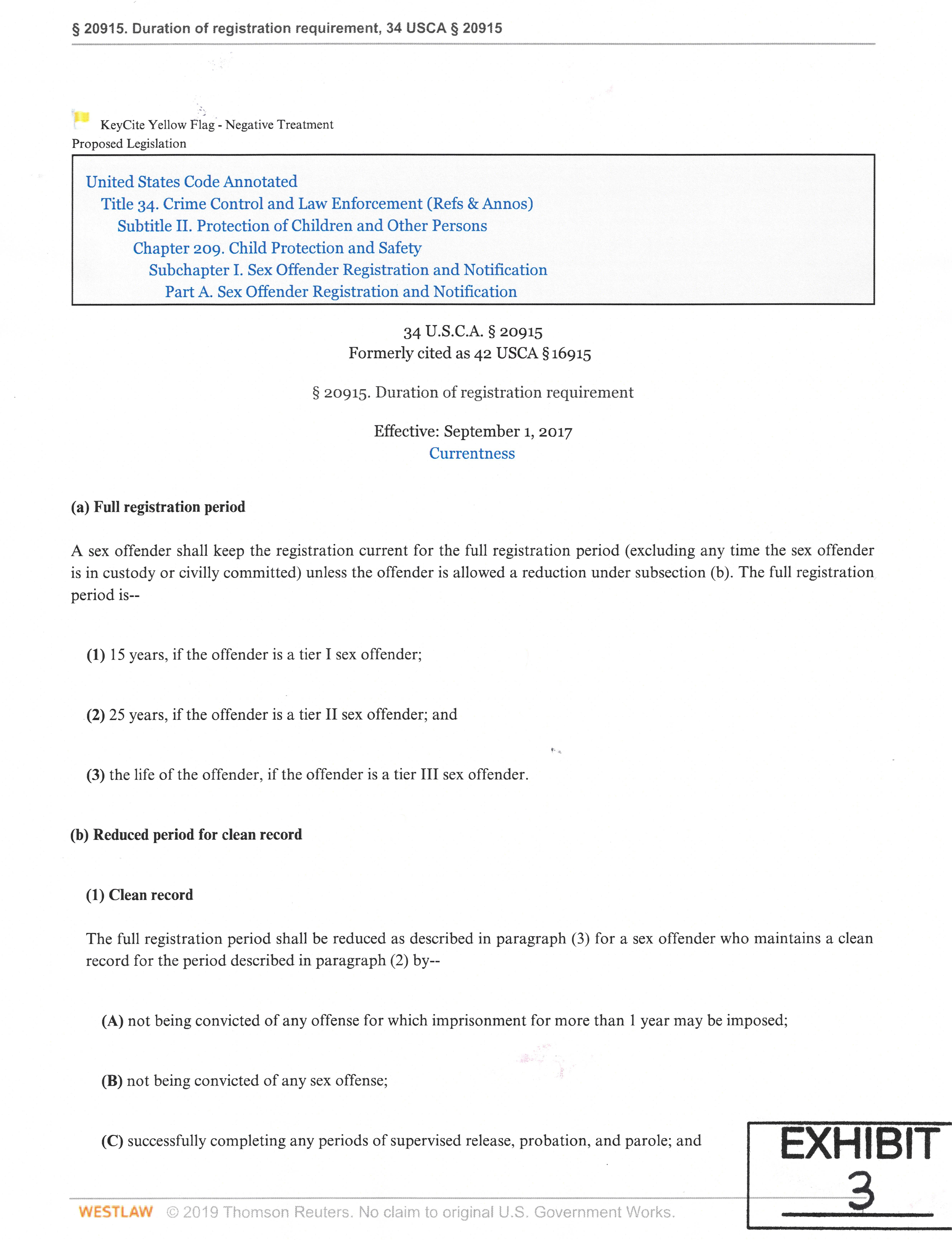
(D) successfully completing of 1 an appropriate sex offender treatment program certified by a jurisdiction or by the Attorney General.
(2) Period
In the case of--
(A) a tier I sex offender, the period during which the clean record shall be maintained is 10 years; and
(B) a tier III sex offender adjudicated delinquent for the offense which required registration in a sex registry under this subchapter, the period during which the clean record shall be maintained is 25 years.
(3) Reduction
In the case of--
(A) a tier I sex offender, the reduction is 5 years;
(B) a tier III sex offender adjudicated delinquent, the reduction is from life to that period for which the clean record under paragraph (2) is maintained.
CREDIT(S)
(Pub.L. 109-248, Title I, § 115, July 27, 2006, 120 Stat. 595.)
Notes of Decisions (2)
Footnotes
1 So in original. The word “of” probably should not appear. 34 U.S.C.A. § 20915, 34 USCA § 20915
Current through P.L. 116-5. Title 26 current through 116-9.
End of Document © 2019 Thomson Reuters. No claim to original U.S. Government Works.
Thomson Reuters. No claim to original U.S. Government Works.
§ 20915. Duration of registration requirement, 34 USCA § 20915 © 2019
2
Relevant
including Amie
expansion
USCA
20911
KeyCite Yellow Flag - Negative Treatment Proposed Legislation
United States Code Annotated
Title 34. Crime Control and Law Enforcement (Refs & Annos)
Subtitle II. Protection of Children and Other Persons Chapter 209. Child Protection and Safety
Subchapter I. Sex Offender Registration and Notification
Part A. Sex Offender Registration and Notification
34 U.S.C.A. § 20911
Formerly cited as 42 USCA §16911
§ 20911. Relevant definitions, including Amie Zyla expansion of sex offender definition and expanded inclusion of child predators
Effective: September 1, 2017 Currentness
In this subchapter the following definitions apply:
(1) Sex offender
The term “sex offender” means an individual who was convicted of a sex offense.
(2) Tier I sex offender
The term “tier I sex offender” means a sex offender other than a tier II or tier III sex offender.
(3) Tier II sex offender
The term “tier II sex offender” means a sex offender other than a tier III sex offender whose offense is punishable by imprisonment for more than 1 year and--
(A) is comparable to or more severe than the following offenses, when committed against a minor, or an attempt or conspiracy to commit such an offense against a minor:
(i) sex trafficking (as described in section 1591 of Title 18);
(ii) coercion and enticement (as described in section 2422(b) of Title 18);
(iii) transportation with intent to engage in criminal sexual activity (as described in section 2423(a)) 1 of Title 18;
§ 20911.
definitions,
Zyla
of..., 34
§
© 2019 Thomson Reuters. No claim to original U.S. Government Works. 1
(iv) abusive sexual contact (as described in section 2244 of Title 18);
(B) involves--
(i) use of a minor in a sexual performance;
(ii) solicitation of a minor to practice prostitution; or
(iii) production or distribution of child pornography; or
(C) occurs after the offender becomes a tier I sex offender.
(4) Tier III sex offender
The term “tier III sex offender” means a sex offender whose offense is punishable by imprisonment for more than 1 year and--
(A) is comparable to or more severe than the following offenses, or an attempt or conspiracy to commit such an offense:
(i) aggravated sexual abuse or sexual abuse (as described in sections 2241 and 2242 of Title 18); or
(ii) abusive sexual contact (as described in section 2244 of Title 18) against a minor who has not attained the age of 13 years;
(B) involves kidnapping of a minor (unless committed by a parent or guardian); or
(C) occurs after the offender becomes a tier II sex offender.
(5) Amie Zyla expansion of sex offense definition
(A) Generally
Except as limited by subparagraph (B) or (C), the term “sex offense” means--
(i) a criminal offense that has an element involving a sexual act or sexual contact with another;
(ii) a criminal offense that is a specified offense against a minor;
§ 20911. Relevant definitions, including Amie Zyla expansion of..., 34 USCA § 20911 © 2019 Thomson Reuters. No claim to original U.S. Government Works. 2
(iii) a Federal offense (including an offense prosecuted under section 1152 or 1153 of Title 18) under section 1591, or chapter 109A, 110 (other than section 2257, 2257A, or 2258), or 117, of Title 18;
(iv) a military offense specified by the Secretary of Defense under section 115(a)(8)(C)(i) of Public Law 105-119 (10 U.S.C. 951 note); or
(v) an attempt or conspiracy to commit an offense described in clauses (i) through (iv).
(B) Foreign convictions
A foreign conviction is not a sex offense for the purposes of this subchapter if it was not obtained with sufficient safeguards for fundamental fairness and due process for the accused under guidelines or regulations established under section 20912 of this title.
(C) Offenses involving consensual sexual conduct
An offense involving consensual sexual conduct is not a sex offense for the purposes of this subchapter if the victim was an adult, unless the adult was under the custodial authority of the offender at the time of the offense, or if the victim was at least 13 years old and the offender was not more than 4 years older than the victim.
(6) Criminal offense
The term “criminal offense” means a State, local, tribal, foreign, or military offense (to the extent specified by the Secretary of Defense under section 115(a)(8)(C)(i) of Public Law 105-119 (10 U.S.C. 951 note)) or other criminal offense.
(7) Expansion of definition of “specified offense against a minor” to include all offenses by child predators
The term “specified offense against a minor” means an offense against a minor that involves any of the following:
(A) An offense (unless committed by a parent or guardian) involving kidnapping.
(B) An offense (unless committed by a parent or guardian) involving false imprisonment.
(C) Solicitation to engage in sexual conduct.
(D) Use in a sexual performance.
(E) Solicitation to practice prostitution.
§ 20911. Relevant definitions, including Amie Zyla expansion of..., 34 USCA § 20911 © 2019 Thomson Reuters. No claim to original U.S. Government Works. 3
(F) Video voyeurism as described in section 1801 of Title 18.
(G) Possession, production, or distribution of child pornography.
(H) Criminal sexual conduct involving a minor, or the use of the Internet to facilitate or attempt such conduct.
(I) Any conduct that by its nature is a sex offense against a minor.
(8) Convicted as including certain juvenile adjudications
The term “convicted” or a variant thereof, used with respect to a sex offense, includes adjudicated delinquent as a juvenile for that offense, but only if the offender is 14 years of age or older at the time of the offense and the offense adjudicated was comparable to or more severe than aggravated sexual abuse (as described in section 2241 of Title 18), or was an attempt or conspiracy to commit such an offense.
(9) Sex offender registry
The term “sex offender registry” means a registry of sex offenders, and a notification program, maintained by a jurisdiction.
(10) Jurisdiction
The term “jurisdiction” means any of the following:
(A) A State.
(B) The District of Columbia.
(C) The Commonwealth of Puerto Rico.
(D) Guam.
(E) American Samoa.
(F) The Northern Mariana Islands.
(G) The United States Virgin Islands.
§ 20911. Relevant definitions, including Amie Zyla expansion of..., 34 USCA § 20911 © 2019 Thomson Reuters. No claim to original U.S. Government Works. 4
20911. Relevant definitions, including Amie Zyla expansion of..., 34 USCA
20911
(H) To the extent provided and subject to the requirements of section 20929 of this title, a federally recognized Indian tribe.
(11) Student
The term “student” means an individual who enrolls in or attends an educational institution, including (whether public or private) a secondary school, trade or professional school, and institution of higher education.
(12) Employee
The term “employee” includes an individual who is self-employed or works for any other entity, whether compensated or not.
(13) Resides
The term “resides” means, with respect to an individual, the location of the individual's home or other place where the individual habitually lives.
(14) Minor
The term “minor” means an individual who has not attained the age of 18 years.
CREDIT(S) (Pub.L. 109-248, Title I, § 111, July 27, 2006, 120 Stat. 591.)
Notes of Decisions (71)
Footnotes
1 So in original. The second closing parenthesis probably should follow “18”. 34 U.S.C.A. § 20911, 34 USCA § 20911 Current through P.L. 116-5. Title 26 current through 116-9.
End of Document © 2019 Thomson Reuters. No claim to original U.S. Government Works.
Thomson Reuters. No claim
original U.S. Government Works.
§
§
© 2019
to
5
KeyCite Yellow Flag - Negative Treatment
Unconstitutional or PreemptedValidity Called into Doubt by Graham v. Florida, U.S., May 17, 2010
KeyCite Yellow Flag - Negative TreatmentProposed Legislation
United States Code Annotated
Title 18. Crimes and Criminal Procedure (Refs & Annos)
Part I. Crimes (Refs & Annos)
Chapter 109A. Sexual Abuse (Refs & Annos)
18 U.S.C.A. § 2241
§ 2241. Aggravated sexual abuse
Effective: December 26, 2007 Currentness
(a) By force or threat.--Whoever, in the special maritime and territorial jurisdiction of the United States or in a Federal prison, or in any prison, institution, or facility in which persons are held in custody by direction of or pursuant to a contract or agreement with the head of any Federal department or agency, knowingly causes another person to engage in a sexual act--
(1) by using force against that other person; or
(2) by threatening or placing that other person in fear that any person will be subjected to death, serious bodily injury, or kidnapping; or attempts to do so, shall be fined under this title, imprisoned for any term of years or life, or both.
(b) By other means.--Whoever, in the special maritime and territorial jurisdiction of the United States or in a Federal prison, or in any prison, institution, or facility in which persons are held in custody by direction of or pursuant to a contract or agreement with the head of any Federal department or agency, knowingly--
(1) renders another person unconscious and thereby engages in a sexual act with that other person; or
(2) administers to another person by force or threat of force, or without the knowledge or permission of that person, a drug, intoxicant, or other similar substance and thereby--
(A) substantially impairs the ability of that other person to appraise or control conduct; and
(B) engages in a sexual act with that other person; or attempts to do so, shall be fined under this title, imprisoned for any term of years or life, or both.
§ 2241. Aggravated sexual abuse, 18 USCA § 2241 © 2019 Thomson Reuters. No claim to original U.S. Government Works. 1
(c) With children.--Whoever crosses a State line with intent to engage in a sexual act with a person who has not attained the age of 12 years, or in the special maritime and territorial jurisdiction of the United States or in a Federal prison, or in any prison, institution, or facility in which persons are held in custody by direction of or pursuant to a contract or agreement with the head of any Federal department or agency, knowingly engages in a sexual act with another person who has not attained the age of 12 years, or knowingly engages in a sexual act under the circumstances described in subsections (a) and (b) with another person who has attained the age of 12 years but has not attained the age of 16 years (and is at least 4 years younger than the person so engaging), or attempts to do so, shall be fined under this title and imprisoned for not less than 30 years or for life. If the defendant has previously been convicted of another Federal offense under this subsection, or of a State offense that would have been an offense under either such provision had the offense occurred in a Federal prison, unless the death penalty is imposed, the defendant shall be sentenced to life in prison.
(d) State of mind proof requirement.--In a prosecution under subsection (c) of this section, the Government need not prove that the defendant knew that the other person engaging in the sexual act had not attained the age of 12 years.
CREDIT(S)
(Added Pub.L. 99-646, § 87(b), Nov. 10, 1986, 100 Stat. 3620; amended Pub.L. 103-322, Title XXXIII, § 330021(1), Sept. 13, 1994, 108 Stat. 2150; Pub.L. 104-208, Div. A, Title I, § 101(a) [Title I, § 121[7(b)]], Sept. 30, 1996, 110 Stat. 3009-31; Pub.L. 105-314, Title III, § 301(a), Oct. 30, 1998, 112 Stat. 2978; Pub.L. 109-162, Title XI, § 1177(a)(1), (2), Jan. 5, 2006, 119 Stat. 3125; Pub.L. 109-248, Title II, §§ 206(a)(1), 207(2), July 27, 2006, 120 Stat. 613, 615; Pub.L. 110-161, Div. E, Title V, § 554, Dec. 26, 2007, 121 Stat. 2082.)
Notes of Decisions (174)
18 U.S.C.A. § 2241, 18 USCA § 2241
Current through P.L. 116-5. Title 26 current through 116-9.
of Document
No claim to original U.S. Government Works.
§ 2241. Aggravated sexual abuse, 18 USCA § 2241 © 2019 Thomson Reuters. No claim to original U.S. Government Works. 2
End
© 2019 Thomson Reuters.
United States Code Annotated
Title 18. Crimes and Criminal Procedure (Refs & Annos)
Part I. Crimes (Refs & Annos)
Chapter 109A. Sexual Abuse (Refs & Annos)
18 U.S.C.A. § 2242
§ 2242. Sexual abuse
Effective: December 26, 2007 Currentness
Whoever, in the special maritime and territorial jurisdiction of the United States or in a Federal prison, or in any prison, institution, or facility in which persons are held in custody by direction of or pursuant to a contract or agreement with the head of any Federal department or agency, knowingly--
(1) causes another person to engage in a sexual act by threatening or placing that other person in fear (other than by threatening or placing that other person in fear that any person will be subjected to death, serious bodily injury, or kidnapping); or
(2) engages in a sexual act with another person if that other person is--
(A) incapable of appraising the nature of the conduct; or
(B) physically incapable of declining participation in, or communicating unwillingness to engage in, that sexual act; or attempts to do so, shall be fined under this title and imprisoned for any term of years or for life.
CREDIT(S)
(Added Pub.L. 99-646, § 87(b), Nov. 10, 1986, 100 Stat. 3621; amended Pub.L. 103-322, Title XXXIII, § 330021(1), Sept. 13, 1994, 108 Stat. 2150; Pub.L. 109-162, Title XI, § 1177(a)(3), Jan. 5, 2006, 119 Stat. 3125; Pub.L. 109-248, Title II, §§ 205, 207(2), July 27, 2006, 120 Stat. 613, 615; Pub.L. 110-161, Div. E, Title V, § 554, Dec. 26, 2007, 121 Stat. 2082.)
Notes of Decisions (45)
18 U.S.C.A. § 2242, 18 USCA § 2242 Current through P.L. 116-5. Title 26 current through 116-9.
End of Document
claim
original U.S. Government Works.
original U.S. Government Works.
§ 2242. Sexual abuse, 18 USCA § 2242 © 2019 Thomson Reuters. No
to
1
© 2019 Thomson Reuters. No claim to
United States Code Annotated
Title 18. Crimes and Criminal Procedure (Refs & Annos)
Part I. Crimes (Refs & Annos)
Chapter 109A. Sexual Abuse (Refs & Annos)
18 U.S.C.A. § 2243
§ 2243. Sexual abuse of a minor or ward
Effective: December 26, 2007
Currentness
(a) Of a minor.--Whoever, in the special maritime and territorial jurisdiction of the United States or in a Federal prison, or in any prison, institution, or facility in which persons are held in custody by direction of or pursuant to a contract or agreement with the head of any Federal department or agency, knowingly engages in a sexual act with another person who--
(1) has attained the age of 12 years but has not attained the age of 16 years; and
(2) is at least four years younger than the person so engaging; or attempts to do so, shall be fined under this title, imprisoned not more than 15 years, or both.
(b) Of a ward.--Whoever, in the special maritime and territorial jurisdiction of the United States or in a Federal prison, or in any prison, institution, or facility in which persons are held in custody by direction of or pursuant to a contract or agreement with the head of any Federal department or agency, knowingly engages in a sexual act with another person who is--
(1) in official detention; and
(2) under the custodial, supervisory, or disciplinary authority of the person so engaging; or attempts to do so, shall be fined under this title, imprisoned not more than 15 years, or both.
(c) Defenses.--(1) In a prosecution under subsection (a) of this section, it is a defense, which the defendant must establish by a preponderance of the evidence, that the defendant reasonably believed that the other person had attained the age of 16 years.
(2) In a prosecution under this section, it is a defense, which the defendant must establish by a preponderance of the evidence, that the persons engaging in the sexual act were at that time married to each other.
§ 2243. Sexual abuse of a minor or ward, 18 USCA § 2243 © 2019 Thomson Reuters. No claim to original U.S. Government Works. 1
(d) State of mind proof requirement.--In a prosecution under subsection (a) of this section, the Government need not prove that the defendant knew--
(1) the age of the other person engaging in the sexual act; or
(2) that the requisite age difference existed between the persons so engaging.
CREDIT(S)
(Added Pub.L. 99-646, § 87(b), Nov. 10, 1986, 100 Stat. 3621; amended Pub.L. 101-647, Title III, § 322, Nov. 29, 1990, 104 Stat. 4818; Pub.L. 104-208, Div. A, Title I, § 101(a) [Title I, § 121[7(c)]], Sept. 30, 1996, 110 Stat. 3009-31; Pub.L. 105-314, Title III, § 301(b), Oct. 30, 1998, 112 Stat. 2978; Pub.L. 109-162, Title XI, § 1177(a)(4), (b)(1), Jan. 5, 2006, 119 Stat. 3125; Pub.L. 109-248, Title II, § 207, July 27, 2006, 120 Stat. 615; Pub.L. 110-161, Div. E, Title V, § 554, Dec. 26, 2007, 121 Stat. 2082.)
Notes of Decisions (36)
18 U.S.C.A. § 2243, 18 USCA § 2243
Current through P.L. 116-5. Also includes P.L. 116-8. Title 26 current through 116-9.
End of Document © 2019 Thomson Reuters. No claim to original U.S. Government Works.
§ 2243. Sexual abuse of a minor or ward, 18 USCA § 2243 © 2019 Thomson Reuters. No claim to original U.S. Government Works. 2
United States Code Annotated
Title 18. Crimes and Criminal Procedure (Refs & Annos)
Part I. Crimes (Refs & Annos)
Chapter 109A. Sexual Abuse (Refs & Annos)
18 U.S.C.A. § 2244
§ 2244. Abusive sexual contact
Effective: December 26, 2007
Currentness
(a) Sexual conduct in circumstances where sexual acts are punished by this chapter.--Whoever, in the special maritime and territorial jurisdiction of the United States or in a Federal prison, or in any prison, institution, or facility in which persons are held in custody by direction of or pursuant to a contract or agreement with the head of any Federal department or agency, knowingly engages in or causes sexual contact with or by another person, if so to do would violate--
(1) subsection (a) or (b) of section 2241 of this title had the sexual contact been a sexual act, shall be fined under this title, imprisoned not more than ten years, or both;
(2) section 2242 of this title had the sexual contact been a sexual act, shall be fined under this title, imprisoned not more than three years, or both;
(3) subsection (a) of section 2243 of this title had the sexual contact been a sexual act, shall be fined under this title, imprisoned not more than two years, or both;
(4) subsection (b) of section 2243 of this title had the sexual contact been a sexual act, shall be fined under this title, imprisoned not more than two years, or both; or
(5) subsection (c) of section 2241 of this title had the sexual contact been a sexual act, shall be fined under this title and imprisoned for any term of years or for life.
(b) In other circumstances.--Whoever, in the special maritime and territorial jurisdiction of the United States or in a Federal prison, or in any prison, institution, or facility in which persons are held in custody by direction of or pursuant to a contract or agreement with the head of any Federal department or agency, knowingly engages in sexual contact with another person without that other person's permission shall be fined under this title, imprisoned not more than two years, or both.
(c) Offenses involving young children.--If the sexual contact that violates this section (other than subsection (a)(5)) is with an individual who has not attained the age of 12 years, the maximum term of imprisonment that may be imposed for the offense shall be twice that otherwise provided in this section.
§ 2244. Abusive sexual contact, 18 USCA § 2244 © 2019 Thomson Reuters. No claim to original U.S. Government Works. 1
USCA
CREDIT(S)
(Added Pub.L. 99-646, § 87(b), Nov. 10, 1986, 100 Stat. 3622; amended Pub.L. 100-690, Title VII, § 7058(a), Nov. 18, 1988, 102 Stat. 4403; Pub.L. 103-322, Title XXXIII, § 330016(1)(K), Sept. 13, 1994, 108 Stat. 2147; Pub.L. 105-314, Title III, § 302, Oct. 30, 1998., 112 Stat. 2979; Pub.L. 109-162, Title XI, § 1177(a)(5), (b)(2), Jan. 5, 2006, 119 Stat. 3125; Pub.L. 109-248, Title II, §§ 206(a)(2), 207(2), July 27, 2006, 120 Stat. 613, 615; Pub.L. 110-161, Div. E, Title V, § 554, Dec. 26, 2007, 121 Stat. 2082.)
Notes of Decisions (56)
18 U.S.C.A. § 2244, 18 USCA § 2244
Current through P.L. 116-5. Title 26 current through 116-9.
End of Document © 2019 Thomson Reuters. No claim to original U.S. Government Works.
U.S.
§ 2244. Abusive sexual contact, 18
§ 2244 © 2019 Thomson Reuters. No claim to original
Government Works. 2
Budget: ZZ118 Fund: 087
Professional Licensing and Certification Unit Council on Sex Offender Treatment
P.O. Box 149347, Mail Code 1982 Austin, Texas 78714
ATTN: CSOT Executive Director
Phone (512) 834-4530 Fax (512) 834-6677
Email: csot@hhsc.state.tx.us
INITIAL ELIGIBILITY CHECKLIST FOR EARLY TERMINATION OF CERTAIN PERSON’S OBLIGATION TO REGISTER
(Please Type or Print Clearly)
Date:
Offender’s Name: DOB: Address:
City: Zip Code: Telephone: Email:
Attorney if Represented for Offender Deregistration: Address:
City: Zip Code: Telephone Fax: Email:
All Reportable Convictions or Adjudications:
Age of the Victim at the time of the Offense: County and Court Number of Sentencing Court:
(List of required supporting documentation is continued on next page)
Budget: ZZ118
Fund: 087
In addition to this form, you must also submit the following supporting documentation. Failure to supply the documentation may result in the rejection of your application:
Order of Conviction/Deferred Adjudication Order; Charging instrument (Indictment, Information, etc.)
If the reportable conviction or adjudication involved a minor, the applicant must provide a copyof one of the following documents which indicates the age of the victim at the time of the offense:
a. Offense Report
b. Probable Cause Affidavit
Finger print based criminal history background checks conducted by both the Texas Department of Public Safety and the Federal Bureau of Investigation. Use the respective links and follow the directions provided by each governmental agency.
DPS: http://www.dps.texas.gov/administration/crime_records/pages/applicantfingerprintser vices.htm
FBI: https://www.fbi.gov/services/cjis/identity history summary checks
Cashier’s Check or Money Order in the amount of $50 made payable to “Council on Sex Offender Treatment”. This fee is assessed for the administrative review of an applicant’s file and/or request to early terminate his/her obligation to register as a sex offender in Texas.
Please do not include any letters of support or recommendation as they cannot be considered by the Council on Sex Offender Treatment.
Failure to provide any of the above required information will delay and may prevent the review of your deregistration application.
Deregistration StepBy-Step Guide
Step One
Applicant should confirm that he/she has one reportable conviction or adjudication for a sexual offense. If an applicant has more than one reportable conviction or adjudication for a sexual offense, then STOP. The Applicant is ineligible to seek the early termination of his/her obligation to register.
• Examples: An applicant’s Order of Conviction or Deferred Adjudication Order recites two or more separate counts for sexual offenses. That person is ineligible.
• Only convictions or deferred adjudications handed down by Texas courts may be considered.

• A Deferred Adjudication Order is treated the same as a conviction pursuant to the Adam Walsh Act or federal law.
IF YOU HAVE ONLY ONE REPORTABLE CONVICTION OR ADJUDICATION, THEN PROCEED TO STEP TWO.
Step Two
An applicant should then go to the Texas Department of Public Safety Public Sex Offender Registration website here: https://records.txdps.state.tx.us/SexOffender/PublicSite/Index.aspx. Near the bottom right of the DPS website, under the heading "Additional Resources", is a link to “Texas Offenses Tiered Under the Federal Adam Walsh Act”. This will take you to the list published by the DPS containing reportable convictions and adjudications, by Texas Penal Code citation, that compare minimum registration requirements in Texas and under the federal law for a given offense.
1 Texas Health and Human Services ● hhs.texas.gov
Step Three
Locate on the DPS list your particular Texas Penal Code citation relating to your reportable conviction or adjudication. The minimum registration period for your reportable conviction must EXCEED the minimum registration period under the federal law, or Adam Walsh, in order to move on to the next step.
An applicant must also meet any other criteria required on the DPS list, including but not limited to, the age of the victim at the time of the offense, the difference in age between the victim and the offender, and specific fact patterns related to the offense where required.
Key Point: Only Texas convictions can be considered for deregistration purposes under this statute. No out of state convictions or adjudications are eligible even though the prospective applicant lives in Texas.
If an applicant meets the requirements above, then copies of the following required documents and the fee must be submitted along with the Initial Eligibility Checklist for Deregistration. The link for this form is under the “Deregistration Step by Step” drop-down menu.
1) Order of Conviction/Deferred Adjudication Order;
2) If the reportable conviction or adjudication involved a minor, an applicant shall provide a copy of one of the following documents which indicates the age of the victim at the time of the offense:
• Indictment
• Offense Report
• Probable Cause Affidavit
3) Current Criminal History Background Checks. Conducted by both the Texas Department of Public Safety and the Federal Bureau of Investigation. Click on the respective link and follow the directions provided by each governmental agency.
• http://www.dps.texas.gov/administration/crime_records/pages/applicantfing erprintservices.htm
• https://www.fbi.gov/services/cjis/identity history summary checks
4) Cashier’s Check or Money Order in the Amount of $50.00 made payable to: “Texas Council on Sex Offender Treatment”. This fee is assessed for the
2 Texas Health and Human Services ● hhs.texas.gov
administrative review of an applicant’s file and/or request to early terminate his/her obligation to register as a sex offender in Texas.
Additional Supporting Documents, but NOT REQUIRED:
5. If an applicant has undergone sex offender treatment and has successfully completed his/her treatment program, a letter from the LSOTP confirming the applicant’s successful completion of treatment.
6. If an applicant successfully discharged community supervision or parole, a copy of the Order discharging applicant successfully from community supervision or parole.
ALL DOCUMENATION AND FEE SHOULD BE SENT TO:
Texas Health and Human Services
Professional Licensing and Certification Unit
Council on Sex Offender Treatment
P.O. Box 149347, Mail Code 1982
Austin, Texas 78714
ATTN: CSOT Executive Director
After the complete documentation is reviewed by the Council on Sex Offender Treatment, and IF the applicant is approved as eligible to proceed with the deregistration process, the applicant will be provided information on how and where to have a deregistration evaluation conducted, at the applicant’s expense, by one of the Deregistration Specialists.
Texas Health and Human Services ● hhs.texas.gov
3
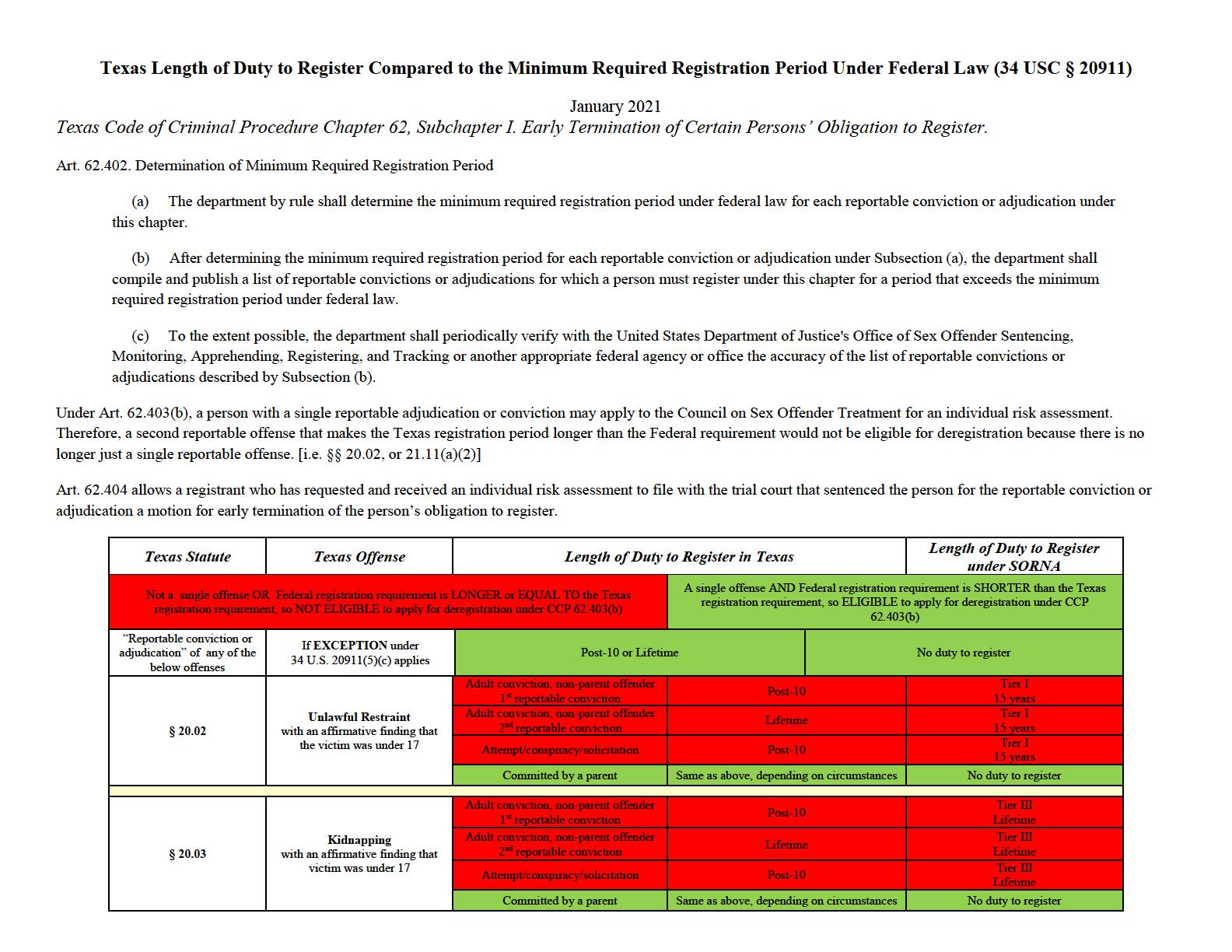
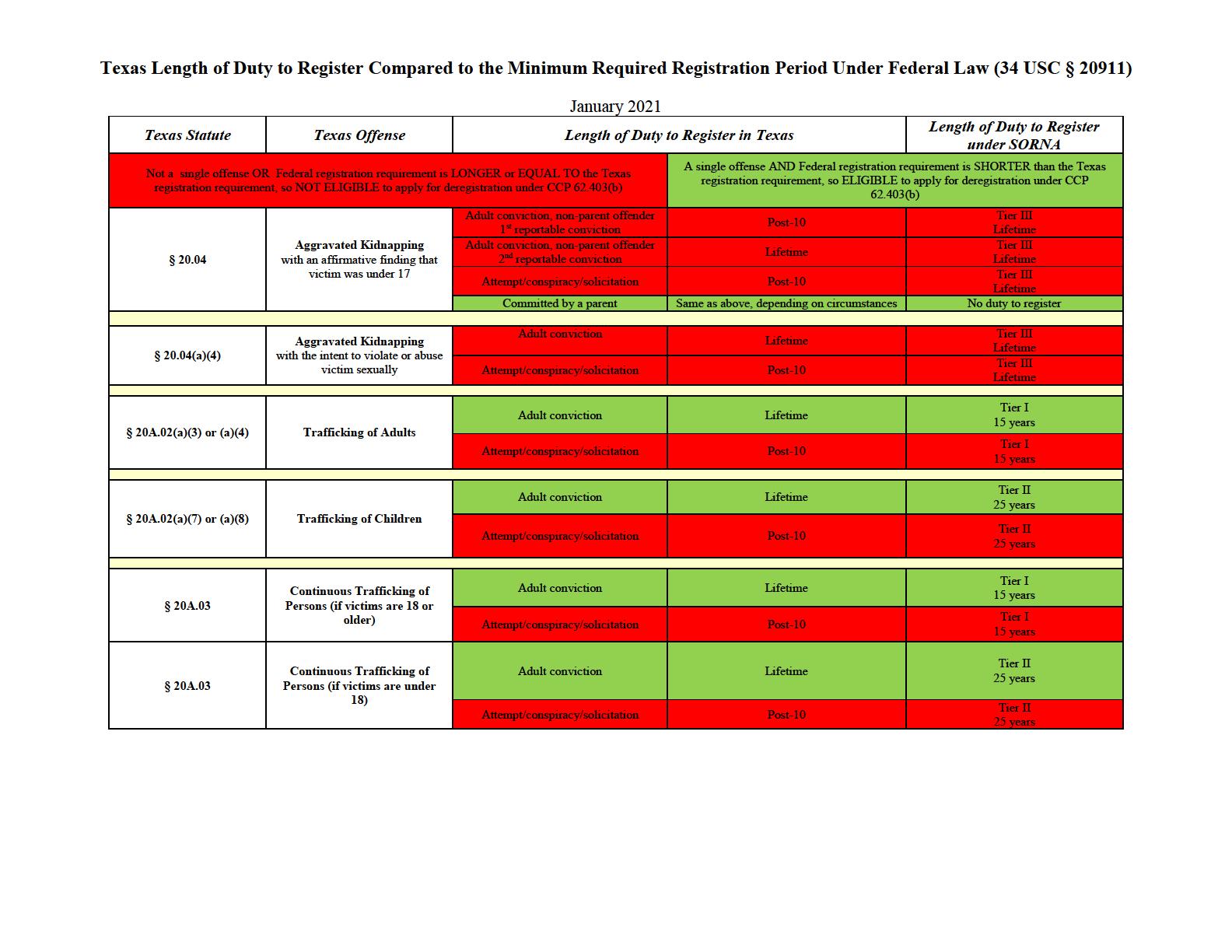
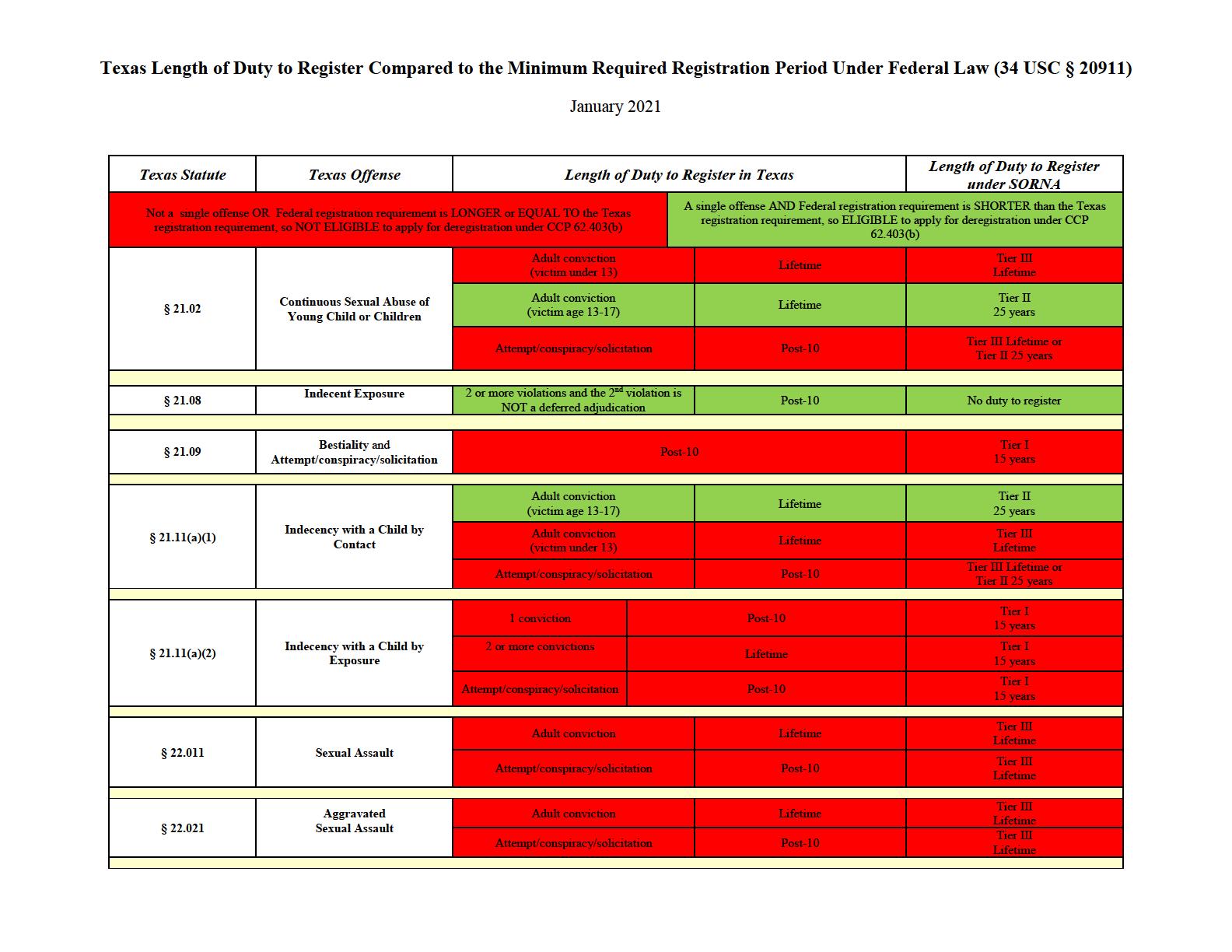

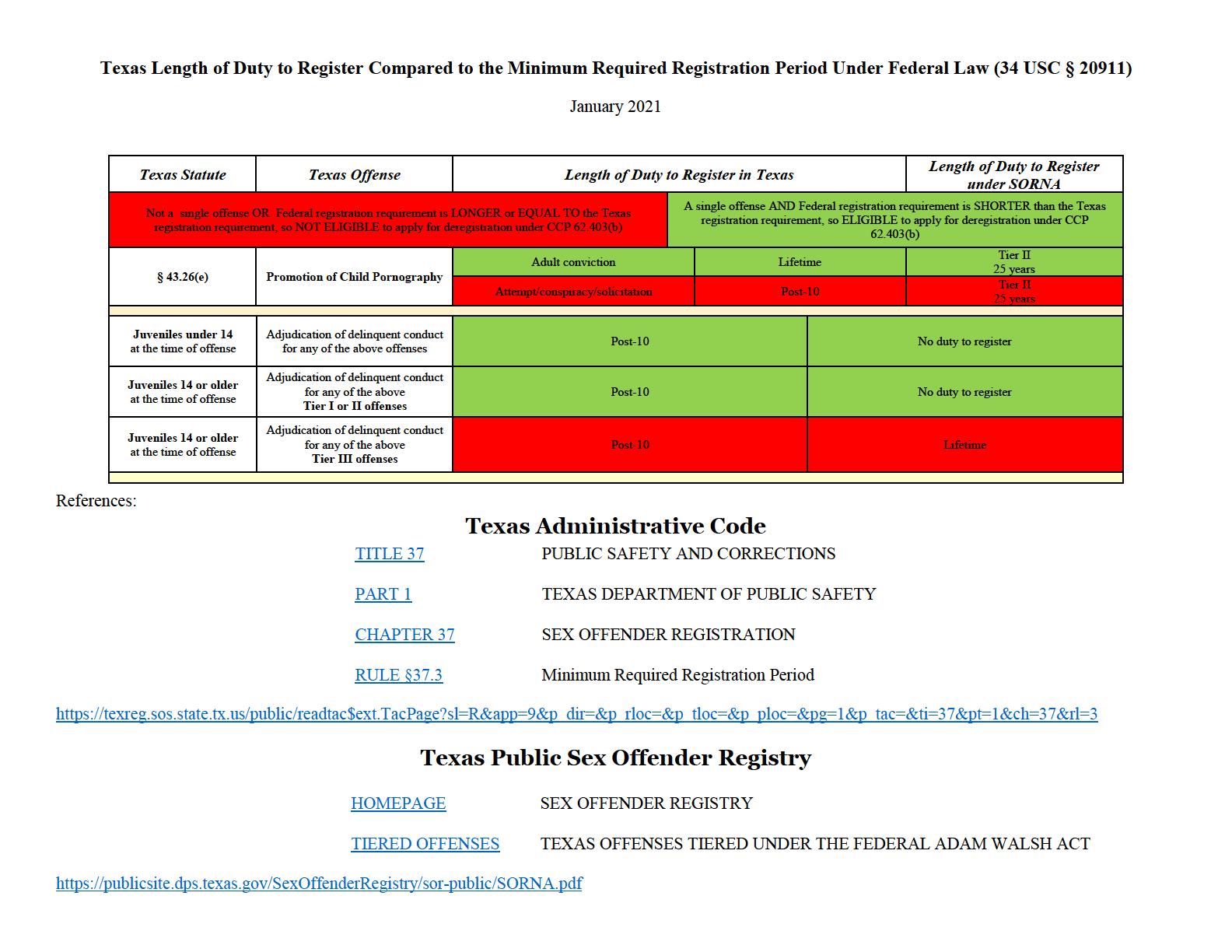
September 2022
Texas Code of Criminal Procedure Chapter 62, Subchapter I. Early Termination of Certain Persons’ Obligation to Register.
Art. 62.402. Determination of Minimum Required Registration Period
(a) The department by rule shall determine the minimum required registration period under federal law for each reportable conviction or adjudication under this chapter.
(b) After determining the minimum required registration period for each reportable conviction or adjudication under Subsection (a), the department shall compile and publish a list of reportable convictions or adjudications for which a person must register under this chapter for a period that exceeds the minimum required registration period under federal law.
(c) To the extent possible, the department shall periodically verify with the United States Department of Justice's Office of Sex Offender Sentencing, Monitoring, Apprehending, Registering, and Tracking or another appropriate federal agency or office the accuracy of the list of reportable convictions or adjudications described by Subsection (b).
Under Art. 62.403(b), a person with a single reportable adjudication or conviction may apply to the Council on Sex Offender Treatment for an individual risk assessment. Therefore, a second reportable offense that makes the Texas registration period longer than the Federal requirement would not be eligible for deregistration because there is no longer just a single reportable offense. [i.e. §§ 20.02, or 21.11(a)(2)]
Art. 62.404 allows a registrant who has requested and received an individual risk assessment to file with the trial court that sentenced the person for the reportable conviction or adjudication a motion for early termination of the person’s obligation to register.
Texas Statute Texas Offense Length of Duty to Register in Texas
NOT ELIGIBLE to apply for deregistration under CCP 62.403(b) = Not a single offense OR Federal registration requirement is LONGER or EQUAL TO the Texas registration requirement
ELIGIBLE to apply for deregistration IF REGISTERED more than 5 yrs while on deferred/parole/probation before discharge = A single offense AND Federal registration requirement is SHORTER than the Texas registration requirement
Adult conviction, non parent offender
reportable conviction
20.02
Unlawful Restraint with an affirmative finding that the victim was under 17
with an affirmative
Adult conviction, non parent offender
reportable
Length of Duty to Register under SORNA
ELIGIBLE to apply for deregistration under CCP 62.403(b) = A single offense AND Federal registration requirement is SHORTER than the Texas registration requirement
ELIGIBLE to apply for deregistration IF REGISTERED more than 15 yrs while on deferred/parole/probation before discharge = A single offense AND Federal registration requirement is SHORTER than the Texas registration requirement
I 15 years
15
15
Adult
that
Texas Length of Duty to Register Compared to the Minimum Required Registration Period Under Federal Law (34 USC § 20911)
§
1st
Post-10 Tier
2nd
conviction Lifetime Tier I
years Attempt/conspiracy/solicitation Post-10 Tier I
years Committed by a parent Same as above, depending on circumstances No duty to register § 20.03 Kidnapping
finding
conviction, non parent offender 1st reportable conviction Post-10 Tier III Lifetime
Length of Duty to Register
to the
Required
September 2022
victim was under 17 Adult conviction, non parent offender 2nd reportable conviction
Attempt/conspiracy/solicitation
Period Under Federal Law
USC
Texas Statute Texas Offense
Lifetime
Tier III Lifetime
Tier III Lifetime Committed by a parent Same as above, depending on circumstances No duty to register
Post-10
Length of Duty to Register in Texas
Not a single offense OR Federal registration requirement is LONGER or EQUAL TO the Texas registration requirement, so NOT ELIGIBLE to apply for deregistration under CCP 62.403(b)
Adult conviction, non parent offender 1st reportable conviction
§ 20.04
Aggravated Kidnapping with an affirmative finding that victim was under 17
§ 20.04(a)(4)
Aggravated Kidnapping with the intent to violate or abuse victim sexually
§ 20A.02(a)(3) or (a)(4) Trafficking of Adults
§ 20A.02(a)(7) or (a)(8) Trafficking of Children
§ 20A.03
Continuous Trafficking of Persons (if victims are 18 or older)
§ 20A.03
Continuous Trafficking of Persons (if victims are under 18)
Length of Duty to Register under SORNA
A single offense AND Federal registration requirement is SHORTER than the Texas registration requirement, so ELIGIBLE to apply for deregistration under CCP 62.403(b)
Post-10
Tier III Lifetime
Adult conviction, non parent offender 2nd reportable conviction Lifetime Tier III Lifetime
Attempt/conspiracy/solicitation Post-10 Tier III Lifetime Committed by a parent Same as above, depending on circumstances No duty to register
Adult conviction Lifetime Tier III Lifetime
Attempt/conspiracy/solicitation Post-10 Tier III Lifetime
Adult conviction Lifetime Tier I 15 years
Attempt/conspiracy/solicitation Post-10 Tier I 15 years
Adult conviction Lifetime Tier II 25 years
Attempt/conspiracy/solicitation Post-10 Tier II 25 years
Adult conviction Lifetime Tier I 15 years
Attempt/conspiracy/solicitation Post-10 Tier I 15 years
Adult conviction Lifetime Tier II 25 years
Attempt/conspiracy/solicitation Post-10 Tier II 25 years
Texas
Compared
Minimum
Registration
(34
§ 20911)
Texas Statute Texas Offense
Not
single offense
21.09
Sexual Abuse of Young Child
September 2022
Adult conviction
of Duty to Register in Texas
A
21.11(a)(1)
and Attempt/conspiracy/solicitation
Adult conviction
Indecency with a Child by Contact
Adult conviction (victim age
Adult conviction (victim under
Attempt/conspiracy/solicitation
1 conviction
21.11(a)(2)
Indecency with a Child by Exposure
Assault
Adult
Adult conviction
Adult conviction
Length of Duty to Register under SORNA
Tier
Tier
25
Tier
Lifetime
15
Tier II 25 years
Tier III Lifetime
Tier III Lifetime or Tier
25 years
15
Tier
15
Texas Length of Duty to Register Compared to the Minimum Required Registration Period Under Federal Law (34 USC § 20911)
Length
a
OR Federal registration requirement is LONGER or EQUAL TO the Texas registration requirement, so NOT ELIGIBLE to apply for deregistration under CCP 62.403(b)
single offense AND Federal registration requirement is SHORTER than the Texas registration requirement, so ELIGIBLE to apply for deregistration under CCP 62.403(b) § 21.02 Continuous
or Children
(victim under 13) Lifetime
III Lifetime
(victim age 13 17) Lifetime
II
years Attempt/conspiracy/solicitation Post-10 Tier III
or
II 25 years § 21.08 Indecent Exposure 2 or more violations and the 2nd violation is NOT a deferred adjudication Post-10 No duty to register §
Bestiality
Post-10 Tier I
years §
13 17) Lifetime
13) Lifetime
Post-10
II
§
Post-10 Tier I
years 2 or more convictions Lifetime
I
years Attempt/conspiracy/solicitation Post-10 Tier I 15 years § 22.011 Sexual
Lifetime Tier III Lifetime Attempt/conspiracy/solicitation Post-10 Tier III Lifetime
conviction if exception under 34 U.S. 20911(5)(c) applies Lifetime No duty to register § 22.021 Aggravated Sexual Assault
Lifetime Tier III Lifetime Attempt/conspiracy/solicitation Post-10 Tier III Lifetime
Texas
Not
Adult conviction of any of the above offenses
Juveniles under 14 at the time of offense
Juveniles 14 or older at the time of offense
Juveniles 14 or older at the time of offense
References:
If EXCEPTION under 34 U.S. 20911(5)(c) applies
Adjudication of delinquent conduct for any of the above offenses
Adjudication of delinquent conduct for any of the above Tier I or II offenses
Adjudication of delinquent conduct for any of the above Tier III offenses
TITLE
No duty to register
Post-10
Post-10
No duty to register
No duty to register
Post-10 Lifetime
Texas Administrative Code
PUBLIC SAFETY AND CORRECTIONS
PART 1 TEXAS DEPARTMENT OF PUBLIC SAFETY
CHAPTER 37 SEX OFFENDER REGISTRATION
Registration
Texas Public Sex Offender Registry
Texas Length of Duty to Register Compared to the Minimum Required Registration Period Under Federal Law (34 USC § 20911) September 2022
Statute Texas Offense Length of Duty to Register in Texas Length of Duty to Register under SORNA
a single offense OR Federal registration requirement is LONGER or EQUAL TO the Texas registration requirement, so NOT ELIGIBLE to apply for deregistration under CCP 62.403(b) A single offense AND Federal registration requirement is SHORTER than the Texas registration requirement, so ELIGIBLE to apply for deregistration under CCP 62.403(b) § 43.26(e) Promotion of Child Pornography Adult conviction Lifetime Tier II 25 years Attempt/conspiracy/solicitation Post-10 Tier II 25 years
Post-10 or Lifetime
37
RULE §37.3 Minimum Required
Period https://texreg.sos.state.tx.us/public/readtac$ext.TacPage?sl=R&app=9&p_dir=&p_rloc=&p_tloc=&p_ploc=&pg=1&p_tac=&ti=37&pt=1&ch=37&rl=3
September 2022 HOMEPAGE SEX OFFENDER REGISTRY
TIERED OFFENSES TEXAS OFFENSES TIERED UNDER THE FEDERAL ADAM WALSH ACT https://records.txdps.state.tx.us/SexOffenderRegistry/sor-public/SORNA_2019June.pdf
Texas Length of Duty to Register Compared to the Minimum Required Registration Period Under Federal Law (34 USC § 20911)
American Law Institute Adopts Revisions to Model Penal Code That Include Major Changes to Sex Offender Registries
On June 8, 2021 the membership of the American Law Institute gave its final approval to a revision of the Model Penal Code’s chapter on Sexual Assault and Related Offenses. This project was initially authorized by the ALI Council in 2012. The appointed Reporters, Professors Stephen Schulhofer and Erin Murphy of the New York University School of Law, began work immediately, preparing drafts for discussion with the appointed project Advisors and the Members’ Consultative Group. As is normal with ALI projects, these groups included practicing attorneys, judges, and scholars who are experts in the subject. Portions of the project were presented to the full membership at the annual meetings in 2014, 2015, 2016, and 2017. The ALI Council agreed on January 22 to recommend the membership’s final approval of the completed project. Tentative Draft Number 5 was then considered and approved by the Membership at the 2021 annual meeting held on June 8. The Reporters will now prepare the final published version reflecting the discussion at the Annual Meeting as well as editorial improvements.
The complete Tentative Draft, 600 pages long, addresses the substance of the full range of sexual assault crimes. It contains the Blackletter provisions setting forth the code’s statutory language for each section, official Comments interpreting and explaining each section, and Reporter’s Notes providing background and citations to sources relied upon by the Reporters in the draft. The original version of the Model Penal Code was published by the ALI in 1962. It was and remains highly influential. According to Wikipedia more than half the states enacted criminal codes that borrowed heavily from the MPC, and even courts in non-adopting states have been influenced by its provisions. It was a forward looking document. One important and influential contribution of the 1962 MPC was the removal of noncommercial sexual acts between consenting adults, such as sodomy, adultery and fornication, from the criminal law. In 2001, however, the Institute concluded that revision of some portions of the 50-year-old MPC had become necessary. This project, revising the portions of the MPC addressing sexual assault, is one of three separate revision projects on different portions of the code. The original MPC contained no provisions on a sexual offense registry; the inclusion of that topic in the MPC is among the most significant revisions to it now approved by the Institute.
The MPC’s registry provisions are contained in 11 sections. Including an official comment providing an Executive Summary, they are set forth in the final 120 pages of Tentative Draft No. 5. While the MPC adopts something called a registry, its substance departs significantly from existing registry laws, federal and state, as the Comments acknowledge. Key differences are:
1. Many sexual offenses that are registrable in the federal and most state laws are not registerable under the MPC provisions, which provide that no offense is subject to registration other than those it specifies as registerable. Only these five offenses (as defined by other sections of the MPC) trigger a registration obligation:
Ira Ellman June 9, 2021
a. Sexual Assault by Aggravated Physical Force or Restraint
b. Sexual Assault by Physical Force, but only when committed after the offender had previously been convicted of a felony sex offense.
c. Sexual Assault of an Incapacitated Person, but only when committed after the offender had previously been convicted of a felony sex offense.
d. Sexual Assault of a Minor, but only when the minor is younger than 12 and the actor is 21 years old or older.
e. Incestuous Sexual Assault of a Minor, but 1 only when the minor is younger than 16.
2. There is no public notification that individuals are on the registry, whether through a public website or any other means. Access to the registry is limited to law enforcement personnel. The knowing or reckless disclosure of registry information to others is a felony.
3. The maximum registration period for the small group who remain on the registry is 15 years, but those who do not re-offend, and comply with parole, probation, or supervised release conditions, are removed after ten years. Failure to register cannot be the basis of parole or probation revocation; it is punishable only as a misdemeanor offense.
4. General rules that required location monitoring of persons convicted of a sexual offense are barred, as are most restrictions on residency, access to schools or the internet. Judges could impose such restrictions in particular cases, but only on persons currently required to register, and only upon an evidentiary showing that there are special circumstances in that particular case that justify it, and only for a limited period of time. In no case may a judge require public notification. Mandatory restrictions on employment applicable primarily to persons convicted of a sexual offense that are created by other state laws are not repealed by the MPC, but anyone subject to them may petition a court for relief from the employment bar
The American Law Institute, established in 1923, is the leading independent organization in the United States producing scholarly work to clarify, modernize, and otherwise improve the law. The current Council of the ALI includes 7 members of the United States Courts of Appeal as well as Justices on the highest courts of California, Arizona, Texas, and New Jersey. The recommendations of the ALI Council become the official position of the Institute when (as with these revisions to the MPC contained in T.D. 5) they are adopted by the members, which consists of leading attorneys, law professors, and judges who have been nominated and elected to membership.
Submitted by the Council to the membership of Th e American Law Institute for consideration at the 2021 Annual Meeting on May 17-18 and June 7-8, 2021.
Model Penal Code: Sexual Assault and Related Offenses
Tentative Draft No. 5
(May 4, 2021)
SUBJECTS COVERED
ARTICLE 213 Part I – Grading
Part II – Sections 213.0 to 213.11J APPENDIX A Pertinent 1962 Code Provisions APPENDIX B Black Letter of Tentative Draft No. 5
The Executive Office
The American Law Institute 4025 Chestnut Street Philadelphia, PA 19104-3099
Telephone: (215) 243-1626 • Fax: (215) 243-1636 E-mail: ali@ali.org • Website: http://www.ali.org
©2021 by The American Law Institute
All Rights Reserved
As of the date on its cover, this draft had not been considered by the membership of The American Law Institute and therefore may not represent the position of the Institute on any of the issues with which it deals. Any action taken by the membership with respect to this draft may be ascertained by consulting the ALI website or the Proceedings of the Annual Meeting.
The American Law Institute
DAVID F. LEVI, President
LEE H. ROSENTHAL, 1st Vice President
TERESA WILTON HARMON, 2nd Vice President
WALLACE B. JEFFERSON, Treasurer
PAUL L. FRIEDMAN, Secretary
RICHARD L. REVESZ, Director
STEPHANIE A. MIDDLETON, Deputy Director
KIM J. ASKEW, DLA Piper US LLP, Dallas, TX
DONALD B. AYER, McLean, VA
COUNCIL
SCOTT BALES, Arizona Supreme Court (retired), Phoenix, AZ
JOHN H. BEISNER, Skadden, Arps, Slate, Meagher & Flom, Washington, DC
JOHN B. BELLINGER III, Arnold & Porter, Washington, DC
EVAN R. CHESLER, Cravath, Swaine & Moore, New York, NY
MARIANO-FLORENTINO CUÉLLAR, California Supreme Court, San Francisco, CA
ALLISON H. EID, U.S. Court of Appeals, Tenth Circuit, Denver, CO
IVAN K. FONG, 3M Company, St. Paul, MN
KENNETH C. FRAZIER, Merck & Co., Inc., Kenilworth, NJ
PAUL L. FRIEDMAN, U.S. District Court, District of Columbia, Washington, DC
STEVEN S. GENSLER, University of Oklahoma College of Law, Norman, OK
DANIEL C. GIRARD, Girard Sharp LLP, San Francisco, CA ABBE R. GLUCK, Yale Law School, New Haven, CT (on leave from Council until fall 2021) YVONNE GONZALEZ ROGERS, U.S. District Court, Northern District of California, Oakland, CA ANTON G. HAJJAR, Chevy Chase, MD THOMAS M. HARDIMAN, U.S. Court of Appeals, Third Circuit, Pittsburgh, PA TERESA WILTON HARMON, Sidley Austin, Chicago, IL NATHAN L. HECHT, Texas Supreme Court, Austin, TX WILLIAM C. HUBBARD, University of South Carolina School of Law, Columbia, SC SAMUEL ISSACHAROFF, New York University School of Law, New York, NY KETANJI BROWN JACKSON, U.S. District Court, District of Columbia, Washington, DC WALLACE B. JEFFERSON, Alexander Dubose & Jefferson LLP, Austin, TX GREGORY P. JOSEPH, Joseph Hage Aaronson LLC, New York, NY MICHELE C. KANE, The Walt Disney Company, Burbank, CA
PAMELA S. KARLAN, Stanford Law School, Stanford, CA HAROLD HONGJU KOH, Yale Law School, New Haven, CT CAROLYN B. KUHL, Superior Court of California, County of Los Angeles, Los Angeles, CA DEREK P. LANGHAUSER, Maine Maritime Academy and Community Colleges, Cumberland Foreside, ME CAROL F. LEE, Taconic Capital Advisors, New York, NY
DAVID F. LEVI, Duke University School of Law, Durham, NC LANCE LIEBMAN *, Columbia Law School, New York, NY GOODWIN LIU, California Supreme Court, San Francisco, CA
RAYMOND J. LOHIER, JR., U.S. Court of Appeals, Second Circuit, New York, NY GERARD E. LYNCH, U.S. Court of Appeals, Second Circuit, New York, NY LORI A. MARTIN, WilmerHale, New York, NY
TROY A. MCKENZIE, New York University School of Law, New York, NY M. MARGARET MCKEOWN, U.S. Court of Appeals, Ninth Circuit, San Diego, CA JUDITH A. MILLER, Chevy Chase, MD
PATRICIA ANN MILLETT, U.S. Court of Appeals, District of Columbia Circuit, Washington, DC JANET NAPOLITANO, University of California Berkeley, Goldman School of Public Policy, Berkeley, CA KATHRYN A. OBERLY, District of Columbia Court of Appeals (retired), Palm Beach, FL KATHLEEN M. O’SULLIVAN, Perkins Coie, Seattle, WA
*Director Emeritus
ii
© 2021 by The American Law Institute Material not approved This draft is subject to discussion, change, and approval at the 2021 Annual Meeting.
STEPHANIE E. PARKER, Jones Day, Atlanta, GA
STUART RABNER, New Jersey Supreme Court, Trenton, NJ
DAVID W. RIVKIN, Debevoise & Plimpton, New York, NY
DANIEL B. RODRIGUEZ, Northwestern University Pritzker School of Law, Chicago, IL
LEE H. ROSENTHAL, U.S. District Court, Southern District of Texas, Houston, TX
GARY L. SASSO, Carlton Fields, Tampa, FL
ANTHONY J. SCIRICA, U.S. Court of Appeals, Third Circuit, Philadelphia, PA
MARSHA E. SIMMS, Weil, Gotshal & Manges (retired), New York, NY
ROBERT H. SITKOFF, Harvard Law School, Cambridge, MA
JANE STAPLETON, Christ’s College, University of Cambridge, Cambridge, England
LAURA STEIN, Mondelēz International, Chicago, IL
LARRY S. STEWART, Stewart Tilghman Fox Bianchi & Cain (retired), Jupiter, FL
ELIZABETH S. STONG, U.S. Bankruptcy Court, Eastern District of New York, Brooklyn, NY
CATHERINE T. STRUVE, University of Pennsylvania Carey Law School, Philadelphia, PA
JEFFREY S. SUTTON, U.S. Court of Appeals, Sixth Circuit, Columbus, OH
SARAH S. VANCE, U.S. District Court, Eastern District of Louisiana, New Orleans, LA
SETH P. WAXMAN, WilmerHale, Washington, DC
STEVEN O. WEISE, Proskauer Rose LLP, Los Angeles, CA
DIANE P. WOOD, U.S. Court of Appeals, Seventh Circuit, Chicago, IL
COUNCIL EMERITI
KENNETH S. ABRAHAM, University of Virginia School of Law, Charlottesville, VA
PHILIP S. ANDERSON, Little Rock, AR
SUSAN FRELICH APPLETON, Washington University School of Law, St. Louis, MO JOSÉ I. ASTIGARRAGA, Reed Smith, Miami, FL
SHEILA L. BIRNBAUM, Dechert LLP, New York, NY ALLEN D. BLACK, Fine, Kaplan and Black, Philadelphia, PA AMELIA H. BOSS, Drexel University Thomas R. Kline School of Law, Philadelphia, PA MICHAEL BOUDIN, U.S. Court of Appeals, First Circuit, Boston, MA WILLIAM M. BURKE, Costa Mesa, CA ELIZABETH J. CABRASER, Lieff Cabraser Heimann & Bernstein, San Francisco, CA GERHARD CASPER, Stanford University, Stanford, CA EDWARD H. COOPER, University of Michigan Law School, Ann Arbor, MI N. LEE COOPER, Maynard, Cooper & Gale, Birmingham, AL GEORGE H. T. DUDLEY, Dudley Newman Feuerzeig, St. Thomas, U.S. VI CHRISTINE M. DURHAM, Utah Supreme Court (retired), Salt Lake City, UT CONRAD K. HARPER, New York, NY D. BROCK HORNBY, U.S. District Court, District of Maine, Portland, ME
MARY KAY KANE, University of California, Hastings College of the Law, San Francisco, CA CAROLYN DINEEN KING, U.S. Court of Appeals, Fifth Circuit, Houston, TX CAROLYN B. LAMM, White & Case, Washington, DC DOUGLAS LAYCOCK, University of Virginia School of Law, Charlottesville, VA PIERRE N. LEVAL, U.S. Court of Appeals, Second Circuit, New York, NY BETSY LEVIN, Washington, DC
MARTIN LIPTON, Wachtell, Lipton, Rosen & Katz, New York, NY MYLES V. LYNK, District of Columbia Office of Disciplinary Counsel, Washington, DC MARGARET H. MARSHALL, Choate Hall & Stewart, Cambridge, MA JOHN J. “MIKE” MCKETTA III, Graves, Dougherty, Hearon & Moody, Austin, TX ROBERT H. MUNDHEIM, Shearman & Sterling, New York, NY HARVEY S. PERLMAN, University of Nebraska College of Law, Lincoln, NE ELLEN ASH PETERS, Connecticut Supreme Court (retired), Hartford, CT ROBERTA COOPER RAMO*, Modrall Sperling, Albuquerque, NM MARY M. SCHROEDER, U.S. Court of Appeals, Ninth Circuit, Phoenix, AZ ROBERT A. STEIN, University of Minnesota Law School, Minneapolis, MN MICHAEL TRAYNOR *, Cobalt LLP, Berkeley, CA FREDERICK WILLIAM (BILL) WAGNER, Wagner McLaughlin, Tampa, FL WILLIAM H. WEBSTER, Milbank LLP (retired), Washington, DC HERBERT P. WILKINS, Concord, MA
iii
*President Emeritus and Chair of the Council Emeritus © 2021 by The American Law Institute Material not approved This draft is subject to discussion, change, and approval at the 2021 Annual Meeting.
Model Penal Code:
Sexual Assault and Related Offenses
Comments and Suggestions Invited
We welcome written comments on this draft. They may be submitted via the website project page or sent via email to MPCSAcomments@ali.org Comments will be forwarded directly to the Reporters, the Director, and the Deputy Director. You may also send comments via standard mail; contact information appears below.
Unless expressed otherwise in the submission, individuals who submit comments authorize The American Law Institute to retain the submitted material in its files and archives, and to copy, distribute, publish, and otherwise make it available to others, with appropriate credit to the author. Comments will be accessible on the website’s project page as soon as they are posted by ALI staff. You must be signed in to submit or view comments.
Reporter
Professor Stephen J. Schulhofer New York University School of Law 40 Washington Square South # 322B New York, NY 10012-1005 Email: stephen.schulhofer@nyu.edu
Associate Reporter
Professor Erin E. Murphy New York University School of Law 40 Washington Square South # 419 New York, NY 10012-1005 Email: erin.murphy@nyu.edu
Director Professor Richard L. Revesz
The Executive Office
THE AMERICAN LAW INSTITUTE 4025 Chestnut Street Philadelphia, PA 19104-3099
Email: director@ALI.org
Deputy Director
Ms. Stephanie A. Middleton
The Executive Office
THE AMERICAN LAW INSTITUTE 4025 Chestnut Street Philadelphia, PA 19104-3099
Email: smiddleton@ALI.org
Reporters’ Conflicts of Interest
The project’s Reporters may have been involved in other engagements on issues within the scope of the project; all Reporters are asked to disclose any conflicts of interest, or their appearance, in accord with the Policy Statement and Procedures on Conflicts of Interest with Respect to Institute Projects.
iv
© 2021 by The American Law Institute Material not approved This draft is subject to discussion, change, and approval at the 2021 Annual Meeting.
Penal Code:
Assault and Related Offenses
REPORTER
STEPHEN J. SCHULHOFER, New York University School of Law, New York, NY
ASSOCIATE REPORTER
ERIN E. MURPHY, New York University School of Law, New York, NY
ADVISERS
MICHELLE J. ANDERSON, Brooklyn College, Brooklyn, NY
SUSAN FRELICH APPLETON, Washington University School of Law, St. Louis, MO
JANIS M. BERRY, Attorney at Law (retired), Marblehead, MA SAMUEL W. BUELL, Duke University School of Law, Durham, NC I. BENNETT CAPERS, Fordham University School of Law, New York, NY W. TUCKER CARRINGTON, University of Mississippi School of Law, University, MS ROBERT M. CARY, Williams & Connolly, Washington, DC SARAH DEER, University of Kansas School of Law, Lawrence, KS DEBORAH W. DENNO, Fordham University School of Law, New York, NY PAUL STEVEN DIAMOND, U.S. District Court, Eastern District of Pennsylvania, Philadelphia, PA ARTHUR T. DONATO, Media, PA RONALD EISENBERG, Pennsylvania Attorney General’s Office, Philadelphia, PA DONNA LEE ELM, Law Practice of Donna Elm, Cottonwood, AZ MARY D. FAN, University of Washington School of Law, Seattle, WA KIMBERLY KESSLER FERZAN, University of Pennsylvania Carey School of Law, Philadelphia, PA
TERRY L. FROMSON, Women’s Law Project, Philadelphia, PA FATIMA GOSS GRAVES, National Women’s Law Center, Washington, DC AYA GRUBER, University of Colorado Law School, Boulder, CO ROSEMARY HART, Office of Legal Counsel, U.S. Department of Justice, Washington, DC BARBARA PARKER HERVEY, Texas Court of Criminal Appeals, Austin, TX WILLIAM M. JACKSON, District of Columbia Superior Court, Washington, DC VIRGINIA M. KENDALL, U.S. District Court, Northern District of Illinois, Chicago, IL NELLY N. KHOUZAM, Florida Second District Court of Appeal, Tampa, FL DEREK P. LANGHAUSER, Maine Maritime Academy and Community Colleges, Cumberland Foreside, ME JENNIFER G. LONG, AEquitas, Washington, DC GERARD E. LYNCH, U.S. Court of Appeals, Second Circuit, New York, NY CATHARINE A. MACKINNON, University of Michigan Law School, Ann Arbor, MI DANIEL J. MELTZER, Harvard Law School, Cambridge, MA [Deceased 2015] NANCY E. O’MALLEY, Alameda County District Attorney’s Office, Oakland, CA WENDY L. PATRICK, County of San Diego District Attorney’s Office, San Diego, CA LEE H. ROSENTHAL, U.S. District Court, Southern District of Texas, Houston, TX DAVID RUDOVSKY, Kairys, Rudovsky, Messing, Feinberg & Lin, Philadelphia, PA JON M. SANDS, Federal Public Defender, District of Arizona, Phoenix, AZ SUELLYN SCARNECCHIA, University of Michigan Law School (retired), Ann Arbor, MI ABBE SMITH, Georgetown University Law Center, Washington, DC DARRYL ANTONIO STALLWORTH, The Law Office of Darryl A. Stallworth, Oakland, CA CAROL S. STEIKER, Harvard Law School, Cambridge, MA JEANNIE SUK GERSEN, Harvard Law School, Cambridge, MA RONALD S. SULLIVAN, JR., Harvard Law School, Criminal Justice Institute, Cambridge, MA ANDREW E. TASLITZ, American University, Washington College of the Law, Washington, DC
[Deceased 2014]
REGGIE B. WALTON, U.S. District Court, District of Columbia, Washington, DC
v Model
Sexual
© 2021 by The American Law Institute Material not approved This draft is subject to discussion, change, and approval at the 2021 Annual Meeting.
JOAN PATRICIA WEBER, San Diego Superior Court, San Diego, CA COREY RAYBURN YUNG, University of Kansas School of Law, Lawrence, KS
LIAISONS
MARY KATHERINE BURKE, Rape, Abuse & Incest National Network, Washington, DC LAURA DUNN, L.L. Dunn Law Firm, Washington, DC CYNTHIA GARRETT, Families Advocating for Campus Equality, San Diego, CA
REBECCA HENRY, ABA Commission on Domestic & Sexual Violence, Washington, DC MICHAEL J. IACOPINO, National Association of Criminal Defense Lawyers, Manchester, NH NORMAN L. REIMER, National Association of Criminal Defense Lawyers, Washington, DC RICHARD SCOTT SCHMECHEL, D.C. Criminal Code Reform Commission, Washington, DC EBONY TUCKER, National Alliance to End Sexual Violence, Washington, DC
vi
© 2021 by The American Law Institute Material not approved This draft is subject to discussion, change, and approval at the 2021 Annual Meeting.
MEMBERS CONSULTATIVE GROUP
Model Penal Code: SexualAssault and Related Offenses (as of May 03, 2021)
RAHEEMAH F. ABDULALEEM, Washington, DC
ELIZABETH K. AINSLIE, Philadelphia, PA
JAMES J. ALFINI, Houston, TX
RONALD J. ALLEN, Chicago, IL
JOSÉ F. ANDERSON, Baltimore, MD
RICHARD T. ANDRIAS, New York, NY
DAVID J. ARONOFSKY, Missoula, MT
JOSEPH R. BANKOFF, Atlanta, GA
JENNIFER S. BARD, Gainesville, FL
FLORAL. BECKER, Philadelphia, PA
JOHN S. BECKERMAN, New Harbor, ME WARREN BELMAR, Palm Beach, FL DIANNE BENNETT, Buffalo, NY
BRIAN BIX, Minneapolis, MN
CHRISTOPHER L. BLAKESLEY, Las Vegas, NV STEVEN M. BRADFORD, Muscatine, IA RUSSELL J. BRUEMMER, Washington, DC ELLEN M. BUBLICK, Phoenix, AZ
JOSÉA. CABRANES, New Haven, CT
TERRY CALVANI, Nashville, TN CATHERINE L. CARPENTER, LosAngeles, CA ERIC R. CARPENTER, Miami, FL JENNY E. CARROLL, Tuscaloosa, AL
JOHN HILL CAYCE, Fort Worth, TX MARTHAE. CHAMALLAS, Columbus, OH
HENRY L. CHAMBERS JR., Richmond, VA STEVEN L. CHANENSON, Villanova, PA GABRIEL J. CHIN, Davis, CA PENELOPE L. CHRISTOPHOROU, New York, NY DANE S. CIOLINO, Metairie, LA ROGER S. CLARK, Camden, NJ CHRISTINE NERO COUGHLIN, Winston Salem, NC THOMAS L. CUBBAGE III, Plano, TX
RICHARD OLAF CUNNINGHAM, Washington, DC
BEVERLYWINSLOW CUTLER, Palmer, AK GEORGEA. DAVIDSON, New York, NY ROSS E. DAVIES, Arlington, VA
MICHELLE MADDEN DEMPSEY, Villanova, PA JOHN L. DIAMOND, San Francisco, CA DONALD L. DOERNBERG, Penn Valley, CA JOSHUA DRESSLER, Columbus, OH
JENNIFERANN DROBAC, Indianapolis, IN MEREDITH J. DUNCAN, Houston, TX CHRISTINE M. DURHAM, Salt Lake City, UT CINDY DYER, Washington, DC
ILANAH. EISENSTEIN, Philadelphia, PA
IRAMARK ELLMAN, Berkeley, CA
SHELDON H. ELSEN, New York, NY
ROGERA. FAIRFAX JR., Washington, DC
IRAM. FEINBERG, New York, NY
JAMES E. FELMAN, Tampa, FL
HERBERT L. FENSTER, Longmont, CO
EUGENE R. FIDELL, New Haven, CT
ARTHUR NORMAN FIELD, New York, NY
EDWARD B. FOLEY, Columbus, OH
C. ALLEN FOSTER, Washington, DC
MARYANNE FRANKS, Miami, FL
CAROLINE ROSE FREDRICKSON, Washington, DC
ERIC M. FREEDMAN, Hempstead, NY
ROBERT SHENTON FRENCH, Perth, Australia
ANDREW L. FREY, New York, NY
CHARLES FRIED, Cambridge, MA
PAUL L. FRIEDMAN, Washington, DC
HALEY J. FROMHOLZ, Pasadena, CA KENNETH S. GALLANT, Sequim, WA
ANNE GARDNER, Fort Worth, TX BRYANA. GARNER, Dallas, TX STEPHEN P. GARVEY, Ithaca, NY HENRY L. GARZA, Belton, TX JACOB E. GERSEN, Cambridge, MA NANCY GERTNER, Cambridge, MA CHRISTOPHER S. GONTARZ, Newport, RI HERVÉ GOURAIGE, Newark, NJ
LINDASHERYL GREENE, Madison, WI MICHAEL GREENWALD, Philadelphia, PA
BETSY J. GREY, Phoenix, AZ CHARLES E. GRIFFIN, Ridgeland, MS JUST. WILLIAM M. C. GUMMOW, Canberra, Australia
JAMES B. HALPERN, Bethesda, MD LESLIE JOAN HARRIS, Eugene, OR MICALYN SHAFER HARRIS, Ridgewood, NJ ROBERT M. HART, Bronxville, NY VIRGINIAELLEN HENCH, Honolulu, HI RONALD K. HENRY, Washington, DC ERNEST R. HIGGINBOTHAM, Dallas, TX W. WILLIAM HODES, Lady Lake, FL BRIAN M. HOFFSTADT, LosAngeles, CA STEVEN F. HUEFNER, Columbus, OH JOHNA. HUMBACH, White Plains, NY
vii © 2021 by The American Law Institute Material not approved This draft is subject to discussion, change, and approval at the 2021 Annual Meeting.
RICHARD H. HUNTER, St. Croix, Virgin Islands
CRAIG ISCOE, Washington, DC
RALPHA. JACOBS, Philadelphia, PA RICHARD GIBBS JOHNSON, Cleveland, OH LIZAILONA KARSAI, Chicago, IL HENRY R. KAUFMAN, New York, NY
MICHAEL EDWARD KEASLER, Austin, TX ORIN S. KERR, Berkeley, CA
EVELYN V. KEYES, Houston, TX MARK R. KILLENBECK, Fayetteville, AR
NANCY S. KIM, San Diego, CA
NANCY J. KING, Nashville, TN LAIRD C. KIRKPATRICK, Washington, DC DANIEL S. KLEINBERGER, Mendota Heights, MN CECELIAM. KLINGELE, Madison, WI
NINAA. KOHN, Syracuse, NY
GLENN S. KOPPEL, Irvine, CA MICHAEL J. KRAMER, Albion, IN BRUCE N. KUHLIK, Washington, DC SYBIL H. LANDAU, New York, NY
HOWARD LANGER, Philadelphia, PA MÁXIMO LANGER, LosAngeles, CA WILLIAM J. LEAHY, Albany, NY BILL LANN LEE, Berkeley, CA CYNTHIAK. LEE, Washington, DC EVAN TSEN LEE, San Francisco, CA JUDITH LEONARD, Washington, DC GEORGE W. LIEBMANN, Baltimore, MD WAYNEA. LOGAN, Tallahassee, FL HENRY R. LORD, Baltimore, MD MARGARET COLGATE LOVE, Washington, DC LINDAA. MALONE, Williamsburg, VA C. SCOTT MARAVILLA, Washington, DC RICHARD D. MARKS, Charlottesville, VA AMIE C. MARTINEZ, LINCOLN, NE MARGARET PENNY MASON, New Haven, CT MARY MASSARON, Bloomfield Hills, MI ALFRED D. MATHEWSON, Albuquerque, NM DAVID MCCORD, Des Moines, IA ROYW. MCLEESE III, Washington, DC BENJAMIN C. MCMURRAY, Salt Lake City, UT M. ISABEL MEDINA, New Orleans, LA A. DOUGLAS MELAMED, Stanford, CA MARJORIEA. MEYERS, Houston, TX KATHERINE G. MINARIK, Chicago, IL NATASHA MINSKER, Sacramento, CA S. DAVID MITCHELL, Columbia, MO SAIRA MOHAMED, Berkeley, CA THOMAS D. MORGAN, Naples, FL THOMAS R. NEWMAN, New York, NY VIRGINIAE. NOLAN, del Mar, CA
MICHAEL M. O'HEAR, Milwaukee, WI
JOHN EDWARD OSBORN, Chadds Ford, PA
NANCY LEEDS PERKINS, Washington, DC
ELLEN S. PODGOR, Gulfport, FL
SUSAN POSER, Chicago, IL
JOSEPHINE R. POTUTO, Lincoln, NE
MARGARET JANE RADIN, AnnArbor, MI
GERALD S. REAMEY, SanAntonio, TX
HENRY R. REEVE, Denver, CO
CHRISTINAC. REISS, Burlington, VT
SARAH E. RICKS, Camden, NJ
ALICE RISTROPH, Brooklyn, NY
IRAP. ROBBINS, Bethesda, MD
JAMES L. ROBERTSON, Jackson, MS
PAUL H. ROBINSON, Philadelphia, PA
MARGARET CASEY RODGERS, Pensacola, FL
THEODORE O. ROGERS JR., New York, NY
RONALD S. ROLFE, New York, NY
HOWARD RUDA, New York, NY
SABRINAR. SAFRIN, Newark, NJ
STEPHENA. SALTZBURG, Washington, DC LYNN HECHT SCHAFRAN, New York, NY PAUL SCHLAUD, Austin, TX ELIZABETH M. SCHNEIDER, Brooklyn, NY MILTON R. SCHROEDER, Paradise Valley, AZ
VICTOR E. SCHWARTZ, Washington, DC ELIZABETH J. SHAPIRO, Washington, DC
ANNAWILLIAMS SHAVERS, Lincoln, NE RICHARD W. SHEPRO, Chicago, IL KAMI CHAVIS SIMMONS, Winston Salem, NC KENNETH W. SIMONS, Irvine, CA VIRGINIAE. SLOAN, Washington, DC ROBERT D. SLOANE, Boston, MA KATHLEEN SMALLEY, LosAngeles, CA BRADLEYY. SMITH, New York, NY
MARGARET POLES SPENCER, Richmond, VA ARTHUR B. SPITZER, Washington, DC JANE STAPLETON, Cambridge, England EDWIN H. STERN, Florham Park, NJ H. MARK STICHEL, Baltimore, MD KATE STITH, New Haven, CT MARK P. STRASSER, Columbus, OH GUY MILLER STRUVE, New York, NY DWIGHT H. SULLIVAN, Washington, DC MARY-CHRISTINE SUNGAILA, Irvine, CA STEPHEN LYLE TATUM, Fort Worth, TX CAROLYN ENGEL TEMIN, Philadelphia, PA BOWEN H. TUCKER, Chicago, IL DEBORAH TUERKHEIMER, Chicago, IL MICHAEL VITIELLO, Sacramento, CA EUGENE VOLOKH, LosAngeles, CA
viii © 2021 by The American Law Institute Material not approved This draft is subject to discussion, change, and approval at the 2021 Annual Meeting.
JAYW. WAKS, Larchmont, NY
ARI EZRA WALDMAN, Boston, MA
JOHN L. WARDEN, New York, NY
THOMAS D. WATERMAN, Des Moines, IA
LOIS WEITHORN, San Francisco, CA
SARAH N. WELLING, Lexington, KY
MARIANNE WESSON, Lyons, CO
CHRISTINAB. WHITMAN, AnnArbor, MI
KEN WISE, Houston, TX
NICHOLAS J. WITTNER, East Lansing, MI
ROBIN E. WOSJE, Arlington, VA
RONALD F. WRIGHT, Winston Salem, NC
ix © 2021 by The American Law Institute Material not approved This draft is subject to discussion, change, and approval at the 2021 Annual Meeting.
SENTENCING AND COLLATERAL CONSEQUENCES OF CONVICTION
Comment:
Executive Summary *
Sentencing and the collateral consequences of conviction raise unusually complex issues;1 extensive black letter is required to treat them with precision But black letter is not the ideal way2 to convey the provisions’ overall aims and effects. This Executive Summary serves that purpose.3 It first explains why there is a need for Sections 213.11 to 213.11J in the scheme of Article 213. It4 then summarizes the most prominent features of current law on this subject and explains why it is5 important for Sections 213.11 to 213.11J to establish a different framework.6
1. Why is this subject addressed in Article 213? Underlying this common question are7 concerns about preemption and the appropriate scope of the project. Sentencing is treated8 comprehensively in the Institute’s recent revision of the sentencing provisions of the MPC. To9 reconsider that subject in Article 213 might seem unnecessary or inconsistent with prior judgments10 of the Institute. Moreover, collateral consequences are not intrinsically matters of criminal law11 and therefore might seem beyond the proper scope of a penal code.12 These concerns are understandable but misplaced. With respect to “preemption,”13 MPC:Sentencing treats sentencing issues only in general terms applicable to any offense. The14 Comments to MPC:Sentencing state that it is not intended to preclude special rules tailored to the15 specifics of particular offenses. 1 In any event, Sections 213.11 213.11J are not inconsistent with16 MPC:Sentencing; they supplement its provisions without contradicting them.17
The concern about relevance to criminal law is especially important. In determining18 whether to criminalize various forms of sexual misconduct, the Article 213 revision must consider19 all important consequences of doing so, regardless of whether they be labeled “penal” or20
* Footnote cross references in this Executive Summary indicate footnotes in Sections 213.11 213.11J of this Draft.
1 See M ODEL P ENAL CODE : S ENTENCING, Section 7.06(4) (Official Statutory Text, AM. L. INST., May 24, 2017) (stating that “[a] certificate of restoration of rights removes all mandatory collateral consequences …, except as provided by Article 213.) See also M ODEL P ENAL CODE : S ENTENCING Section 7.06 Comment d (Proposed Final Draft, AM L. INST., April 10, 2017) (stating that the Section 7.06 provisions concerning relief from collateral consequences are subject to an exception: “for individuals convicted of sexual offenses, the restrictions on relief set forth in Article 213 apply.”)
481 SECTION 213.11.
© 2021 by The American Law Institute Material not approved This draft is subject to discussion, change, and approval at the 2021 Annual Meeting.
“regulatory.” When revising the sentencing provisions of the MPC, the Institute approved a1 lengthy Article on collateral consequences, defined as “disadvantages, however denominated, that2 are authorized or required by federal or state law as a direct result of an individual’s conviction
[that] are not part of the sentence ordered by the court ….” 2 In that Article, moreover,4 MPC:Sentencing addresses and forbids certain demonstrably noncriminal consequences of5 conviction—disenfranchisement and disqualification from jury service. 3 In short, the Institute has
rejected the position that collateral consequences lie outside the domain of the MPC
Collateral consequences are especially important for Article 213. Over the past half8 century, the principle that frames the sexual offenses has shifted from force and coercion to the9 absence of consent. Updating the MPC to reflect this shift was a primary motivation for the10 Institute’s decision to revise Article 213. And because absence of consent, rather than only force,11 coercion, or incapacity, can now support conviction, the reach of sexual offense law has justifiably12 expanded in most American jurisdictions 4 and around the world. 5
The crucial question is to determine how far this expansion should go. That judgment must14 be shaped by balancing the need for penal safeguards against the potentially disproportionate15 consequences of a criminal conviction. A decision to consider the first half of this equation in16 isolation, without attention to the second half, would be difficult to defend. 617
This is not an abstract question. In prevalent state law, the consequences of a sexual-offense18 conviction often include highly restrictive “collateral” measures, such as onerous registration19
2 M ODEL P ENAL CODE : S ENTENCING, Section 7.01 (Official Statutory Text, AM L. INST., May 24, 2017) (emphasis added).
3 Id., Section 7.03.
4 See “Current State of the Law Consent-Only Offenses” (Oct. 20, 2016).
5 For example, the Istanbul Convention, adopted by the Council of Europe in 2011, requires member states to criminalize all “non consensual acts of sexual nature.” See Council of Europe Treaty Series - No. 210, Convention on Preventing and Combating Violence Against Women and Domestic Violence, May 11, 2011. The Convention was signed by 45 of the Council’s 47 member nations; only Russia and Azerbaijan failed to sign.
6 Referring to current Minnesota efforts to revise that state’s definitions of sexual assault, the mother of Jacob Wetterling (the victim of a nationally notorious sexual crime) recently wrote that “[a]ny statutory analysis of the criminal statutes is woefully incomplete without considering the effectiveness, cost, and collateral and material consequences the [sex offense] Registry poses.” Patty Wetterling, Letter to Minnesota Senators and Representatives, Feb. 8, 2021.
S ECTION 213.11 . E XECUTIVE S UMMARY 482
3
6
7
13
© 2021 by The American Law Institute Material not approved This draft is subject to discussion, change, and approval at the 2021 Annual Meeting.
duties, limits on employment and residency, and expanded public awareness of a local resident’s1 record of convictions. Courts have held that sex offense collateral consequence regimes in Alaska,2 Kentucky, Michigan, Pennsylvania, and many other states constitute criminal punishment and3 therefore are subject to all the strictures of the criminal law. 7 Statutory provisions like those are4 obviously appropriate for a penal code to address. But whether these consequences are penal or5 regulatory, they have powerful impacts on a convicted individual and therefore must be considered6 in any judgment about whether to criminalize an area of behavior.
An example makes this principle concrete. A decision to punish sexual penetration without8 force but without consent could be readily supported if the potential prison sentence is low and if9 the Code stipulates that conviction cannot lead to any “collateral” burdens. But that decision would10 be difficult to sustain if conviction could lead to life imprisonment even in the absence of11 aggravating circumstances. That decision likewise would be difficult to sustain if conviction could12 require lifetime registration with law enforcement and lifetime limits on employment and13 residency. Yet in many states, current law does exactly that; a penal code that did not address the14 issue would leave these burdens of conviction in effect. A sound approach to the criminalization15 decision cannot avoid attention to these consequences.16
7 In Smith v. Doe, 538 U.S. 84, 92 (2003), the Supreme Court held that sex offense registration regimes are not necessarily punitive and that Alaska SORA was not punitive as a matter of federal constitutional law. Compare Doe v. State, 189 P.3d 999 (Alaska 2008) (holding Alaska SORA to be punitive under state constitution); Doe v. Snyder, 834 F.3d 696, 705-706 (6th Cir. 2016) (holding that “Smith [should not] be understood as writing a blank check to states to do whatever they please in this arena… Michigan’s SORA imposes punishment”). Accord, State v. Myers, 923 P.2d 1024 (Kan. 1996) (holding Kansas SORA to be punitive as applied); Commonwealth v. Baker, 295 S.W.3d 437 (Ky. 2009) (holding residency restrictions of Kentucky SORNA to be punitive); State v. Letalien, 985 A.2d 4 (Me. 2009) (holding Maine SORNA to be punitive on its face); Doe v. State, 111 A.3d 1077, 1100 (N.H. 2015) (holding that “[a]s applied to petitioner, … the punitive effect of [New Hampshire registry law] was enough to overcome any nonpunitive legislative intent”); Riley v. N.J. State Parole Bd., 98 A.3d 544 (N.J. 2014) (holding New Jersey Sex Offender Monitoring Act to be punitive); Starkey v. Oklahoma Dep’t of Corr., 305 P.3d 1004 (Okla. 2013) (holding Oklahoma SORA to be punitive as applied); Commonwealth v. Muniz, 164 A.3d 1189 (Pa. 2018) (holding Pennsylvania SORNA to be punitive); In re C.P., 967 N.E.2d 729, 738 (Ohio 2012) (holding that Ohio SORNA imposes cruel and unusual punishment as applied to juveniles).
Cf. State v. Bani, 36 P.3d 1255, 1268 (Haw. 2001) (holding Hawaii SORNA to violate procedural due process in the absence of individualized risk assessment); Doe v. Attorney General, 686 N.E.2d 1007 (Mass. 1997) (Massachusetts, same); in re J.B., 107 A.3d 1 (Pa. 2014) (holding that Pennsylvania SORNA violates procedural due process as applied to juveniles); Doe v. Wasden, 9th Cir. Dec. 9, 2020 (holding that Smith does not foreclose plaintiffs’ claim that Idaho SORNA regime is punitive).
S ECTION 213.11 . E XECUTIVE S UMMARY 483
7
© 2021 by The American Law Institute Material not approved This draft is subject to discussion, change, and approval at the 2021 Annual Meeting.
2. Current law. All American jurisdictions currently require persons convicted of certain1 sexual offenses to register with local law enforcement where they reside, work, or study, and to2 continually update the personal information provided. In most states the list of sexual offenses that3 trigger these obligations is extensive, the obligations are long lasting, and the steps required to4 keep the information updated are onerous. Many states or their municipalities also prohibit5 registrants from residing in certain areas; most prohibit registrants from working in certain6 occupations. 8 And in nearly all states, the registry information is widely available. Although a few7 states keep that information confidential except with respect to registrants at high risk of8 reoffending, 9 most permit public access to information pertaining to every registered ex9 offender. 10 Moreover, most states require law enforcement to proactively notify the community as10 soon as a new registrant comes to the area. Although a few states notify only groups or individuals11 with a particular need to know, the great majority distribute notification widely, including to12 anyone who asks to be notified, regardless of need to know. 1113
Federal law complicates this picture. The Sex Offender Registration and Notification Act14 of 2006 (federal SORNA) 12 requires every state, as a condition of receiving certain federal funds,15 to maintain a registry of persons convicted of almost any offense that has a sexual element16 Although federal SORNA does not require states to limit registrants’ employment or residency, its17 other requirements are more restrictive than much preexisting state law. The offenses that must18 trigger a state duty to register include adjudications of delinquency involving use of force by19 juveniles aged 14 or older and adult convictions even for misdemeanor contact offenses 13;20 registrants must appear in person, within three business days, to report any change in required21
See generally, text at notes 149, 296-301, 319-322.
See text at notes 94-99, 276-278.
See text at note 243.
See text at notes 243, 274-278.
34 U.S.C. §§ 20901-20929 (2020).
Id., § 20911(5) & (8).
S ECTION 213.11 . E XECUTIVE S UMMARY 484
8
9
10
11
12
13
© 2021 by The American Law Institute Material not approved This draft is subject to discussion, change, and approval at the 2021 Annual Meeting.
registry information 14; the duties to register and to update personal information normally continue1 for at least 15 years even for the lowest level offenses; and those duties normally continue for life2 in the case of any penetration offense committed by force or threat. 15 Federal SORNA also requires3 each state to make available on the Internet most information about every registrant and to4 immediately notify the entire local community whenever an ex offender updates registry5 information or newly registers in the area. 16
Given the onerous requirements federal SORNA imposes on registrants and on state7 officials themselves, a large majority of the states have chosen not to comply with its entire8 mandate. As of November 2020, only 18 states were fully SORNA compliant; the rest have opted9 to disregard one or more of its major provisions, even at the cost of losing millions of dollars in10 federal funding. 17 Even so, registration requirements, public access to registry information, and11 proactive community notification about registrants in the area are the norm throughout the United12 States. And in many jurisdictions the burdens imposed on persons convicted of a sexual offense13 are even more restrictive than federal SORNA requires. Most states require registrants to submit14 to GPS monitoring in various circumstances; many restrict Internet usage; and at least 27 states15 and many municipalities prohibit registrants from living near schools, parks, playgrounds, and16 day-care centers. 1817
3. Assessment. The aim of these laws is to ease public fear, reduce recidivism, and enable18 concerned citizens to take steps for self-protection. Yet extensive research demonstrates that these19 gains have not materialized. To the contrary, there is clear evidence, widely acknowledged by20 professionals in the field, that these laws are seriously counterproductive. 19 They are expensive21
14 Id., § 20913(c).
Id., § 20915(a).
Id., §§ 20920(a); 20923(b).
17 See text at note 167 The most frequent reasons for substantial noncompliance were narrower lists of triggering offenses and less frequent obligations to verify and update registry information. See Andrew J. Harris & Christopher Lobanov-Rostovsky, National Sex Offender Registration and Notification Act (SORNA) Implementation Inventory Preliminary Results (July 2016), pp. 4, 13 30 (detailing reasons for noncompliance as of March 2016.)
18 See text at note 297.
19 See text at notes 150, 255-256, 316-327.
S ECTION 213.11 . E XECUTIVE S UMMARY 485
6
15
16
© 2021 by The American Law Institute Material not approved This draft is subject to discussion, change, and approval at the 2021 Annual Meeting.
for local police to administer, unduly hinder the rehabilitation of ex offenders, and ultimately1 defeat their own central purposes by impeding law enforcement and increasing the incidence of2 sexual offenses. 203
a. Recidivism. Although a common view holds that that “[t]he risk of recidivism posed by4 sex offenders is ‘frightening and high,’” 21 the available empirical evidence lends little or no5 support to this claim. 22 Even taking into account that reporting rates for sexual offenses are6 exceptionally low, “[s]ex offenders have some of the lowest recidivism rates of any class of7 criminal.” 23 This is also true of sexual offenses against children. Again, low reporting rates for8 offenses against minors make research about recidivism in these cases only suggestive rather than9 definitive, but to the extent that reliable data are available, they indicate that recidivism rates for10 these offenses are as low as or lower than for other sexual crimes. 2411
Comparative recidivism rates, however, are largely beside the point. Sexual offenses are12 distinctively unsettling and injurious, even more so in the case of sexual offenses against children.13 Exceptional prevention efforts are unquestionably justified. The crucial point is simply that14 registration, public access, community notification, residency restrictions, and other special15 burdens do not have the anticipated preventive effect Research on this point has been extensive,16 and its conclusions are unequivocal: all the available evidence indicates that these special burdens17 do not reduce the incidence of these offenses. 2518
See generally id.
21 Smith v. Doe, 538 U.S. 84, 103 (2003) (quoting McKune v. Lile, 536 U.S. 24, 34 (2002)).
See text at notes 111-128.
23 Stuart A. Scheingold et al., Sexual Violence, Victim Advocacy, and Republican Criminology: Washington State’s Community Protection Act, 28 LAW & SOC’Y REV. 729, 743 (1994) (noting that “as few as 5.3% [of sex offenders] re offend within three years, according to the Bureau of Justice Statistics, as opposed to rates in the 65 to 80% range for drug offenders and thieves.”)
24 See text at notes 111-128.
25 See text at notes 131-135. With respect to the recidivism impact of particular measures, “research provides little if any support for the effectiveness of residential restriction laws in deterring or preventing sexual offenses.” Tewksbury, Residency Restrictions, note 299, at 539. See also text at notes 319-323.
S ECTION 213.11 . E XECUTIVE S UMMARY 486
20
22
© 2021 by The American Law Institute Material not approved This draft is subject to discussion, change, and approval at the 2021 Annual Meeting.
Self-protection. Citizen self protection is a separate goal. Yet public access and1 community notification seldom prompt individuals to take effective precautions to safeguard2 themselves or their loved ones. And the very existence of these regimes diverts attention from3 much more significant sexual dangers, thus in effect fostering a false sense of security and
increasing the dangers to children and others. 26
Schools, day care centers, and other organizations that serve vulnerable populations
present a different issue. They must not employ staff or volunteers who put their clientele at risk
of sexual abuse, and their due diligence obligations in that regard are strong. But background
check mechanisms are available nationally and in all states to meet this need within well regulated
privacy-protective frameworks. Where incomplete or too narrow in their coverage, these10 background-check mechanisms can be strengthened without resort to county- and municipal level11 sex offense registries, which in any event cannot meet the need they are overbroad, poorly12 insulated from unnecessary public access, and dangerously underinclusive because they omit13 criminal history pertaining to relevant nonsexual offenses.
14
Costs. Substantial costs must be weighed against these scant public-safety benefits.15 Registration laws are expensive to implement, especially when (as is typical) they target a large,16 heterogeneous group of ex-offenders. For local police departments, registry management, GPS17 monitoring, and related duties take personnel away from responding to emergencies, investigating18 crime, and providing other public services. Out-of-pocket expenses for website technology and for19 recording and updating registry information can run to several millions of dollars per year. 28 Many20 states find that more selective approaches can achieve nearly all the benefits at much lower cost. 29
Unintended Effects Even more concerning are the counterproductive side effects.22 Restricted residency pushes registrants into socially disorganized, economically stressed
neighborhoods or into homelessness. Public access to registry information, community
notification, overbroad limits on employment and residency, and indirect impacts on registrants’
See text at note 136 and Reporters’ Note to Section 213.11H.
See text at notes 258-271.
See text at notes 145-146, 309-312.
note 167
S ECTION 213.11 . E XECUTIVE S UMMARY 487 b.
4
5
6
7
8
9
27
c.
21 d.
23
24
25 26
27
28
29 See
© 2021 by The American Law Institute Material not approved This draft is subject to discussion, change, and approval at the 2021 Annual Meeting.
ability to find jobs and housing lead to a high incidence of registrant joblessness, social isolation,1 homelessness, suicide, and even physical violence at the hands of misguided members of the2 public. 30 These effects in turn mean negative impacts for public safety because successful3 reintegration into society requires stable living arrangements, supportive family, and steady4 employment, while poor social support and psychological stress are important risk factors for5 sexual recidivism. So the burdens typically imposed on registrants almost inevitably aggravate the6 very dangers they seek to allay; the adverse impacts on registrants impede their rehabilitation and7 aggravate their risks of reoffending. 31 Registration of juveniles has had distinctively harsh8 consequences, and assessments of its value have been especially negative. 32 Because these9 criminogenic effects can increase registrant recidivism, they tend to outweigh any public safety10 benefits of self protection and the enhanced possibilities for surveillance and deterrence of11 registrants. The result, convincingly documented, is that these laws actually undermine public12 safety, the exact opposite of what lawmakers and the public so confidently assume they13 accomplish.14
4. Recommendations15
a. Overall approach The strong case against these schemes prompts many experts to16 unconditionally oppose any regime for sex-offense registration or other collateral consequences.17 The Draft does not endorse that view. First, simply as a pragmatic matter, it is clear that an Institute18 recommendation to eliminate registries entirely will have no constructive law reform impact,19 either now or in any foreseeable political future. Registries and their associated features currently20 command overwhelming public support, based on emotions and intuitions not easily dislodged.21 Those actively engaged in the reform effort on the ground are emphatic that there is no legislative22 audience for an approach that categorically opposes registries altogether 3323
See text at notes 149, 253-256, 319-322.
See text at notes 150, 255-256, 316-327.
See note 81 and text at notes 190-204.
33 See, e.g., William Buhl, J.J. Prescott & Miriam Aukerman, Michigan Poised to Double Down on Failed Sex Offender Registry, D ETROIT F REE P RESS , Dec. 10, 2020 (statement of “a judge whose hands were tied by SORA’s one size fits all approach, a researcher who has documented the counterproductive impact of registries, and an attorney who has represented [registrants]” arguing that in Michigan “[l]egislators should bring together stakeholders and experts to draft an evidence based statute, looking to examples like the draft model law written by the American Law Institute.” ); Patty Wetterling, Letter to
S ECTION 213.11 . E XECUTIVE S UMMARY 488
30
31
32
© 2021 by The American Law Institute Material not approved This draft is subject to discussion, change, and approval at the 2021 Annual Meeting.
On the merits, moreover, unqualified opposition to registries in any form reaches farther
than a discriminating analysis can justify. Sex offense collateral consequences in the United States
are certainly too harsh, a fact that no doubt contributes to the strongly negative reaction that the3 registry concept so often prompts. But the overly severe, counterproductive effects are not inherent
in registries as such. Instead, they result from features common in the United States but readily
severable and virtually unheard of elsewhere in the world.
Nearly every Western nation maintains registries of persons who have been convicted of a7 sexual offense. But unlike American registries, those of other countries are almost exclusively for8 law enforcement use, with either very limited need to know access for others or (in the great9 majority of countries) no public access at all. Registry regimes outside the United States typically10 include none of the elements that make American sex offense regimes so destructive—most11 obviously, the sweeping and illogical restrictions on residency, but also, for registries themselves,12 the overbroad list of offenses that require registration, burdensome and overly long lasting update13 duties, unrestricted public access, and sweeping community notification disconnected from any14 plausible need to know.
15
Minnesota Senators and Representatives, Feb. 8, 2021 (urging appointment of a Working Group to consider “many needed reforms” because Minnesota SORNA is “overbroad” and “must be scaled back.”); Eric Janus, Letter to Minnesota Senators and Representatives, Feb. 8, 2021 (same); Ira Ellman, email to Stephen Schulhofer, Nov. 10, 2020 (describing difficult, nearly unsuccessful California effort to enact modest SORNA amendments, merely to differentiate triggering offenses by tiers, and concluding “The idea of proposing [California] simply abolish its registry never occurred to anyone. [Even in] this heavily blue state in which Democrats enjoy legislative super majorities, that would have been a complete non starter.”); Eric S. Janus, email to Stephen Schulhofer, Jan. 21, 2021 (“Although I doubt that there are good grounds for uniquely targeting sex crimes for even highly confined registration laws, I believe that the current ALI draft moves substantially in the right direction. I am aware of efforts in some states … [to] rein in registration laws. A model law that focuses on the one arguably valid foundation for such laws assisting law enforcement would be of enormous benefit as a guide to state legislative efforts.”); Eric Tennen (Boston attorney who has represented several hundred registrants), Letter to Stephen Schulhofer, Feb. 16, 2021: “I [do not] support registration. … But as a practical matter, I recognize there is no real legal or political route to abolition.… I believe [the ALI’s] efforts can more realistically achieve reform than simply taking the position registration should not exist…. I do not believe that even our progressive [Massachusetts] Legislature would entertain calls to abolish our registry. However, I do believe our Legislature might be responsive to evidence based arguments to scale back registration…Therefore, [I support] ALI’s efforts on this front. I believe Council Draft 11 is an extremely well argued, well researched proposal. It is both modest and groundbreaking. Modest because it recognizes the reality of registration; groundbreaking because it insists registration be objective and scientific.”
S ECTION 213.11 . E XECUTIVE S UMMARY 489
1
2
4
5
6
34
34 See text at notes 30-80. © 2021 by The American Law Institute Material not approved This draft is subject to discussion, change, and approval at the 2021 Annual Meeting.
In light of these concerns, the Draft does not condemn sex offense collateral consequences1 wholesale. Instead, it recommends a selective approach Because a sex offense registry provides2 locally relevant information that police cannot obtain from ordinary criminal history databases
when they have not identified a particular suspect, 35 registries facilitate high priority investigations
of serious sexual offenses. That gives them the important practical advantages that prompt virtually5 all Western nations to maintain sex offense registries for law enforcement use. 36 As long as the6 confidentiality of these records is preserved, registration for law enforcement purposes poses7 relatively few dangers to public safety and to the welfare of registrants themselves.
The Draft therefore accepts the value of registries available exclusively to law enforcement,9 but requires that they be structured to avoid undue burdens on registrants. At the same time, the10 Draft limits and carefully targets other special burdens, permitting them only on a substantially11 more restricted basis than that found in much of current American law, in order to make their12 imposition more coherent and less prone to abusive application.13
b. Principal details. The Draft’s core recommendation is to permit sex-offense registries14 for the exclusive use of law enforcement, while deploying a range of devices, some conspicuous15 and others more granular, to minimize or eliminate unnecessarily harsh and counterproductive16 features of currently prevalent law. Seven of these limiting devices are especially important:17 1) Triggering offenses. Section 213.11A sharply restricts the class of individuals to whom18 the duty to register and other sex offense collateral consequences apply. It precludes registration19 of nearly all juveniles, and for adults, it imposes the threshold duty to register only upon conviction20 of offenses that most strongly arouse public concern, specifically:21
(i) Sexual Assault by Aggravated Physical Force or Restraint.22
(ii) Sexual Assault by Physical Force, but only when committed after the offender23 had previously been convicted of a felony sex offense.
(iii) Sexual Assault of an Incapacitated Person, but only when committed after the25 offender had previously been convicted of a felony sex offense.
(iv) Sexual Assault of a Minor, but only when the minor is younger than 12 and the27 actor is 21 years old or older.
See text at notes 85
notes 30-80.
S ECTION 213.11 . E XECUTIVE S UMMARY 490
3
4
8
24
26
28 35
36 See text at
© 2021 by The American Law Institute Material not approved This draft is subject to discussion, change, and approval at the 2021 Annual Meeting.
(v) Incestuous Sexual Assault of a Minor, but only when the minor is younger than
16.2
2) Updating information. Section 213.11E permits registrants to update required3 information by email or other readily accessible means of communication, without needing to4 make overly frequent personal appearances or navigate other burdensome bureaucratic obstacles.5
Duration of duties. The registration framework shortens in three ways the duration of6 required registration. Section 213.11F(2) limits to 15 years the registrant’s duty to keep registry
information current Section 213.11F(3) provides for automatic termination of that duty at an8 earlier date if the registrant meets specified rehabilitative goals during the initial registration9 period. Finally, Section 213.11J permits the registrant to apply for early removal from the registry10 upon an appropriate showing of rehabilitation.11
4) Public access to registry information. Section 213.11H marks a major departure from12 the American practice of investing considerable resources in an effort to maximize public13 awareness of registry information. It permits only government law enforcement agencies and14 personnel to access registry information. Non-law enforcement access is precluded, and Section15 213.11H imposes on authorities who have access to registry information a strong obligation to16 preserve its confidentiality.17
A legitimate need for non-law-enforcement access arises when an individual is being18 considered for a position of trust involving contact with a vulnerable population. But the FBI has19 authority to share criminal history information with state agencies responsible for licensing and20 employment background checks in regulated areas, including for individuals who work with21 vulnerable populations. 37 Although some state regimes do not apply to all arguably relevant22 occupations and may have other gaps, the solution to that problem is simply to fill those gaps23 directly, after expressly confronting the conflicting public safety benefits and privacy costs24 Whether that step is taken or not, local sex offense registries cannot fill such gaps because they25 omit criminal history information pertaining to large numbers of crucially relevant nonsexual26 offenses and therefore are vastly underinclusive. 38 To open local registries for these purposes
would create unnecessary risks, given the availability of pertinent records (including for relevant
S ECTION 213.11 . E XECUTIVE S UMMARY 491
1
3)
7
27
28 37 See text at note 262 38 See text at notes 262-271. © 2021 by The American Law Institute Material not approved This draft is subject to discussion, change, and approval at the 2021 Annual Meeting.
nonsexual offenses) from national and state databases subject to stronger oversight and controls.
Since the legitimate need can be met adequately, and indeed more adequately, in other ways,
Section 213.11H does not permit non-law enforcement access to registry information.
5) Community notification. Because persons and organizations with a justifiable need to4 know have access to criminal record information on a well regulated basis through the criminal5 history background check systems just mentioned, Section 213.11I(3) bars proactive government
measures broadly notifying community organizations and individuals that a registrant resides,7 works, or studies in the area.
6) Other burdens Section 213.11I tightly constrains, and in most cases eliminates, other9 burdens and restrictions applicable specifically to persons convicted of a sexual offense. It creates10 a strong presumption against GPS monitoring, residency restrictions, limits on Internet access, and11 the like, permitting them only when an individual, case-by-case risk assessment strongly supports12 the need for such a measure, to an extent that outweighs its potential for costly, counterproductive,13 and criminogenic effects. The official making the determination must carefully consider the14 public-safety need for the particular measure; weigh that need against its impact on the registrant,15 the registrant’s family, and the registrant’s prospects for rehabilitation; and ensure that any16 measure approved is drawn as narrowly as possible to achieve its public-safety objectives.17
7) Relief from registration and other burdens. Section 213.11J establishes standards and18 procedures by which registrants can petition for early relief from registration and other special19 burdens of a sex-offense conviction.20
S ECTION 213.11 . E XECUTIVE S UMMARY 492
1
2
3
6
8
© 2021 by The American Law Institute Material not approved This draft is subject to discussion, change, and approval at the 2021 Annual Meeting.
SECTION 213.11. SENTENCING AND COLLATERAL CONSEQUENCES OF CONVICTION
(1) Definitions. For purposes of this Article: (a) “sentencing consequences” are penalties, disabilities, or disadvantages that are part of the sentence imposed by the court or by an agency authorized to set the terms of parole or post-release supervision in connection with conviction of an Article 213 offense; and (b) “collateral consequences” are penalties, disabilities, or disadvantages, however denominated, that are authorized or required by federal, state, or local law as a direct result of an individual’s conviction of an Article 213 offense but are not part of the sentence imposed by the court or by an agency authorized to set the terms of parole or post-release supervision in connection with that conviction. (2) General Rule. Sentencing procedure, the authorized disposition of a person convicted of an Article 213 offense, sentencing consequences, and collateral consequences are specified in Articles 6 and 7 of this Code, * and are subject to the additional requirements of this Section.
(3) Additional Requirements for Sentencing Consequences. Notwithstanding any contrary provisions of law, the conditions of any suspended sentence under Section 6.02(2), any sentence to probation under Section 6.05, and any terms of parole or post-release supervision under Section 6.13 must be eligible for early relief under Section 213.11J and must not include:
(a) a condition that:
(i) imposes an obligation to register with law enforcement that carries requirements other than those authorized under Sections 213.11A-213.11G and Section 213.11J;
(ii) permits access to the person’s registry information, except as authorized under Section 213.11H; or
(iii) authorizes or permits any government official to notify a public or private entity or individual, other than a government law-enforcement agency or individual, that the person is registered with law enforcement or resides, works, or studies in the locality;
625
* M ODEL P ENAL CODE : S ENTENCING, Official Statutory Text (May 24, 2017). © 2021 by The American Law Institute Material not approved This draft is subject to discussion, change, and approval at the 2021 Annual Meeting.
(b) a condition that restricts the person’s occupation or employment, except as required by state law or authorized under paragraph (d) of this subsection; or (c) except as authorized under paragraph (d) of this subsection, a condition that:
(i) requires the person to submit to GPS monitoring; or (ii) restricts the person’s education, Internet access, or place of residence.
(d) The court, and any agency authorized to set the terms of parole or postrelease supervision, may impose a condition, not required by state law, that restricts the person’s occupation or employment, or a condition specified in paragraph (c) of this subsection, only if the court or agency determines that the condition is manifestly required in the interest of public safety. That determination must be:
(i) made after due consideration of the nature of the offense; all other circumstances of the case; the person’s prior record; and the potential negative impacts of the burden, restriction, requirement, or government action on the person, on the person’s family, and on the person’s prospects for rehabilitation and reintegration into society; and
(ii) accompanied by a written statement of the official setting the condition, explaining the need for it, the evidentiary basis for the finding of need, and the reasons why a more narrowly drawn condition would not adequately meet that need.
(e) Any condition imposed under paragraph (d) must be:
(i) drawn as narrowly as possible to achieve the goal of public safety; and
(ii) imposed only for a period not to exceed that permitted under Section 213.11F for the duties to register and keep the registration current.
(4) Additional Requirements for Collateral Consequences that are Applicable Primarily to Persons Convicted of a Sexual Offense. Notwithstanding any contrary provisions of law, collateral consequences applicable primarily to persons convicted of a sexual offense, including the obligation to register with law enforcement; associated duties; restrictions on occupation and employment, education, and place of residence applicable primarily to
626
© 2021 by The American Law Institute Material not approved This draft is subject to discussion, change, and approval at the 2021 Annual Meeting.
persons convicted of a sexual offense; and other collateral consequences applicable primarily to persons convicted of a sexual offense, are authorized and their scope and implementation are delineated as follows:
(a) The person’s obligation to register for law enforcement purposes is governed by Section 213.11A.
(b) Notification of the person’s obligation to register and associated duties is governed by Section 213.11B.
(c) The time of initial registration is governed by Section 213.11C.
(d) The information required upon registration is specified in Section 213.11D.
(e) The duty to keep registration current is specified in Section 213.11E.
(f) The duration of the registration requirements is specified in Section 213.11F.
(g) Penalties for failure to register are governed by Section 213.11G.
(h) Access to registry information is governed by Section 213.11H.
(i) Collateral consequences applicable primarily to persons convicted of a sexual offense, other than the obligation to register for law enforcement purposes and restrictions on occupation and employment required by state law, are governed by Section 213.11I.
(j) Standards and procedures for relief from the obligation to register, ass ociated duties, and other collateral consequences applicable specifically to persons convicted of a sexual offense are governed by Section 213.11J.
SECTION 213.11A. REGISTRATION FOR LAW-ENFORCEMENT PURPOSES
(1) Offenses Committed in This Jurisdiction
(a) Except as provided in subsection (3), every person convicted of an offense that is designated a registrable offense in this Article must, in addition to any other sanction imposed upon conviction, appear personally and register, at the time specified in Section 213.11C, with the law enforcement authority designated by law in the [county] where the person resides. If the person who is required to register
627
© 2021 by The American Law Institute Material not approved This draft is subject to discussion, change, and approval at the 2021 Annual Meeting.
under this subsection does not reside in this jurisdiction, but works in this jurisdiction, registration must be accomplished in the [county] where the person works; if the person does not reside or work in this jurisdiction but is enrolled in a program of study in this jurisdiction, registration must be accomplished in the [county] where the person studies.
(b) Notwithstanding any other provision of law, no conviction for an offense under this Article, or for any other criminal offense in this jurisdiction, will require the person convicted to register with law enforcement or other governmental authority in a registry regime applicable primarily to persons convicted of a sexual offense, unless this Article designates that offense as a registrable offense.
(2) Offenses Committed in Other Jurisdictions
(a) Duty to register and related duties. Every person currently obliged to register with law enforcement or other pubic authority in another jurisdiction, because of a sexual offense committed in that jurisdiction, who subsequently resides, works, or enrolls in a program of study in this jurisdiction, must register with the law-enforcement authority designated by law and comply with the requirements of Sections 213.11A-213.11G, provided that the offense committed in the other jurisdiction is comparable to an offense that would be registrable under this Article if committed in this jurisdiction.
(b) Place of registration. If the person who is obliged to register under paragraph (a) resides in this jurisdiction, registration must be accomplished in the [county] where the person resides. If the person who is obliged to register under paragraph (a) does not reside in this jurisdiction, but works in this jurisdiction, registration must be accomplished in the [county] where the person works; if the person does not reside or work in this jurisdiction but is enrolled in a program of study this jurisdiction, registration must be accomplished in the [county] where the person studies.
(c) Determining the comparability of in-state and out-of-state offenses
(i) Standard. An offense committed in another jurisdiction is comparable to a registrable offense under this Article if and only if the elements of the out-of-state offense are no broader than the elements of that
628
© 2021 by The American Law Institute Material not approved This draft is subject to discussion, change, and approval at the 2021 Annual Meeting.
registrable offense. When, regardless of the conduct underlying the out-ofstate conviction, the out-of-state offense can be committed by conduct that is not sufficient to establish a registrable offense under this Article, the two offenses are not comparable.
(ii) Procedure. Before determining that an offense committed in another jurisdiction is comparable to a registrable offense under this Article, the authority designated to make that determination must give the person concerned notice and an opportunity to be heard on that question, either orally or in writing.
(d) Notwithstanding any other provision of law, no conviction for a sexual offense in another jurisdiction will require the offender to register with law enforcement or other governmental authority in this jurisdiction, unless that conviction currently requires the offender to register with law enforcement or other governmental authority in the jurisdiction where the offense was committed and the conviction is for an offense comparable to an offense that would be registrable under this Article if committed in this jurisdiction.
(3) Persons under the age of 18. No person may be subject to the obligation to register under subsection (1) of this Section, to other obligations or restrictions under this Section, or to additional collateral consequences under Section 213.11I, on the basis of a criminal conviction for an offense committed when the person was under the age of 18, or on the basis of an adjudication of delinquency based on conduct when the person was under the age of 18; provided, however, that this subsection (3) does not apply to a person convicted of a criminal offense of Sexual Assault by Aggravated Physical Force or Restraint if the person was at least 16 years old at the time of that offense.
SECTION 213.11B. N OTIFICATION OF THE O BLIGATION TO R EGISTER AND A SSOCIATED D UTIES
(1) Before accepting a guilty plea, and at the time of sentencing after conviction on a guilty plea or at trial, the sentencing judge must:
(a) inform the person who is subject to registration of the registration requirement;
629
© 2021 by The American Law Institute Material not approved This draft is subject to discussion, change, and approval at the 2021 Annual Meeting.
(b) explain the associated duties, including:
(i) the identity and location, or procedure for determining the identity and location, of the law enforcement agency where the person must appear to register as required by Section 213.11A;
(ii) the duty to register with a law enforcement agency in any locality where the person subsequently resides, including the possible duty to register with a law-enforcement agency or other government authority in another jurisdiction to which the person subsequently moves;
(iii) the duty to report to that office or agency periodically in person, as required by Section 213.11E(1); and
(iv) the duty to promptly notify at least one of the local jurisdictions where the person is registered of any change in the registry information pertaining to that person, as required by Section 213.11E(2);
(c) notify the person of the right to petition for relief from those duties as provided in Section 213.11J;
(d) confirm that defense counsel has explained to that person those duties and the right to petition for relief from those duties;
(e) confirm that the person understands those duties and that right;
(f) require the person to read and sign a form stating that defense counsel and the sentencing judge have explained the applicable duties and the right to petition for relief from those duties, and that the person understands those duties and that right;
(g) ensure that if the person convicted of a sexual offense cannot read or understand the language in which the form is written, the person will be informed of the pertinent information by other suitable means that the jurisdiction uses to communicate with such individuals; and
(h) satisfy all other notification requirements applicable under Model Penal Code: Sentencing, Section 7.04(1).
(2) At the time of sentencing, the convicted person shall receive a copy of the form signed pursuant to subsection (1)(f) of this Section.
(3) If the convicted person is sentenced to a custodial sanction, an appropriate
630
© 2021 by The American Law Institute Material not approved This draft is subject to discussion, change, and approval at the 2021 Annual Meeting.
official must, shortly before the person’s release from custody, again inform the person of the registration requirement, explain the associated rights and duties, including the right to petition for relief from those duties, and require the person to read and sign a form stating that those rights and duties have been explained and that the person understands those rights and duties. At the time of release from custody, the person concerned shall receive a copy of that form.
SECTION 213.11C. T IME OF I NITIAL R EGISTRATION
A person subject to registration must initially register:
(a) if incarcerated after sentence is imposed, then within three business days after release; or
(b) if not incarcerated after sentence is imposed, then not later than five business days after being sentenced for the offense giving rise to the duty of registration.
SECTION 213.11D. I NFORMATION R EQUIRED IN R EGISTRATION
(1) A person subject to registration under Section 213.11A must provide the following information to the appropriate official for inclusion in the law-enforcement registry:
(a) the name of the person (including any alias used by the person);
(b) the Social Security number, if any, of the person;
(c) the address of each place where the person resides or expects to reside;
(d) the name and address of any place where the person works or expects to work;
(e) the name and address of any place where the person is a student or expects to be a student;
(f) the license plate number and a description of any vehicle owned or regularly operated by the person.
(2) Supplementary Information. The local jurisdiction in which a person registers must ensure that the following information is included in the registry for that person and
631
© 2021 by The American Law Institute Material not approved This draft is subject to discussion, change, and approval at the 2021 Annual Meeting.
kept up to date:
(a) the text of the provision of law defining the sexual offense for which the person is registered;
(b) the person’s criminal history, including the date and offense designation of all convictions; and the person’s parole, probation, or supervised-release status; (c) any other information required by law.
(3) Registrants Who Lack a Stable Residential Address. If a person required to register lacks a stable residential address, the person must, at the time of registration, report with as much specificity as possible the principal place where the person sleeps, instead of the information required under subsection (1)(c).
(4) The local jurisdiction in which a person registers must promptly provide the information specified in subsections (1), (2), and (3) of this Section to an appropriate law enforcement authority in every other jurisdiction in which the registrant works or expects to work and is enrolled or expects to enroll in a program of study.
(5) Correction of Errors . Each locality where a person registers and each locality that receives information about a registrant pursuant to subsection (4) of this Section must provide efficacious, reasonably accessible procedures for correcting erroneous registry information. Each locality where a person registers must, at the time of registration, provide the registrant instructions on how to use those procedures to seek correction of registry information that the registrant believes to be erroneous.
SECTION 213.11E. D UTY TO KEEP R EGISTRATION C URRENT
(1) Periodic Updates. A person who is required to register under Section 213.11A must, not less frequently than once every year, appear in person in at least one jurisdiction where the person is required to register, verify the current accuracy of the information provided in compliance with Section 213.11D(1), allow the jurisdiction to take a current photograph, and report any change in the identity of other jurisdictions in which the person is required to register or in which the person works or is enrolled in a program of study.
632
© 2021 by The American Law Institute Material not approved This draft is subject to discussion, change, and approval at the 2021 Annual Meeting.
(2) Change of Circumstances
(a) Except as provided in paragraph (b) of this subsection, a person subject to registration under Section 213.11A must, not later than five business days after each change of name and each change in the location where the person resides, works, or is enrolled in a program of study, notify at least one local jurisdiction specified in Section 213.11A of:
(i) all changes in the information that the person is required to provide under Section 213.11D, and
(ii) the identity of all other jurisdictions in which the person resides, works, or is enrolled in a program of study.
(b) Registrants who lack a stable residential address, and therefore report instead the principal place or places where they sleep, as provided in Section 213.11D(3), must confirm or update those locations once every 90 days but need not do so more often.
(c) Each jurisdiction that maintains a registry of persons who have been convicted of a sexual offense must permit registrants to notify the jurisdiction, by one or more reliable, readily accessible methods of communication of the jurisdiction’s choosing, such as U.S. mail, submission of an appropriate form online, or otherwise, of any change of name, residence, employment, student status, or vehicle regularly used, and any change in the identity of all other jurisdictions in which the person resides, works, or is enrolled in a program of study.
(d) Each jurisdiction where a person registers pursuant to Section 213.11A must advise the registrant, at the time of registration, of the registrant’s option to use the means of communication established under subsection (2)(c), rather than appearing personally for that purpose, if the registrant so chooses.
(3) The local jurisdiction notified of any changes pursuant to subsections (1) and (2) must promptly provide the registrant a written receipt confirming that the updated information has been provided, and must provide that information to all other jurisdictions in which the person resides, works, or is enrolled in a program of study.
633
© 2021 by The American Law Institute Material not approved This draft is subject to discussion, change, and approval at the 2021 Annual Meeting.
SECTION 213.11F. D URATION OF R EGISTRATION R EQUIREMENT
(1) Subject to the provisions of subsection (3) of this Section and Section 213.11J, a person required to register must keep the registration current for a period of 15 years, beginning on the date when the registrant is released from custody after conviction for the offense giving rise to the registration requirement; or if the registrant is not sentenced to a term of incarceration, beginning on the date when the registrant was sentenced for that offense.
(2) At the expiration of that 15 year period, the duty to keep that registration current will terminate; the person who had been registered will not be subject to any further duties associated with that registration requirement; and no public or private agency other than a government law-enforcement agency shall thereafter be permitted access to the person’s registry information.
(3) Early termination. If, during the first 10 years of the period during which a person is required to keep registration information current, the person:
(a) successfully completes any period of supervised release, probation, or parole, and satisfies any financial obligation such as a fine or restitution, other than a financial obligation that the person, despite good-faith effort, has been unable to pay; and
(b) successfully completes any required sex-offense treatment program; and (c) is not convicted of, or facing pending charges for, any subsequent offense under this Article, or any subsequent sexual offense in another jurisdiction that would be an offense under this Article if committed in this jurisdiction; then: the duty to keep that registry information current will terminate; the person who had been registered will not be subject to any further duties associated with that registration requirement; and subsequent access to registry information will be governed by subsection (4).
(4) Access to Registry Information after Termination. When the person’s obligation to register and to keep registry information current terminates under subsection (2) or (3), subsequent access to registry information is limited as follows: (a) Registry information recorded as of the date when termination takes effect may remain available to any government law enforcement agency seeking
634
© 2021 by The American Law Institute Material not approved This draft is subject to discussion, change, and approval at the 2021 Annual Meeting.
disclosure of that information in compliance with Section 213.11H(1)(a).
(b) Except as provided in paragraph (a), no public or private agency may thereafter be permitted access to registry information concerning the person whose obligation to register and keep registry information public has terminated.
(5) Notice of Termination. When a person’s duty to register terminates under subsection (2) or (3), the law-enforcement agency in the local jurisdiction where the person resides must:
(a) include in its registry a notice that the person’s duty to register and all duties associated with that registration requirement have terminated; and
(b) upon the person’s request, notify all other jurisdictions where the person is registered and where information about the registrant has been provided pursuant to Section 213.11D(4) that the person’s duty to register and all duties associated with that registration requirement have terminated and that no public or private agency other than a government law enforcement agency shall thereafter be permitted to have access to that registry information.
(6) Certification. When a person’s duty to register terminates under subsection (2) or (3), the law enforcement agency in the local jurisdiction where the person resides must, upon request, provide that person a certificate attesting that person’s duty to register and all duties associated with that registration requirement have terminated.
SECTION 213.11G. FAILURE TO R EGISTER
(1) Offense of Failure to Register. A person required to register under Section 213.11A is guilty of Failure to Register, a misdemeanor, if that person knowingly fails to register as required by Sections 213.11A, 213.11C, 213.11D, and 213.11E(1), or knowingly fails to update a registration as required by Section 213.11E(2).
(2) Affirmative Defense. In a prosecution for Failure to Register under subsection (1) of this Section, it is an affirmative defense that:
(a) circumstances beyond the control of the accused prevented the accused from complying;
635
© 2021 by The American Law Institute Material not approved This draft is subject to discussion, change, and approval at the 2021 Annual Meeting.
(b) the accused did not voluntarily contribute to the creation of those circumstances in reckless disregard of the requirement to comply; and (c) after those circumstances ceased to exist, the accused complied as soon as reasonably feasible.
SECTION 213.11H. A CCESS TO R EGISTRY I NFORMATION
(1) Confidentiality
(a) Each law-enforcement agency with which a person is registered and each law-enforcement agency that receives information about a registrant pursuant to Section 213.11D(4) must exercise due diligence to ensure that all information about the registrant remains confidential, except that relevant information about a specific registrant must be made available to any government law enforcement agency that requests information to aid in the investigation of a specific criminal offense.
(b) Any disclosure pursuant to paragraph (a) must include a warning that:
(i) the law-enforcement agency receiving the information must exercise due diligence to ensure that the information remains confidential;
(ii) such information may be disclosed and used as provided in paragraph (a), but otherwise must not be disclosed to any person or public or private agency;
(iii) such information may be used only for the purpose requested; (iv) such information may not be used to injure, harass, or commit a crime against the registrant or anyone else; and
(v) any failure to comply with the confidentiality and use-limitation requirements of paragraph (b) could result in civil or criminal penalties.
(2) Unauthorized Disclosure of Registry Information. An actor is guilty of Unauthorized Disclosure of Registry Information if:
(a) the actor, having received registry information as provided in subsection (1), knowingly or recklessly discloses that information, or permits that information to be disclosed, to any person not authorized to receive it; or (b) the actor obtains access to registry information by computer trespassing or otherwise in violation of law and subsequently knowingly or recklessly discloses
636
© 2021 by The American Law Institute Material not approved This draft is subject to discussion, change, and approval at the 2021 Annual Meeting.
that information, or permits that information to be disclosed, to any other person. Unauthorized Disclosure of Registry Information is a felony of the fourth degree [five-year maximum ].
SECTION 213.11I. A DDITIONAL C OLLATERAL C ONSEQUENCES OF C ONVICTION
(1) Definition. For purposes of this Section, the term “additional collateral consequence” means any collateral consequence, as defined in Section 213.11(1)(b), that is applicable primarily to persons convicted of a sexual offense, other than the obligation to register with law enforcement specified in Section 213.11A, the associated duties and restrictions specified in Sections 213.11C-213.11G, and any restriction on occupation or employment required by state law. These additional collateral consequences include any government imposed program or restriction applicable primarily to persons convicted of a sexual offense that restricts the convicted person’s occupation or employment except as required by state law; limits the convicted person’s education, Internet access, or place of residence; uses methods such as GPS monitoring to track the person’s movements; notifies a community organization or entity or a private party that the person resides, works, or studies in the locality; or permits a public or private agency, organization, or person to access registry information, except as authorized by Section 213.11H. An “additional collateral consequence” under this Section does not include a collateral consequence that applies to persons convicted of many different offenses, such as government imposed limits on voting, jury service, access to public benefits, and other government-imposed penalties, disabilities, and disadvantages that result from conviction of a wide variety of offenses, including but not limited to sexual offenses.
(2) Additional Collateral Consequences Precluded for Persons Not Required to Register. Notwithstanding any other provision of law, no person shall be subject to an additional collateral consequence, as defined in subsection (1), unless that person has been convicted of a registrable offense and is required to register with law enforcement under Section 213.11A.
(3) Additional Collateral Consequences Precluded for Persons Required to Register. Notwithstanding any other provision of law, a person required to register with law enforcement under Section 213.11A must not be subject to any government action notifying
637
© 2021 by The American Law Institute Material not approved This draft is subject to discussion, change, and approval at the 2021 Annual Meeting.
a community organization or entity or a private party that the person resides, works, or studies in the locality; and must not be subject to any government action permitting a public or private agency, organization, or person to access registry information, except as authorized by Section 213.11H.
(4) Additional Collateral Consequences Available for Persons Required to Register.
Notwithstanding any other provision of law, a person required to register with law enforcement under Section 213.11A may be subject to an additional collateral consequence not specified in subsection (3), but only if an official designated by law, after affording the person notice and an opportunity to respond concerning the proposed additional collateral consequence, determines that the additional collateral consequence is manifestly required in the interest of public safety, after due consideration of:
(a) the nature of the offense;
(b) all other circumstances of the case;
(c) the person’s prior record; and
(d) the potential negative impacts of the burden, restriction, requirement, or government action on the person, on the person’s family, and on the person’s prospects for rehabilitation and reintegration into society.
(5) Limitations. The designated official who approves any additional collateral consequence pursuant to subsection (4) of this Section must determine that the additional collateral consequence:
(a) satisfies all applicable notification requirements set forth in Section 213.11B;
(b) is authorized by law;
(c) is drawn as narrowly as possible to achieve the goal of public safety; (d) is accompanied by a written statement of the official approving the additional collateral consequence, explaining the need for it, the evidentiary basis for the finding of need, and the reasons why a more narrowly drawn restriction, disability, or government action would not adequately meet that need; and
(e) is imposed only for a period not to exceed that permitted under Section 213.11F for the duties to register and keep the registration current.
(6) Confidentiality. In any proceeding under subsection (4) to consider whether to
638
© 2021 by The American Law Institute Material not approved This draft is subject to discussion, change, and approval at the 2021 Annual Meeting.
impose an additional collateral consequence, the official responsible for making the determination must insure that the identity of the registrant concerned remains confidential.
SECTION 213.11J. DISCRETIONARY R ELIEF FROM R EGISTRATION AND O THER S ENTENCING C ONSEQUENCES AND C OLLATERAL C ONSEQUENCES
(1) Petition for Discretionary Relief. At any time prior to the expiration of any sentencing consequences imposed under Section 213.11(3) or any collateral consequences applicable primarily to persons convicted of a sexual offense, including the obligation to register, the obligation to comply with associated duties, restrictions on occupation or employment required by state law, collateral consequences imposed under Section 213.11(4), and additional collateral consequences imposed under Section 213.11I(4), the registrant may petition the sentencing court, or other authority authorized by law, to order relief from all or part of those consequences. If the obligation to register or other consequences arose from an out-of-state conviction, the petition may be addressed to a court of general jurisdiction or other authority of this state in the place where the person concerned is registered.
(2) Proceedings on Petition for Discretionary Relief. The authority to which the petition is addressed may either dismiss the petition summarily, in whole or in part, or institute proceedings to rule on the merits of the petition. If that authority chooses to entertain submissions, hear argument, or take evidence prior to ruling on the merits of the petition, it must give notice of the proceeding and an opportunity to participate in it to the prosecuting attorney for the offense out of which the obligation to register or other consequence arose. If the obligation to register or other consequence arose from an out-ofstate conviction, notice of the proceeding and an opportunity to participate in it must be addressed to the principal prosecuting attorney in the jurisdiction of this state where the authority to which the petition is addressed is located.
(3) Judgment on Proceedings for Discretionary Relief. Following proceedings for discretionary relief under subsection (2), the authority to which the petition is addressed may grant or deny relief, in whole or in part, from the obligation to register, any associated
639
© 2021 by The American Law Institute Material not approved This draft is subject to discussion, change, and approval at the 2021 Annual Meeting.
duties, and any of the sentencing consequences or collateral consequences in question. When that order terminates the registrant’s obligation to register and to keep registry information current, subsequent disclosure of registry information is governed by subsection (5) of this Section. An order granting or denying relief following those proceedings must explain in writing the reasons for granting or denying relief.
(4) Standard for Discretionary Relief. The authority to which the petition is addressed must grant relief if it finds, after proceedings to rule on the merits pursuant to subsection (2), that the sentencing consequence or collateral consequence in question is likely to impose a substantial burden on the registrant’s ability to reintegrate into lawabiding society, and that public-safety considerations do not require continued imposition of the obligation, duty, or consequence after due consideration of:
(a) the nature of the offense;
(b) all other circumstances of the case;
(c) the registrant’s prior and subsequent record of criminal convictions, if any; and
(d) the potential negative impacts of the burden, restriction, or government action on the registrant, on the registrant’s family, and on the registrant’s prospects for rehabilitation and reintegration into society.
Relief must not be denied arbitrarily or for any punitive purpose.
(5) Access to Registry Information after Discretionary Relief. When an order of discretionary relief terminates the person’s obligation to register and to keep registry information current, all limits on access to registry information under Section 213.11H shall remain in effect. Registry information recorded as of the date when discretionary relief takes effect must remain available to any government law-enforcement agency seeking disclosure of that information in compliance with Section 213.11H(1)(a) but must not otherwise be disclosed.
(6) Notice to Other Jurisdictions Concerning Discretionary Relief.
(a) When discretionary relief is granted to a person under this Section, the authority granting the order of relief must, upon the person’s request, give notice of that order to any other jurisdiction where the person concerned is registered or where information about the person has been provided pursuant to Section
640
© 2021 by The American Law Institute Material not approved This draft is subject to discussion, change, and approval at the 2021 Annual Meeting.
213.11D(4).
(b) When the other jurisdiction notified is a jurisdiction of this state, the notice must specify that the other jurisdiction must extend the same relief from registration related duties and any other sentencing consequences or collateral consequences. When that order terminates the registrant’s obligation to register and to keep registry information current, that notice must also specify the limits on subsequent disclosure of registry information applicable under subsection (5).
(7) Proceedings Subsequent to Discretionary Relief. An order of discretionary relief granted under this Section does not preclude the authority to which the petition was addressed from later revoking that order if, on the basis of the registrant’s subsequent conduct or any other substantial change in circumstances, the authority finds by a preponderance of the evidence that public safety considerations, weighed against the burden on the registrant’s ability to reintegrate into law abiding society, no longer justify the order of relief.
(8) Confidentiality. In any proceedings under this Section to consider whether to grant or deny discretionary relief, the official responsible for making the determination must insure that the identity of the registrant concerned remains confidential.
SECTION 213.12. PROCEDURAL AND EVIDENTIARY PRINCIPLES APPLICABLE
TO ARTICLE 213
reserved]
641
[
© 2021 by The American Law Institute Material not approved This draft is subject to discussion, change, and approval at the 2021 Annual Meeting.

Parole, Prison, and Related Issues October 13-14, 2022 Austin Southpark Hotel Austin, Texas 6808 Hill Meadow Dr :: Austin, Texas :: 512.478.2514 p :: 512.469.9107 f :: www.tcdla.com Criminal Defense Lawyers Project Topic: Innovating for a Change: Reinventing Texas Prisoner Rehabilitation in the 21st Century Speaker: John Walter Flagg 512.431.7288 phone Jwflagg64@gmail.com email
Innovating for a Change:
Reinventing Texas Prisoner Rehabilitation in the 21st Century
By John Walter Flagg
Modern civilization has been transformed by globalization and technology. The burgeoning information economy has unilaterally reshaped our ideas and redefined our values. Formats of technology now include the personal, financial and business aspect of one’s daily life, creating a total technological experience which is bound to a universal social interconnectedness. The rapid transition of society imposes on everyone the pressure of understanding new forms of technology and social interaction, which, in turn, has created a new series of challenges, performance requirements, values and needs. In this brave new world, one must stay abreast of the times or become obsolete.
A paradox:
As the world grows increasingly more connected through information and technology, prisoners grow more disconnected: that is, more backwards, more anti social and more obsolete. In fact, all the evidence concludes that prisoners are more anti social on their release from prison than they were on entering it. The lack of relevant knowledge transmission has thrust the prisoner into a paradox, and this is a direct result of rehabilitative mismanagement on account of existing programming Prolonged incarceration, which includes exposure to prolonged periods of forced labor, information suppression and social disparity, naturally severs the connection to the living and moving world here is where a sense of displacement settles upon the prisoner. During the period of incarceration, one’s aesthetic and social values are systematically destroyed; relevance evaporates; all social development is repressed; ideas of a shared purpose with society are withdrawn (see diagram below). A rehabilitative measure needs to be established that aims to preserve, enhance and rectify these circumstances and values
When a prisoner returns to society the accumulated years of rehabilitative negligence will be exposed, as it is becoming more and more necessary to have specific training and knowledge to
integrate functionally within society. Prisoners are naturally shunted to the sidelines of life, repressed and oppressed for having limited relevant knowledge, abilities and skills. And here is the paradox: the prisoner does not live in an alternate world but in a different part or aspect of one and the same world: although trapped in cognitive stagnation. Thousands of incarcerated men and women in Texas who live in the very shadow of astonishing achievement and human evolution are ignorant of the most common social, technological, economic and cultural milestones of the previous two decades
It must be understood that the determining framework of the prisoner’s experience has altered its form in accordance with all the multifarious changes within society. Without an anchor to link one to contemporary social reality, the prisoner has been relegated to the lowest level of educative and rehabilitative growth, limited in pertinent information transmission and social interconnectedness. Throughout the prisoner’s incarceration the world continues to evolve and transform: the stream of society and culture flows on unremittingly while the prisoner remains inert within a type of cognitive void Some examples of how social dissonance can manifest include:
a. instinctive servility
b. work world naïveté
c. misunderstandings of modern gender identification
d. racist preconceptions evolved from self preservation
e. aggression as primary resolution mechanism
f. skill limitations or obsolescence
g. technology illiteracy
h. constant referencing / reflecting on life prior to incarceration
The incarcerated experience:
The prison economy is poised for necessary ideological changes. Decades of organizational decay has eaten away at the time honored edifice, revealing the bankruptcy of ideas within.
Prisoner rehabilitation budgets are shrinking; the population of newly released prisoners unskilled, uneducated and with no social function is growing at an alarming rate; recidivism is at an all time high; and the return to criminal activity seems not only inevitable for the prisoner, but a direct consequence of the inadequate rehabilitative methodology presently implemented.
What underlies the current malaise of rehabilitation is that its traditional theories and efforts run counter to the vision and values of our constantly changing world. Reality has evolved, but the principles and programs of prisoner rehabilitation have not evolved with it. Yet the time-honored prison bureaucracy proliferates policies of technology suppression and information control, which have served to exacerbate the prisoner's plight. By failing to identify the remarkable transformative quality of information transmission and technology, coupled with their pivotal role within the rehabilitative process, the system has forged the very weapons that now assault it (e.g., prolonged incarceration, knowledge and skill irrelevancy, social disconnection, technology illiteracy and recidivism). It has become evident that the prison system is being strangled by its own red tape.
Examples of popular (and often mandatory) rehabilitation trends in widespread application are as follows:
a. anger management
b. creative writing
c. passé vocational trades
d. culinary arts
e. faith based curricula
In the final reckoning, current rehabilitation programs that were designed for some goal have, in turn, become an obstacle in the path of that goal.
Innovating in prisoner rehabilitation:
What, then, needs to be done? It calls for rehabilitative solutions that are flexible, adaptive and innovative. It calls for a refocusing of rehabilitative responsibility unto the prisoner; it calls for the complete reevaluation of the primary objective of generating relevant knowledge transmission; above all, it calls for the systematic abandonment of activities and programs that are arrayed against all the structures of contemporary social reality. What is needed is not a new way of doing things: but more a new way of thinking about things. In a world buffeted by change, where confronting new challenges is a daily routine, the only way for a prisoner to endure is to implement rehabilitative innovations. It is necessary to take effective action to bring the prisoner in step with 21st century reality.
For rehabilitative education to serve a catalytic function it must pivot on questions involving how you educate (method), what you educate (curriculum), where you educate (environment), and having a clear perception unto whom you are educating (in this case, adult prisoners). A suggested theory for prisoner rehabilitation curricula and programming rests on the following pillars:
• To demonstrate the impact and importance of interactive media, technology awareness and relevant information transmission and its crucial role in the rehabilitative process.
• To reduce recidivism by raising the prisoner up to the average cultural level through the evolution of information and the increasing of skill aptitude. This will oblige the prisoner to abandon the old "criminal identifiers", i.e., the anti social elements that form a negatively structured milieu, while linking each one of the individual's faculties and abilities in a total integration with a new basis of positively charged content all firmly rooted in the most volatile immediacy.
• To initiate a rigorous training regimen for instructors and mentors who are willing to devote their energy and efforts to the heightening of a prisoner's intellectual, emotional and social awareness, employing each of the rehabilitative elements proposed here.
• To build upon a foundation already inherent within the prisoner, through the utilization and redirection of traits garnered from lives defined by struggle and disadvantage, such as:
a. self reliance
b. crisis management
c. industriousness
d. resiliency
e. self sufficiency
f. frugality
g. hyper awareness
h. laser-like focus
i. discipline through forced routines
j. entrepreneurialism
• To integrate the prisoners unique absorbing strategies engendered by the institutional environment and social structure into an expansive method of advanced knowledge transmission. These include:
a. dramatization and theater
b. game like activities
c. music d. storytelling
• To provide an efficient and effective contemporary learning environment that exposes the prisoner to the powerful influence of new currents of information transmitted through interactive educative platforms. Examples of preferred dimensions of the learning experience, based on modified AP STEM formats, are:
a. audio involvement b. visual stimulation
c. debate d. video game style challenges and achievements
By "rehabilitative education" we mean a thorough going ideological restructuring of the whole human being by providing a totally new view of the world and awakening in the individual a range of feelings, thoughts and content diametrically opposed from those to which the prisoner is accustomed. By building upon a foundation already inherent within the prisoner, and striving to reach the individual through their ideas, stereotypes, customs, habits and myths in a type of persuasion from within. This process will naturally cleanse the residue of negative experience, and rebuild for each individual new ideas, stereotypes, customs, habits and myths.
• Every source from which a prisoner derives meaning and interpretation acts as a transformative factor with reference to the central goal of rehabilitative education. The proposed method does not contradict or repudiate the old rehabilitative structure entirely, as there are many indispensable elements that can be employed and assimilated into the suggested new model. It is interesting to note that the most favorable time to influence and seize upon the prisoner and prompt him is when he is in his cell. Some features which are worth mentioning are:
a. recreational devices (radio, tv, tablet computer)
b. periodicals and books
c. communal areas
• Rehabilitative education must be lasting and continuous, leaving no empty moments of distraction or interruption. Existing procedures allow for the prisoner immeasurable amounts of free time; the new method proposes to fill up and structure the prisoner’s day and all his days. By constructing a complete and total rehabilitative environment, the prisoner will never be able to counter the transformative effects of positive instruction. In this way rehabilitative education will evolve into an immersive all encompassing experience, a continuous action, a reflex, a lifestyle. Such a method will transform the prisoner without failure or interruption.
• Rehabilitative education is ultimately a social phenomenon: it involves the living and moving world. As a result of punitive measures, whereby a prisoner is taken physically outside of the general social sphere, it is assumed that his circumstances are no longer social in nature. But this is a skewered view of reality. Because life and all social situations are interconnected and interrelated. It must be understood that the prisoner inhabits his own unique social eco system while simultaneously remaining a member of the human community.
• Peer to peer educative techniques are currently in place; we will draw from the already prevalent social ecosystem within the prison environment and construct a rigorous peer to peer training regimen, replete with apprenticeships and certifications in the proposed
rehabilitative techniques; thereby we shall transform the existing machinery into educative platforms that will neutralize various stigmas and traumas that the prisoner may associate with traditional teacher-student relationships or classroom structures. Relationships among prisoners will evolve from a totalistic and narcissistic absorption to a strong, healthy connections built on the interdependence of support and conciliation. By facing common problems, sharing common tasks and engaging in meaningful activities together, a rehabilitative environment will be forged This will provide practical, actionable and expert training and mentoring to prisoners, paving the way for a more comprehensive and serviceable basis of instruction.
• Here we must note the 13th Amendment to the Constitution, which abolished slavery and involuntary servitude in the United States: except as punishment for someone convicted of a crime. A variety of mental and emotional trauma is associated with forced, uncompensated labor and undermines a prisoner’s integratory capacity in ways that we are just beginning to recognize Current modes of prison management harness the great surplus of labor potential that prisoners represent: albeit without compensation. No existing rehabilitative measure addresses the grave detriment this poses for the prisoner reentering society. We propose to manage this labor potential under fiscally sound collaborations with industry leaders, with beneficial wage agreements for the prisoner’s labor production, comparable to agreements incorporated in other states. We seek to rectify this time honored tradition of forced, uncompensated labor by utilizing the prisoner’s new knowledge framework and clarity of vision in a practical application that shall refine and expand one’s specialized skill repertoire, reinforce confidence and identity, while unbridging the enormous social and cultural gap created by incarceration.
• Security remains paramount, therefore group policy infrastructure monitoring software will be implemented, providing a high level of observation without limiting the prisoner's ability to connect and grow via the proposed interactive learning platforms. Furthermore, the procedures governing the prisoners suggested labor intensive agenda shall in no way undermine or interfere with the orderly running of the institution. All procedures will be conducted amid the safest possible conditions that meet or exceed current industry
standards; moreover, specific software will perform diagnostic analysis on each completed product or task through a multi tiered process of automated assurance.
• To ultimately form an alliance with industry leaders to disrupt the modern prison economy, but also to discover new ways to work alongside it. For only through a united effort will we be able to produce the most effective and lasting data driven rehabilitative solutions.
Can innovation in rehabilitative education foster internal development within the prisoner? Can it move from theory to the implementation of functional policy? Can it accelerate and adapt along the vectors of change? Yes, yes, and yes.
It is time to finally make prisoner rehabilitation more than just a name or a slogan. The time is ripe for innovation.
Arc of Incarceration
1994 Incarceration Begins 2021 Incarceration Ends Cognitive Stagnation Obliging Submission Rehabilitative Negligence Technology Illiteracy Knowledge Incongruence Information Suppression Social Dissonance Skill Irrelevancy
Benson, Etienne, "Rehabilitate or punish?", American Psychological Association, July August, 2003, Vol 34, No. 7, Print version: page 46
Dahl, Gordon B. & Magne Mogstad, "The Benefits of Rehabilitative Incarceration", National Bureau of Economic Research (NBER), No. 1, March 2020
Dewey, John, "Experience and Education", New York, Kappa Delta Pi, 1938
Eason, John, and Christy Visher, "A better path forward for criminal justice: Changing prisons to help people change", Brookings Institute, April 2021
Petersilia, Joan, "Beyond the Prison Bubble", National Institute of Justice (NIJ), November 2, 2021
United Nations Office on Drugs and Crime (UNODC), "Roadmap for the Development of Prison based Rehabilitation Programs"
United Nations Office on Drugs and Crime (UNODC), "Introductory Handbook on the Prevention of Recidivism and the Social Reintegration of Offenders"
Bibliography
Criminal Defense Lawyers Project

Parole, Prison, and Related Issues
13-14,
Southpark Hotel
Texas
Topic: Texas Board of Pardons and Paroles
Speaker: Tim McDonnell
Chief of Staff
Texas Board of Pardons and Paroles 8610 Shoal Creek Blvd
Austin, TX 78757 512.406.5453 phone 512.406.5482 fax
Timothy.mcdonnell@tdcj.texas.gov email https://www.tdcj.texas.gov/bpp/index.htm website
Author or Co Author: David Gutierrez
Presiding Officer
Texas Board of Pardons and Paroles
8610 Shoal Creek Blvd
Austin, TX 78757
October
2022 Austin
Austin,
6808 Hill Meadow Dr :: Austin, Texas :: 512.478.2514 p :: 512.469.9107 f :: www.tcdla.com





1 TEXASBOARDOF PARDONSANDPAROLES TexasCriminalDefenseLawyersAssociation Post-ConvictionandParoleSeminar October14,2022 DavidGutiérrez PresidingOfficer TexasBoardofPardonsandParoles2 MISSIONSTATEMENT ToperformitsdutiesasimposedbyArticleIV, Section11,oftheTexasConstitutionand: Decidewhichprisonerstoreleaseonparoleor discretionarymandatorysupervision; Decideconditionsofparoleandmandatory supervision; Deciderevocationofparoleandmandatory supervision;and RecommendclemencymatterstotheGovernor.
PAROLEPANELS


2 TexasBoardofPardonsandParoles3 1BoardMemberand 2ParoleCommissioners ineachofthe7BoardOfficeswith 1“floating”ParoleCommissionertoassist withvotinginalloffices GOVERNOR PRESIDINGOFFICER AUSTIN BOARDOFFICE ANGLETON BOARDOFFICE SANANTONIO BOARDOFFICE PALESTINE BOARDOFFICE HUNTSVILLE BOARDOFFICE GATESVILLE BOARDOFFICE AMARILLO BOARDOFFICE TexasBoardofPardonsandParoles4 Membersactinpanelscomposedof threepersonsinmattersofreleaseon parole,releasetomandatorysupervision, revocationactions,anddetermining conditionsofsupervision.Amajorityvote (twoconsentingvotes)determinesthe outcome.Anexceptiontothethreememberpaneliscasesrequiringavoteby BoardMembersonly(i.e.,extraordinary votes).
FACTORSCONSIDEREDWHENVOTING
Seriousnessoftheoffense(s)
Offenderage
FI-1:Releasetheoffenderwheneligible.
FI-2:Releaseonaspecifiedfuturedate.
FI-3R:TransfertoaTDCJrehabilitationprogram.Releaseto paroleonlyafterprogramcompletionandnotearlier thanthreemonthsfromspecifieddate.SuchTDCJ programmayincludeeitherCHANGES/Lifeskills, Voyager,SegoviaPre-ReleaseCenter(SegoviaPRC),or anyotherapprovedtierprogram.





FI-4RTransfertoaTDCJrehabilitationprogram.Releaseto paroleonlyafterprogramcompletionandnotearlier thanfourmonthsfromspecifieddate.SuchTDCJ programshallbetheSexOffenderEducationProgram (SOEP).
FI-5:TransfertoIn-PrisonTherapeuticCommunityProgram (IPTC).Releasetoaftercarecomponentonlyafter completionofIPTCprogram.
FI-6:TransfertoaDWIProgramandreleasetoacontinuum ofcareprogram.
FI-6R:TransfertoaTDCJrehabilitationprogram,thenrelease toparoleonlyafterprogramcompletionandnoearlier than6monthsfromaspecifieddate.SuchTDCJ programmayincludethePre-ReleaseTherapeutic Community(PRTC),Pre-ReleaseSubstanceAbuse Program(PRSAP),orIn-PrisonTherapeuticCommunity Program(IPTC),oranyotherapprovedtierprogram.
FI-7R:TransfertoaTDCJrehabilitationprogram.Releaseto paroleonlyafterprogramcompletionandnotearlier thansevenmonthsfromthespecifieddate.SuchTDCJ programshallbetheSeriousandViolentOffender ReentryInitiative(SVORI).
FI-9RTransfertoaTDCJrehabilitationprogram.Releaseto paroleonlyafterprogramcompletionandnotearlier thanninemonthsfromspecifieddate.SuchTDCJ programshallbetheSexOffenderTreatmentProgram (SOTP-9).
FI-18R:TransfertoaTDCJrehabilitationprogram.Releaseto paroleonlyafterprogramcompletionandnoearlier than18monthsfromspecifieddate.SuchTDCJ programshallbeeithertheSexOffenderTreatment Program(SOTP-18),ortheInnerChangeFreedom Initiative(IFI).
NR:Denyparoleandsettimefornextparoleconsideration,



3 TexasBoardofPardonsandParoles5
Lettersofsupportand/orprotest Sentencelength/amountoftimeserved Criminalhistory/otherarrest,probation,parole Numberofprisonincarcerations Juvenilehistory Institutionaladjustment(participationinspecialized programs)
TexasBoardofPardonsandParoles6
atleastoneyear,anduptofiveyears,fromthepanel decisiondate. SA:Denyparolewithnoregularsubsequentreview, requiringoffendertoservebalanceofsentence. VOTINGOPTIONS Parolepanelmembersdonotjustvote“yes”or“no.” Theyhaveawiderangeofvotingoptions:

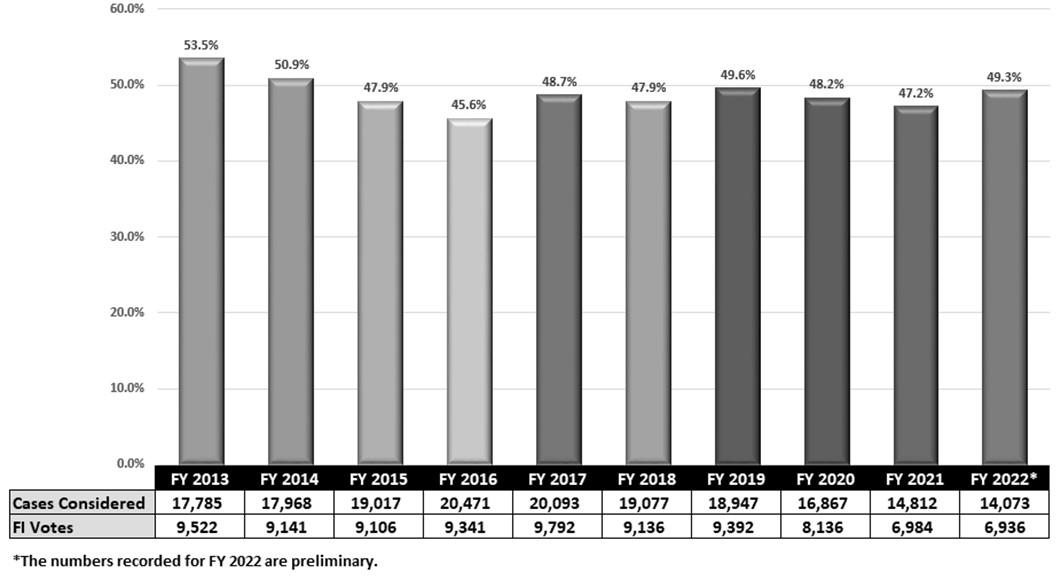
4 TexasBoardofPardonsandParoles7 PAROLECONSIDERATIONS FY2013–FY2022 TexasBoardofPardonsandParoles8 DISCRETIONARYMANDATORYREVIEWS FY2013–FY2022

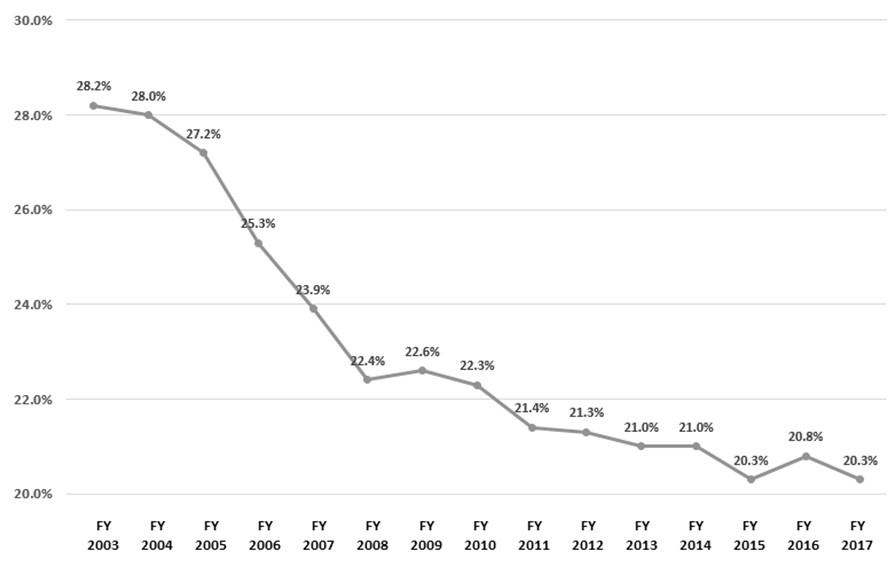
5 TexasBoardofPardonsandParoles9 PAROLEREVOCATIONRATES TexasBoardofPardonsandParoles10 PRISON–REINCARCERATIONRATES(RECIDIVISM) FY2003–FY2017
TEXASBOARDOF
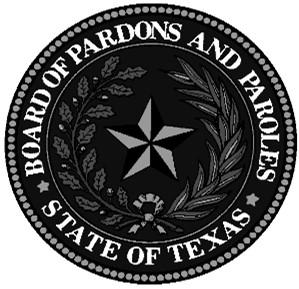
6 TexasBoardofPardonsandParoles11
PARDONSANDPAROLES P.O.Box13401,CapitolStation Austin,TX78711 Website:http://www.tdcj.texas.gov/bpp/ ParoleReviewStatusLine:844-512-0461 Email:bpp_pio@tdcj.texas.gov
About TCDLA
TCDLA began more than 45 years ago as a small, nonprofit association and has grown into a state-of-the-art organization, providing assistance, support, and continuing education to its members. TCDLA provides a statewide forum for criminal defense lawyers and is one of the few voices in the legislature interested in basic fairness in the defense of criminal cases. We are proud that many of our 3,800 members are elite criminal defense professionals in Texas. TCDLA hosts more than 60 seminars each year, providing the highest-quality legal education available for new lawyers as well as seasoned veterans. Our seminars are attended regularly by our members, non-members, judges, and professionals in related fields. Our yearly seminars have increased to over 9,000 people continuing their educational opportunities each year.
Join today and become part of a long history of providing services and assistance in the great state of Texas, while accessing valuable resources, services, support, and discounts on seminars, travel, and technology.
How to Apply:
Submit an application online at tcdla.com
Email application to mduarte@tcdla.com Mail application to:
Texas Criminal Defense Lawyers Association 6808 Hill Meadow Drive Austin, TX 78736
TCDLA Benefits
See the full list at tcdla.com
Resources:
• Networking opportunities with the best criminal defense lawyers in Texas
• Strike Force
• TCDLA APP includes criminal codes, statutes, and case law
• Online Resources, a library including motions, transcripts, briefs, seminars, & more
• Voice for the Defense magazine, the only statewide magazine written specifically for criminal defense lawyers
• Listserv connecting our community on important issues
• Significant Decisions Report emailed weekly
• Legislature lobbyists advocating on behalf of Members
• Expert list for experts in a multitude of practice areas
• Moot Court provided on request
Services:
• Ethics Hotline the only anonymous ethics hotline
• Membership Directory provided annually and updated online daily
• TCDLA logo for websites and social media
• Lawyer Locator member publication
Savings:
• Continuing Legal Education seminars & legal publications
LawPay
Lenovo
Professional Liability Insurance
GAP/Disability Insurance
Brooks Brothers Corporate Membership Program
La Quinta Inn & Suites
Enterprise Car Rental
Sprint
•
•
•
•
•
•
•
•
Texas Criminal Defense Lawyers Association
Membership
(Effective 4/2019)
Contact Information
Membership Fees Get Involved: Committees/Lawyer Locator

$_______ $100 First-time ($100 for each of the first two years)
$_______ $180 Regular member
$_______ $60 Public defender (must be a PD employee)
$_______ $330 Voluntary sustaining (required for TCDLA officers and directors)
$_______ $100 TCDLA past president
$_______ $80 Distinguished member (70+ years old)
$_______ $20 Law student (not auto-renew)
$_______ $80 Affiliate (: q Paralegal q Investigator q Expert q Other (law professors & others approved by board)
I prefer not to participate in auto-renewal
$_______ Total
I’m interested in serving on a committee—send information.
Send me a Board application.
Yes! Include me in the online Lawyer Locator.** You may list up to three areas of specialty in criminal defense law for public access (example: DWI, sexual assault, appeals).
**Disclaimer: Provider makes no promises, guarantees, or warranties regarding the attorneys listed on its Lawyer Locator. Said attorneys are TCDLA members who have requested inclusion on provider’s website to provide the public with choices for possible legal services. Provider expressly disclaims all warranties, including the warranties of merchantability, fitness for a particular purpose, and non-infringement. Moreover, content contained on or made available through this website is not intended to and does not constitute legal advice, and no attorney-client relationship is formed. The accuracy, completeness, adequacy, or currency of the content is not warranted or guaranteed. Your use of information on the website or materials linked from the website is at your own risk.
Payment Method
the account I have designated and I authorize my financial institution to debit my payments
due. I further understand and agree as follows:
the
Application
Your membership is effective upon approval of application and receipt of annual membership dues. q Mr. q Ms. q Mrs. Name (first, middle, last) Date of Birth* Ethnicity* Address City, State, Zip County Phone Cell phone Fax Business Email Website Bar Card Number/Date Licensed Member of Local Bar New-Member Endorsement (must be completed for new members) As a current member of TCDLA, I believe this applicant to be a person of professional competency, integrity and good moral character. Printed Name of Endorser Signature of Endorser * These questions are optional and for internal statistics only. The information provided will not be distributed at any time.
Membership Category and Yearly Fees: q I would like to donate to the TCDLEI scholarship fund, 501(c)(3) organization, in the amount of $
For your convenience, TCDLA uses AUTO RENEWAL for all membership dues, using your checking account or credit card. You will be automatically enrolled in the autorenewal program so you do not have to do anything while continuing to enjoy membership benefits every year! You can always opt out of auto-renewal anytime by simply contacting TCDLA by emailing mrendon@tcdla.com or by checking the opt-out option above. As the account holder at the financial institution I have designated for Automatic Draft, I authorize TCDLA to automatically draft
automatically from the Draft Account on the date the payment is
• This authorization will remain in effect until TCDLA receives a written notification of cancellation at least 10 business days in advance of
next payment due date. Type Name to Authorize Payment Date q Checking Account Name of Institution* Financial Institution 9-Digit Routing # Account # q Credit card (Visa, Mastercard, Amex, or Discover) Credit Card Number Expiration Date Tax Notice: $36 of your annual dues ($19 if a student member) is for a one-year subscription to the Voice for the Defense. Dues to TCDLA are not deductible as a charitable contribution but may be deducted as an ordinary business expense. The non-deductible portion of regular and initial membership dues is $39 in accordance with IRC sec. 6033. Information will be used for TCDLA communication (legislative, SDRs, seminars, events, and other announcements related to criminal defense). Contact office to opt out. For refunds please note credit cards may take 2-5 business
q
q
q
TCDLA Committee Expression of Interest

TCDLA is seeking enthusiastic and motivated individuals for upcoming openings to its 2022–2023 committees. Committee descriptions and mission statements are listed on the website. Complete the form below and check one or more of the committees that you would be interested in serving on.
Responsibilities of a TCDLA Committee Member:
1. Member of TCDLA.

2. Committees will provide advice, guidance and recommendations to the TCDLA President and/or Board of Directors on relevant matters related to their particular committee.
3. Committees will have assigned responsibilities associated with TCDLA’s strategic plan and objectives.
4. Meet throughout the year via conference call and/or at quarterly board meetings.
5. Members are expected to review and respond to email requests in a timely fashion.
6. Committee Chairs are expected to prepare written reports for inclusion in the board packets for each board meeting. Any items requiring a decision of the Board should be included on agenda. Committee members will assist chairs in the preparation of reports.
Your information
of practice
2022–2023
Last name First name Law school Years in practice Primary areas
Contact information Work phone Cell phone Email Committee preference: Select committees you would like to serve on. ❏ Amicus (Brief) Curiae ❏ Bylaws ❏ Cannabis ❏ Capital Assistance ❏ Client Mental Health ❏ Corrections & Parole ❏ Crimmigration ❏ Diversity & Inclusion ❏ DWI Resources ❏ Ethics ❏ Indigent Client Defense ❏ Judicial Conduct ❏ Juvenile ❏ Law School Students ❏ Listserv ❏ Long-Range Planning ❏ Media Relations ❏ Membership ❏ Memo Bank ❏ New Lawyers ❏ Nexus (Seminars) ❏ Prosecutorial Conduct ❏ Public Defender ❏ Rural Practice ❏ Strike Force ❏ Technology & Communications ❏ Veterans Assistance ❏ Wellness ❏ Women’s Caucus Email this completed form with a brief resume. Form may include a personal statement describing your interest in serving on the committee to ksteen@tcdla.com no later than July 1, 2022.
Texas Criminal Defense Lawyers Educational Institute Make a Difference Support an Attorney
Defense Lawyers

Pledge Options
S. CHENG MEMORIAL
MARTINEZ
Choose a fund that’s near and dear to you: For the ASSOCIATE FELLOWS FUND ($750) FELLOWS FUND ($1500) SUPER FELLOWS FUND ($3000) In one lump sum Quarterly Monthly In ____ payments of $________. I would like to designate this donation for use on these specific funds: CHARLES BUTTS Law Student Scholarship in the amount of $_________ Financial CLE SCHOLARSHIPS $___________ For the COMANCHE CLUB in the amount of $_________ For CHRISTINE
Asian-American Scholarship & Travel fund in the amount of $___________ BERTHA
TRIAL COLLEGE Travel Scholarship in the amount of $___________ KELLY PACE MEMORIAL NEW LAWYER TRAVEL FUND in the amount of $___________ Contact Information Name Bar Card Number/Date Street City, State, Zip Phone Email Payment Method Check payable to TCDLEI Credit Card (Visa, Mastercard, Amex, or Discover) Credit Card Number Expiration Date Name On Card Signature Mail completed pledge form with payment to TCDLA • 6808 Hill Meadow Drive • Austin, Texas 78736 TCDLA Office Use Only Amount: _____________________________ Check/cc: _______________________________ Entered By: _____________________________ Date: __________________________ The Texas Criminal Defense Lawyers Education Institute (TCDLEI) is committed to ensuring the fair administration of justice in Texas through the continuing legal education of criminal defense lawyers and their staff. Your generous tax-deductible contribution to the Texas Criminal
Educational Institute can be applied in several ways to fund a variety of legal and educational services for our membership. Deserving members without the wherewithal to attend our seminars can get financial aid to help in their continuing legal education.
Texas Criminal Defense Lawyers Educational Institute Super Fellows | Fellows | Associate Fellows Pledge Form

About Super Fellows , Fellows & Associate Fellows
TCDLEI Bylaws, Art. III, § 3. Super Fellows, Fellows, and Associate Fellows
A. Super Fellow—A member of the Institute becomes eligible for election as a Super Fellow Member by (a) making outstanding contributions to the Institute, or (b) contributing at least $3,000 in cash or pledge to the Institute or (c) a person who has in the opinion of the Board of Texas Criminal Defense Lawyers Educational Institute made a contribution of time and effort in the furtherance of the education and training of criminal defense attorneys in the State of Texas. An affirmative vote of the majority of the Board of Directors of the Institute is required to elect a member as a Super Fellow.
B. Fellow—A member of the Institute becomes eligible for election as a Fellow Member by (a) making outstanding contributions to the Institute, or (b) contributing at least $1,500 in cash or pledge to the Institute or (c) a person who has in the opinion of the Board of Texas Criminal Defense Lawyers Educational Institute made a contribution of time and effort in the furtherance of the education and training of criminal defense attorneys in the State of Texas. An affirmative vote of the majority of the Board of Directors of the Institute is required to elect a member as a Fellow.
C. Associate Fellow—A member of the Institute becomes eligible for election as an Associate Fellow Member by (a) making outstanding contributions to the Institute, or (b) contributing at least $750 in cash or pledge to the Institute or (c) a person who has in the opinion of the Board of Texas Criminal Defense Lawyers Educational Institute made a contribution of time and effort in the furtherance of the education and training of criminal defense attorneys in the State of Texas. An affirmative vote of the majority of the Board of Directors of the Institute is required to elect a member as an Associate Fellow.
Pledge
Pledge Options
q Associate Fellow—$750 q Fellow—$1,500 q Super Fellow—$3,000*
I, , pledge
Payment Options
is the full
Associate Fellow
every other month Fellow 1-year plan—$1,500
3 payments of $500 (quarterly)
5 payments of $300 (every other month)
Super Fellow 1-year plan
payments of $1,000 (quarterly)
Super Fellow 2-year plan
6 payments of $500 (quarterly)
payments of $300 (every other month)
of $125 (monthly)
to contribute $ to TCDLEI.
q Enclosed
pledge amount
q 3 payments of $250 q monthly q Scheduled payments ( select one): q
q
q 3
q
q
q 5 payments of $600 (every other month) q 10
q 12 payments of $125 (monthly) q 12 payments of $250 (monthly) q 24 payments
*If you are currently a TCDLEI Fellow, a second contribution of $1,500 will make you a Super Fellow. Contact Information q Mr. q Ms. q Mrs. Name Bar Card Number/Date Street City, State, Zip Phone Email Payment Method q Check payable to TCDLA q Credit Card (Visa, Mastercard, Amex, or Discover) Credit Card Number Expiration Date Name On Card Signature Mail completed pledge form with payment to TCDLA • 6808 Hill Meadow Drive • Austin, Texas 78736 TCDLA Office Use Only Amount: Check/cc: Entered By: Date: www.tcdla.com
Texas Criminal Defense Lawyers Association 6808 Hill Meadow Dr., Austin, TX 78736 • www.TCDLA.com P: 512.478.2514 • F: 512.469.9107


























































































































































